Australian
and international
exploratory
performance and
media arts
urgent: national cultural policy discussion
Don’t be left out of the loop! Arts Minister Peter Garrett has announced a National Cultural Policy public dialogue, but the closing date for discussion and submissions is February 1. The holiday period hardly seems ideal for serious debate about a critical issue, one akin to the proposed Human Rights Charter for Australia.
If you have the time, and I really hope you have the inclination, I urge you to read Garrett’s October 27 speech to the National Press Club and the Discussion Framework—both can be found at http://nationalculturalpolicy.com.au. Look at the documents and the reponses and, if moved, do add your own.
If you’re not sure what a national cultural policy might look like, go straight to David Throsby’s Platform Paper 7, Jan 2006: Does Australia Need a Cultural Policy? (Currency House, Sydney). In a mere 50 pages Throsby describes the way arts policy has evolved in Australia—increasingly reactive rather than visionary, he says; looks at models in other countries; and makes important distinctions about how we think about culture—as art, heritage, nation, economy and social polity.
The essays by Helen O’Neill and Robyn Archer in the Griffith Review’s Essentially Creative edition (Autumn 2009) have a lot to say about the continued, problematic public and government regard for artists and the arts and especially the way the ‘creative industries’ notion (fraudulent, says Archer) is changing attitudes to and rationales for the arts—requiring them to be socially just, good for the national economy and business-oriented. O’Neill argues for a broader notion of the arts (in line with technological change and creative industries developments) and new funding strategies while Archer defends artists against the predations of new formulae.
These complications are intensified in Marcus Westbury’s Meanjin essay (Vol 2, 2009, Winter), “Evolution and Creation: Australia’s Funding Bodies”, which declares the Australia Council inequitable and, with its “archaic art-form definitions”, out of touch. If short on concrete proposals, Westbury’s essay nonetheless points clearly in the direction of a creative industries model and an expanded notion of the artist and “cultural production.” Westbury is a member of Garrett’s Creative Australia Advisory Group.
Please find the time to read and respond to Garrett’s speech and Discussion Framework. Perhaps even demand time for a more sustained public discussion that can be genuinely bottom-up rather than tossing in ideas for top-down policy making. KG http://nationalculturalpolicy.com.au
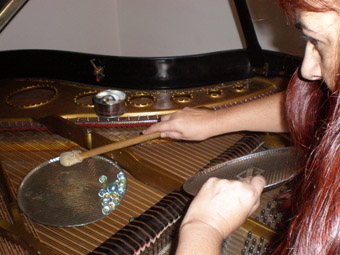
Adriana de los Santos (Argentina)
photo courtesy the artist
Adriana de los Santos (Argentina)
the now now festival
A regular for the Sydney summer season is the NOW now festival of spontaneous music. The event has been evolving since 2001, when it started as a humble artist-run initiative at the now defunct Space 3 gallery. The general enthusiasm of its core team, unrelenting dedication and a shift to a more mainstream venue, @Newtown, meant that the 2005-6 festivals reached quite bizarre levels of popularity, attracting a wider scene than your average experimental music crowd. Perhaps to avoid the inevitable rise and rise and potential for sell-out, the festival then upped-stumps and relocated to Wentworth Falls to, well, keep it real. And the program for 2010 looks like it will continue to do just that.
Now organised by a collective (since founders Clare Cooper and Clayton Thomas currently reside in Berlin) and still with minimal funds, the festival will present over 50 artists over three days at what is beginning to feeling like home for the festival, the quaint Wentworth Falls School of Arts.
Perhaps the most interesting thing about the NOW now is that even if you’ve heard many of the artists before, you’ve most likely never heard him play with her, or her with her, or her with him and her. Some interesting match ups for this year include Somaya Langley (electronics) with Jon Hunter (guitar, electronics); PEKING, comprising Clare Cooper (surprisingly on bass guitar) with Brendan Walls (guitar) and Stu Olsen (drums); and NHOMEAS—Josh Isaac (drums), David Sullivan (bass, fx loop), Jack Dibben (guitar), Nic de Jong (keys, clarinet) and Aemon Webb (vox, electro Gadgets).
NOW now always includes a healthy smattering of international artists, often collaborating with locals and this year offers, as expected, a European contingent, this year including Kym Myr and Espen Reinertsen from Norway, and Matthias Muche, Sven Hahne and Mani Neumeier from Germany, the latter apparently a legend, having been the drummer of Krautrock band Guru Guru. Perhaps less expected, this year Now now will play host to the Quintet Experimenta from Argentina, featuring Adriana de los Santos (prepared piano, objects), Gerardo Morel (sampler, laptop), Claudio Calmens (electric guitar, wind instruments), Zypce (electric percussion, tuntable, CD) and Claudio Koremblit (visuals, prepared electric guitar). Michel Doneda from France will also appear. In renowned musician Jim Denley’s opinion Doneda is “one of the most important sax players in the world of improv.”
With the addition of MONA FOMA to the Australian experimental music calendar, it seems like January might almost offer international guests a festival circuit.
Beginning the NOW now festival will be the mass improvisatory organism that is the Splinter Orchestra. Somewhere in the middle we’ll also see another experiment in SMS music interaction with Fred Rodrigues S.I.M.S Project (see review). And the whole thing wraps up with Team Music, Jon Rose’s interactive music making netball game—a little something for just about everybody…
The NOW now—festival of spontaneous music, Wentworth Falls School of Arts, Jan 22-24, 2010
sydney fringe festival—be a black sheep
Arguably the main problem with the previous long running incarnation of the Sydney Fringe festival was that while Bondi (where the majority of activities took place) was on edge landwise, it was by no means on the edge culturally. Inner city Sydney, meanwhile, has continued to generate grit, grafitti and edgy experimental work, supported by relatively lower rents (and some progressive City of Sydney policies) and creating a thriving, alternative cultural scene.
For many years Newtown and surrounding suburbs have been the zone for a range of artist initiated activity with a recent surge in festival ventures, including the ambitious Underbelly festival at CarriageWorks, the Imperial Panda festival across multiple venues and PACT/Quarterbreds’s Tiny Stadiums event. And that’s before taking into account aspects of the programs of established venues that also,from time to time, offer alternative work such as the Factory Theatre, New Theatre, The Newtown theatre, the Vanguard, Cleveland St Theatre, Seymour Centre and so on.
Drawing strength from these activities, the Newtown Entertainment Precinct Association has galvanized these venues in an attempt to make a new Sydney Fringe Festival planned for September 2010, by and for Sydney’s proudly fringey—well non-mainstream at the least—elements. The list of advisors (named the Black Sheep Brigade) offers hope that this is a genuine venture of alternativeness rather than merely being an ruse of branding-cool.
But as with all the best festivals it will be the artists who define it. Sydney Fringe is currently calling for proposals and expressions of interest, offers of skills and general support, so if you feel you are the proverbial black sheep go to the website for further details. http://sydneyfringefestival.org.au/home
RealTime issue #94 Dec-Jan 2009 pg.
© RealTime ; for permission to reproduce apply to realtime@realtimearts.net
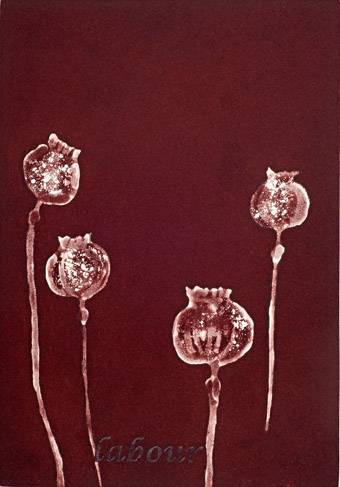
Fiona Foley, Opium #5 – Labour, etching on paper, printer Michael Kempson
image courtesy and © the artist
Fiona Foley, Opium #5 – Labour, etching on paper, printer Michael Kempson
Photographed in Tasmania, where opium crops are harvested for use in medicines, the pods on the cover of RealTime 94 appear in Fiona Foley’s video entitled Bliss [see article], part of Forbidden, the MCA and UQ Art Museum retrospective of the work of this leading Australian artist. Opium pods and flowers figure in many of Foley’s creations—on screen, etched, cast and sculpted they are seductively beautiful evocations of complex historical relations between Aboriginal and Chinese peoples at the end of the 19th century, between opium and the law, as well as reminders of the enduring effects of the drug on contemporary global society. Not a few ironies abound in the fact that the greater part of the world’s illicit opium supply still comes from war-torn Afghanistan. Marrugeku’s Burning Daylight is another show, this time a large scale multimedia performance, that draws history into the present, unleashing the ghosts of late 19th and early 20th century Broome to put current anxieties in perspective and to counter forgetting [see article]. Again, the issues addressed are not black-and-white, but interculturally complex. Nuanced thinking is needed more than ever. That would make for an excellent Xmas gift in these absolutist, un-nuanced times: “Send no gifts, give no money. Just think, complexly!” Whatever your ethical, spiritual or aesthetic persuasion, all of us at RealTime wish you a happy holiday and look forward with you to a great year for the arts in 2010.
RealTime issue #94 Dec-Jan 2009 pg. 1
© Keith Gallasch; for permission to reproduce apply to realtime@realtimearts.net
{$slideshow}WHILE THE WESTERN FOYER OF THE SYDNEY OPERA HOUSE WAS GOING THROUGH EXTENSIVE RENOVATION, FOR THE MOST PART IN LINE WITH JORN UTZON’S ORIGINAL VISION FOR THE BUILDING, MAGNUM PHOTOGRAPHER TRENT PARKE WAS PROWLING THE VAST BACKSTAGE, UNDERWORLD AND SAIL LOFTS OF THIS MODERNIST ARCHITECTURAL MASTERPIECE ON AN OPERA HOUSE COMMISSION TO SHOOT BEHIND THE SCENES.
What Parke reveals is gloriously at odds with the still pristine sheen of the building’s exterior. His images, large scale and intimate, could be taken for documentation of the backstage of an ageing Edwardian theatre or a war-time concrete bunker. The heightened sense of otherness that Parke typically conveys in his transformations of the everyday is achieved here in his stark delineation of objects freed of human agency and now regarded in their own right.
At the same time they represent traces of the lives, jobs and skills of technicians, cleaners, performers and other theatre artisans: their graffiti, photographic collections, movie posters, the tools of their trades—lights, trolleys, wig stands, makeup, a fake hand floating in a bucket of stage blood. Parke seduces us into considering the aesthetic power of huge clusters of power cord bundles, alarmingly knotted, snaking airconditioning ducts, battered powerboards, large chalked warnings (“No frigging smoking”), strange props (a suspended “angry” coconut alongside a banana), a fake fish on a plate, and a giant ‘head’, the back of which is labelled, “Pearl Fishers. Must be counterweighted.”
Save for the leg of someone disappearing into the concrete frame of the Opera House sails in one of the largest images, austerely black and white, we don’t actually encounter its inhabitants, even though their presence is felt. But there’s the ghostly aura of a theatre after dark, or abandoned—the last man fleeing. Simultaneously, with his eye for unexpected drama and defining colours (many reds amidst the blacks and deep blues) and surprising patterns (provided by cables, pipes and signage), Parke conveys a rich sense of life and flow, of cultural density and relentless purpose amidst the grit, low humour and affection felt in the movie poster collections and snaps of friends spilling off the walls of untidy offices and well-used dressing rooms.
Once again, Trent Parke has created an immersive world. In other hands and through other lenses this backstage might have been rendered banal or merely ironic or simply documentary. But Parke’s eye finds unexpected form, colour and drama in functional objects, demanding we look again and anew. Doubtless some critics will lament the absence of the human figure, but the bodies of opera house artisans of all kinds are everywhere inscribed in the building, their traces magically writ large. KG
Trent Parke, Please step quietly everyone can hear you, Stills Gallery, Sydney, Oct 28-Nov 28, www.stillsgallery.com.au; Sydney Opera House Forecourt, Oct 22-Feb, 2010, www.sydneyoperahouse.com
RealTime issue #94 Dec-Jan 2009 pg. 2-3
© Keith Gallasch; for permission to reproduce apply to realtime@realtimearts.net
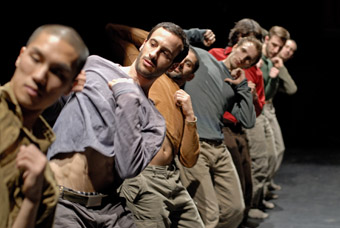
Uprising, Hofesh Shechter Company
photo Andrew Lang
Uprising, Hofesh Shechter Company
IT IS A TRUISM TO SAY THAT HOFESH SHECHTER’S DANCE PIECES ARE AS MUCH ABOUT MUSIC AS THEY ARE ABOUT CHOREOGRAPHY—IN THE DOUBLE BILL (UPRISING AND IN YOUR ROOMS), SHECHTER IS CREDITED WITH CREATING BOTH. INDEED, HIS INTEREST IN THEIR COMBINATION IS HARDLY NOVEL GROUND FOR DANCE, BUT HIS CAPACITY TO SYNTHESISE THEIR IMPACT ON AN AUDIENCE TOGETHER WITH A CINEMATIC SENSE OF IMAGERY IS THE KEY TO HIS POPULARITY
Uprising begins with a steady, slightly metallic beat, a bank of spotlights tilted towards us and haze swarming portentously across the empty stage. From somewhere behind the lights emerge seven male dancers heading downstage with a determined gait. The air is menacing but Shechter subverts the expected and just as the men can go no further, they arrest their charge by lifting a leg to their other knee and holding themselves in a sweetly balletic stance. The line is ordered and controlled—a display of technical acumen certainly—but the image it presents is only a whisper away from collapse. These men are vulnerable in their balancing act.
As the beat continues to drive on, the men slide out of formation looking dejected, defeated even. Shechter reportedly created Uprising in response to the 2006 riots in Paris, though thematically it feels more like a response to the banlieue riots of 2005, which were more palpably and brutally linked to the ennui of disaffected young men. However, to see Uprising as a political statement is problematic. The real source material is testosterone and, as it does in life, it peaks at puberty. Uprising is less an investigation of men and militant outrage than it is a celebratory omnibus of adolescence. Yes, the dancers show us forms of violence, rebellion and manhood, but they are mock displays, the simulated games of boys testing their own limits and not to be taken too seriously—the pants are khaki but the label is American Apparel.
The music is a propulsive assemblage of percussion that whips the choreography along rather than merely accompanying it. In the words of one of the dancers, Chris Evans, Shechter “liberates the dancers from chasing a meaning around” by using music to set the tone. The result is a physical language that, in being both persistent and simple in its intention, is remarkably legible without dipping too often into literalism. The dancers respond with powerful abandon: throwing their arms back as they run head down, breaking formation in fits of individualism, using their hands to slink across the stage like simians, wrestling and caressing. Throughout, flashes of popular dance genres emerge—the negation of the lower body typical of breakdance, the bopping kick of skank—as does the unmistakable urban dubstep of Vex’d with their track Thunder.
With a barren stage and a highly structured beat, Shechter has to find both engaging imagery and fluidity in the bodies on stage. Lee Curran’s sharply focussed spotlights provide pools of visibility that the dancers slide in and out of. Trios and duos flicker past each other in discrete frames like spatial cross-dissolves. When dancers are shrouded in darkness one feels that they have not exited so much as briefly moved out of frame. And when Shechter has all seven dancers working in unison, he is amplifying the human form as a cinematographer might do with a close-up. The result is spare but extremely beautiful.
Uprising finishes with a spurt of bathetic triumphalism. The men construct a limp flag-waving human pyramid equal parts French Revolution, Soviet agitprop and summer camp. In some respects, the finale makes sense as the antithesis of the opening image—asymmetrical and multi-tiered rather than a strict line. But it also feels like a cheap shot. The preceding dance has already done the work of dismantling order and control, but rather than living up to or even coveting the title of Uprising, Shechter shies away from revolution and delivers a safe implication of delinquent folly.
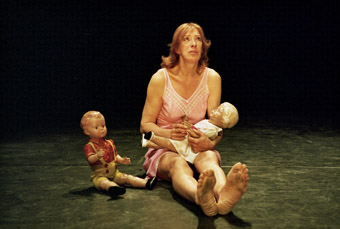
Vanessa Van Durme, Look Mummy,I’m Dancing
photo Fred Debrock
Vanessa Van Durme, Look Mummy,I’m Dancing
A similar whiff of shyness was sensed next door at Look Mummy I’m Dancing, written and performed by Vanessa (Van Durme), one of Belgium’s first post-operative transsexuals. Adapted from her own book of the same title, the show is a sort of staged Bildungsroman that tells the story of Vanessa’s transformation from a troubled boy into a troubled woman.
For a show based on a very fundamental questioning of gender, Look Mummy I’m Dancing manages to shy away from questioning traditional gender concepts. Vanessa begins her monologue with a story of a couple at a checkout line. In both subject matter and delivery it feels like the anecdote of a stand-up comic pointing out the banal universal tropes of married life for us to both recognise and find funny. One expects this cliché of binary gender absolutes to then be undercut by the subsequent story. Yet, save for a few moments of inner conflict, the tone never really shifts. The writing constantly finds ways of being relatable, hackneyed, earnest and predictable.
Occasionally, often in moments of dark, visceral humour, a real theatrical tension is evoked between Vanessa’s delicate aspirations and the staggering pitfalls of her life. And one might argue that it is not her role to do anything but tell her own personal story, rather than speak to the conceptual or the societal. However, too often, the narrative metes out to incidental players the same one-dimensional characterisations that are supposedly the bane of Van Durme’s own existence and skirts across stories with nary a sideways glance at insight.

The Dictionary of Imaginary Places, Anna Tregloan
courtesy the artists
The Dictionary of Imaginary Places, Anna Tregloan
A similar problem befalls Anna Tregloan’s The Dictionary of Imaginary Places. Taking the art of public transport eavesdropping and mashing it with the Dadaist penchant for collage, Tregloan has shaped a piece of theatre out of verbatim transcripts of one-sided conversations on trains. The concept itself is cheekily promising, with non sequitur humour and pathos possible at every turn, but the various components never quite slot together.
Tregloan takes advantage of the Meat Market’s extraordinary depth by creating a train carriage out of rows of chairs but, in spite of her design credentials, the set is otherwise underdeveloped and lacking in detail. Tregloan’s 2007 work, BLACK, with its refractive centre of characters, was as much spatial installation as it was performance, and that level of attentiveness to the audience’s relation to space was sorely missed in this new work. The unhindered distances around the performers created an unfocused, centrifugal effect that compounded the fractured nature of the narratives, leaving the audience to forage for meaning from afar.
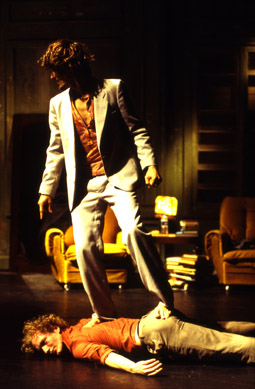
Le Salon, Peeping Tom
photo Maarten Van Denabeele
Le Salon, Peeping Tom
Wrapping up many people’s Festival experience this year was Le Salon from the Belgian company Peeping Tom. Partly borne out of the Belgian powerhouses Les Ballets C de la B and Needcompany, Peeping Tom is a collective of artists orbiting around the central creative partnership of dancers Gabriela Carrizo and Franck Chartier. Each of the performers, including a mezzo-soprano and an actor, brings their own idiosyncratic talents and foibles to bear. This, combined with the very real emotional relationship shared by Carrizo and Chartier, creates an onstage chemistry not dissimilar to that of an amiably dysfunctional family—sometimes pulling in very different directions but inextricably rooted in the same mire of history, experience and artistic heredity.
Le Salon is the middle section in a trilogy of work that loosely follows a family through a cycle of generation and degeneration. The gently decaying wood panelling of the set is at once an allusion to a bourgeois grandeur of the past and a presaging of the characters’ internal declines. With only a sparse use of text, the theatre, humour and intelligence of the piece is in the bodies and the music. And both, while brimming with technical mastery, are also able to seethe with the signs of downfall. Though at times it threatens to undermine itself with overplaying, Le Salon beautifully delivers what it sets out to do—to intimately make flesh the fear of loss, the fear of death and the fear of not noticing it arrive.
Hofesh Shechter Company, Uprising, In your rooms, choreography, music Hofesh Shechter, lighting Lee Curran; Playhouse, Arts Centre, Oct 12-15; Look Mummy I’m Dancing, writer, performer Vanessa Van Durme, director Frank Van Laecke, lighting; Fairfax Studio, Arts Centre Oct 13-17; Store Room Theatre, The Dictionary of Imaginary Places, director, designer Anna Tregloan, sound composer & designer David Franzke, lighting Niklas Pajanti; Arts House, Meat Market, Oct 15-18; Le Salon, Peeping Tom, concept, dancers Gabriela Carrizo, Franck Chartier, Samuel Lefeuvre, Simon Versnel, singer Eurudike De Beul, scenography Pol Heyvaert, lighting Gerd Van Looy, sound Glenn Vervliet, Arts Centre, Oct 22-24; Melbourne International Arts Festival, Oct 9-25
RealTime issue #94 Dec-Jan 2009 pg. 4
© Carl Nilsson-Polias; for permission to reproduce apply to realtime@realtimearts.net
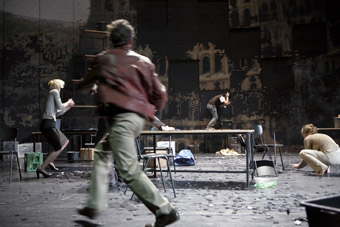
Pornography, Deutsches Schauspielhaus Hamburg
photo AT Schaefer
Pornography, Deutsches Schauspielhaus Hamburg
“IT WAS GREAT…BUT IT WASN’T REALLY A FESTIVAL SHOW, WAS IT?” I’VE HEARD VARIATIONS ON THIS SENTIMENT FOR YEARS. THIS PIECE SHOULD BE DOING FESTIVALS. THAT WORK ISN’T FESTIVAL FRIENDLY. I EVEN FOUND MYSELF SAYING SIMILAR DURING THIS YEAR’S MIAF: “IT WAS A DEFINITE FESTIVAL SHOW”, AN INSTANT LATER QUESTIONING MY OWN STATEMENT. WHAT’S A ‘FESTIVAL SHOW’, ANYWAY? IT’S A BIT LIKE ST AUGUSTINE’S DESCRIPTION OF TIME: I KNOW WHAT IT IS AS LONG AS NOBODY ASKS ME TO EXPLAIN IT.
As good a reason as any to dig deeper. ‘Festival show’ doesn’t seem to be used as a qualitative term; you can have good and bad festival shows, good and bad non-festival shows. Neither is it an indication of content, style, medium or audience. Rather, it’s somewhere that all of these things meet.
The simplest way into the problem is to start with the works themselves, and for me the 2009 Melbourne International Arts Festival lent itself to the question very well. One of the program’s centrepieces was a textbook festival work—Deutsches Schauspielhaus Hamburg’s production of Simon Stephens’ Pornography. It’s a truly international piece of theatre on several levels: a German production of an English text, and one which alternates between a local specificity of references and more global, dislocated concerns.
Pornography is composed of seven discrete sequences which are unconnected on a diegetic level. Their common denominator is left for the audience to determine but the title offers a suggestive pointer. Each scenario addresses one aspect of the obscenity of contemporary life, where all hierarchies of meaning and value have been overwhelmed by the sheer bloody proliferation of signification. The characters of Stephens’ text are in a kind of hell, though the German production makes less of this infernal imagery. And each character appears to be suffering the deleterious effects of postmodern excess which manifests itself through a variety of ugly symptoms.
An office worker self-destructively leaks a highly confidential report to a rival corporation, knowing that it will be traced to her; a bullied schoolboy describes fantasies of racism and sexual brutality; drunken siblings wind up forgetting their sorrows in an orgiastic sex spree. It’s an ugly, disturbing work whose jagged edges are softened by those aspects that I identify with its internationalism: though ostensibly set within the days surrounding the London bombings of 2005, the production frequently unanchors itself to inhabit a more ambiguous space. The design is sprawling and often messy, dominated by a massive, mythic jigsaw puzzle depicting a pixelated Tower of Babel.
The atemporal aspect of the production does, in itself, moor it to a certain aesthetic dock, though. Pornography’s stylisation feels very representative of particular recent trends in both German and British theatre, from the Von Mayenburgs and Ostermeiers to the In-Yer-Face UK crowd. All of these are profoundly concerned with contemporary social life, but it is one defined by global concerns and mass-mediated imagery, and it’s no surprise that these works can comfortably travel to international festivals the world over.
Examining the programs of recent international arts festivals from Taiwan to Iceland, I noted two distinct and recurring features. Firstly, there’s the prevalence and ubiquity of that internationalist style of performance, which transcends cultural barriers but often sees the same productions popping up again and again, as if there were only a limited pool of works available from which festival directors may choose. This is of course a misperception, but one that makes sense when we consider that the most obvious place a festival director will look to for inspiration is other festivals. The result is a certain homogeneity to the festival world—some festivals appear a mix-and-match version of the past decade’s MIAFs (or other Australian equivalents).
The second observation I’ve made is more surprising: the converse of those internationalist works are culturally specific productions which reflect the space in which they were produced and wear proudly their difference, their localism. And, interestingly, such productions seem increasingly to be limited to the arts festivals of the country from which they originate. In order to travel extensively, a new work cannot be too based around regional concerns.
Abbey Theatre’s Terminus is a story with little reference to cultural specifics, making it an ideal touring work, but on artistic grounds an odd contender for festival inclusion. It’s a superb and assured piece of storytelling handsomely performed. But it’s also physically static, visually uninspiring and formally simplistic. Three actors deliver three monologues that collectively create a gripping and horrific narrative of death and rebirth, murder and redemption. Supernatural elements add an air of magicalism, but it’s very much a case of a ripping yarn well told. None seemed disappointed by the entertainment Terminus offered, but few would argue that it pushed artistic boundaries. It could work as a radio play with nothing lost; indeed, more than a few audience members admitted to closing their eyes at some points and enjoying the performance as just that. The text is everything here, and this may be due in part to writer Mark O’Rowe’s other role as director. It was great…but it wasn’t really a festival show, was it?
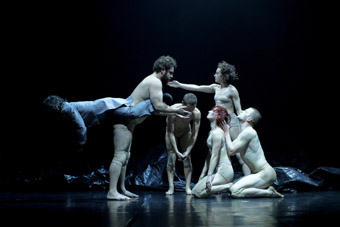
Black Marrow, Chunky Move
photo Proud Mother Pictures
Black Marrow, Chunky Move
Black Marrow, on the other hand, ticks plenty of festival boxes—international cast and creative team; apocalyptic nowhere setting realised on a grand scale; typification of numerous global artistic trends—while failing to satisfy on many other levels. Presented by Chunky Move and choreographed by Icelander Erna Ómarsdóttir and Belgian Damien Jalet, it’s an underprepared mish-mash of concepts that range from the sublime to the plain silly. A primordial world of evolving, mutating bodies spawn from the oily ooze of a molten and bubbling blackness; they copulate violently, dissolve the boundaries of corporeal individuality and ingest the waste from which they emerged. Much of this is striking, visceral stuff, but it quickly wanders off on less bewitching tangents: a suited performer ad libs stilted entreaties to suck on some petroleum; a horrible scene sees a man venturing into a writhing woman’s womb to retrieve a trash baby (the gender politics here are questionable at best).
This is the sort of collaboration and starting point from which great festival works are born, but it proves that there’s no real formula for greatness. Black Marrow works on paper, but it’s ultimately down to the creatives involved and the effort put in during the development process.
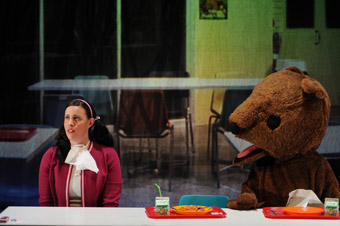
Katherine Tonkin and bear, Apocalypse Bear Trilogy, Stuck Pigs Squealing
photo Paul Dunn
Katherine Tonkin and bear, Apocalypse Bear Trilogy, Stuck Pigs Squealing
Stuck Pigs Squealing’s Apocalypse Bear Trilogy is a cross-platform performance centring on a fascinating ur-figure; a bear (or bear-suited man) who appears to catalyse moments of crisis in an individual’s existence. The logic of these works sidesteps the rational to engage with a different kind of experiential knowledge, in which jumbled, solipsistic conversations are secondary to the passage of time itself. The performances by Luke Mullins, Katherine Tonkin and Brian Lipson are cautious, even flat, but this monotony adds to the cumulative sensation of an inescapable dream or, rather, a dream from which one awakes only to find oneself in another.
Apocalypse Bear Trilogy is not an international work; I’d be surprised if it was picked up on the festival circuit. Its concerns are no more parochial than Pornography’s but its scale and ambition are of a different order. It’s an inward-turning piece, one which speaks neither of a local tradition nor the global culture of which we are now all a part. These aren’t the reasons it lacks that festival edge, however. It’s that the ‘festival show’ is, evidently, the show which will attract eager audiences but would be unlikely to tour on its own steam—the work such as Pornography or Terminus or Black Marrow that’s edgy enough to scare off the masses who make Cirque du Soleil a profitable enterprise but not so difficult as to alienate a festival audience. It’s a fine balance.
But while Apocalypse Bear Trilogy isn’t likely to be touring to Taipei and Reykjavik, it’s still a fine work. It’s just not big enough to attract international festival attention, which is why it, and many other deserving works around the world, will remain ensconced in the cities in which they were created. Simple economics—if we’re going to pay to bring your production halfway around the world, it better be worth it. And as mentioned at the outset, ‘worth’ here is less a qualitative judgement than something else entirely.
Deutsches Schauspielhaus Hamburg, Pornography, writer Simon Stephens, director Sebastian Nübling, set Muriel Gerstner, lighting Roland Edrich; Playhouse, Arts Centre, Oct 15-18; Abbey Theatre (Amharclann Na Mainistreach), Terminus, writer, director Mark O’Rowe, designer Jon Bausor, lighting Philip Gladwell; Merlyn Theatre, CUB Malthouse, Oct 9-13; Chunky Move, Black Marrow, choreography Erna Ómarsdóttir, Damien Jalet, design Alexandra Mein, lighting Niklas Pajanti; Merlyn Theatre, CUB Malthouse, Oct 20-24; Stuck Pigs Squealing, Apocalypse Bear Trilogy, writer Lally Katz, directors Luke Mullins, Brian Lipson, performers Brian Lipson, Luke Mullins, Katherine Tonkin, design Mel Page, sound Jethro Woodward, lighting Richard Vabre; Lawler Theatre, Melbourne Theatre Company, Oct, 8-24 Oct; Melbourne International Arts Festival, Oct 9-25
RealTime issue #94 Dec-Jan 2009 pg. 5
© John Bailey; for permission to reproduce apply to realtime@realtimearts.net
{$slideshow}THE FIRST CHOREOGRAPHIC BARS START WHILE THE AUDIENCE IS STILL ENTERING, PROMPTING THE MOST MESMERISING MOMENT IN THIS YEAR’S ENTIRE MELBOURNE INTERNATIONAL ARTS FESTIVAL. FOR PERHAPS 10 MINUTES, HUNDREDS OF MELBURNIANS FILL THE STATE THEATRE IN UNCANNY SILENCE. NOT EVEN LATER INTRUSIONS OF DANCERS INTO THE AUDITORIUM WILL BE AS EFFECTIVE IN REMINDING THE AUDIENCE OF ITS SHEER NUMBERS, OF THE STRENGTH AND THE NOISE AND THE BRUTE PHYSICAL VOLUME OF THE HUNDREDS OF US. KÖRPER (“BODIES”), SASHA WALTZ’S EARLY MASTERPIECE, IMMEDIATELY MAKES ITS POINT: WE ARE BUT BODIES IN SPACE.
A giant leap forward from her earliest work, which amplified the hysterical banality of everyday existence, Körper is a solemn and minimal piece, inspired by Daniel Liebeskind’s Jewish Museum in Berlin. It is a Holocaust-informed work, a bitter showdown with modernism. Foucault proposed that the modern state was based on biopolitics. Nation state was a line drawn around people proclaimed homogeneous. The focus of state power shifted towards creating its citizens. Suddenly, human beings were carded, identified, examined and sorted, vaccinated, educated, surveilled, relocated, detained and sometimes exterminated. Viewed this way, the Nazi concentration camp was nothing but the endpoint of the modernist dramatic arc: eugenics, scientific experiments, violence and mass death nothing but the obsessive reiteration of state power over the human body.
Körper is a solipsistic dance, looking at its own means of production: body literalised; body as matter. Waltz piles up dancers into a glass box: they wiggle and squirm like Klimt’s fish, planar, somnolent. They are held by a fistful of skin, or stacked like bricks in a wall. When pressed they bleed and squirt water. Two women point at each other’s body parts, naming the price their organs would fetch. Dancers tell Bauschian stories of everyday life as lived by their bodies, pointing incorrectly at each body part mentioned: anatomical vertigo builds up as the story-telling accelerates. Pancreas on one’s elbow, two arms outstretched into a digestive system, lungs on the lower back, vomiting from one’s eyes.
The incessant banality of these associations, the refusal to turn bodies into signifying matter, the wilful lack of sophistication, is what makes this powerful dance universally legible. It reveals, in light both harsh and gentle, the fluidity, strength, fragility and resilience of the human body. There is no culture that lacks the knowledge of the body as presented in Körper, a body of flesh and fluids, of fatigue and illness, of uncertain life and uncertain death.
Unquestionably brilliant, Körper received both standing ovations and critical acclaim. Yet, having premiered in 2000, some scenes already fray at the edges with 90s mannerisms: cacophonic, atomised groupwork; a duet of erotic aggression. Crucially, it is a dance made before 9/11: a dance for a time which had forgotten or doubted the materiality of the body; a time which demanded that theatre, that beatbox of reality, pinch and twist real limbs, let real blood. This tough love may have been, at its premiere, paradoxically affirmative. It arrived to MIAF, nonetheless, as a love letter from an already distant past.
More relevant would have been the subsequent parts of the body trilogy, the erotic S (2000) or noBody (2002), in which a post 9/11 body emerges. Mirroring the reluctant, embarrassed detention, classification and torture of asylum seekers, war prisoners, illegal immigrants—sad, but necessary gestures of state power, performed out of protocol, rather than faith—Sasha Waltz’s bodies were now heavy detritus, easily extended, deformed, exhausted, but nonetheless lingered on, inertly resisting disappearance. In place of fragile, but sculpturally dignified bodies in Körper, they became redundant, mere waste.
Medea, the choreo-operatic spectacle that opened the festival, received significantly less audience enthusiasm: premiering only in 2007, it was harder to immediately glimpse the quality of innovation that has not yet mineralised into convention. It shows a new direction for Waltz, an interest in musical and choreographic narrative, started with Dido & Aeneas, her first choreographic opera, in 2005. It opens with a red curtain collapsing, and the dancing ensemble gently rolling onto the stage, bare but for a single-note hum from the orchestra, relentlessly painting the desert of hope that surrounds Medea, the scorned woman and murderer of her own children.
The work achieves a remarkable distantiation: far from a tabloid shocker, Medea is a layered contemplation of irrational violence, relying on the audience’s familiarity with the myth. Pascal Dusapin wrote a chunkily dissonant score for a baroque orchestra, giving Caroline Stein crystalline high notes to the lonely desperation of a woman in a foreign land, abandoned by her husband for a political alliance; a perfunctory barbarian, a stranger. In an interview, Dusapin compared Medea to Faust: a gambler who raises the stakes too high and loses. Heiner Muller, whose Medeamaterial, the middle part of his Argonaut triptych, is used as a libretto by Waltz and Dusapin, saw it as a post-colonial tragedy, of a savage woman seduced “on the bodies bones graves of my people”, stranded between two worlds, neither of which is accessible any longer. For Waltz, who, influenced by Christa Wolf’s feminist re-reading, stresses that Medea was unlikely to have murdered her own children, Euripides’ tragedy is a patriarchal rewriting, revenge over retreating matriarchy, punishing the feared and loathed female.
The Australian audience, better versed in emotional than cerebral theatre, was left to navigate multiple planes of fine meaning making. Rather than tickling the audience into sentimental catharsis, Waltz builds an emotionally complex narrative, all stodgy grief and fatigued revenge. Deceleration into the operatic largo becomes Muller’s complex text, allowing us to take in its dense poetry. Surrounded by a flurry of dancers, Medea is the only speaking character on stage, Jason and Nurse reduced to voices off-stage.
Again, the choreography is architecture-inspired: throughout the opera it mirrors the logic of a frieze, with multiple groups of three or four dancers forming tableaux, each a symbolic representation of the events, or with individuals occasionally dancing a character. As in Körper, Waltz fondly employs simple stage tricks: Glauce, Jason’s young bride, is stripped naked and dressed in a poisoned white gown on stage, and dances while red dye seeps out of her long necklace, smearing both her and Jason with blood. Stein is seldom engulfed by the dancers, joining and splitting away from the stage images, and the choir steps onto the stage for the finale, a thundering, condemning weight of bodies, breaking any separation that may build between the narration and the illustration of the myth. It sounds naff, but it is a heart-wrenchingly sophisticated work, heroically simple in its idea and remarkably original in its execution. The climax, with six enormous industrial fans building a hurricane on stage, the entire theatre trembling to their hum, is devastating without being either melodramatic or obscure. As the bodies of her children (played by Waltz’s own) are taken away, and Jason’s voice calls for her, Medea coolly cuts herself off from the tragedy: “Nurse, who is that man?”
In Körper, each stage moment is a collage, rather than a balanced composition of the parts. Multiple unrelated scenes will unfold simultaneously, sometimes in harmony, sometimes clashing. Medea is more carefully composed, a Gesamtkunstwerk, demanding wide focus but rewarding amply. Yet both pieces wear Waltz’s choreographic heart on their sleeve. Stage images often so simple as to resemble either puritan comedy, or the earnestness of children, offset and modulate the grave emotions and vivid intelligence permeating her work. These works are unlike anything I have seen: mature without being cumbersome, playful without a moment of frill. In a festival particularly strong on dance, they stood head and shoulders above all else. Waltz’s first, overdue visit to Australia has shown local dance a completely new sensibility.
Sasha Waltz and Guests, Körper, direction, choreography Sasha Waltz, design Thomas Schenk, Heike Schuppelius, Sasha Waltz, costumes Bernd Skodzig, music Hans Peter Kuhn, lighting Valentin Gallé, Martin Hauk, performance Sasha Waltz dancers, State Theatre, The Arts Centre, Oct 15-17; Medea, choreography Sasha Waltz, music Pascal Dusapin, text Heiner Müller, performers Caroline Stein and Sasha Waltz dancers, State Theatre, The Arts Centre, Oct 9-12; Melbourne International Arts Festival, Oct 9-25
RealTime issue #94 Dec-Jan 2009 pg. 6
© Jana Perkovic; for permission to reproduce apply to realtime@realtimearts.net
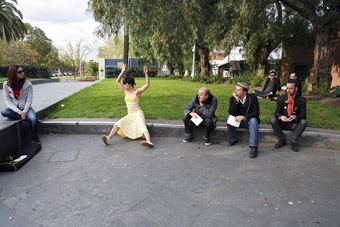
Paula Lay, Reverb (1)
photo Mila Robles
Paula Lay, Reverb (1)
MELBOURNE FRINGE FESTIVAL IS ALWAYS, INEVITABLY, A LESSON IN READING SPACE. FOR THREE MANIC WEEKS WE LIVE IN A CITY TURNED INSIDE OUT. THE PERIPHERAL NORTH MELBOURNE BECOMES THE NEW ARTS PRECINCT; MARGINAL TRAIN LINES REGAIN CURRENCY; ELEVATORS BECOME PERFORMANCE VENUES. WE TRAWL THROUGH LESSER-KNOWN SUBURBS, BACK ALLEYS, FLOORS-OTHER-THAN-GROUND, FOLLOWING DIRECTIONS CHALKED ON CONCRETE, OR ALWAYS TOO SUCCINTLY REPORTED IN THE FESTIVAL PROGRAM. IF THE SPOTLIGHT OF MAINSTREAM ART FESTIVALS RESTS FIRMLY ON THE CITY CENTRE AND CENTRESTAGE, FRINGE COUNTERACTS WITH A ROBUST FOCUS ON THE MARGINS.
The most interesting works this year were all trying to make us re-read space: re-imagining the city on the one hand, theatrical space on the other. The former were collected in the Mapping Room, presented by Head Quarters, a freshly inaugurated independent artspace, an increasingly rarity in the inner city ravaged by gentrification. Among them, people’s walking tours (of anything from graffiti to op-shops) intersected with site-specific performances. Martin del Amo and Brooke Stamp’s Reverb (1) was a clickety, airy dance, one part oneiric pantomime, one part durational performance, travelling between Bendigo and a small park off Chapel Street. I witnessed the very last performance, the afternoon after the Fringe closing party—its audience a wobbly bunch of black-clad urbanites, colonising a vague suburban space at a vague Sunday time. It was liminal in every sense: shops closing, streets emptying; the rain had just stopped and the performance cancellation had just been revoked. Between a stop-starting fountain, a mesmerised baby boy followed Paula Lay’s solo through the park. Solos and duets appeared at odd angles, drawing invisible lines of attention, demanding the audience move, huddle in unexpected sitting formations, or stare at the sun, obliquely gleaming between rain and dusk. A rich lightness was sustained throughout the event, of which we all became part: a curious, question-posing intervention into normally unquestioned space.
The most singular experience of the festival, however, was bettybooke’s en route, a lesson in falling in love with the city. Equipped with headphones, the audience was given small change and sent to explore the marginal spaces of the CBD, one person at a time. Directions and small tasks arrived over the phone, through signs in space, or hidden in the soundtrack, which featured Sigur Ros, Rilke’s poetry and Merleau-Ponty’s phenomenological musings. Walking down graffiti-coloured laneways, discovering speciality music shops, garage sales and messages from strangers, one was never sure what was constructed and what incidental to the experience. Yet, led by bettybooke’s invisible hand, one felt safe detouring, taking time, seeing the city anew. Soon enough, the modern-day flaneur was shouting on the street, writing on the walls and even running in front of a tram, holding hands with a complete stranger. Urbanistic art is not a rarity in Melbourne, a city in love with its own hidden spaces, but few performances manage to so completely tear through the bubble of reserve in which we spend most of our lives.
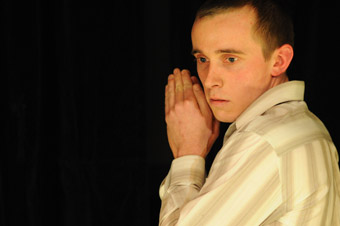
Benedict Hardie, Yuri Wells
photo Lachlan Woods
Benedict Hardie, Yuri Wells
Hayloft Project’s Yuri Wells, on the other hand, was exemplary of the alternative tendency, to re-think stage space. It opened with a quintessentially Gen-Y moment: two saccharine-sweet boys playing a crocodile xylophone and a ukulele amidst scattered props, telling cute stories of encounters with strangers. However, soon the stage is cleared, and Benedict Hardie’s monologue turns our first impression on its head. Using epic narration, some dialogue and a hint of movement, Yuri Wells, a wide-eyed, smiling, socially inept aged-care nurse, is revealed to be a lonely sociopath. With stuttered embarrassment Hardie tells of stalking a girl, kidnapping and locking her up; he digresses, leaves out key details, and occasionally seems puzzled about his own behaviour. It is an oddly polite show that softly, but precisely, steps on its audience’s toes. It masterfully employs the effect of lagged comprehension: as the narrative progresses, the impressions from the initial set-up echo back distorted and reconvsidered. All the seemingly innocuous props assume a retrospectively horrific meaning: a large wooden chest, half-eaten chocolate cake, with the knife still sticking out, Yuri’s loneliness. As the reliability of the story falls apart, all that remains is the bare stage as an empty frame, teeming with ghosts.
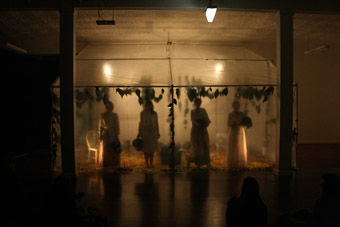
Nature League, Tiger Two Times
photo Cy Norman
Nature League, Tiger Two Times
Nature League in North Melbourne, by Tiger Two Times, a quartet of University of Wollongong graduates, was another subtle show that lingered in the imagination. The audience circled a transparent plastic-sheeted glasshouse, barely able to make out the blurred silhouettes of four girls as they settled into a number of vaguely pre-Raphaelite tableaux. It was 20 minutes of little action, but high semiotics: the performers stood in white, embroidered dresses to sweet sounds of nymphish music, pouring water from a jug, throwing flower petals in the air, sitting gracefully or singing in a chorus line. The effect was uncanny, mysterious, leading the audience to a range of controversial reactions: at times, one felt we were joining the performers in a deconstruction and ridicule of the classical idealisation of young women; at other times we were absolutely moved by the sacred miracle of the feminine. Finally, the plastic sheeting was cut through, and we were invited into the glasshouse, now revealed as a stuffy, charmlessly drab construction. The rose petals became pieces of paper, white dresses home-made, water jugs made of plastic, the feminine mystique dead and buried.
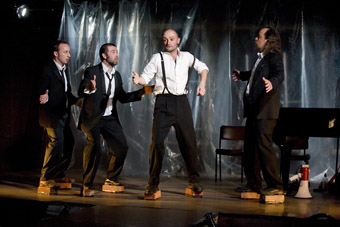
Suicide Show,
photo Ponch Hawkes
Suicide Show,
Recently it was put to me that there is a deep unease at the very heart of the Australian culture about expressing strong emotions, palpable in an embarrassed little term like ‘argy-bargy’, trying to diminish the importance of ‘argument.’ A Bit of Argy Bargy is a company more than superficially aware of this distressed national relationship with feeling, as their suicide diptych demonstrates. And No More Shall We Part is another excursion into the anxieties of family life for Tom Holloway, whose Red Sky Morning hit the zeitgeist in 2008. Nicknamed “The Assisted Suicide Show”, it is a traditional, text-based performance following an aged couple through DIY euthanasia. Holloway has found a genuinely Australian dramatic rhythm, attentive to the stutters of superficial conversation covering a bubbling pot of suppressed emotion, and a dramaturgy predicated on the anxious anticipation of no event whatsoever; a humming layering of stress.
The Suicide Show, in contrast, is a gutting cabaret. Director Martin White lets unrealised suicidal urges spill from song to song, exacerbated by relentlessly self-effacing humour. Five men progress through a series of vignettes combining masculine vulnerability and sociological sharpness, minute descriptions and wide oscillations of mood. A chorus line tries to dissuade a friend from suicide with clumsy, distressing ineptness, employing jokes, non-committal friendliness, anxious suggestions he “talk to someone”—someone else. Another drunkenly attempts to jump in front of a train, on a “fine Australian day.”
White exposes the deep-seated fear of the feminine in this grotesque take on mateship, layering both overt misogyny (a macabre placement of “Good Night Ladies” at the end of the performance) and emotional illiteracy, through attentive use of popular songs (from Nirvana to John Lennon). Although it is a testimony to Argy Bargy’s brilliance that one man’s psychotic rocking can blend seamlessly into swinging to music, or that a barbershop quartet number can reveal icy undertones of despair, The Suicide Show generates enormous anxiety as it approaches its end, feeling increasingly like an overture to a funeral. Yet the two shows, against all odds, mitigate the effect of each other. While the slow, impotent sadness of And No More magnifies the humour of The Suicide Show, it is retrospectively illuminated by the cabaret as comparatively both lighter and deeper.
Reverb (1), choreographers Martin del Amo, Brooke Stamp, Forecourt, Capital Theatre, Bendigo, Grattan Gardens, Prahran, Sept 24-Oct 11; en route, bettybooke, concept Julian Rickert, Melbourne CBD, Sept 26-Oct 11; Mapping Room, Head Quarters, Sept 25-Oct 4; Hayloft Project, Yuri Wells, writer, performer Benedict Hardie, co-deviser Anne-Louise Sarks, North Melbourne Town Hall, Sept 25-Oct 10; Tiger Two Times, Nature League in North Melbourne, The Warehouse, Sept 25-Oct 2; A Bit of Argy Bargy, & And No More Shall We Part, writer Tom Holloway, The Suicide Show, director Martin White, Black Box, The Arts Centre, Sept 30 -Oct 10; Melbourne Fringe Festival, Sept 23-Oct 11
RealTime issue #94 Dec-Jan 2009 pg. 8
© Jana Perkovic; for permission to reproduce apply to realtime@realtimearts.net
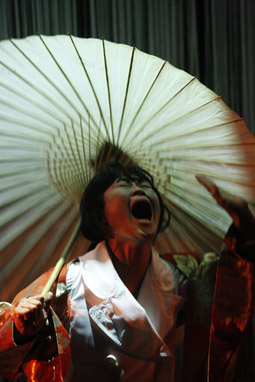
Yumi Umiumare, EnTrance
photo Jeff Busby
Yumi Umiumare, EnTrance
THE TITLE OF YUMI UMIUMARE’S EN TRANCE IS A PUN: ENTRANCE (NOUN) AS IN ENTRY, AND ENTRANCE (VERB) AS IN ENCHANT OR ENTERTAIN. THE TITLE SPEAKS TO EXPERIENCES OF BEING IN BETWEEN AND PASSING THROUGH TO SOMEWHERE ELSE. THE TECHNICAL TERM FOR SUCH EXPERIENCES IS ‘LIMINAL.’ THE WORD IS USUALLY GLOSSED AS ‘AT THE THRESHOLD’, ALTHOUGH INVARIABLY IT RAISES MORE QUESTIONS THAN IT ANSWERS OR EXPLAINS.
The effect of Yumi Umiumare’s performance is difficult to describe. Its mode is enacted evocation, its energies exacting. Yet it also feels quite slippery and elusive. It passes through six phases: Maze, Cityscape, Cracked Mirror, Punk Medusa, Tears and Shiro Hebi (White Snake). It moves with a strong sense of progression, but without the certainty of departure or destination.
There are surreal moments of narrative recollection at the opening. As Umiumare enters, dressed in white, she recalls a memory of watching dust particles wander in the sunlight and a dream, it seems, of slicing off two finger tips and running outside to find them before they are eaten by her cat. The violence is softened by reflection; the mood is calm and contemplative. Then the performer is sideswiped by a bus. A mirrored cityscape of pedestrians and passing traffic, created by media artist Bambang Nurcahyadi, is projected onto Umiumare. She seems squashed by the images, trapped between their flatness, confined yet disconnected from their action.
The horizontal is a strong axis in this work. A new sequence of projections shows commuter trains passing silently in opposite directions, travelling in parallel worlds above and below an imaginary horizon. Umiumare releases great swathes of curtain-fringing, which spread across the stage to catch the image of the trains in passing. She grabs her stomach and her mouth. She eats the fringing, overcome with its threads and tangles, overwhelmed by the effort. In a later projected sequence, the performer appears as if floating on the horizontal surface of an Australian river. Her image falls and slides amongst watery reflections of gum trees against the sky.
The passing phases of the work are marked by costume changes. In one dark and angry phase, she wears a leather jacket studded with tiny flashing lights, and on her head a flat video screen. In another phase, serene and light, she wears a white coat and carries an umbrella. Japanese characters fall upon the umbrella like drops of rain. The lights come up on the audience, and Umiumare delivers a lecture on the onomatapoeia of Japanese words for crying. As if to shift our feelings, she sings a Japanese pop song karaoke style, and then she cries, in yellow light, in memory of her mother. In the final phases, Umiumare puts white make up on her body, twists and tangles with the curtain-fringings and pulls them to the ground. The ending conjures the whirling centre of a singularity, as Umiumare descends beyond a bright spotlight from the rear. The final mood is mournful, elemental. The work descends to silence as the blinding spotlight fades.
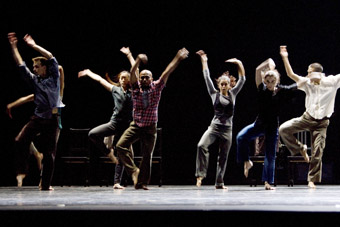
Akram Khan Company, Bahok
photo Alex Makayev
Akram Khan Company, Bahok
Bahok from the UK-based Akram Khan Company is named after a Bengali word meaning ‘carrier.’ It too speaks to experiences of being in between. A carrier or bearer is always in transit, travelling between points, transporting their load. Eight dancers each carry in their body the evidence of cultural origin, training and tradition. They come from China, Korea, India, Slovakia, South Africa and Spain. But like the performer in En Trance, their destinations are unknown. They are caught on stage in transit, as if in the departure lounge of an international airport or the waiting room of some transcontinental train station. The central scenic signifier is a large electronic display which mimics the sort once used in airports, as it flicks through departures and arrivals, announcing delays and reschedules with an electro-mechanical clatter.
The dancers, wearing street clothes are, for the most part, unencumbered by actual luggage. As the work unfolds, the stories of their journeys emerge in fragments which interact. We learn about as much as can be discerned by observing fellow travellers in transit. One man is frustrated that his flight has been delayed. A woman is desperately looking for someone or something on a piece of paper. Another woman falls asleep on a fellow passenger who leads her, sleep-walking, in a contact-based duet. Another couple pass the time by performing ballet moves and posing cutely for a camera.
Dancing serves as the medium of contact and communion between strangers. When the dancers perform Akram Khan’s sweeping choreography in unison the work embodies the movement of togetherness. But the state patrols its borders with the cultural specificity of language. A Korean dancer is assisted at the immigration counter by a fellow traveller who tries to interpret the officer’s enquiries. But as he speaks in Korean, her efforts at translation are upstaged by surtitles for the audience on the electronic display. His cultural alienation is inscribed with the nostalgia that the sight of a man spitting reminds him of home. For the woman, it is a parcel of her father’s shoes that connects her to the past.
International travel both reinscribes and whittles away the tenets of cultural difference. These are 21st century travellers. They bear the racial distinctions of biological inheritance, but they are also young, fit and roughly equivalent participants in an emerging global culture. The surest symbol of the global is the mobile phone, with which the dancers connect through language to people in other places, beyond those they are with. For the audience, a ringing mobile phone is an anxious symbol of their life outside.
The other more present global symbol is a choreographed group hug. Delivered just before the end, this ensemble act of the dancers embodying their contact with communal pleasure has also become, in various photographs, a symbol for Bahok. The work was originally developed as a collaboration between the Akram Khan Company and the National Ballet of China, but the marks of intercultural encounter are diffuse. The score by Nitin Sawhney is a masterpiece of world music, securely integrating its aural sources within a compelling sonic flow.
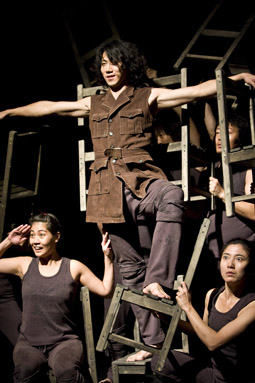
Woyzeck, Sadari Movement Laboratory
photo Alex Makayev
Woyzeck, Sadari Movement Laboratory
From Korea, the Sadari Movement Laboratory’s Woyzeck, directed by the company’s founder Do-Wan Im, has been in repertoire since 2001 and toured widely in recent years. Its intercultural aspects are internalised. Do-Wan Im trained at the Ecôle de Jacques Lecoq in Paris. The work is a classic of the European modern theatre, though I wonder whether it has ever received a production of such discipline and rigour.
The company’s 11 performers foreground an extraordinary physical technique. Their ensemble action is expressive, tightly focused and incredibly precise. Their swift transitions during the blackouts between each scene are astonishing. Their physical capacity to abstract the play’s expressionism into ensemble action is materialised through a dramaturgy of wooden chairs. Arranged and re-arranged with each episodic scene, the chairs extend the ensemble action and serve as prison, tower and bed, as equipment for military display and fairground fun, and as material metaphor for Woyzeck’s psychic fracture.
The aesthetic coherence of the production is secured with music from Argentinean composer Astor Piazzolla whose tango compositions are astringent in their orchestration and, like Woyzeck, fraught and fractured. The surtitles elaborate rather than translate. They are succinct poetic encapsulations, arriving after the physicality of each scene is established in the space. Like the karaoke lyrics in En Trance and the airport ticker screen in Bahok, the surtitles in Woyzeck mark the in-between of touring and translation within intercultural creation.
En Trance, creator, performer Yumi Umiumare, dramaturg Moira Finucane, media Bambang Nurcahyadi, installation Naomi Ota, sound design Ian Kitney, costume David Anderson, lighting Kerry Ireland, Space Theatre, Oct 13, 14; Akram Khan Company, Bahok, choreographer Akram Khan, composer Nitin Sawhney, lighting, set Fabiana Piccioli, Sander Loonen, Akram Khan, Festival Theatre, Oct 16-17; Sadari Movement Laboratory, Woyzeck, director Do-Wan Im, music Astor Piazzolla, dramaturg Seok Kyu Choi, lighting Tae-Hwan Gu, sound design Yo-Chan Kim, set design Jae-Yun Cho, costumes Hae-Ju Kim, Space Theatre, Oct 7-9; OzAsia Festival 2009, Adelaide Festival Centre, Oct 3-17
RealTime issue #94 Dec-Jan 2009 pg. 10
© Jonathan Bollen; for permission to reproduce apply to realtime@realtimearts.net
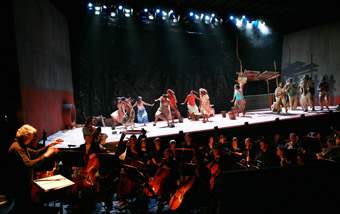
Miracle in Brisbane, Brisbane Festival 2009
photo Atmosphere Photography
Miracle in Brisbane, Brisbane Festival 2009
THIS, IN MY OPINION, WAS ONE OF THE GREAT FESTIVALS, BLENDING IN MEMORY LYNDON TERRACINI’S PREVIOUS FESTIVALS, AND LENDING SIGNIFICANT HINDSIGHT TO HIS CHOICES. CERTAINLY THERE HAVE BEEN THE STANDOUT PRODUCTIONS SUCH AS MABOU MINES’ DOLLHOUSE, THE CONTEMPORARY LEGEND THEATRE OF TAIWAN’S KINGDOM OF DESIRE, DECLAN DONNELLAN’S RUSSIAN LANGUAGE THREE SISTERS, LIZA LIM’S WORLD CLASS OPERAS, YUE LING JIE AND THE NAVIGATOR, AND NOW THIS YEAR’S COMMISSIONED NEW WORK, MIRACLE IN BRISBANE.
Mary Robinson, former President of Ireland (1990-97) and United Nations High Commissioner for Human Rights (1997-2002), was guest speaker with a relevant talk titled “Creating a World without Poverty: Social Business and the Future of Capitalism.” This overarching theme subtly merged with the festival as a whole. Terracini invited us to embark on a narrative journey. In my own case, the import of this journey didn’t strike home until I saw Miracle in Brisbane.
This was a reworking, with director Rhoda Roberts, of his Italian opera Miracle a Milano by composer Giorgio Battistelli. The narrative of a family and the Indigenous community to which they belong who build a shanty town on the fringes of Brisbane forms the bare bones around which this marvellous creature coalesces, and whose protean vigour seemed barely contained. The theatrical focus of the piece pulled in and out, symbolically showing the workings of an inimical white society and the invasion of country, the Stolen Generation and greedy mining moguls. Hope was offered, I think, by the portrayal of Aboriginal society as genuinely inclusive through mixed marriage, and by the notion of Bringing Them Home. The Queensland Orchestra served as a visceral partner to the dramatic surges in this work. Full orchestral expression was counterpointed with solo accordion, didgeridoo and unearthly dissonant choric voices from the Canticum Choir. A small brass band marches on, wet washing is slapped on stage, oil drums are pounded, spears clatter, bodies chant, clap and slap themselves percussively and vocal solos of great power and beauty all precisely and expressively contribute to make the music an equal moiety in this story.
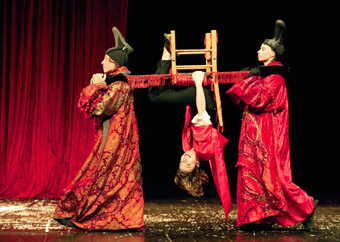
L’Oratorio d’Aurelia
courtesy the artists
L’Oratorio d’Aurelia
L’Oratorio D’Aurelia goes straight to the heart of what our inner child secretly believes, that magic is real and the world is alive. Red velvet stage curtains become lovers, animals, doors and windows; mice catch cats, ice creams are hot, we can fly like kites. This show had the enchantment of fairytale and fable and some of the dark parts too, with a sinister puppet scene in which the protagonist, Aurelia (the performer Aurelia Thiérrée), has her leg gobbled up by a monster and sews it back on. She is at home in her world of infinite possibility which she inhabits with effortless Gallic charm and grace, occasionally connecting with Jaime Martinez for splendidly inventive and acrobatic pas de deux. There is no one story, each scene seems part of a story you half remember and, as in dreams, things simply occur and have their own logic until time reclaims Aurelia and us as she turns to sand and a toy train runs through her stomach and on in a breathtaking illusion which completes the spell.
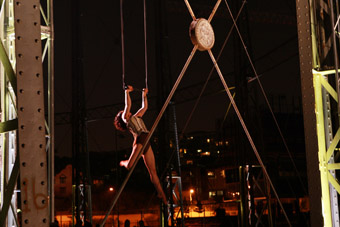
Chelsea McGuffin, Regarding the Joy of Others, CIRCA
photo Justin Nicholas, Atmosphere Photography
Chelsea McGuffin, Regarding the Joy of Others, CIRCA
CIRCA’s Regarding the Joy of Others, directed by Yaron Lifschitz, might almost have been created from an opposite perspective, playing with the dialectic of the human creature lost in vast outdoor spaces, a familiar Australian scenario. Set in an industrial desert, Brisbane’s century old iconic gasometer was sculpturally lit, from a distance appearing like the bones of a long gone circus. Laser lights played over the interior and travelled out, illuminating the surrounding wasteland and emphasising the isolation. Lawrence English’s spare and lonely soundscape hauntingly reinforced this sense of the spaces between things. We were left to wander through, to immerse ourselves in this severely modernist installation, left as it were to encounter our own estranged, existential selves in an empty universe. We were, after all, back in the European philosophical tradition. Eventually aerialist Chelsea McGuffin performed a solo trapeze act suspended between towering steel frames. She seemed equally self absorbed and vulnerable in her predicament, but as if tentatively experimenting for herself, searching for new possibilities of relationship with the only trace of connection to the world, her trapeze. Her movements, however hesitant or miniscule, added up to an irresistable and courageous visual poetry of longing.
Two Catholic priests and seven of their activist flock stand trial for an act of premeditated civil disobedience, the burning of the files of hundreds of young men eligible for the military draft in the USA in 1968. The Trial of the Catonsville Nine was a seminal moment for the anti-Vietnam war movement in America, but the parallels to our own times and the reasons why The Actors’ Gang has reworked the original 1971 production, with inclusions from the trial transcripts inserted into the original free verse treatment by priest Daniel Brannigan, might appear obvious. However, it ocurred to me that because we have become so accustomed to weasel words, and our whole scale of values so skewed to the economy, how nakedly defenceless such language seems now. Who will dare break the silence? Passionately delivered by this ensemble cast, however, in an elegantly contrived production where the actors fluidly adopt the roles of officers of the court as well as defendants, this work underscored the crying need for an Australian Bill of Rights. I’m also becoming a fan of quality American acting.
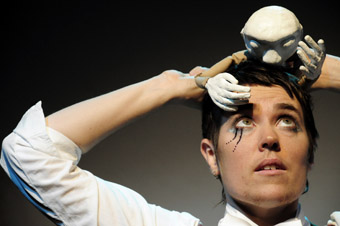
Sunny Drake, Other-Wise, Under the Radar
photo Suzon Fuks
Sunny Drake, Other-Wise, Under the Radar
In the Under the Radar program, Otherwise was like one of those collaged images created from hundreds of smaller images, there’s a lot in them and each image is worth a closer look. Sunny Drake’s funny, energetic, poignant and thoughtful show breaks the silence on transgendered people’s history. The intimacy of scale allowed the autobiographical elements of this work to be fully shared. These were often emotionally rich and telling. The show had a carnivalesque brio with clever prop use and well-integrated animation and use of multimedia, but Sunny himself has no actor’s guile, which somehow made him instantly lovable and engaging. While this is one person’s story of exploring what is “minority normal”, to quote Sunny’s father from a segment of Otherwise, this was not navel-gazing but a richly creative engagement with a world where power and sexual or cultural identity are linked.
The matter of silence was given a different twist in another offering from Under the Radar, Cordelia, Mein Kind, a solo performance by Deborah Leiser-Moore. The performer is obsessed by trauma that runs in families, how it silently occupies our bodies, and even invades our dreams. This deeply textured, multilayered and savagely poetical work takes off from Shakespeare’s King Lear, but unravels personal elements of cultural exile and loss. Leiser-Moore’s Yiddish speaking Polish father escaped to Australia from the Holocaust, but left his family behind. However, he never spoke a word to his daughter about his past until she arranged a trip with him back to Poland, which she documents. His favourite film was a Yiddish version of King Lear with a happy ending! The piece abounded with such astounding ironies and coincidences from real life, I was literally rendered speechless.
In an interview in Rave Magazine, Leiser-Moore declared that the elements of visual and physical theatre with which she engages are such a potent force of communication because “[p]eople have their dreaming from that, they have their own imagination, their own stories. You want people to relate it back to their own world.” This festival was a powerful endorsement of Leiser-Moore’s notion. A beautiful essay by Andrea Goldsmith, “Only Connect” (Alan Jacobs ed. Enough Aready: An Anthology of Australian Jewish writing; Allen & Unwin, 1999) describes feelings of cultural alienation in Australia even in a fifth generation Jew. It wasn’t until events like the Hanson phenomenon, the Children Overboard affair, attacks on Native Title and John Howard’s 10-point plan that Goldsmith began to feel Australian, now that she had something to defend. Ultimately it was a trip to Central Australia and Sir Ronald Wilson’s report on the Stolen Generation, Bringing Them Home (1997), that forged for Goldsmith the terrible parallels of European Jewish and Australian Indigenous experience, and of country as a kind of Aboriginal Torah. Goldsmith relates it back to her own world, discovering in the process the possibility of building a tentative new relation with her Australianness.
The European composer Battistelli described Miracle in Brisbane as a form of ‘voiceless’ protest by marginalised people staking claim to their rights in a world that ignores them. This ‘voicelessness’ took a curious turn at an artists’ forum chaired by Sandy McCutcheon. A lively interviewee, the director Rhoda Roberts seemed about to articulate a vision for Australia perhaps less tentative than Goldsmith’s. She appeared to be on the verge of offering us whitefellas a great gift, if only we would accept it. She swallowed her words. Perhaps she felt on this occasion the odds were against her. I hope not.
West End…Live was a four-day event about which I was less sanguine, having been a long time West Ender. Nevertheless, there was a sad authenticity in the private worlds on display at 17 Browning Street, a former boarding house, if the reconstruction of the lives of the poor and desperate can be so construed. However, the main drag on Boundary Street became electric when it hosted on closing night the marchers from the 275 km Cherbourg Walk. Cherbourg was founded as an Aboriginal reserve in the last century, and Boundary Street was named to define a zone of exclusion for Aborigines from the CBD after dusk. This time they marched up the street to applause—a miracle in Brisbane in which we could all participate. And when Kevin Carmody with local and Cherbourg children sang “From Little Things Big Things Grow” a silence that raised the hair on your neck fell on us all. For this moment we were on holy ground, all of us expressing hopes beyond words.
It was also a very moving conclusion to Lyndon Terracini’s grand narrative in Queensland. His tenure here, as director of the Queensland Festival of Music and the Brisbane Festival, has not only overseen an extraordinary expansion in Queensland’s cultural life, but his sense of engagement and democratic outlook has enhanced Queensland’s sense of humanity at large because he has related it so well back to our own world.
2009 Brisbane Festival: Miracle in Brisbane, composer Giorgio Batistelli, director Rhoda Roberts, conductor Luca Pfaff, soundscape/live electronics Davide Tiso, designer Stephen Curtis, lighting design Bernie Tan, The Queensland Orchestra, Canticum Chamber Choir, performers Deborah Mailman, Djakapurra Munyarryun, Tony Briggs, Nicola Raffone, Casey Donovan, Rachael Wallis, Shaun Brown, Rita Pryce, Micqaella Pryce, Cleopatra Pryce, Gina Reuben, Teila Watson, Violet Love, Dwayne Pierce, Andrew Toby, Leeroy Bilney, Jesse Martin, Garret Lyon, Jeremy Robertson, Theodore Cassady, Jermaine Beezley, Judith Wright Centre of Contemporary Arts, Oct 1-3; Compagnie Des Petites Heures, L’Oratorio D’Aurelia, creator,director Victoria Thierrée-Chaplin, performers Aurelia Thierrée Jaime Martinez;Judith Wright Centre of Contemporary Arts, Sep 23-26; CIRCA, Regarding the Joy of Others, director Yaron Lifschitz, performer Chelsea McGuffin, sound artist Lawrence English; Gasworks, Newstead Riverpark, Sep 29-Oct 30; The Actors Gang, The Trial of the Catonsville Nine, writer Daniel Berrigan, director Jon Kellam; Powerhouse Theatre, Sept 24-29; Otherwise, writer, performer Sunny Drake, dramaturg, director Anna Yen, multimedia/animation artists Kate Geck, Ingrid K Brooker, Dana Aleshire, costume/puppet designer, maker Anthea Brescia, set designer Greg Clarke; Under the Radar, Metro Arts, Sep 26-30; Cordelia, Mein Kind, concept, film, co-creator, performer Deborah Leiser-Moore, director, co-creator Meredith Rogers, choreographer Sally Smith; Under the Radar, Metro Arts, Brisbane, Oct 1-3
RealTime issue #94 Dec-Jan 2009 pg. 12
© Douglas Leonard; for permission to reproduce apply to realtime@realtimearts.net
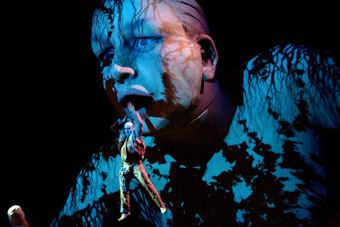
Le Grande Macabre
photo Bernd Uhlig
Le Grande Macabre
AT A BREAKFAST MEETING WITH SYDNEY JOURNALISTS, PAUL GRABOWSKY SPEAKS OF A CHALLENGE HE FACED IN PROGRAMMING THE 2010 ADELAIDE FESTIVAL: “HOW TO ACHIEVE A POINT OF DIFFERENCE” AT A TIME WHEN ARTS FESTIVALS CAN LOOK IDENTICAL AND WHEN ADELAIDE IS TO CELEBRATE ITS 50TH FESTIVAL. HE WANTS TO PAY TRIBUTE TO “LOYALTY, SUCCESS AND LONGEVITY”, TO A FESTIVAL “BIGGER IN THE PUBLIC CONSCIOUSNESS THAN IN OTHER CITIES.” AT THE SAME TIME HE WISHES “TO COMMISSION AND SUPPORT INDIGENOUS ART ACROSS ALL GENRES IN THE FESTIVAL”, SEEING IT “AS THE MOST INTERESTING WORK IN AUSTRALIA” AND ART AS CENTRAL TO ABORIGINAL LIFE IN A WAY THAT IT IS NOT IN WESTERN CULTURE.
indigenous embodiment
To these ends, Grabowsky has woven Indigenous art and collaboration into his program. Building on the huge popularity of the 2008 festival’s Northern Lights installation (by Sydney-based The Electric Canvas) which celebrated Adelaide by ‘animating’ its North Terrace cultural precinct buildings with transformative digital projections, Grabowsky has extended the project to the wall of Parliament House that faces the Adelaide Festival Centre Plaza. With “a sense of irony and poetry”, he says, Aboriginal law from the Central Desert, in Pitjanjatjara language, will be projected onto the building and, on two public occasions, elders will pass on a song to a young man. Northern Lights thus becomes something much more than witty, digital magic.
Australia’s place in Asia and as a country with a culturally significant Indigenous population figures in the music program. The London Sinfonietta is a leading progressive music ensemble whose first program will celebrate the music of the Pacific Rim with works from Mexico (Revueltas), US (Nancarrow, Cage, Adams) and Korea (Unsuk Chin’s Double Concerto, with Australian pianist Lisa Moore). Their second program, Wind & Glass, includes adventurous Brisbane composer John Rodgers’ Glass, performed by the great jazz trumpeter, Scott Tinkler, and a festival commission, Tract. In this new work, composer performer Erkki Veltheim (who plays with Elision, the Australian Art Orchestra and Geoffrey Gurrumul Yunupingu) has set the manikay song cycles of the Young Wägiluk Group from South East Arnhem Land. Grabowksy sees the juxtaposition of “cutting edge new music with one of the great treasures of Indigenous Australian culture as an important moment in Australian cultural history.” The program includes works by UK composers Tansy Davies (Neon) and Gavin Bryars (The Sinking of the Titanic).
The Chooky Dancers from Elcho Island in Australia’s north came to prominence with their indiosnycratic YouTube performance of the ‘Zorba’ dance. They will feature in a festival commission (in partnership with Darwin Festival, Sydney Opera House and Malthouse Melbourne), Ngurrumilmarrmeriyu (Wrong Skin), A Yolngu Tale of Forbidden Love, Skin and Clan, directed by Nigel Jamieson (Theft of Sita, Honour Bound, Gallipoli). Inspired by Shakespeare’s Romeo and Juliet, the work will combine traditional dance and song, drama, comedy and film to address the complexities of life in remote communities, not least for the young. The work’s title is explained by the festival:
“Ngurrumilmarrmeriyu: A Yolngu word meaning ‘elope’. The literal translation of Ngurrumilmarrmeriyu is Ngurru (nose), mil (eye), marr (heart), miriou (nothing). If you follow your heart and body and marry outside the dictates of your family and community, you lose everything—your kinship, your place in the world, the system of law that lays down all the relationships by which you live.”
Also in the 2010 program is Company B’s highly successful, The Sapphires, the story of the indigenous McCrae sisters who as a singing group entertained troops during the Vietnam War. Written by Tony Briggs, it’s based on the lives of his mothers and aunts. Tandanya National Aboriginal Cultural Institute is presenting Putsch by Brisbane-based proppaNOW, a collective of innovative and activist artists including Richard Bell, Vernon Ah Kee, Tony Albert, Bianca Beetson, Andrea Fisher, Jennifer Herd, Gordon Hookey and Laurie Nilsen. Putsch aims to defy white expectations of Aboriginal art and to eliminate self-censorship.
body opera
Grabowksy’s celebration of Australian Indigenous culture offers a sense of history, continuity, intercultural potential and therefore hope. However, global warming data projects the spectre of gradually accelerating annihilation of the Earth’s ecology while popular feature films neurotically repeat sudden apocalypses. György Ligeti’s opera Le Grand Macabre, a festival centrepiece, might then offer some temporary relief from large scale anxieties. Its protagonists come face to face with Death (Le Grand Macabre) in a riotous absurdist fantasy of power plays and miraculous survivals that reveal that there’s more to life than death.
Le Grande Macabre, adapted from the play by Belgian surrealist Michel de Ghelderode, is a widely admired 20th century opera classic, hugely theatrical and richly visceral, funny and frightening. Its sense of rugged but vulnerable corporeality is amplified by truly dramatic singing that ranges from falsetto to stuttering stacatto to gut rumbling bass, abrupt and lyrical by turns and reinforced by a wonderfully suggestive orchestral score ranging from a car horn prelude to the sheer apocalyptic force of the full orchestra. (The excellent 1997 English language version conducted by Esa-Pekka Salonen—from a production by Peter Sellars—is available on SONY Classical, CD S2K 62312.)
To give Le Grand Macabre a bit more body, its producers (Théâtre Royal de la Monnaie, Brussels; English National Opera, London; Gran Teatro de Liceu, Barcelona and Teatro dell’Opera di Roma) have employed La Fura dels Baus to stage it. For those of you who only know the company from its ensemble work with raw meat and chainsaws and audiences on the run, be assured that its company members have a strong track record of major opera successes, albeit without deserting their impulse to provoke. Central to the staging is a massive remotely controlled body from whose orifices the characters of Le Grand Macabre emerge, their costumes suggestive of bodily organs, while the body doubles as a screen for (psychological) projections. The production is in English and with surtitles.
vulnerable bodies
Looking at the body from another angle, Back to Back’s Food Court is the company’s darkest work to date, a brutal exploration of bullying, not least from a sexual perspective, and performed to The Necks’ insistent musical pulse, played live, and amidst Bluebottle’s eerie, impressionistic dreamscapes. Back to Back put the ‘heartwarming’ label sometimes applied to them to the test in this unique work.
Earlier this year, New York’s Elevator Repair Service gave body to every word of The Great Gatsby in Gatz, a quite lateral, seductive transposition of the book from print to live reading and performance over seven absorbing hours (RT91). For the Adelaide Festival they’ll perform the first chapter of William Faulkner’s 1929 novel, The Sound and the Fury. One of the company explained the choice: “Faulkner himself claims to have written the Benjy chapter first and insists that he only wrote the succeeding chapters in an attempt to explain the first one. I liked the prospect of taking his initial inspiration and illuminating it through performing it live.” The rich experience of Gatz is enough of a recommendation to see this new work.
The vulnerability of the body, and of self, is nowhere more strangely focused than in superstition, in the nervous hovering between rationality and delusion. Adelaide innovators, The Border Project in collaboration with Sydney Theatre Company’s new ensemble The Residents, will premiere Vs Macbeth, a reworking of Shakespeare’s play in terms of the superstitions in the text and those historically constellating around “that play”, as well as incidents involving the collaborators as the production has evolved. Cameron Goodall will play Macbeth and Amber McMahon Lady Macbeth, with Sam Haren directing.
In another take on Shakepeare, Melbourne’s The Eleventh Hour (directed by Adelaide-based Anne Thompson, with William Henderson) revealingly transposes The Life and Death of King John, set in the 13th century, onto the bodies and into the mouths of convalescing First World War soldiers, the ultimate victims of unchecked power. John Bailey wrote of the Melbourne premiere:
“[T]he conceit works wonderfully as the audience takes on a kind of double-consciousness, extracting Shakespeare’s tale from the often hilarious and sometimes moving play staged by the wounded” (RT70).
the immersed audience
Another festival commission (with Sydney Festival) has brought together Australian recorder virtuoso Genevieve Lacey and innovative UK filmmaker Marc Silver (www.marcsilver.net) to create an immersive in-the-round installation, en masse, for 50 people at a time, produced by Melbourne’s Arts House. To metaphorical ends, Silver juxtaposes his footage of hundreds of thousands of migrating starlings with an electroacoustic score from Lacey, sound artist Lawrence English and re-mix contributions from international respondents Christian Fennesz, DJ Olive, Nico Muhly, Ben Frost, Steve Adam and Taylor Deupree. At specified times the installation will also include a live performance.
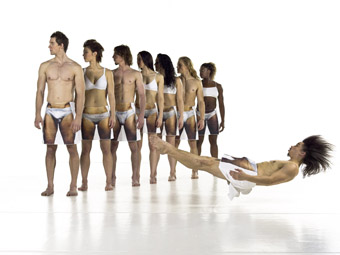
Be Yourself, ADT
image Chris Herzfeld
Be Yourself, ADT
dance about the body
Australian dance companies like ADT (Devolution,The Age of Unbeauty), Chunky Move (Mortal Engine) and Lucy Guerin Inc (Structure & Sadness) are not afraid to tackle big issues. ADT’s Be Your Self (co-produced by Grand Théâtre de la Ville de Luxembourg, La Rose des Vents Villeneuve d’Ascq and Le Rive Gauche Centre Culturel de Saint-Etienne-du-Rouvray) creatively addresses the emotional and biological complexities of the self as body. See ADT artistic director Garry Stewart offers valuable insights into the evolution of the work and the nature of the unusual collaborations involved in its realisation.
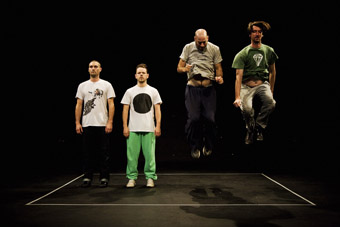
Byron Perry, Antony Hamilton, Simon Obarzanek, Ross Coulter, Untrained, Lucy Guerin Inc
photo by Untrained Artist
Byron Perry, Antony Hamilton, Simon Obarzanek, Ross Coulter, Untrained, Lucy Guerin Inc
Lucy Guerin’s Untrained (see reviews) is a work on a more modest scale but it wittily and very personally reveals much about the differences (and similarities) between trained and untrained dancers and, by analogy, about all our bodies. The show has the curiously empathetic effect of constantly prompting you to think, ‘How would, or could I, do that?’, at the same time feeling the movement in your body.
Jin Xing Theatre Company’s Shanghai Beauty is a rarity, contemporary Chinese dance. It sounds intriguing, examining “opposing views of the body and the beautiful…through a cross-cultural choreography for 16 dancers who move as one.” Jin Xing was a colonel in the Chinese Army, trained with Graham and Cunningham in the US, and became a woman and the director of her own company, unfunded by the Chinese government until this tour, says a very pleased Grabowksy.
active recall
Paul Grabowsky’s gift to the people of Adelaide on the occasion of its festival’s 50th anniversary is Reel Life: The Home Movie Project. It’s an installation that transforms the Elder Park Rotunda into a giant lantern screening images built from footage from the 1930s to the 1980s, largely in Super8, submitted to the festival and edited from 100 hours of film by Richard Raber and Naomi Bishops of Traces Films, and includes trips, parties and pageants, festivals and events both intimate and epic.
to the heart
The 2010 festival poster and brochure image is of a heart shape, perhaps blow-torched through metal, allowing a glimpse of a warm, golden interior. After decades where empathy has failed Australians, the processes of apology, forgiveness and reconcilation have barely begun. Paul Grabowksy clearly wants to cut through hard-heartedness: “Our festival….aim[s] to remind us all of our better selves, our best selves in a festival which celebrates our right to dream, to emote, to feel.” Nor is he afraid to wear his heart on his sleeve, revealing his intentions and confirming them in a program rich in Indigenous content, local and national talent in an international context, and with an overarching sense of the here and now.
See page overview of the Adelaide Festival visual arts program.
Adelaide Festival, Feb 26-March 14,
www.adelaidefestival.com.au
RealTime issue #94 Dec-Jan 2009 pg. 13
© Keith Gallasch; for permission to reproduce apply to realtime@realtimearts.net
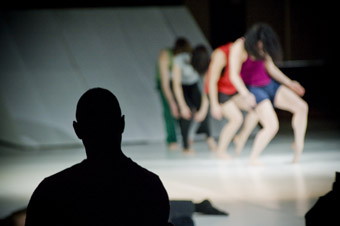
Garry Stewart with dancers
photo Chris Herzfeld
Garry Stewart with dancers
GARRY STEWART IS THE ARTISTIC DIRECTOR OF THE ADELAIDE-BASED AUSTRALIAN DANCE THEATRE (ADT). HIS WORKS BIRDBRAIN, HELD, DEVOLUTION AND G HAVE CONSISTENTLY TOURED INTERNATIONALLY ATTRACTING HIGH PRAISE AND CO-PRODUCTIONS. REALTIME ASKED STEWART TO DESCRIBE THE EVOLUTION OF HIS LATEST WORK, BE YOUR SELF, WHICH WILL PREMIERE AT THE 2010 ADELAIDE FESTIVAL.
The initial impetus for Be Your Self came from a series of discussions between myself, the dancers and a Buddhist teacher Jampa Gendun on notions of self and ‘I’. Central to Buddhist philosophy is an ontological deconstruction of the self. It questions the very existence of a permanent ongoing self and an inherent ‘I’. Buddhism employs a mind training system through analytical meditation to attempt to dissolve the centrality of ‘I’ in our world. The questions ‘What is the self? What is the ‘I’?’ arose repeatedly in these sessions. These questions naturally lead me down a path to this new project.
In terms of ordering the flows of points of view on this, my first decision was to start with the body itself. The body is the most evident and obvious extension of the subject into the world. Our identity is recognized through the spatio-temporal continuity of the possession of one body over a lifetime, despite the radical transformations of our individual morphology—from embryo to inevitable senescence.
Working with a local physiologist, Michael Heynen, we developed text delivered by an actor which describes, via the most dense, physiological jargon imaginable, a series of simple physical manipulations of a dancer’s body. The vast schism between the simplicity of the dancer’s movement and the complexity of scientific language is intriguing and ironic; however the behaviour of the body becomes increasingly complex and unpredictable leaving the limitations of language well behind.
On this new creation I am working closely with Professor Julie Hollege from the Drama Department Flinders University in her capacity as dramaturg. Be Your Self quickly splintered away from Cartesian mind/body dualism into a discourse on the gulf between the rationalism of the biological, scientific body and a body that is volatile and disordered and escapes finite scientific descriptors.
At times, the tone of the work is jagged and chaotic with seemingly illogical stops, starts, interruptions and repetitions, moving through vast shifts in timbre. The work alludes to the multiplicity and fluidity of selfhood. The self is not necessarily a continuous, unified, unfolding logical progression but can be viewed as a complex bundle of competing, negotiating ‘selves’ that we subconsciously edit in order to achieve narrative continuity.
The sound score to Be Your Self evokes the internal function of the body. Working with Sydney based composer Brendan Whoite (formerly of Supersonic) we are developing a composition that turns the body inside out—blood rushing through valves, the electricity of nerves synapsing, gasps of breath and the heart beating as the dancers exert themselves. But rather than treating our emotions, our psyche and our moods as a separate domain from the body, we’ve contextualised consciousness as yet another corporeal system like digestion or respiration.

Be Yourself, ADT
image Chris Herzfeld
Be Yourself, ADT
Further to the task of collapsing the separation of mind and body, I have been working with Professor Ian Gibbons, a specialist in neurobiology at Flinders Medical Centre. For this project he has developed text similar in intention to the physiological description that will be recited at the beginning of Be Your Self to the corresponding moves of the solo dancer. Utilising dense jargon from neurobiology the audience is offered a description of various emotional states and moods that occur as a result, at least partly, via complex neuronal and hormonal processes.
Owing to the deeply fundamental way in which we have internalised Cartesian duality and also the prevailing rationalism inherent in western philosophy and scientific thinking, human emotions have been relegated to a secondary status. Conventionally, emotions and feelings are the antithesis of logos and are associated with the feminine and hence are subordinate to the objective logic of rational, male line of thinking. In Be Your Self emotions are reframed within the scientific schemata. But as any neurobiologist would attest, the current understanding of exactly how emotions are generated falls way short of a fully comprehensive articulation.
Yet current developments in neurobiology are slowly bridging the mind/body gap. It is thought that the brain continuously holds a representation of the body and updates this representation through a constant flow of corporeal feedback. Our somasensory system formulates a multitude of neurological ‘bodymaps’ through which we orientate ourselves within the world. When we drive a car for instance these bodymaps envelop the steering wheel as well as the length, width and volume of the car. Through our bodies we have a sense of the wholeness of the car and the pressure of its wheels on the road as well as its velocity and power.
The neurobiologist/writer Antonio Damasio believes that in seeing, we don’t just register the world with our eyes but our entire body “senses our seeing of the world through our eyes.” Our perception of our world is fully corporeal, not just through specific sensory faculties.
This ability applies particularly to dancers who generally possess an advanced degree of proprioception—the process by which we can automatically register the position of our muscles and joints in three dimensional space. It seems like an unusual statement, but without the body our minds would be completely different. Our bodies create our moods and emotions and these in turn monumentally shape and affect physical behaviour and development of the body.
Lurking beneath the shallows of Be Your Self is the unsettling presence of the body’s liquidity. The integrity of our body as a consistent form is held tight by the largest organ, the skin. Our viscera—our organs and blood—and the internal structures of the body generally remain occluded from our perception or our will to perceive them. Feminist theorists such as Julia Kristeva and Elizabeth Grosz have drawn attention to the leakages of the body that women are so familiar with through childbirth, menstruation and lactation. But associated with this liquidity and the breaching of containment is a barely contained horror, an angst that pervades our relationship with our vulnerable bodies.
Finally, there is the derivation of pleasure from the body through transmuting into an aesthetic domain. The set designed by the New York based architectural firm Diller, Scofidio + Renfro (DS+R) for Be Your Self allows us to obscure the totality of the body and to reveal random, singular body parts. When various limbs and torsos are articulated in concert with each other through this device we enter into a probable world where the body is liberated from its structural limitations. In doing so we are participating in a primordial ritual where humans are drawn to re-present the things of the world in a purely aesthetic form.
Perhaps this impulse toward representation in an allegorical schemata is a survival strategy in order to attain another understanding of the world through its re-articulation in a creative form, thus opening up possibilities that don’t exist yet. Or perhaps it is simply a neurologically pleasurable act that momentarily provides us windows through which to escape the self consciousness of our existence.
–
ADT, Be Your Self, a co-production with Grand Théâtre de la Ville de Luxembourg, La Rose des Vents Villeneuve d’Ascq and Le Rive Gauche Centre Culturel de Saint-Etienne-du-Rouvray, in association with Adelaide Festival Centre Pivot(al) program and Adelaide Festival 2010; Her Majesty’s Theatre, Feb 20-28
RealTime issue #94 Dec-Jan 2009 pg. 14
© Garry Stewart; for permission to reproduce apply to realtime@realtimearts.net
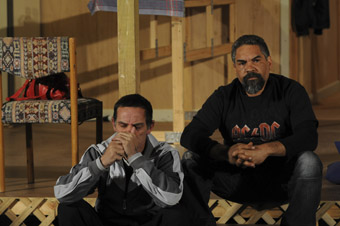
Richard Green, Kelton Pell, The Fence, Urban Theatre Projects
photo Heidrun Löhr
Richard Green, Kelton Pell, The Fence, Urban Theatre Projects
THE FENCE, URBAN THEATRE PROJECTS’ NEW PERFORMANCE FOR THE 2010 SYDNEY FESTIVAL, PROMISES “AN EXPLOSIVE TALE OF LOVE, BELONGING AND DISPOSSESSION.” TAKING PLACE IN AN UNDISCLOSED BACKYARD IN PARRAMATTA, THE PERFORMANCE INVESTIGATES THE “RESILIENCE AND WISDOM OF FIVE MIDDLE-AGED AUSTRALIANS, FOUR OF WHOM WERE REMOVED FROM THEIR HOMES AND GREW UP IN CARE AS PART OF THE STOLEN GENERATIONS AND THE FORGOTTEN AUSTRALIANS.”
Directed by Alicia Talbot, The Fence features a formidable creative team. The cast includes Helen Dallas, Richard Green, Kelton Pell, Skye Quill and Vicki van Hout, with Wayne Blair contributing as a story consultant, design by Alison Page, composer Liberty Kerr and lighting design by Neil Simpson.
As director Alicia Talbot explains, the title for the work emerged during Urban Theatre Project’s 2002 residency at The Parks Community Centre in the western suburbs of Adelaide during the making of the gut-wrenching performance The Longest Night. One of the community consultants who had been removed from his home at age six for being what authorities declared to be a ‘naughty’ child, described his experience of living in out-of-home care with damning understatement: “All I saw for the next 11 years was a fence.” Perhaps unsurprisingly, this phrase stayed with Talbot, and she’s been “chipping away at the idea” ever since.
The Longest Night opened with the removal of a child, Ollie, from his mother, Bernie, by a Department of Community Services worker. The performance delineates the chain of events that follow. Bernie is an ex-junkie, but she’s trying to get clean so she can get her son back. Unsurprisingly, this journey is far from easy for her, especially when faced with the temptations of an ex-boyfriend who can offer her drugs that carry the promise of taking her pain away. The resultant performance was a unique blend of gritty naturalism, startling physicality, punctured by moments of dazzling, almost surrealist stage magic. This produced moments of acute ethical discomfort for spectators. Whose behaviour is justified here? What responses to emotional crisis are permissible? Who should be forgiven, and how often? Are there limits to forgiveness? By contrast, The Fence tells the story of those removed as children, now middle-aged. Where The Longest Night followed the story of their parents’ struggles, The Fence aims to explore the fallout of removal from the perspective of those who were taken away.
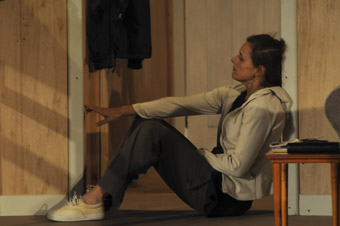
Vicki van Hout, The Fence, Urban Theatre Projects
photo Heidrun Löhr
Vicki van Hout, The Fence, Urban Theatre Projects
Like all of Talbot’s hugely impressive body of work with Urban Theatre Projects over the last decade, The Fence addresses a thorny, uncomfortable and complex topic, and does so without promising any easy answers. But what seems especially remarkable about The Fence is its timeliness. In November 2009, while the performance was still in rehearsal, the Prime Minister issued an apology to recognise the ongoing hurt suffered by the Forgotten Australians—the 500,000 children who, between 1930 and 1970, were forcibly removed from their families and grew up in institutional care. Federal Community Affairs Minister Jenny Macklin stated that “the apology will acknowledge that what happened in the past was both real and wrong. It will make sure that a largely invisible part of our history is put firmly on the record. And it will remind the community of what happened to many of these children—the loss of family, the loss of identity and, in the case of child migrants, the loss of their country.”
For many, this is an apology that has been a very long time coming. But Talbot is hesitant to overstress the topicality of the theme. For her, the critical questions she hopes to reflect on in The Fence are, “What have we learnt from this? How do we care for our children?” She notes that her “aesthetic grapples with where we are”, politically, culturally and geographically, acknowledging the complex histories that surround these stories and the places in which they occur. In the case of The Fence the domestic space within which the performance takes place is uneasily shadowed by institutional proximity. “How does the site evoke other resonances about the story?”, she asks. The backyard in Parramatta is a contested site, one with “deep cultural significance as well as more recent history.” To illustrate this point she describes the artwork of Sally Morgan’s autobiographical My Place (1987), which she believes elegantly outlines the “layers and depth that always underpin psychic and geographic location. This is old territory that we stand on.”
Talbot sees The Fence as “building on a body of work”, including The Cement Garage (2000), The Longest Night (2002), Back Home (2006) and The Last Highway (2008). For Talbot, this represents “a substantial and sustained investigation of an aesthetic”, and continues longstanding collaborative relationships. She does note however that, “devising around big themes to make a story is hard.” In order to make this possible, The Fence, like Talbot’s previous works, has been developed through a deep consultative process, in this case with 25 community members who have had similar experiences to the characters. Talbot acknowledges these community collaborators as ‘experts’, who “look directly at the work” and give their opinion. They are paid collaborators in the development of the performance, attending rehearsals “every 10 days or two weeks” to respond to the work as it develops on the rehearsal room floor. “The strength is in how we make the work”, Talbot says, with the consultative process forcing “ideas to be tested and changed.” In the dialogues that follow each rehearsal showing, the experts measure the credibility of the scenarios, the environment, the characters and their behaviours.
To make performance in such a manner requires a great generosity between artists and experts in order to build a truly shared dialogue from very different perspectives, but for Talbot this multi-layered consultative process ensures that “what comes out at the end is rich”, the performance that results from this process is “a snapshot of people’s lives, made in dialogue with the people who’ve had these experiences.” While she believes that The Fence will “transcend stories of individual homes”, a sense of authenticity is nevertheless critical to her approach to theatre-making. This mode of theatre has been previously described as “fictionalised reality”, and Talbot describes her work as utilising “documentary and filmic frames—but not making a film.” Instead, the rigorous research and the dialogue with community experts is aimed at keeping the performance work grounded, and keeping the questions the performance raises live. This means that for audience members, the “questions stay with you for a long time.”
When asked about her political convictions, Talbot always suggests people “should look at the work”, but she is adamant that each of these theatre works have been deeply political, if refusing to fit neatly within any easily-identifiable political ideology. Talbot acknowledges her kind of sustained, political aesthetic is rare in theatrical circles these days, but has no plans to change direction any time soon. “UTP is such a reflexive organization—the form keeps changing, always driven by questions. It’s an exciting company that enables sustained investigation.”
Urban Theatre Projects, The Fence, Jan 14-30; Sydney Festival, www.sydneyfestival.org.au, www.urbantheatre.com.au/
RealTime issue #94 Dec-Jan 2009 pg. 16
© David Williams; for permission to reproduce apply to realtime@realtimearts.net
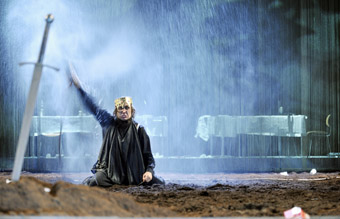
Lars Eidinger, Hamlet, Schaubühne
photo Arno Declair
Lars Eidinger, Hamlet, Schaubühne
THE 2010 SYDNEY FESTIVAL IS ANOTHER OF ITS COSMOPOLITAN CELEBRATIONS OF LARGELY CONTEMPORARY ART PRACTICES INCLUDING PROVOCATIVE UPDATES ON THE CLASSICS—OEDIPUS (TWO OF THESE), HAMLET, CANDIDE (ANOTHER TWO) AND SIX CHARACTERS IN SEARCH OF AN AUTHOR. THERE’S SOME STRONG INTERNATIONAL PROGRAMMING AND WHILE THE FESTIVAL DOESN’T HAVE A GOOD RECORD OF CONSISTENTLY PRESENTING AUSTRALIAN, LET ALONE SYDNEY ARTISTS, THE 2010 PROGRAM IS SOMETHING OF AN IMPROVEMENT.
Australian participation includes choreographer Shaun Parker’s Happy as Larry; Urban Theatre Project’s The Fence (see page 16); contemporary classical music group Ensemble Offspring’s collaboration with Pimmon, in Fractured Again; media artist Lynette Wallworth in exhibition at CarriageWorks; the Malthouse production, Optimism; Campbelltown Arts Centre and Gallery 4A’s Asia-Pacific art show, Edge of Elsewhere; Circa 1979, Signal to Noise—a concert, exhibition and free forum to celebrate Australian independent music 1979-85; a concert from Warren Ellis’ Dirty Three and Ed Kuepper’s Laughing Clowns; Australian artists Yvonne Kenny, Paula Arundell and Bangarra’s Elma Kris performing in the Peter Sellars’ production of Stravinsky’s Oedipus Rex and Symphony of Psalms; and an Australian cast and musicians in a concert version of Leonard Bernstein’s Candide for the festival’s Opera in the Domain concert.
Lindy Hume’s first Sydney Festival selection defies thematic cohesion, but it does have rare contributions from our region—two shows each from India and New Zealand; a strong music theatre stream; adventurous overseas theatre; a fresh look at a gaggle of classics; four substantial dance works; two strong media arts shows; and a continued commitment to innovative overseas independent bands and solo singer-songwriters alongside reflection on Australian music of the 80s. It’s a good start.
music theatre
Hume is an opera director so it’s not surprising there’s a music theatre strand in the festival including Ruhe, from Belgium; a Peter Sellars’ Stravinsky double bill from the US; a local concert version of Bernstein’s Candide; Dublin’s Pan Pan Theatre’s thrash metal Oedipus Loves You; and The Pirates of the Caribbean-inspired Rogues’ Gallery, songs selected by Johnny Depp and Gore Verbinksi and performed by actors (including Tim Robbins) and singers (Marianne Faithful, David Johansen, Norma Waterson and Sarah Blasko among others to be announced).
In Musiektheater Transparant’s Ruhe (Silence), the audience sit in a room of mismatched chairs in the Great Hall of the University of Sydney with performers from Collegium Vocale Gent for a performance of Schubert lieder interrupted by verbatim 1960s confessions (performed here in English) from World War II Dutch citizens who collaborated with the Nazis. With its strong reputation, a fine choir and unusual form and content, Ruhe could be a festival hit.
Choral work is also central to Peter Sellars’ calculated yoking together of Igor Stravinsky’s choral Symphony of Psalms and the opera Oedipus Rex (1927, surtitled performance text in Latin by Cocteau after Sophocles, narration usually in English). The opera is sparely staged employing African costume and limited decor in the form of seven thrones by Elias Sime, an Ethiopian artist. The choral aspect links the two works otherwise separated by the gulf between hope and despair. What the African cultural transposition will bring to Oedipus Rex remains to be seen, but the austere staging appears true to Stravinsky’s spirit in this, one of his first neo-classical works. The production features Sydney Symphony, Sydney Philharmonia Choirs, American soloists Rodrick Dixon and Ryan McKinny, with Yvonne Kenny and Paula Arundell. If Sellars brings to the works the kind of focus and restraint he has given, say, to a Handel oratorio, then Symphony of Psalms & Oedipus Rex could be a truly memorable musical event.
It’s not exactly music theatre, but Ensemble Offspring’s Fractured Again will combine live acoustic music with electronica, video and sculpture to create a performative installation. Typical of the Sydney group’s sense of exploration, this new work by the ensemble’s director Damien Rickertson is built around a rare glass harmonica—the rims of glasses or a series of bowls conjoined after a design by Benjamin Franklin are rubbed with wet finger tips to produce an eery sweet ringing. The instrument is joined by electronica from Sydney musican Pimmon, plus violin, clarinet and percussion. Video by Andrew Wholley will be projected onto Elaine Miles’ glass installation, which itself becomes a gong in what should be an engaging multimedia experience. We might also gain insights into the repertoire created for an unusual instrument that went out of favour in the 19th century after being associated with madness, in Gaetani’s Lucia di Lammermoor ‘mad scene’ (a starting point for the Fractured Again performance) and Mesmer’s experiments in hypnosis. It’s good to see that there will be three performances; Australian new music is so often limited to one.
Another concert with a theatrical edge, The Manganiyar Seduction, is apparently already booked out. Forty three Rajasthani musicians are housed in a huge wall of small compartments which open one at a time, the music accumulating simulataneously in “a repertoire ranging from ballads of kings and Sufi songs to songs to mark life’s important occasions such as birth, marriage, rains and feasts.”
dance
Ireland’s Fabulous Beast relocates the ballet classic Giselle to a small Irish town where “a lonely Giselle McCreedy cares for her abusive brother. But everyone is quick to exchange gloom for glamour when the new line-dancing teacher arrives in town.” It’s directed and choreographed by Michael Keegan-Dolan and performed with speech, song and video. (It’s intriguing that Keegan-Dolan has chosen line-dancing for a key motif while simultaneously Garry Stewart in his version of Giselle for ADT (G), uses a very different line that rarely stops coursing left to right across the stage. When will Sydney see G? France has.)
From New Zealand Lemi Ponifasio, with his company MAU, comes Tempest: Without a Body, “an apocalyptic response to the sinister escalation of post-9/11 state powers.” Drawing on Shakespeare’s Tempest and fusing traditional and modern dance, the work incorporates Maori activist Tame and is linked to a public forum, the 5th Pacific Thought Symposium, presented by MAU between the company’s two performances on January 10. Tempest: Without a Body is at times intense dance theatre, at others an engrossing, highly synchronised formal gesturing and spatial patterning.
Vancouver-based choreographer Crystal Pite’s Dark Matters, performed by Pite’s company Kidd-Pivot Frankfurt RM, uses dance, a puppet and shadow play to speculate on the mystery of dark matter and the analogous unseen forces that shape human behaviour. Vancouver-based Pite is Associate Dance Artist at Canadian National Arts Centre and Associate Choreographer of Nederlands Dans Theater. The choreography is familiarly modern but with a gripping off-centredness (Pite has danced for William Forsythe) and liquid ensemble work, but it’s the dancer engagement with puppet and shadow that looks particularly intriguing.
Happy as Larry is the premiere of a new work from choreographer Shaun Parker whose This Show is About People (2008; see RT 82) was widely applauded. Here nine dancers explore “the elusiveness and possibility of human happiness” to an electro-acoustic score by Nick Wales and Synergy’s Bree van Reyk. It’s interesting to read that the work is inspired by and loosely based on the Enneagram (literally “nine figures”) symbol, central to an allegedly ancient psychological theory of nine interrelated but discrete personality types, a model subsequently refined by GI Guerdjieff through movement as a means to improved self-knowledge. Brief excerpts of the work shown on DVD at a Dance Massive forum in Melbourne earlier this year suggested the possibility of a fascinating departure from Parker’s earlier works.
theatre
From Berlin’s Schaubühne comes director Thomas Ostermeier’s account of Shakespeare’s Hamlet to a translation into German by playwright Maurius van Mayenburg (Eldorado and Soft Targets, both for Malthouse) for six actors playing 20 characters, a lot of dirt, rain, modern suits and a Hamlet who dresses for the part. Rather than an evolution into possible madness, the production publicity promises that “Hamlet’s emotional decay and growing paranoia are immediately clear in Lars Eidinger’s portrayal.” It’ll be interesting to see how such absolutes play out against the text’s complexities in what will doubtless be a compelling production.
In Optimism, director Michael Kantor and writer Tom Wright (his adaptations for STC include Lost Echo, The Women of Troy, Genesis) transpose Voltaire’s Candide from Enlightenment naivety to a modern Australian “she’ll be right” idiom with Frank Woodley (who won a Glasgow Herald Angel award at the Edinburgh Festival for his performance) as Candide and Barry Otto as Pangloss, each attired as a classic clown. While reviews have admired Wright’s fidelity to Voltaire’s original and the quirky playing there’s been not a little debate about the purpose of the re-telling. The pros and cons of the Enlightenment are fuel for endless debate, especially in these fundamentalist times. I’m keen to see Anna Tregloan’s design, which includes a much admired aeroplane interior for the well-travelled protagonists.
British company Headlong will perform their much-praised new version (by Ben Power and the show’s director Rupert Good) of Luigi Pirandello’s 1921 classic Six Characters in Search of an Author. It’s framed as the making of a film in which real lives and fictional ones tangle during editing, “becoming a sinister parable for a media-obsessed age” (www.headlongtheatre.co.uk). Incidentally, the company’s latest show, Enron by Lucy Prebble, using “music, movement and video”, is playing to sellout houses in London.
From New Zealand’s Red Leap Theatre comes a faithfully meticulous account of Shaun Tan’s graphic novel The Arrival, wordless (of course) and deploying music, movement, puppetry and shadow-play to convey a fantastical world, the realities of displacement and the search for a home.
music
As mentioned, Circa 1979, Signal to Noise comprises a concert, exhibition and free forum to celebrate Australian independent music 1979-85. The keynote address will be given on January 15 by John Cale, regarded as a significant influence on the music of the period, followed by a concert on the 16th. Ed Kuepper’s Laughing Clowns and Warren Ellis’ Dirty Three will be in concert on January 26. While Brisbane has had several celebrations of the period and its local heroes this is a welcome first for Sydney.
Al Green is the festival guest who will pull big crowds to his two concerts with his 13-piece band, but there are plenty of lesser known but significant artists on the program. New York-based Medeski Martin & Wood are inventive composers, breaking free from the all too familar jazz trio format with up-to-date textures and complex beats while remaining accessible. As on their 2009 album Veckatimst and in appearances on late night American TV, the band Grizzly Bear deliver reliably rich harmonies and unusual, soaring melodies. Both bands are giving concerts at City Recital Hall, Angel Place.
New York’s most lateral experimentalists, The Books, offer two 75-minute shows in The Famous Spiegeltent. Paul de Jong plays guitar and sings, Nick Zammuto plays cello and the pair texture their compositions with found sounds and images from “a massive digital library”, “creating their very own brand of folktronica.”
Also of considerable interest is The Handsome Family—Brett (charming baritone, guitar) and Rennie Sparkes (accompanying vocals, bass, banjo). Their tuneful, droll songwriting is rooted in tradition, but with a strong contemporary feel. Of course, there’s also the big ticket number, Rogues’ Gallery, a night of pirate and sea-faring songs produced by Hal Wilner who created the sell-out Leonard Cohen tribute, Came So Far For Beauty. The festival’s opening night, directed by Nigel Jamieson, will feature music across the city while The Black Arm Band, The Manganiyar Seduction musicians and Al Green will appear in Hyde Park.
See overview of Sydney Festival visual arts shows.
Sydney Festival 2010, Jan 9-30 www.sydneyfestival.org.au
RealTime issue #94 Dec-Jan 2009 pg. 18
© Keith Gallasch; for permission to reproduce apply to realtime@realtimearts.net
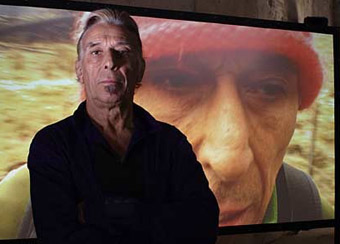
John Cale (Venice Biennale), appearing at Mona Foma
courtesy ARM
John Cale (Venice Biennale), appearing at Mona Foma
mona foma, hobart
After a succesful first season early in 2009 (see RT 89,) MONA FOMA curator Brian Ritchie has announced the program for the 2010 Festival, January 8-24, promising “musical challenge and intellectual discovery.” How many Australian arts festivals lay claim to ‘intellectual’?
John Cale, founding member of The Velvet Underground, will be the Eminent Artist in Residence with his Venice Biennale commission, the art/music installation Dyddiau Du/Dark Days, master-classes, an intimate solo performance, “collaboration with leading Australian artists and a full-band electric art rock experience.”
In a tribute to another great musician, one who criss-crossed the line between rock and contemporary classical, leading Australian pianist Michael Kieran Harvey will perform his 48 Fugues for Frank. “[This] hommage to Frank Zappa will be an immersive environmental work taking place on all four floors of TMAG’s historic Bond Store.” The concrete poetry of Arjun von Caemmerer’s Lingua Franka will be remixed and reinterpreted by four young artists, Michele Lee, Rob O’Connor, Mat Ward and Aedan Howlett, curated by Hobart-based Leigh Hobba. Jon Rose and Robin Fox will present their aural and video bicycle-driven fantasia, Pursuit, premiered by Performance Space at CarriageWorks earlier this year (RT 90, p48). In a more intimate concert, Eight Hands—Variations on the Theme, Cale will be joined by three great Australian pianists: Paul Grabowsky, Gabriella Smart and Andrew Legg. There’s also a heap of bands ranging from local acts to The Dirty Three. Mona Foma, Hobart, Jan 8-24; program at www.mofo.net.au
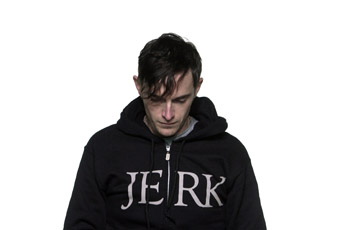
Jerk, PuSh Festival
photo Mathilde Darel
Jerk, PuSh Festival
push, vancouver
Can’t face the post-New Year doldrums and want a festival that will inspire? Go to Vancouver! With a theme of “bearing witness”, PuSh International Performing Arts Festival artistic director Norman Armour has announced a seriously adventurous program that includes aptly unusual engagements with media and experiments with audience-artist relations.
New Yorker Reid Farrington’s The Passion Project “compresses the entirety of Carl Dreyer’s classic silent film The Passion Of Joan Of Arc into a 30-minute concentration of movement, projection, installation and sound collage. The audience surrounds a 10 x 10 foot area flooded by four projectors, in which Emily Watts meticulously arranges and rearranges a number of parchment screens in a series of choreographed movements that explode the film into three dimensions.” You can compare the experience with the film at normal duration and a new score by Stefan Smulovitz elsewhere in the festival.
European collaborators Rimini Protokoll (see RT 91) put the audience and ‘experts from everyday life’ at the centre of their works. At PuSh, their show Best Before “pulls the multi-player video game out of the virtual realm and plugs it into an intimate theatre setting. A simulated city evolves as each of 200 spectators add their personal touch, game controller in hand.”
In Jerk (France), in “a play within a play, the audience takes the role of a psychology class visiting [a serial killer] as he serves his life sentence in prison. Fascination, humour, madness and sheer terror are melded in his puppet show recreations of the murders.” Jerk has been created by Gisèle Vienne a choreographer, director, visual and performance artist, with performer Jonathan Capdevielle. In another of his explorations of audience engagement, choreographer Jerome Bel’s The Show Must Go On (France) is performed with 20 Vancouver citizens.
Audience activity is also expanded in a unique music event, radical American saxophonsist Anthony Braxton’s Sonic Genome. “For eight continuous hours, 50+ performers use the compositions and improvisational languages developed by Braxton to create a living sound world. Ensembles form and split apart like cells dividing and reforming into new organisms.” And the audience too divides to follow whatever excites it.
In Kamp, Hotel Modern from Rotterdam have built “an enormous scale model of Auschwitz…with thousands of tiny handmade puppets representing the prisoners and their executioners…Actors move through the set like giant war reporters, filming the horrific events with miniature cameras and live video projection. Through a series of wordless vignettes, these delicate puppets made of clay, wire and cloth, re-enact the atrocities that took place within the confines of Auschwitz almost 70 years ago.”
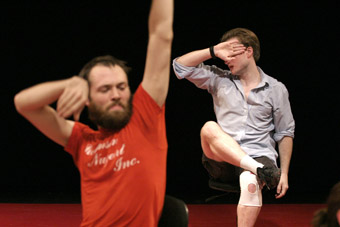
Poetics: a ballet brut, Nature Theater of Oklahoma
photo Peter Nigrini
Poetics: a ballet brut, Nature Theater of Oklahoma
Meanwhile the wonderully eccentric Nature Theater of Oklahoma (see RT 91, p12; RT 89) continue to stretch the limits of performance with Poetics: a ballet brut. Committed if formally untrained dancers turn everyday gestures into something very special. RealTime writers enjoyed Vancouver production Clark and I Somewhere in Connecticut in PuSh 2008. The show makes a welcome return with its lateral investigation, by a performer in rabbit suit, into a case of found photographs. The program also includes William Yang’s China, from Australia. PuSh International Performing Arts Festival, Vancouver, Jan20-Feb 6; http://pushfestival.ca
womadelaide: 13 beautiful people
In an unusual choice for Womadelaide, American indie musicians Dean Wareham and Britta Phillips will play their score for 13 Andy Warhol black and white, silent screen tests from 1962-64. The show was seen at this year’s Melbourne International Arts Festival. The tests used to be shown in Warhol’s studio and at happenings.Thirteen of the 300 tests were selected by Wareham for scoring thanks to a commission by The Andy Warhol Museum and Pittsburgh Cultural Trust. The pair have also created scores for feature films The Squid & the Whale (dir Noah Baumbach) and Clean (Olivier Assayas). Womadelaide, Adelaide, March 5-8, www.womadelaide.com.au
RealTime issue #94 Dec-Jan 2009 pg. 20
© RealTime ; for permission to reproduce apply to realtime@realtimearts.net

The Founding of a Republic
WE ARE CURRENTLY SEEING A RESURGENCE IN THEATRICAL DISTRIBUTION OF ASIAN FILMS IN AUSTRALIA, TARGETING THE GROWING INTERNATIONAL STUDENT POPULATIONS WHO CLUSTER IN THE INNER AREAS OF OUR MAJOR CITIES. HAVING RECENTLY RETURNED FROM BEIJING, I WAS AMAZED TO FIND THAT THE POLITICAL BLOCKBUSTER, THE FOUNDING OF A REPUBLIC, HAD FOLLOWED ME BACK AND WAS PLAYING AT MY LOCAL MULTIPLEX.
The “main melody” film (that is, the type of film whose function is to carry out the ideological work of the Communist government) is a part of Chinese cinema which Westerners tend to know only from textbooks. These films are made primarily for domestic consumption and our film festivals typically spurn them in favour of trendy dissident filmmakers who make underground, miserabilist films about the spiritual emptiness and banal crassness of life in present-day China.
Finding myself in Beijing in the lead-up to the 60th anniversary of the founding of the People’s Republic, I set out to see what I had been missing. In the week before National Day, the main melody film to end all main melody films had been released: Han Senping’s The Founding of a Republic, a two-and-a-half hour epic boasting over 170 cameos by stars including Jackie Chan, Jet Li, Andy Lau, Donnie Yen, Leon Lai and Zhao Wei as well as the participation of directors like Chen Kaige and John Woo.
To set the film in its Beijing exhibition context may give some idea of the massive contradictions which constitute civil society in China these days. I saw it at the Star City multiplex in the basement of the ritzy Oriental Mall in Beijing’s major shopping street, Wangfujing Dajie. As the mall borders on the route of the parade for National Day—where nuclear missiles would soon rumble past Louis Vuitton stores—the streets were crawling with skinny young soldiers with machine guns and plainclothes men making no attempt to hide nasty looking batons.
Once inside the mall, however, another world prevailed. The East Asian mall is perhaps found in its most perfect form in Hong Kong, but it is also familiar to the trendy and upwardly mobile urban denizens of cities from Seoul to Singapore. The brand names are all there: Versace, Louis Vuitton, Lane Crawford. In contrast to the nationalism which was being peddled (and policed) on the street, the promise here is access to cosmopolitan style, evidenced by the fact that Western faces outnumber Chinese ones in store advertising by a factor of about ten to one. Severely slutty and stylishly emaciated Western models loom up one after another, until all of a sudden among them is the Great Helmsman appearing in a multiplex lobby display in the bowels of this new temple of consumption.
The Star City multiplex has six screens and that day it was running a total of 19 sessions, 10 of which were screenings of The Founding of a Republic. The international trade press constantly carps that the Chinese government maintains the high percentage (55-60%) of the domestic box office for local films not only by a quota on foreign films but also by blacking out Hollywood films at prime times of the year such as the National Day holidays. (For those who care, the only Hollywood movie screening was State of Play, a movie which shows American politics in a less than favourable light while also promoting the free, investigative role of the press. Its geopolitical references in China might depend on whether you like to see your glass of civil liberties as half full or half empty.)
The Founding of a Republic was released on 1,700 screens and relentlessly promoted in the media. Consequently it has gone on to become the biggest box office hit in Chinese cinema, grossing over $US60 million. While some might see this as a manipulation of the market, it has the same kind of pre-sold blockbuster status of a Harry Potter or Spiderman movie. The incorporation of a plethora of stars shows that China is successfully developing its own regional star system, and that stars and directors know that they now have a viable economic interest in playing ball with the government. So, Jet has three lines at a dinner party, Jackie sits in a chair during one scene and Andy Lau turns up for a couple of scenes at the end. Of course, their presence also gives the film a set of connotations other than that of simply another main melody film. Just like a cameo by Tom Cruise in a Sundance film, the star implicitly stakes a claim for any film as a part of the entertainment cinema.
In the spirit of dialectical materialism, let us attend to the economic transaction entered into by the spectator when buying a ticket to the film. On a Sunday afternoon I paid the top price of 70 yuan (about $A12) for what was described as VIP entry to the session. While cheap by my standards, I would note that what appeared to be legitimate copies of new Hollywood films were selling in the DVD store of the Fab Endless Culture Plaza for about 27 yuan, and a Big Mac with Coke and fries was 22 yuan. My ticket equated to about 2.5% of an average monthly salary in China. In Australian equivalent terms, that would put the price of the ticket at around $120.
The multiplexing of China has been one of the great recent stories of attempts to incorporate China into the patterns of international cinema. Prior to the Cultural Revolution, China had one of the largest cinema audiences in the world, albeit one based on forms of exhibition outside the patterns to which we are now accustomed. Film exhibition was not something that happened in purpose-built exhibition venues, but part of the wider program of activities in halls, workplaces and parks. With the retreat of the state in these areas, came the complaint from cinema companies that China was heavily underscreened. As Westerners are contemplating yet again the death of the cinema, in China the cinema audience which was destroyed is being rebuilt along new lines in which mall-based multiplexes have led the way in repositioning the cinema as a youthful, consumerist entertainment.
Positioning The Founding of a Republic for a youthful audience is the main problem that the filmmakers strive to solve. The film opens for no good reason with Mao’s plane animated in all its CGI glory and the camera buzzing hyperactively around its propellers. Every time there is an opportunity for incorporating an aeroplane ride into the narrative we are regaled with these CGI effects. A shot of a plane dropping a bomb (which looks to be straight out of Michael Bay’s Pearl Harbor, 2001) is the most visible selling point for the film in all its advertising. Here we have to read the danger that the film is trying to avert: the fear that Communism is just for old farts. CGI speaks of youth, the freshness of contemporary pop culture, and the embrace of the future. That it does so in such an awkward fashion in this film is almost endearing. Look on the street and you’ll see that the embrace of cosmopolitan style is no easy thing for China.
Before the film itself, there was the usual assortment of trailers (five—all for Chinese films) and ads to be got through (18! Including five for cars and three for television sets). That a film about the triumph of a Communist revolution should be attended by such an array of capitalist consumption seems completely in keeping with the wider thrust of a society in which Communism has now been emptied of any sense of class analysis.
The Founding of a Republic echoes this evacuation of Marxism from Communism. Mao Zedong has nary a line concerning the dictatorship of the proletariat. The film pictures him as a coalition builder, always ready to reach out to other factions in the Chinese political landscape. He is upset at one point that he can’t buy a pack of smokes as this indicates that conditions are too unstable to allow shopkeepers to do business.
He is also relentlessly humanised. One scene has Mao and Chou En-lai interrupt a discussion of tactics in order to give piggy-back rides to a couple of moppets. When the film ends, I stroll west for 10 minutes to where the stuffed carcass of the Great Helmsman still lies in state, smack in the middle of the contested territory of Tiananmen Square. I pause to nostalgically imagine the mass of Baudrillardian essayists who would once have posed questions about what is real and what is simulation in all of this. The more contemporary line of analysis might be to see all this as a branding exercise with Mao as the face of China’s brand, not too different from Jennifer Hawkins and Myers. Sooner or later these days, everything seems to end up back at the mall.
The Founding of a Republic, directors Han Sanping, Huang Jianxin, Chen Kaige, Peter Chan, writers Wang Xingdong, Chen Baoguang, producer China Film Group, 2009
RealTime issue #94 Dec-Jan 2009 pg. 21
© Mike Walsh; for permission to reproduce apply to realtime@realtimearts.net
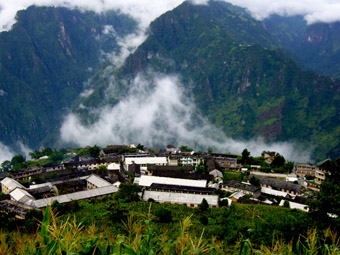
Ghost Town
THE FIRST DECADE OF THE 21ST CENTURY HAS SEEN AN EXPLOSION IN CHINESE DOCUMENTARY PRODUCTION, AS LIGHTWEIGHT DIGITAL CAMERAS HAVE BECOME READILY AVAILABLE AND THE ONCE TIGHT CONTROLS OVER CHINESE LIFE HAVE RELAXED. ZHAO DAYONG’S NEW FILM GHOST TOWN—RECENTLY UNVEILED TO GREAT ACCLAIM AT THE NEW YORK FILM FESTIVAL—IS EMBLEMATIC OF A MOVEMENT GIVING VOICE TO STORIES LONG EXCLUDED FROM THE SCREEN.
Ghost Town is set in the small, remote settlement of Zhiziluo in China’s far south, a former county seat now abandoned by the Chinese government. Zhao stumbled upon the town while scouting locations for another project earlier this decade. “After my first trip to Zhiziluo in 2002, I made trips in 2003 and 2004, staying there for two months each time”, recalls the director. “My original plans to make a film there didn’t pan out, but the people made a deep impression on me and my thoughts often went back to them. I returned again in 2006 and filmed there for 12 months in total.”
Zhao achieves an extraordinary intimacy with his subjects, no doubt partly due to the amount of time he spent living in the town, but also through his approach to the filmmaking process. The nature of digital camera technology allowed him to work without a professional crew and instead recruit townspeople to help with the shoot. Zhao explains, “I had three people assisting me, all local villagers. For example, the truck driver who appears in part two of the film often helped me with sound recording. This way I was able to maintain close relationships with people in the village.”
The involvement of locals is implied in the film’s opening moments, when we see a group of villagers engaged in roadworks staring at the camera, jesting with the offscreen operator. We hear a voice exclaim, “Wow, you can see everything through this lens! Now stand up nice and tall! Look this way!”, to which one of the women in shot jokingly replies, “Fine, go ahead and film. But there’s nothing worth filming here”, provoking laughter amongst her companions. From this opening sequence, Zhao’s camera both participates in, and documents life in the town.
The film’s three-hour length is divided into three chapters, each delving into the lives of a different set of characters. “Voices” follows Yuehan, the pastor of the town’s Christian church founded by missionaries in the 1930s. His 87-year-old father, who calls himself “John the Elder”, is also a priest, having been introduced to Christianity directly by missionaries as a young man. John speaks briefly about the persecution he suffered from the late 1950s, when the missionaries were expelled by the Communists and local believers were incarcerated—in John’s case for 20 years. He claims 95% of those arrested didn’t survive their ordeal.
We follow John and Yuehan as they make their rounds and receive visitors, providing a degree of material and emotional support to their followers. Initially the two appear close, but it becomes apparent that a deep rift exists between father and son, arising from the emotional scars inflicted on John during his two decades in prison.
Part two of Ghost Town, titled “Recollections,” traces the strain placed on personal relationships by Zhiziluo’s backwater status and economic stagnation. Li Yongqiang is a hopeless drunk whose wife is seeking a divorce, while the young driver Pu Biqiu faces harassment from local police and suffers from a lack of work. Pu is involved with a local girl, but when cashed-up out-of-towners arrive in Zhiziluo wanting to buy a wife, her parents pressure the girl to leave Pu so she can be married off.
Ghost Town’s final chapter is perhaps the most confronting, as we follow Ah Long, an aggressive 12-year-old living alone, without parental support or supervision. One night he participates in a disturbing exorcism with other male villagers, calling on the “mountain spirits” to drive out the evil possessing two local men. In the film’s concluding sequence, we see Ah Long sitting lost and alone at the back of the church during a service, watching silently as the small congregation sings a hymn.
At one level the townspeople of Zhiziluo are clearly victims of China’s new economic order, which has seen major coastal cities greatly enriched at the expense of rural areas. Zhao resists straightforward socio-economic analysis however, instead implying the aimless existence of the town’s inhabitants is symptomatic of a broader malaise. “Through the town I began to see and reflect on my own life”, Zhao says of his experiences shooting Ghost Town. “A process of self-reflection is, for me, the essence of filmmaking. As I was living with these people I came to realize just how uncertain their lives and fates were. The empty government buildings in which they live do not belong to them, and the fate of the place itself, of its architecture, was also in question. They were merely floating in the world, without any sense of safety and security, and their existential condition was basically no different from my own.”
The town’s church provides some material and spiritual support, but none of the villagers appears particularly committed to Christian beliefs, which seem no less foreign an imposition than the Maoist doctrines of earlier times. At one point a villager asks John the Elder why they are not allowed to sing and play guitar, to which the aging priest can only reply, “This is what the missionaries taught us.” Furthermore, the church appears powerless in the face of forces atomising the personal relations we see in the film. Even the priest Yuehan feels estranged from his father. The last sequence of the orphan Ah Long sitting in the church feels more like a final affirmation of his isolation than a scene of community belonging.
After lingering with Ah Long, the film abruptly cuts to its final image—a statue of Mao standing forlornly outside a deserted building, the paint peeling off his towering form. The statue’s magnanimous, guiding hand raised over the town looks absurd given the social, political and philosophical vacuum we have inhabited for the previous three hours.
Ghost Town doesn’t purport to provide solutions to the situations it depicts, but rather asks viewers to consider, along with the filmmaker and the town’s residents, how we find meaning in a world seemingly without philosophical or ideological bearings. As Zhao Dayong comments, “Film, like painting, is a method and technique of thought. All forms of creativity are rooted in this question—how to think and reflect.” The tragedy is that Chinese audiences are largely excluded from this process. Mainland television broadcasts only state-approved products and commercial cinemas are only permitted to screen licensed films, meaning documentaries like Ghost Town are rarely seen inside the People’s Republic. Fortunately for international audiences, the questions Ghost Town poses resonate far beyond China’s borders.
Ghost Town, director, producer Zhao Dayong, producer David Bandurski, People’s Republic of China, 2009
RealTime issue #94 Dec-Jan 2009 pg. 22
© Dan Edwards; for permission to reproduce apply to realtime@realtimearts.net
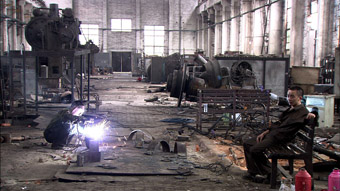
24 City (Er shí sì chéng jì)
AT A TIME WHEN EVERY SECOND ‘UNOFFICIAL’ CHINESE FEATURE FILM FEELS LIKE A SUB-JIA ZHANGKE TALE OF MISERY FROM THE PERIPHERY OF THE NATION’S ECONOMIC MIRACLE, IT’S REFRESHING TO SEE THE MAN HIMSELF EXPLORING NEW TERRITORY. JIA’S MOST RECENT FEATURE, THE DOCUMENTARY-DRAMA HYBRID 24 CITY, CONSIDERS CHINA’S DRAMATIC ECONOMIC TRANSFORMATION THROUGH THE STORY OF FACTORY 420—ONCE A STATE-OWNED INDUSTRIAL SHOWPIECE NOW BEING KNOCKED DOWN TO MAKE WAY FOR LUXURY APARTMENTS. THE 19-MINUTE SHORT DRAMA CRY ME A RIVER IS A MORE CONVENTIONAL PORTRAYAL OF THE DISILLUSIONMENT AND ENNUI OF MIDDLE AGE, BUT WITH A PARTICULARLY CHINESE HISTORICAL INFLECTION.
24 city
24 City focuses on Factory 420, formerly a vast military industrial plant that producead parts for Chinese warplanes. Originally situated in Shenyang, northeast China, the factory and many of its personnel were relocated to Chengdu, deep in the country’s interior during the Korean War. As one of the managers recalls, in its heyday 420 was a self-contained city, employing thousands and tending to all their material needs, including meals, housing, schools and cinemas. With China’s move to a market economy, Factory 420 has fallen on hard times and the workforce has steadily shrunk since the mid-1990s. What’s left of the former behemoth is now being moved to Chengdu’s outskirts to make way for a luxury high-rise apartment complex called 24 City.
Jia’s film opens with images of overall-clad workers shuffling in and out of buildings en masse, and a manager addressing the workforce in a dingy meeting hall about looming changes in the factory. The overall impression is one of drab conformity.
From this broad beginning we hone in on the first of the film’s interviewees, He Xikun, who first came to Factory 420 in the early 1960s. Recalling the frugal, self-sufficient ethos of that era, He explains how workers were expected to forge their own tools when they arrived at the factory. Darker memories also surface when He discusses how his dedicated supervisor continued coming to work at a time when most employees stayed away—presumably a reference to the chaotic early years of the Cultural Revolution. Details of the period elude us though, as He Xikun becomes visibly distressed and lapses into silence.
A long series of interviews with former factory personnel follows He’s foreshortened tale, including an ex-party secretary and a woman laid off in the mid-1990s. It gradually becomes clear, however, that 24 City is not a straightforward talking-heads documentary, since at least some of the interviewees are in fact actors. For different audiences this realisation hits at different points; many non-Chinese viewers don’t register the presence of professional performers until Joan Chen appears towards the end of the film. In fact the first actor to appear is Lu Liping—famous in China, but not widely known outside the country.
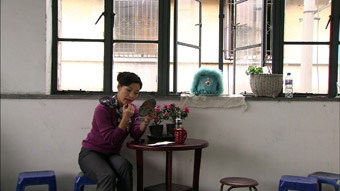
24 City (Er shí sì chéng jì)
With his undifferentiated mixing of workers and actors, Jia deliberately challenges the assumptions and investments we tend to bring to documentaries, an interrogative approach most clearly illustrated in his ‘interview’ with Gu Minhua, the worker played by Joan Chen. She recounts her arrival at Factory 420 at the end of the 1970s, where she quickly gained the moniker “Xiao Hua” (Little Flower), due to her resemblance to the main character of a famous eponymous Chinese film of that time—the punchline being that it was this role that made the teenage Chen a star in mainland China.
Zhang Zheng’s Xiao Hua (1980) told the story of a young woman’s love for a revolutionary soldier during China’s protracted civil war. The film was typical of the immediate post-Mao era in that it personalised China’s revolutionary history through a love story, in contrast to the collectivist ideals pushed during the Cultural Revolution. It’s a good example of the way China’s mass media—including the nation’s cinema—has long been subject to the Communist Party’s ever-changing ideological line. By using Chen as one of his ‘workers’, and having her reference her early propagandistic features, Jia asks his audience to reconsider and question the historical narratives they have been fed over the years, particularly on the silver screen.
In the end, of course, this reflexive approach leads to a circle of maddening questions. What, if anything, is real in 24 City? More broadly, in a nation where official historical narratives are constantly rewritten to suit the ideological needs of the present, what constitutes the ‘real’ in the history of the People’s Republic? And how do people make sense of their personal histories, let alone the experiences of the nation as a whole, in a country where critical interrogations of the past 60 years are simply not permitted? In this context, the pained silence of the worker He Xikun is perhaps more ‘real’ than the detailed, semi-fictionalised accounts we hear from the actors—but where does this silence leave us in terms of understanding?
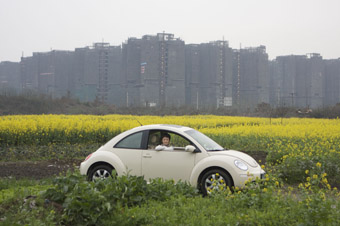
24 City (Er shí sì chéng jì)
The heavily prescribed freedoms of China’s new economic order offer no resolution to these questions for Jia, as the film’s final interview makes clear. Su Na—played by Jia’s personal and artistic partner Zhao Tao—is a “professional shopper” who journeys regularly to Hong Kong to procure goods on commission for rich Chengdu residents. Dressed in fashionable clothes and sporting a chic hairstyle, Su has clearly transcended the dull factory grind endured by her parents. Yet with her uncritical embrace of a materialistic lifestyle it feels as if she has simply swapped the manufactured identity of a model socialist worker for the prepackaged image of the fashionable globe-trotting consumer.
The one moment that seems to transcend the historical conundrums at the heart of 24 City comes when Jia’s camera unexpectedly captures a pretty young girl elegantly roller-blading around a small rooftop on the edge of the factory complex. She pauses as the figure behind the camera asks if her parents work at 420. She nods, and the offscreen voice asks if she has ever been inside the factory. She shakes her head before gliding out of shot to resume her graceful turns.
Is this where truth lies for Jia—in quiet moments of subjective personal expression that transcend words, ideology and history? Or is the sequence’s fleeting sense of freedom simply another illusion?
cry me a river
Cry Me a River is a less ambitious film, but an intriguing detour for Jia into quiet domestic melodrama. Four ex-classmates—formerly two couples—reunite in a watery southern town. Over a small banquet, their one-time teacher recalls a poetry journal they founded in their university days titled This Generation, one of the countless literary periodicals that played a crucial role in the liberalisation of Chinese universities in the 1980s. The next day the former classmates pair off, wandering the town and skirting around their shared past in awkward conversations loaded with hidden meanings.
Jia demonstrates his masterful grasp of mise-en-scene by conveying much of the work’s subtext through framing and setting. One couple wander listlessly beside a still lake, lost in thought, hinting vaguely at the passionless state of their marriages and working lives. The other pair move through the town’s canals on a small boat, rocking as they verbally spar, stoking the embers of a passion still gently smouldering, but unlikely to reignite.
Cry Me a River harkens back to Fei Mu’s similarly restrained 1948 classic Spring in a Small Town, set in the aftermath of the Japanese War. Both films centre on characters trapped in the slipstream of larger events which are only elliptically alluded to. Jia’s work is not simply homage however. Cry Me a River updates Fei Mu’s drama by deftly evoking the lost hopes of China’s 80s generation, whose idealism has dissipated under the combined weight of political repression and apathy fuelled by the nation’s increasing material wealth.
In very different ways, Cry Me a River and 24 City show Jia Zhangke turning an ever more nuanced critical eye on his homeland. While earlier works like Xiao Wu (aka Pickpocket, 1997) and The World (Shìjiè, 2004) portrayed the losers in China’s new economic order, these recent films subtly probe the dreams, ideals and ideologies that have shaped China’s people over the past 60 years. It’s this complex, critical approach that makes Jia’s work so compelling and so essential in a country yet to come to terms with its past, in a world yet to come to terms with a rising China.
24 City (Er shí sì chéng jì), director, writer Jia Zhangke, writer Zhai Yongming, producers Jia Zhangke, Shozo Ichiyama, Wang Hong; performers Joan Chen, Lu Liping, Zhao Tao, Chen Jianbin; People’s Republic of China, 2008; Cry Me a River (Héshàng de àiqíng), writer, director Jia Zhangke, performers Zhao Tao, Wang Hongwei, Hao Lei, Guo Xiaodong, People’s Republic of China, 2008.
RealTime issue #94 Dec-Jan 2009 pg. 23
© Dan Edwards; for permission to reproduce apply to realtime@realtimearts.net
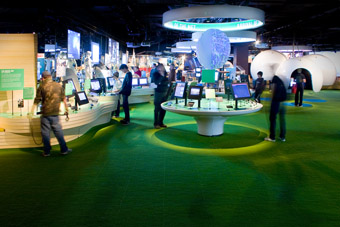
Emergence, Screen Worlds installation
photo Travis de Clifford
Emergence, Screen Worlds installation
ON A DRIZZLY, GREY SEPTEMBER MELBOURNE MORNING THE GLAMOROUS AND COSY CATE BLANCHETT, DRESSED IN OFF-THE-SHOULDER CROCHET, CUT A RIBBON OF CELLULOID TO LAUNCH THE AUSTRALIAN CENTRE FOR THE MOVING IMAGE’S PERMANENT, FREE ADMISSION SCREEN WORLDS EXHIBITION. A BIG CROWD STREAMED IN TO SEE THIS HIGHLY ANTICIPATED SHOW, ONE DESIGNED TO DEPICT THE EVOLUTION OF FILM, TELEVISION AND DIGITAL CULTURE.
Organised across three rooms focusing on Emergence, Voices and Sensation, the past, present and future of the moving image is traced across time and framed within an international matrix. A combination of white cube and black box, Screen Worlds incorporates objects designed for the eye with dynamic interactive touch screens.
Emergence is divided into six table displays featuring the arrival of film, sound and colour, television, global broadcast, video games and the internet with each world identified by a circular banner hovering above the exhibits. Emergence is full of objects, screens, still and moving images and even machines, so the banners are integral in providing a sense of cohesion. Wall displays illustrate and expand on the connections providing satellite examples of innovation specific to the era. Precious artefacts representing optical experimentation and pre-cinematic devices include an exquisite collection of Chinese shadow puppets from the late 19th century and a magic lantern complete with slides and the projected illusion of a ship bobbing on an ocean. Peep boxes display single shot ‘actualities’ like Annabelle’s Skirt Dance (WKL Dickson,1896), the flowing robes evidence of the fascination with the particulars of movement in early cinema.
Technological illusion generates “an aesthetic of astonishment”, a phrase coined by the film theorist Tom Gunning to describe the wonder of the illusion and pre-cinematic optical technologies. A range of interactive screens engage the senses. On one visit I noticed a small child letting his fingers lead him through the space, pausing at moments when his touch created action.
One interactive screen invites participants to investigate locations filmed with cameras exported by the Lumière brothers. Touch screens reveal sequences from the 1896 Melbourne Cup, Japanese sword fighting and Italy’s Grand Canal. Vivid colour reproductions of the Salvation Army’s Soldiers of the Cross (1900) sit alongside sequences from the first film produced in Australia, The Kelly Gang (1906), its imagery layered with the bubbling of decomposing nitrate film stock. This film is juxtaposed with Gregor Jordan’s 2003 version of Ned Kelly, forming sequences of diachronic associations.
The diversity of early cinema is represented by the mesmerising rhythms and imagery of key modernist films including Man Ray’s Le Retour à la Raison (1923) and Fernand Léger’s Ballet Méchanique (1924). A big screen shows scenes from epic films designed to generate nationalistic fervour. Sequences include the slaying of a gigantic mythological creature from Fritz Lang’s Die Nibelungen (1924), mass crowds from Giovanni Pastrone’s ‘super spectacle’ Cabiria (1914) and magical images of characters flying through the air on giant spears from Hou Yao’s Tale of the Western Chamber (1927).
The section celebrating the arrival of sound and colour features a Steenbeck film viewing machine that allows participants to wind celluloid through sprockets to discover the speed of sound film, 24 frames per second. A thick MGM disc, The Hollywood Review Trailer (1929) is a quirky example of early attempts to synchronise sound to the projected image, but the unique value of this artefact is evident in detail on the label revealing that the disc has only been used once.
A lucite television set created for display at the New York World’s Fair in 1939 announces the arrival of TV. Its transparent façade renders visible an intricate system of valves and wires. The diversity of local voices is emphasised with exhibits like “Finding a Voice”, a touch screen collection of sequences representing documentary explorations of Australian Indigenous cultures. Wrong Side of the Road (Ned Lander, 1983) and Two Laws (1981) by the Booroloola Aboriginal community are the highlights of this collection. The impact of popular culture is evident in Bongo Starr’s boots encased in glass in front of a portable Princess Seven television screening his glam rock band Skyhooks on Countdown. The same screen also displays the self-reflexive chaos characteristic of The Aunty Jack Show (1972-3) as characters greet the transition to colour washing over the small screen by attempting to swim through the flood. Animation, comics, posters and a sleeping action figure of Astro Boy showcase an early example of media convergence. The extension of the global village into the skies is illustrated by fuzzy black and white images of the 1969 moon landing alongside screens depicting the astonishment of audiences watching live. Influence of the space race is evident in the JVC Videosphere TV from 1970, a spherical television set with curved screen resembling an astronaut’s helmet.
The room showcasing Australian Voices contains large, stunning objects like the Interceptor car from Mad Max (1979), Dame Edna’s sequined Sydney Harbour dress and a windmill from Baz Luhrmann’s Moulin Rouge (2001). An interactive map spread across a large table represents Australian film locations where sites can be illuminated by touch. A showcase of Australian films represented as a collection of small slides allows for an interactive investigation of specific film, television, visual art and digital images. Curated by Indigenous cultural advisors, the Blak Wave exhibit includes records and cassettes by artists like The Warumpi Band alongside Indigenous television programs. Smaller enclaves representing the work of specific filmmakers fringe the edges of the room. The spaces spotlight Tracy Moffatt, Animal Logic, Christopher Doyle, Jill Bilcock, Baz Luhrmann and Catherine Martin, Cate Blanchett, David Gulpilil and Rolf de Heer (whose space includes a canoe!). Scripts, awards and photo albums are archived here, but the magic is in the inclusion of trinkets like rocks and a tiny model motorbike with sidecar, talismans used by screenwriting team Sue Smith and John Alsop.
A games lab leading into the Sensation space features small screens where participants can play classic games like Bejewelled, Half Life, Lemmings and Tetris and design creatures for the beautiful underwater world of Spore. A big screen invites a public challenge in a range of interactive Wii games. Sensation draws together new and older technologies and it is here that the visitor can become immersed in illusions created by new media. Ty the Tasmanian tiger forms part of an Australian themed Zoetrope. Inspired by Eadweard Muybridge’s experiments with time and motion, the ‘flicker fusion effect’ invites visitors to create their own flipbook. The Matrix-style time slice installation uses 36 cameras to capture the action of participants and transmits the video clip via email. Philip Worthington’s Shadow Monsters (2005) adds beaks, claws, scales, horns, teeth, puffs of smoke and wispy strands of hair to silhouettes of bodies, transforming humans into prehistoric animals.
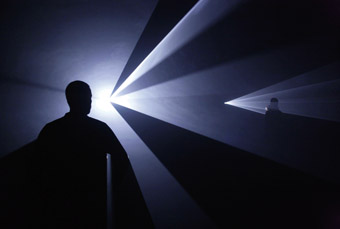
You and I, Horizontal II, Anthony McCall
photo courtesy ACMI
You and I, Horizontal II, Anthony McCall
But the most astonishing immersive installation is kept until last. Behind a curtain at the end of the Sensation area, Anthony McCall’s You and I, Horizontal II from 2006 combines a haze machine with a video projection of solid white light to immerse participant and installation. I noticed that same young boy who greeted the exhibits with a touch earlier, now swimming in the hazy light, his head and arms illuminated by the white neon.
Until the opening of Screen Worlds, the single exhibit occupying ACMI’s ground floor was the Academy Award for Harvie Krumpet (Adam Elliot, 2003). Now this luminous award sits at the heart of Screen Worlds surrounded by relics, machines, screens, games, sounds, light and illusion, an impressive and dynamic history of the moving image.
Screen Worlds: The Story of Film, Television and Digital Culture, free, permanent exhibition, Australian Centre for the Moving Image, Melbourne, opened Sept 20, www.acmi.net.au
RealTime issue #94 Dec-Jan 2009 pg. 24
© Wendy Haslem; for permission to reproduce apply to realtime@realtimearts.net
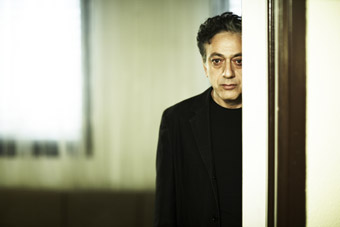
The Time That Remains
IN 2008, I ATTENDED THE FIRST PALESTINIAN FILM FESTIVAL IN SYDNEY, AN EXCITING NEW INITIATIVE FROM CULTURAL MEDIA, A NOT-FOR-PROFIT ORGANIZATION ESTABLISHED IN 2007 TO PROMOTE INTERCULTURAL UNDERSTANDING BY SHOWCASING ARAB ARTS AND CULTURE. THE FESTIVAL WAS A GREAT SUCCESS, DRAWING LARGE AND DIVERSE AUDIENCES. THIS YEAR, CULTURAL MEDIA HAS EXPANDED ITS REACH, SCREENING NOT ONLY IN SYDNEY BUT ALSO IN MELBOURNE AND ADELAIDE. I ATTENDED IN SYDNEY AGAIN, WHERE THE FESTIVAL IS CLEARLY BUILDING ON ITS ENTHUSIASTIC FOLLOWING.
Slingshot Hip Hop, one of the most popular films from the 2008 festival, screened again in 2009, giving Cultural Media the opportunity to take this amazing film to other capital cities. Directed by Jackie Reem Salloum, this beautifully crafted documentary follows the emergence of hip-hop amongst young Palestinians living in Gaza, the West Bank and inside Israel. The film demonstrates the power of hip-hop as an educational tool that gives young people in Palestine the opportunity to speak their minds, to build self-esteem and to connect with each other. The filmmaking process itself even facilitates efforts made by these rappers to support each other despite the walls and the checkpoints that keep them apart, a plight felt most acutely by the group PR from Gaza, desperate to meet their fellow hip-hop artists in the flesh and hold them in their arms.
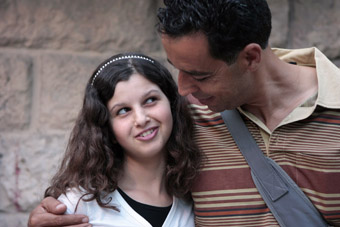
The Heart of Jenin
The documentary The Heart of Jenin, directed by Markus Vetter and Leon Geller, also tells a story that travels between the ugly walls that divide Gaza, Israel and the West Bank. The film follows Ismail Chatib, a Palestinian living in Gaza whose 12-year-old son, Ahmed Chatib, was fatally shot by Israeli soldiers.
With Ahmed on life support in an intensive care unit inside Israel, Ismail decides to donate his son’s organs to six Israeli children, a decision that gains a lot of media attention and is seen as a compassionate, peaceful act in the midst of a devastating conflict. The film follows his visits to these children and their families as well as offering an intimate portrait of what it means to live in Gaza, capturing the hopes and fears of those most restricted by the occupation.
The short animation Fatenah, directed by Ahmad Habash, illustrates the story of a young woman living in Gaza who faces great difficulties obtaining proper medical care for breast cancer under occupation.
A whole program of shorts showcased new work from around the globe including another animation, Encyclopaedia Britannica, made in Australia and directed by the festival’s artistic director Sohail Dahdal. Arafat & I, set in London and directed by Mahdi Fleifel, was also a highlight of this session, a hilarious story about a young Palestinian Londoner who thinks he has fallen in love for life when he goes out on a date with a woman born on the same day as Chairman Arafat.
Equally quirky was the festival’s opening night film, The Time That Remains, a semi-autobiographical work directed by Palestine’s most celebrated director, Elia Suleiman. The film depicts historical events that have affected generations of Palestinians since 1948, capturing the absurdity of daily life under occupation with candour and humour.
Edward Said: The Last Interview, directed by Mike Dibb, interviews one of Palestine’s most celebrated intellectuals, who spent most of his life living in America. Said gives insights into his life, his writings, his preoccupations, the legacy of his most famous book, Orientalism, and his involvements in Palestinian politics.
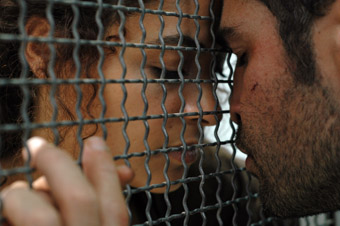
Pomegranates and Myrrh
Pomegranates and Myrrh, directed by Najwa Najjar, tells the story of Kamar (Yasmine Elmasri), whose husband, Zaid (Ashraf Farah) is thrown into an Israeli jail for refusing to give up his family’s land when it is appropriated by the Israeli government. The film shows the immense impact these two events have on Kamar as she tries to continue her day-to-day life.
In Sydney and Melbourne, the festival also included an advance screening of Amreeka, directed by Cherien Dabis, a gorgeous story about Muna (Nisreen Faour), a Palestinian single mother who migrates to America with her son, Fadi (Melkar Muallem), with hilarious and horrible results. Amreeka talks about family, racism, culture shock, love and misunderstanding in a way that beautifully connects the major political issues of our time with everyday lived experience. It is this power of cinema to make connections between different places and times that is at the heart of the Palestinian Film Festival.
In recent years, we have witnessed an explosion of touring festivals showcasing national cinemas in Australia. These have become an extremely popular part of the film exhibition landscape across our major capital cities. The most established and successful on the circuit include the Alliance Francaise French Film Festival, the Festival of German Films and the Spanish Film Festival. Other, newer festivals are gaining in popularity including the Canadian Film Festival and the Israeli Film Festival.
The Palestinian Film Festival is particularly significant within this fast growing film festival landscape because of the ongoing struggle of the Palestinian people to have their national identity and their right to nationhood recognised at all. Most of the other film festivals I have mentioned are run by government funded organisations with the express purpose of promoting national cultures in Australia. The Palestinian Film Festival is funded by an independent not-for-profit organisation that fulfils this function for Palestinian culture in the absence of a similar level of government infrastructure.
The Palestinian Film Festival is testimony to the vibrancy of Palestinian film culture, both at home and in the diaspora. The diverse, award-winning films screended this year crossed genres, experimented with form, went out onto the streets, re-imagined intricate family histories, captured deep personal intimacies and celebrated lives lived in all of their complexity.
2009 Palestinian Film Festival, artistic director Sohail Dahdal; Cultural Media director Naser Shakhtour, Palace Norton Street Cinemas, Sydney, Oct 29–Nov 1; Cinema Nova, Melbourne, Nov 12–15; Mercury Cinema, Adelaide, Nov 13–15
RealTime issue #94 Dec-Jan 2009 pg. 25
© Megan Carrigy; for permission to reproduce apply to realtime@realtimearts.net
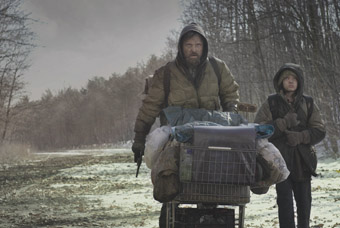
The Road
WINNER OF THE 2006 PULITZER PRIZE FOR LITERATURE, CORMAC MCCARTHY’S THE ROAD WAS A BOOK THAT SURPRISINGLY CAPTURED THE AMERICAN IMAGINATION, KICKING READERS IN THE GUTS WITH ITS POST-APOCALYPTIC VISION OF A FATHER AND SON DESPERATELY SCAVENGING TO SURVIVE IN A SAVAGE WORLD WHERE ALL SENSE OF MORALITY HAS BEEN ANNIHILATED. MCCARTHY FAMOUSLY DECLINES GIVING MANY INTERVIEWS (PERHAPS WISELY: SEE YOUTUBE FOR A RARE ONE WITH OPRAH WINFREY) BUT HE HAS DEDICATED THE NOVEL TO HIS SON, SEEING IT AS A LOVE STORY—THE KIND OF AFFECTION THAT CAN BE SHAPED BETWEEN A MAN AND HIS BOY.
McCarthy’s books have been ripe for the picking. The Coen Brothers’ No Country for Old Men, starring Tommy Lee Jones and a bewigged Javier Bardem, was one of the more memorable films of recent years, but The Road doesn’t appear at first to be an easy novel to adapt to screen. For starters, it’s unrelentingly bleak. The despair, agony, horror, barely lets up. Like Cold Mountain (from the novel by Charles Frazier, director Anthony Minghella, 2003), the endless walking on uncertain soil, the rain, the loneliness, the tension over whether to trust strangers, makes it a constant grind. It’s also an incredibly internalised fiction—the monologue of a man who doesn’t talk much, staggering along a road in a wasteland with his son, searching for food and fuel. In the novel the majesty of the sparse prose elevates it to the poetic at times, making certain moments ambiguous (a device the film struggles with). And you can always put the book down when it gets too much (which I did. Often).
Australian director John Hillcoat’s style is well-suited to this tale. His feature The Proposition (2005; RT 70, p18) was an outstanding exploration of violence and the horrors of Australia’s colonial past. Here, transposed to the near-future, he conveys the same intensity in a world where all characters are lost and searching, in a landscape so desolate that to be able to choose to die is a luxury. He brings along some of the same cast and crew from The Proposition (Guy Pearce in a pivotal role; editor Jon Gregory; and production designer Chris Kennedy and costume designer Margot Wilson) and an evocative soundtrack created by Nick Cave and Warren Ellis. The music, combined with the outstanding cinematography by Spain’s Javier Aguirresarobe and faultless set direction, make for some unforgettable scenes of environmental destruction: the creaking of dead trees in the wind, always threatening to fall; a series of earthquakes where they are uprooted, almost killing the man and boy; ridges on fire climbing above them; abandoned freeways hovering above empty rivers; an ocean of grey water lapping onto lifeless sand. The film landscape becomes a world completely without sunlight or colour, except of course for the rare glimpses the boy observes: rainbows in a waterfall; a Coke can with bubbles he savours; a cellar treasure trove of tinned food like peaches and fruit cocktail.
Hillcoat comments: “Neither Chris [Kennedy] or myself have ever really liked apocalyptic films that much as a genre. But this felt so different from anything else…we immediately began doing a lot of research in which we were basically looking at man-made and natural disasters that have occurred, and that’s what led us to things like New Orleans post-Katrina, and Mount St. Helens in Washington and mining in central Pennsylvania and around Pittsburgh where that industry left a kind of man-made disaster area in terms of the landscape—what’s left of it. So the process was about utilising all those things and gradually piecing it all together. It was like this huge tapestry.”
Vigo Mortensen (as The Man) and Australian actor Kodi Smit-McPhee (The Son) are superb in demanding and, at times, difficult to convey roles. Along with their packs they carry the burden of the film on their shoulders. Mortensen is always strong, drawn to characters with a sense of justice, often compromised by violent circumstances (the David Cronenberg films, A History of Violence, Eastern Promises) and he has that rare combination of physical strength and deep sensitivity. Smit-McPhee proved he could explore complex emotions well beyond his years in Romulus, My Father (2007) and here his despair, fear and sense of loss are carried in the way he walks and the questions he asks (“Are we still the good guys?”). While his father is teaching him to distrust others (to save his life), the boy resolutely maintains a belief in compassion, a lesson that pays off. Their situation is so dire that much hinges on the gun the father carries and the number of bullets it contains. Each bullet is a little ray of hope: rather than die in a horribly sadistic way (be starved to death; raped; eaten slowly by roaming vigilantes) there’s an easy out. It’s rare in a film to be considering that perhaps the central character, a small boy, may be better off dead rather than facing such a world on his own (as his mother believes before she walks into the snow in a light shirt to freeze to death) and these are the choices the father must grapple with.
With the film’s release date postponed for a year from November 2008 in the States, you get the sense that the distributors might be nervous. Perhaps they think such a film might be a hard sell in a world where people have enough bleak visions surrounding them. But McCarthy’s book is wise enough not to state how the world has come to this dire position. Questions hover over the entire film. Why? How? The same questions being asked now about the economic crisis. About the impact of climate change and habitat destruction. About how we treat refugees. About the kind of environment we want our grandchildren to be born into. Hillcoat’s film doesn’t give any answers. But the questions raised are enough.
The Road, from the novel by Cormac McCarthy, director John Hillcoat, writer Joe Penhall, performers Viggo Mortensen, Kodi Smit-McPhee, Charlize Theron, Guy Pearce. producers Paula Mae Schwartz, Steve Schwartz, Nick Wechsler, editor Jon Gregory, production designer Chris Kennedy, cinematographer Javier Aguirresarobe, original music Nick Cave, Warren Ellis. Opens nationally Jan 28.
RealTime issue #94 Dec-Jan 2009 pg. 26
© Kirsten Krauth; for permission to reproduce apply to realtime@realtimearts.net
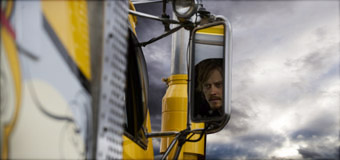
Prime Mover
DAVID CAESAR, AS GUEST JUDGE ON ABC’S RACE AROUND THE WORLD (1997/98), USED TO LOVE GETTING STUCK INTO CONTESTANTS WITH HIS ACID WIT. HIS ONSCREEN CONFRONTATIONS WITH JOHN SAFRAN (NOW TORTURING HIMSELF AND US—IN A GOOD WAY—WITH RACE RELATIONS) IN PARTICULAR WERE FUN TO WATCH. BUT IT’S LIKE HE WAS ASKING FOR IT. YOU WATCH HIS FILMS WITH THE SAME CRITICAL EYE.
Prime Mover begins as a fable… “Once upon a time in Dubbo.” From there it moves into tragedy (a father dies), romantic comedy (boy meets girl, marriage, music, babies), magical realism (his fantasies start to come alive), a road movie (he buys a truck to cruise the highways), a small-time crime thriller (he borrows money from the wrong people), an addiction tale (he gets hooked on drugs to stay awake), a horror film (chased in his truck, his face gets smashed into an ugly pulp), a revenge story (he crashes his truck into the crim’s house), a social realist plot (his wife is torn apart by postnatal depression) and, of course, there’s the tale of redemption (all is forgiven because he did everything to achieve his dreams). The problem is, I was quite happy hanging back there with the romantic comedy.
While Idiot Box and Mullet were gritty depictions of characters skirting the edges of society, Caesar’s more recent Dirty Deeds had similar narrative problems to this latest offering—a great beginning leading to a strange and too-long melange where too much is never enough; Caesar doesn’t appear to know when to stop. It’s a shame because he writes and directs romance and comedy brilliantly but doesn’t seem confident enough to stick with them. From the start Thomas (Michael Dorman) and his “warrior queen of the bowsers” Melissa (Emily Barclay) are inspired characters, bouncing off each other with gentle innuendo, their dialogue a nice mix of the rough and smooth, seductive and fun. When they make love for the first time, he gets her to hold a dirty big wrench. And I settled in for a quirky, offhand romance where the happily ever after happens at the beginning rather than the end.
But when plot quickly overtakes characterisation, the film loses its charm (although Prime Mover could join the ranks of Ozploitation flicks, highlighted in the documentary Not Quite Hollywood; Tarantino would love the truck chases.) Thomas, witness to his father’s grisly death (for which he feels responsible), is a talented ‘pinstriper’ [creator of custom designs on automobiles, Ed], with shiny dreams of his own big rig. He doesn’t seem to realise that driving it will take him away from his lover and new daughter, now abandoned in an isolated caravan in a dusty world where even the pool is concreted over and behind barbed wire. Although she is desperate for his help with a screaming baby who never stops—even admitting she’s scared she’s going to kill her daughter—he sets off once again into the night, and seems surprised when he returns to find her gone. It’s a familiar tale but the dramatic interest seems to lie in what’s happening offscreen with Melissa (Barclay being one of the best young actresses around) rather than the convolutions of bad-boy Ben Mendelsohn and his dumb lackeys.
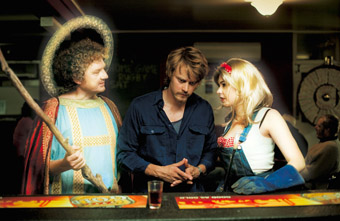
Prime Mover
photo Mark Rogers
Prime Mover
The magical realist elements are an intriguing addition and work well, inspired by Thomas’ swirling designs. His delusions become grander as he stays awake for long stretches, the drugs reaching in to take him down. His father’s likeness becomes Saint Christopher, the patron saint of truckers, whispering good will and sense into one ear; Melissa materialises as a naughty calendar girl brought to life (there’s that wrench again), encouraging him to turn to the dark side.
Caesar has a romantic vision of the little Aussie battler doing anything to realise his dreams—as in Kenny, The Castle and Crocodile Dundee. And he believes in sustained love too. In Prime Mover it seems early on that Caesar is going to turn a genre on its head, exploring the nature of romance and dreams where a couple hits the road gypsy-style. But he has the dark angel sitting on his other shoulder, encouraging him to go big, appeal to all markets; opt for car crashes, drugs, money, mindless violence. David Caesar has great insight into the joys and challenges of modern relationships; I wish he would just stick with them.
Prime Mover, director, writer David Caesar, producer Vincent Sheehan, performers Michael Dorman, Emily Barclay, Ben Mendelsohn, Gyton Grantley, William McInnes, Anthony Hayes, Lynette Curran, Jeanette Cronin. cinematographer Hugh Miller, editor Mark Perry, production design Nell Hanson, original music Paul Healy
RealTime issue #94 Dec-Jan 2009 pg. 27
© Kirsten Krauth; for permission to reproduce apply to realtime@realtimearts.net
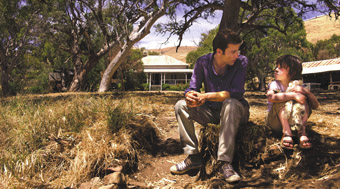
The Boys Are Back
EVERY SECOND FILM I SEE THESE DAYS SEEMS TO BE ABOUT THE TENUOUS RELATIONSHIP BETWEEN FATHERS AND SONS. I DON’T KNOW IF IT’S JUST BECAUSE I’VE RECENTLY GIVEN BIRTH TO A BOY AND I’M BEING DRAWN IN UNCONSCIOUSLY, BUT IN RECENT MONTHS I’VE CAUGHT THE ROAD, LAST RIDE, AND NOW THE BOYS ARE BACK, A DRAMA ABOUT AN ENGLISH SPORTS WRITER JOE (CLIVE OWEN), LIVING IN AUSTRALIA WITH HIS SIX-YEAR-OLD SON, STRUGGLING WITH FATHERHOOD AFTER THE DEATH OF HIS SECOND WIFE.
It’s taken 12 years for Scott Hicks to return to work here after the enormous success of Shine. In the meantime he’s been flirting with Hollywood—making Snow Falling on Cedars, Hearts in Atlantis and No Reservations—before embarking on the Emmy-nominated documentary, Glass: A Portrait of Philip in Twelve Parts.
At a recent Q+A in Sydney with Sydney Film Festival director Clare Stewart, where he introduced the film, Hicks spoke of being reinvigorated in his passion for filmmaking after working on the documentary and, when sent the screenplay of The Boys Are Back, he realised that he’d never seen such an honest exploration of father-son relations on screen; the truth of the dialogue struck him most. Based on a memoir (originally set in New Zealand) the script was transplanted to Queensland and then set on the beautiful coast of South Australia (at times it looks like a tourism ad), with the landscape and characterisation once again captured elegantly by cinematographer Greig Fraser (who also worked on the outstanding Last Ride by Glendyn Ivin and Jane Campion’s soon to be released Bright Star).
What The Road, Last Ride and The Boys Are Back all have in common is tour-de-force performances from the central young actors. Scott Hicks obviously has a talent for directing young people (along with seasoned performers like Geoffrey Rush). Six-year-old Nicholas McAnulty is a revelation as Artie, a passionate boy who loses his mother to illness. When his mother dies in bed next to Joe, his delivery of the line “Is mum dead yet?” with such apparent nonchalance hits the mark—he seems able to repress his emotions, just as a grieving boy would, unleashing them at unexpected moments. His exhilarating lust for life (riding on the bonnet of a 4WD as it zooms down the beach; jumping from a great height into a spa with his goggles on) grabs you from the beginning and helps propel the movie, saving it from some slow moments. It’s not often in film that the charisma of Clive Owen is upstaged. Hicks said that they cast a wide net for the role but McAnulty, along with a sweet expressive face, had ‘attitude’ and that’s what they needed. As his teenage brother Harry, George MacKay is also a standout, conveying all the complexities of being the older child trying to find his place in a new family, carrying the burden of his parents’ divorce.
While Scott Hicks directs with a light touch, Clive Owen interrogates the character with typical intensity and much of the screenplay is beautifully convincing, there are wavering elements that don’t quite work. The dead mother reappears to Joe as a kind of guide at difficult moments with Artie, helping him cope. The audience, too, sees her in the flesh, before she disappears from Joe’s vision. While it’s true, as Hicks comments, that many who have lost partners often do claim to see them (after death) to talk things through, it’s hard to get this right on screen. Hicks acknowledges the difficulty, saying that he didn’t want any suggestion of a ghost and also cut back the scenes involving her quite extensively. But it still feels awkward when she appears, somehow detracting from the solidity of the surrounding performances, perhaps because we don’t really get to know her character because she dies early on, and there’s no real chemistry sustained between her and Owens. In the recent animated film Up (Pete Docter, Bob Peterson, Pixar, 2009), the old man Carl (voiced by Ed Asner) speaks to his dead wife Ellie too but in this instance it works, the film full of melancholy and pathos because he just speaks aloud; she’s no longer physically present but he believes she can hear him.
One of the bonuses of this year’s Australian feature film viewing has been the chance to see established filmmakers (Hicks, Beresford, Kokkinos, Luhrmann, Connolly, Caesar) screening alongside exciting newcomers (Glendyn Ivin, Rachel Ward, Adam Elliot, Warwick Thornton). The industry, like Scott Hicks, finally seems reinvigorated and it’s been worth the wait. The Boys Are Back is yet another example of a finely tuned drama full of rich, memorable dialogue, spontaneous humour and convincingly restrained performance from Owen and the boys.
The Boys are Back, director Scott Hicks, writer Allan Cubitt from the Simon Carr novel, producers Greg Brenman, Timothy White, performers Clive Owen, Laura Fraser, George MacKay, Emma Booth, Nicholas McAnulty, Julia Blake, Emma Lung, Erik Thompson, editor Scott Gray, production designer Melinda Doring, cinematographer Greig Fraser, original music Hal Lindes. Q+A with Scott Hicks and Clare Stewart, Palace Academy Twin, Sydney, Nov 8.
RealTime issue #94 Dec-Jan 2009 pg. 28
© Kirsten Krauth; for permission to reproduce apply to realtime@realtimearts.net
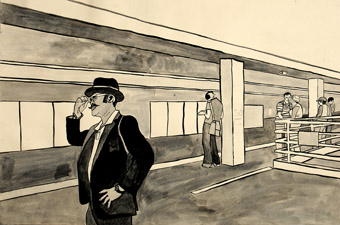
Drawings for Play Pause 2001-06, Gouache on Paper, collection of the artist.
© Sadie Benning
Drawings for Play Pause 2001-06, Gouache on Paper, collection of the artist.
TO TELL THE STORIES OF THE CITY, MICHEL DE CERTEAU REMINDS US, YOU CANNOT APPROACH URBAN SPACE FROM ON HIGH. YOU HAVE TO BEGIN WITH THE FOOTPATH. FOR DE CERTEAU, THE CITY COMES TO LIFE AT THE GROUND LEVEL WHERE, CLASPED BY THE BUSTLE OF THE STREETS, BODIES WILL ENCOUNTER ONE ANOTHER IN VARYING MODES OF CONNECTIVITY (AS LOVERS, FRIENDS, WORK COLLEAGUES, OBLIVIOUS PASSERS-BY). IN THE CITY AS LIVED-SPACE, PEDESTRIANS TREAD THEIR OWN EXPRESSIVE PATHS OF CIRCULATION AND CONNECTION AND PHYSICALLY ‘WRITE’ URBAN SPACE IN WALKING IT. ON THE STREET, ACCORDING TO DE CERTEAU, THE STORIES OF THE CITY ARE SPOKEN BY A CHORUS OF FOOTSTEPS.
On view earlier this year in the lobby gallery of the Whitney Museum of American Art, Sadie Benning’s latest video installation, Play Pause (2006), captures the chorus of footsteps that make up a day-in-the-life of an anonymous, post 9/11 city. The installation begins, fittingly enough, with hand-drawn scenes of the street, accompanied by an audio-track of echoing footsteps, traffic noises and chirping birds. Play Pause then proceeds to move through hundreds of Benning’s gouache on paper illustrations (created by the artist between 2001 and 2006) which are projected onto two adjoining screens. Arranged in a loose narrative structure and scanned for two-channel projection, the gouaches of Play Pause detail the movements, gestures and everyday practices of a multitude of nameless urban inhabitants. Benning’s characters walk the city, they idle about on the footpath and loiter in doorways; they wait for the bus, travel the subway, watch television, drink, flirt and dance in bars.
Largely black and white, with occasional chromatic flashes of red, green and blue filters, the gouaches of Play Pause favour schematic outlines, bold blacks and grey washes rather than the rendering of intricate detail. They seem child-like and noticeably hand-crafted, reminiscent of the low-fi aesthetic that made Benning’s name as a video artist during the 90s with shorts such as Jollies (1990) and If Every Girl Had a Diary (1992). Shot on a Fisher-Price Pixelvision ‘toy’ camera—that was actually given to Benning by her father, experimental filmmaker James Benning—her early videos are infused with a playful sensibility. They take place in the artist’s bedroom and are often narrated in the first-person (by Benning herself, who appears as a series of close-ups of eyes and lips). Abetted by scrawled notes held up to the camera, puppets drawn and painted on cardboard or objects such as Matchbox cars and dolls, Benning re-enacted the dysfunction and loneliness of adolescence with do-it-yourself charm in these early videos, well before the age of amateur confessionals on YouTube. For all their apparent simplicity, Benning’s shorts are lyrical mixtures of images, music and text. The surface effects of Pixelvision are fleshed out with diaristic confessionals that spoke to Benning’s own lesbian identity, her crushes and confusions and the process of coming out.
Play Pause is a definite departure from Benning’s earlier work. Certainly, there are queer bodies to be found throughout Play Pause—her characters visit leather bars, have gay sex and watch lesbian reality shows on television. That said, the stark minimalism of the drawn line in Play Pause cues us into what this portrait of urban life is really all about—the phenomenological properties of movement, energy and stasis in their own right, as they belong to bodies inhabiting the city from all walks of life. What fascinates about Play Pause is Benning’s continued ability to endow the flat, the drawn and the two-dimensional with a strong physicality. While her earlier videos were often enraptured with material surfaces and an up-close attention to objects, faces and details, they were mainly concerned with the expression of Benning’s own adolescent subjectivity; they matched the effects of Pixelvision (for instance, the heightened textural grain, flattening of space and dull sound that it lends to its images) with the rendering of internal psychic space.
In Play Pause, Benning’s preoccupation with the surface continues through the evocative integration of still drawing and video. Play Pause, however, is not concerned with interiority, much less with the personal autobiography of Benning-the-artist. Directed in collaboration with Solveig Nelson (who also provided ambient field recordings of city sounds for the installation, which are intermixed throughout with Benning’s original score), Play Pause speaks to the city’s chorus of footsteps through highly rhythmic transitions between immobility and movement. Through the gouache drawings and their subtle animation, coupled with the energetic pulse of the installation’s soundtrack, pacing and editing, the work strikingly evokes the very action of walking the city through its stop-start beat and physicality. Benning affectively conveys not just what we might see upon walking this cityscape (sports games, store-front advertisements, dog-filled parks, missed opportunities with another) but, more importantly, what walking the city feels like.
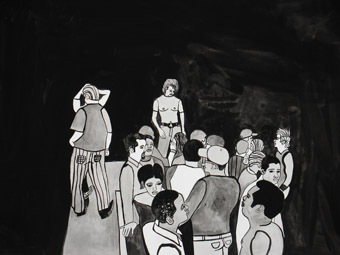
Drawings for Play Pause 2001-06, Gouache on Paper, collection of the artist
© Sadie Benning
Drawings for Play Pause 2001-06, Gouache on Paper, collection of the artist
As the title of Benning’s installation indicates, the piece deliberately oscillates between movement and stasis. Benning’s gouaches will change over every few seconds on the split screen only to cede to durational takes, long shots or close-ups of the still drawings. The sensation of walking is evoked on a number of levels: by the meandering structure and organisation of the drawings, which follow no fixed trajectory and conclude with scenes of an airport and planes taking off (although it remains unclear whether characters are arriving or leaving); and by the juxtaposition of still images against a densely layered sonic atmosphere (the rumble of an underground subway, for example, set alongside drumbeats and electronic percussion). Indeed, it is Benning’s rising and falling score that endows the installation with vibrancy and movement, even when the images on-screen are suddenly arrested.
The stop-start sensibility of Play Pause offers a decidedly physical invitation to its viewer, along the lines of what film theorist and curator Laura Marks would designate its haptic visuality. In these terms, the eye of the viewer becomes restless; our vision is strongly encouraged to move. Instead of being drawn into a perspectival space and the depths of the image, our eyes scan along and across a horizontal surface. Given its interest in the drawn surface, such is the haptic invitation that Play Pause extends to the visitor. Here, the eye can discern the material textures of the ink that has seeped into Benning’s paper or flits between the often speedy alternations of the gouache drawings, moments of unexpected colour on screen and images that seem perpetually on the point of unrest and transition. The haptic actions of the viewer’s eye elicited by Play Pause likewise contribute to the work’s transitions between stasis and movement. We might not walk the city alongside Benning’s protagonists but we emulate the stop-start physicality of the installation itself, through the actions of a roving and embodied eye.
At barely 20, Sadie Benning became the Whitney’s video art darling; included in its 1993 Biennial and once again in the 2000 Biennial. It seems only appropriate that Benning’s latest video installation return to the Whitney as part of its Contemporary Series. This time around, however, Benning is no longer a girl with a video diary. Play Pause suggests the beginnings of a different affective beat from the artist.
Sadie Benning, Play Pause, 2006. Two-channel video projection from hard drive (created from gouache drawings on paper), 29:22 minutes. Director Sadie Benning, in collaboration with Solveig Nelson, collection of the artists; Whitney Museum of American Art, New York, April 22-Sept 20
RealTime issue #94 Dec-Jan 2009 pg. 28
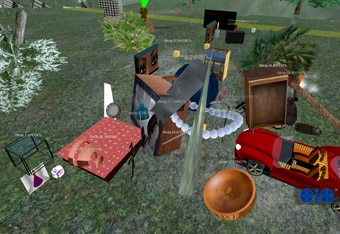
SecondLife Dumpster, Eteam, 2007-2009
THE EXPANDED EXHIBITION FORMAT, NOT JUST COMBINING A RANGE OF ARTIST TALKS AND EVENTS BUT AN ONGOING PROGRAM, IS PECULIARLY UNDER-DISCUSSED AS ONE OF THE DISTINCTIVE MOVEMENTS IN THE PRESENTATION OF CONTEMPORARY MEDIA WORK. FOR THIS YEAR’S BRISBANE FESTIVAL, THE SHOW TOTAL NOWHERE EMOTION EXPANSION AIMED TO KICK UP SOME COUNTRY DUST BY COMBINING AN ONLINE EXHIBIT AND A TRAVELLING GALLERY.
The online exhibition format of a Flash animation of a truck with video embedded on the sides, echoes the in situ experience. The actual Total Nowhere Emotion Expansion truck travelled around south-eastern Queensland, taking in such art hotspots as Yeronga and Marsden, in the manner of a Big and Really Intense Media Art Day Out.
Curator Vivian Hogg’s assemblage of video and interactive work was marked by a sense of humour and vitality; no droll discourses on materiality, no staid framing of the new.
There is something of a connection in the curatorial impulse that ties to the 2008 project The Last Vestige, in which Hogg took part. In that scenario, a boat floating up the Mekong with unusual dreamlike performances and works by artists (all female) arrived at an electronic dance party. An art vehicle emits more than fumes, trails more than noise, but without seeing every performance and program element of Total Nowhere Emotion Expansion, visitors to the Brisbane Powerhouse might have felt that the real action had happened on the road.
Alongside the artworks, screened a short Flash animation made by students of the Brisbane Youth Education and Training Centre and the Brisbane Youth Detention Centre—a rapid-fire dayglo parade of flags and sports imagery. Rather than being a neat social activist adjunct, this piece oddly sets the primary tone of the exhibit—unruly, uninhibited, unconcerned.
The terrifying and hilarious world of Philadelphia-based Ryan Trecartin’s I-BE-AREA series is often described as parodic and sarcastic; but in situ, out of the confines of the internet, there’s little space for any framing. It is simply as if alien intelligences were told what a soap opera was and how it was constructed, and went about making one that bore no relation to our own. The conceit of an entirely independent, internal, formal language makes I-BE-AREA literally compulsive; characters snap fingers and smack their hands, grimacing for the camera and for each other.
Grant Stevens’ The Wandering (Australia, 2009) has the ambiguity of his other recent work, using a production encased in solemn neutrality to build a sense that everything is going to be alright because the world is ending. Here, dream recollections found online are set against simple clouds and MIDI music—but the scenario is anxious, even noxious. Stevens’ previous video work liked to toy with anxiety; The Wandering drips with nuance and precision by making us perform the work of reading/wandering.
Darren Sylvester’s Don’t Lose Yourself in Tomorrow (Australia, 2004) sits alongside Trecartin and Stevens by adding his own sense of staccato weirdness; the apocryphal Pokémon narrative of epileptic children in front of Pikachu’s lightning bolts is inverted. A boy entombed in a merchandised bedroom is watched by the sentinel Pikachu along his shelves and sheets, waiting for the gift of sound and vision. Olaf Breuning’s Old Homepage of 2003 is precisely that; a revisiting of his famously tedious website in which a sequence of dorky collage and sketchbook images would prompt you to type in the next URL.
Jemima Wyman’s video Whakem’all (Australia/USA, 2006) expanded the range of her paralysing colour vortices to the edges of perception by introducing the dialogic stutter of a massive-headed costumed character (see article). Wyman’s images have always been striking, but in video form (or rather, character-video form) waves of disquiet pass over you, making the colours all the more undulating. Nawapol Thamrongrattanarit’s 2006 work Bangkok Tanks was by far the most serious of the works on offer, despite sniggering and jokes from the people watching media coverage of Thailand’s 2006 coup.
Eteam’s Second Life Dumpster (New York/Mannheim, 2007-2009) is one of only a handful of works that mounts any form of effective resistance to the overwhelming awfulness and banality of the Second Life environment. A kind of two-world digestive tract spits out garbage items from random users, which during the course of the work became unmanageable and corrupted. This ‘garden of errors’ aesthetic was perfectly suited to the decaying collective fantasy of Second Life itself. As the few users not funded by arts organisations evacuated Second Life by 2008, Second Life Dumpster was a kind of world in miniature.
Fitting within these manic and comic works was New York-based Brody Condon’s DeResFX.Kill(Karma Physics < Elvis) of 2004, a pink infinity where several Elvises (or should that be Elvii?) twitched and gyrated, powered by the Unreal game engine, in which Condon produced several interactive and video works. His talk during the exhibition program was called Known Planes of Existence, a layered reference to his new age and cult-influenced childhood, and the ongoing deployment of planar metaphors throughout the works themselves.
While Condon was apologetic about his own confusion and the nature of the presentation, a seamless retrospective/contraspective made deeply natural links between divergent works. Early work in computer game modification linked through to sculptural elements, linked through to performance installations, linked through finally to Twentyfivefold Manifestations, a mass-scale performance ritual and sculpture garden that is by far Condon’s most elaborate and confident work. The internal logic of Condon’s occult sensibilities is never used to disengage from art history, but rather to insinuate natural and unnatural superstitions that tie Bruce Nauman to Dungeons and Dragons, Bauhaus to the Branch Davidians.
Since Condon’s presentation only had a handful of audience members, some psychic acceleration took place by way of an extended discussion on generative performances. A world is organised and planned, rules established, a community built, footage collected. Just as Condon references the Abyssal Plane, the macroscopic relationship is irresistible; the exhibition’s mutagenic qualities and travel itinerary lent it a generative, open quality. At once almost infuriatingly simple in tone, but irresistibly high in stakes and hopefully influential as a result.
At the time of going to print, works in Total Nowhere Emotion Expansion could still be seen at www.totalnowhereemotionexpansion.com
Brisbane Festival, Total Nowhere Emotion Expansion, curator Vivian Hogg, exhibition opened Sept 13; Brody Condon Artist Talk, Sept 18; Truck and Brisbane Powerhouse
RealTime issue #94 Dec-Jan 2009 pg. 29
© Christian McCrae; for permission to reproduce apply to realtime@realtimearts.net
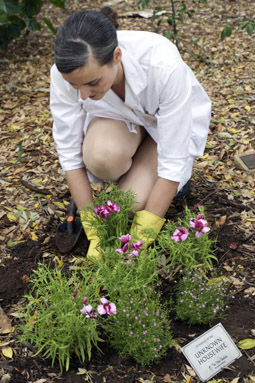
Elke Reinhuber, The Urban Beautician – In Honour of the Unknown Housewife
photo Torunn Higgins
Elke Reinhuber, The Urban Beautician – In Honour of the Unknown Housewife
A KIND OF DILUTED CASUAL URBAN INTERVENTION, OR A PERFORMANCE INSTALLATION FOR THE SUNDAY ARVO BARBEQUE SET? THIS FESTIVAL IS OBSTREPEROUS, YES, BUT IT IS OTHER THAN THE ADOLESCENT AGITATION I REMEMBER WHEN IT TESTED THE CONSTRAINTS OF ITS HOME TOWN A FEW YEARS AGO. IT IS AS IF THE TROUBLESOME SON OF NEWCASTLE HAS MELLOWED, MAYBE RETURNED HOME FOR A WEEK OF CAMPING OUT IN THE LIVING ROOM AND SCABBING LUNCH FROM THE FREEZER. IT EVEN FEELS LIKE WE MIGHT BE WELCOME HERE, FOR ONCE, AS LONG AS WE DON’T LEAVE A MESS IN THE KITCHEN. WE’VE BOTH MOVED ON SINCE THE OLD DAYS, AFTER ALL.
Elke Reinhuber’s domestic performance installation is the crowning hair bun atop the domestic festive spirit. Dressed in the white salon uniform of her “Urban Beautician” persona, she dusts and preens Civic Park as one prepared to lift the corner of the public fountain to dust beneath. Her ultimate intervention is pointedly humble; amidst the plaques to sundry wars and dead local soldiers, she plants flowers, parsley and a memorial plate dedicated to the honour of the Unknown Housewife. Pointed, and displaying anything but the belligerence of the camp of cyberpunk squatters whose stand occupied that same spot in my very first Electrofringe.
The centre of gravity of the festival is not Civic Park this year, mind. Rather, the locus has shifted east to the Renew Newcastle project. There, in the Hunter Street pedestrian mall, an assortment of otherwise disused restaurants and shopfronts have been fished from the jetsam of the shopping strip’s economic shipwreck and converted into art spaces. This arts-space-brokering project has been getting reasonable coverage for its year-round urban revitalisation, and achieves serious momentum by festival time. The spaces are not all at the service of the festival by any means. Indeed, in this diversity of projects there are several that sit below the line of acceptable minimum irony for us Electrofringe crowd. Nonetheless, a goodly proportion are venues—it is Renew Newcastle that provides the wealth of spaces for the festival, and that, perhaps, lends this entire event part of its homely air, with the selection of hand-decorated, informal, idiosyncratic galleries, cafes, boutiques and craft stalls.

The Vinyl Arcade, Lucas Abela with Fred Rodrigues
photo Torunn Higgins
The Vinyl Arcade, Lucas Abela with Fred Rodrigues
Vinyl Arcade (Lucas Abela with Fred Rodrigues) is one such space, wedged between the souvenir and trouser shops. The basement floor of this crypto installation is covered with discarded records, traversed by a toy truck with a record stylus in its undercarriage. Some ingenious sytem of cabling or radio transmitters relays amplified cracks and squeals from the abused needle to the sound system. From the showroom above, the device is remotely operated by boisterously hoonish punters made instantly puerile by that most dangerous of lures, the artistically validated children’s toy. The thumps and clicks of abused records provide a ludic, tactile experience of noise art your grandmother would queue to have a go at. As far as engagement goes, it trounces Abela’s older sit-quiet-while-I-smash-some-glass-on-my-face thing.
Across the way, dLux’s new exhibition, The Garden of Forking Paths, also repays the investment of some playtime. It’s a simple show, computer-game-based art, spanning significant works from the last few decades. Featured pieces include Jaron Lanier’s 1983 Commodore 64 work Moondust, and a 1995 Laurie Anderson interactive CD—from that primordial time when terms like “virtual reality” and “multimedia” seemed to denote intrinsically interesting concepts to entities apart from Australian arts funding bodies. But in context, what may once have seemed grand utopian futurism takes on unassuming playfulness. To my over-stimulated eye, the second instalment of Anita Fontaine and Mike Pelletier’s hallucinatory CuteXDoom game is a addictive, although a more restrained piece, The Path, by Belgian team Tale of Tales, might have weathered better on a less hung-over morning. Neil Jenkin’s curation here creates an exuberant and unitary experience from the DIY psychedelia of Electrofringe and the commercial world of name-brand art, and ties it all together with comfy chairs.
In other mall venues, the space itself is remarkable enough as to be a work in its own right. The most prominent examples are the conversion of two levels of the King Street carpark into an ad hoc zine fair, and the wildly popular op-shop-chic Tortoro’s Tea House in the mall, created by Maddy Phelan. My favourite, though, is the Renew Church, a hidden paragon of 70s architecture just off the main drag that now houses the Renew Newcastle project headquarters. It transpires that a good performance venue transcends both decades and denominations, and the suburban-sacred backdrop is an intriguingly apposite setting for Christian Haines and Paul Gough’s performances. Haines’ delicious spacious tonescape for multiple mobile phones in a darkened room would be worth a listen anywhere, but there is something deeply satisfying about a work based on other people’s phones going off in this most hushed of places. The audio visual works that follow are lovely enough, but none of them elicit, as this one did, a shared sigh from the audience at the end.
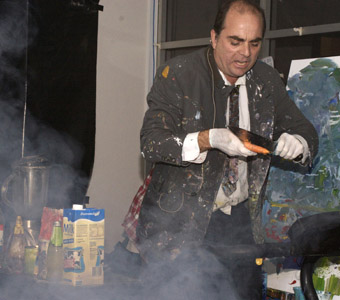
John Kilduff, Let’s Paint TV
photo Torunn Higgins
John Kilduff, Let’s Paint TV
Just down the way, perched above the discount store, is that remarkable venue, the China Club. Of the various shows therein, the most unmissable, and the hardest to miss, is Let’s Paint TV: part performance installation, part public sanitation disaster. Curated by Tim Dwyer, the show pits Los Angeles cable TV sensation John Kilduff against a succession of local artists, a selection of exercise equipment and oil paints. The performer splashes some portion of his ill-mixed pigment on the canvas from a walking treadmill and the rest ends up pooling in a puddle of public liability risk. Professing to instruct in cocktail mixing, oil painting and life-coaching simultaneously, Kilduff’s performances are unrelenting to the edge of cringemaking. His persona, a multi-tasking agony aunt, intercuts his painting with trite life advice, re-inventing platitudes of the ‘everyone is an artist’ DIY ethos as daytime television infotainment. With cameo appearances from a reasonable sampling of every performance artist who has ever been inappropriately naked or messy in a Sydney venue of late, the show is possibly the boldest example of the promiscuous collaboration that Electrofringe has made its name, facilitating at the instant that it mocks what the whole thing stands for.
Oh, and there’s also some obligatory twitter-based artwork, and video installations, and enough firewire leads to span the continent. It is Electrofringe after all. But that old focus on technology, and on the strident politics of participation, are backgrounded, uncontroversial. We’re in a society which mainstreams the debauched participation of Burning Man, where culture jamming is repackaged as community cultural development, and where flashmobs and programmable GPS devices provide ubiquitous recreation for the middle class. Newcastle itself doesn’t seem to feel obliged to muster up the objections it might once have in the face of such a spectacle. I’m hard put to explain whether the festival has lost its edge to an advancing society, or is simply representing a more acceptable, even attainable, vision of change than its earlier utopianism. Or am I’m calling the truce too early?
On the final night, the neo-tribalism of New Weird Australia takes over the festival club, in a gentle reassurance that this last possibility is in the race. This is a new music project curated by Stuart Buchanan and Danny Jumpertz (see earbash review), defiantly audio-focussed, refreshingly free from video projectors. NWA’s hand-picked miscellany of musical outsiders offer essays in low-fidelity technopunk, and there is no-one, (out-of-townsfolk nor festival managers) who is safe from the generalised wantonness. It’s hard to say in the mayhem, but I think I catch Alps, Moonmilk and Brutal Hate Mosh performances. Second-hand effects units and broken samplers abound, pumping distorted audio through an overdriven sound system in the old Masonic Hall, obliterating any compering that might bring order to the mess. This is an ‘experimental’ evening in the older sense I still expect from this festival, not as a category in the iTunes store, but in the sense of trying something raw enough that it might not work. It doesn’t, sometimes, and at other times it does, and the frenetic crowd loves the lot. As the licensing police descend on the venue for the 10pm crackdown, and drunken, intoxicated freaks are disgorged onto the streets, as the cascading parties are evicted from corner after corner and squat party after squat party is quashed by noise complaints, the festival finally discovers the limits of this city’s tolerance. There is still, I see, tension enough between the forces of the centre and the fringe to keep the interaction entertaining.
Electrofringe 2009, directors Somaya Langley, Daniel Green, This Is Not Art, Newcastle, Oct 1-5, www.electrofringe.net
RealTime issue #94 Dec-Jan 2009 pg. 30
© Dan MacKinlay; for permission to reproduce apply to realtime@realtimearts.net
IN JAPAN THE RISE OF THE M-BOOK OR CELL PHONE NOVEL (KEITAI SHOSETSU) HAS REACHED STRATOSPHERIC HEIGHTS. MOBILE SITES OFFER A RANGE OF NOVELS—POPULAR FICTION, CLASSICS AND NEWBIES—FOR DOWNLOAD IN SHORT INSTALMENTS TO BE READ ON PHONES WITHIN SPECIALLY CREATED JAVA APPLICATIONS. THE POPULAR SITE MAHO NO I-RANDO (MAGIC ISLAND, JAPANESE ONLY: HTTP://COMPANY.MAHO.JP/NOVEL/INDEX.HTML) HAS OVER A MILLION TITLES, 3.5 BILLION VISITORS PER MONTH AND 6 MILLION REGISTERED USERS; ALL NOVELS ARE FREE TO DOWNLOAD AND MOST ARE WRITTEN BY AMATEURS.
Cell phone novels are not just read on mobiles, they’re written on them too, thousands of words entered with thumbs on a tiny keypad, uploaded to sites where they are voraciously consumed, especially by young women in their late teens and early 20s. By 2007 half of Japan’s 10 best-selling novels were written on cell phones (“Cell phone stories writing new chapter in print publishing’, CNN.com, Feb 26, 2009, www.cnn.com/2009/TECH/02/25/japan.mobilenovels/index.html).
Popular topics include sex, teen relationships, rape, drugs and violence. One of the most successful writers has been Yoshi, whose Deep Love series about a teenager who becomes a prostitute, was so popular it became a movie, TV show and manga, then a published novel (on paper!), selling 2.6 million copies. With statistics each day telling him how often his stories are being downloaded, Yoshi can change his tack if interest is waning: “It’s like playing music at a club…You know right away if the audience isn’t responding and you can change what you’re doing right then and there” (“Cell Phones Put to Novel Use”, Wired Magazine online, May 18, 2005, www.wired.com/gadgets/miscellaneous/news/2005/03/66950).
Australians have been slow to take up the idea of reading online fiction or hypertext in its myriad forms. But along comes Marieke Hardy and, with help from Melbourne’s Age newspaper, she delivers TextTales, subheaded Vigilante Virgin, hyped as an m-book where you pay 55 cents a chapter for 20 instalments over a number of months. Hardy comes from good literary stock. The granddaughter of Frank Hardy, she is Jennifer Byrne’s regular sidekick on the ABC’s First Tuesday Book Club. She has previously written a phenomenally successful blog, Reasons You Will Hate Me, and the award-winning children’s TV series Short Cuts. She has also dabbled in another emerging genre, erotic fan fiction (where writers imagine sexual dalliances with their favourite stars or fictional characters).
Signing up to TextTales is a strange way to experience fiction. After sending a text message saying you are keen to subscribe, and a ‘yes’ to confirm, you are sent a series of texts with links, beeping at 7am, telling you the latest chapter is available to read. Clicking on the link takes you to a URL where the text is downloaded onto your mobile screen. It’s not quite what I envisaged an m-book to be, especially as you can just type the URL into your laptop and see the text online anyway. And also, given you are a paid subscriber, something of a cheat, because you are sent the same URL each time, meaning you are paying 55 cents a time essentially for returning to the same place. Cutting through the hype, blogger Adam Ford observes that rather than being the first Australian m-book it’s more “the first password-protected Australian-authored online-story-in-instalments accessible via mobile-phone-delivered subscription” (Adam Ford, http://theotheradamford.wordpress.com/2009/10/15/whats-so-great-about-being-first-anyway/).
Just as important, Hardy’s text, while nicely characterised, occasionally hilarious and with a topical subject matter (the return of a paedophile into a residential community, with the media waiting outside his house) doesn’t have the necessary momentum to work in such short instalments. With such a text you need to be left hanging on, dying to see what happens next—a screen grabber, perhaps? The text just doesn’t have the right amount of impact. And Hardy is pretty tough on her downtrodden central character, Judy Bowler, not really rooting for her, responding much as the other characters in the tale do:
“The rest of her was no better, coming across like the offcuts of a particularly unpleasant piece of meat before a kindly local butcher had managed to pretty it up a smidge.”
While in a novel the reader has the luxury of gradually getting to know such a character, to engage with their moments of loneliness (as in Alan Bennett’s work where he gets inside their skin), here you struggle to care week to week whether Judy will overcome her antisocial tendencies and find friendship or understanding. And the story itself seems curiously old-fashioned for such a medium: Judy Bowler struggles to get her iPod working—she can never listen to her favourite songs.
While Hardy’s 7,000-worder might work well as a short story in a collection or zine, it represents a wasted opportunity in terms of new avenues of fiction distribution. The information-design of the text too is disappointing, with lots of scrolling through lengthy dialogue, and unnecessary clicking backwards and forwards between chapters. Marketed somewhat obscenely by the Age as “Marieke Hardy In Your Hand”, it will be interesting to see whether more TextTales will follow. The newspaper needs to rethink both the fiction and the technology, but hopefully it becomes more about encouraging creativity and innovation in new forms of writing than just another revenue stream for a paper struggling financially.
Marieke Hardy, TextTales, The Age
RealTime issue #94 Dec-Jan 2009 pg. 31
© Kirsten Krauth; for permission to reproduce apply to realtime@realtimearts.net
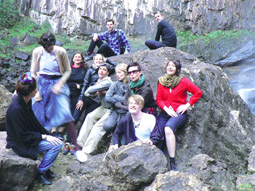
Splendid Arts Lab participants at Minyon Falls
AS THE SAYING GOES, “TWO HEADS ARE BETTER THAN ONE”, SO 10 HEADS MUST BE SPLENDID. FROM A UNIQUE INITIATIVE BETWEEN LISMORE REGIONAL GALLERY AND THE MUSIC FESTIVAL SPLENDOUR IN THE GRASS, IN PARTNERSHIP WITH THE AUSTRALIA COUNCIL, NORTHERN RIVERS PERFORMING ARTS (NORPA) AND ARTS NORTHERN RIVERS, COMES SPLENDID, A NEW EXPERIMENTAL ARTS PROGRAM AIMED AT PUSHING THE BOUNDARIES BETWEEN ART AND AUDIENCE, PUTTING THEORY TO THE TEST.
Through a series of ‘arts labs’ and project commissions, Splendid’s organisers claim that it will “build on the culture of experimentation and interdisciplinary practice in Australia by facilitating opportunities for young and emerging artists to conceptualise and create work for mass audiences” (http://splendid.org.au). Mass audience might be somewhat of an understatement: Splendour In The Grass, boasting 17,000+ in attendance, may as well be its own city-state. Attracting music from across the globe, it is a world-class festival situated in the idyllic setting of Byron Bay, Northern New South Wales.
arts lab
Focusing on ideas generation and artistic collaboration, the Splendid Arts Lab was an intensive three-week residency involving 10 Australian artists (“the Splendid Ten”) and a team of artist provocateurs. It was conceived as an experiment in bringing together young and emerging artists interested in transcending their disciplines and working collectively to generate work for a music festival site.
As Splendid provocateur Tom Barker described it, “making work for Splendour is like making work for a war zone.” Far removed from the gallery or white cube where much art regularly finds itself, the festival is moving, vibrational and explosive; an “assault on the senses” as participating visual artist Carl Scrase, put it. Confronted with this challenge, the Splendid artists were immersed within a think-tank styled residency as a means of unraveling the complexities of cross-art form collaboration.
The Arts Lab took an expanded approach: each week the group was mentored by a series of three to four guest provocateurs including contemporary dancers, visual artists, designers, architects, performance artists, theatre directors and new media artists from across Australia. These provocateurs played the roles of stimulators, supporters and clarifiers. At other times they acted as nurturers and cultivators, encouraging the growth of the group as a responsive, multi-faceted, living organism. Architect Tom Rivard noted, “They are different artists, working in different media and we need to tease out how each of them can bring their discipline and way of working into the process.”
Lab days were vastly dynamic as each provocateur exercised the artists through a sweep of immersive activities, from a crash-course in Jungian psychology to movement workshops that seemed like auditions for Dancing with the Stars. The group was given tasks such as developing performative dinner parties and sent out on missions like “walking meditation”, all with the aim of transforming their relationships to site and audience. Provocateur Mickie Quick said, “It could have been Reality TV’s next big sensation: ‘So You Think You Can Make Art?’.”
Focused on challenging each individual into novel engagement with their own distinctive working methods, the artists were placed within the microscope of the Lab for what coordinating provocateur Rebecca Conroy described as “open art surgery.” As artists spread out their practices on the Lab’s (operating) table, ideas seemed to transplant and cross-pollinate.
processes and outcomes
Beyond this, the Lab became much more than simply a synthesis of artistic team challenges or a collage of practices. Artistic collaboration is not easily deconstructed, nor reducible to the juxtaposition of disparate art forms and working processes. Often the lived space that insulates and informs these practices is at the heart of the act of collaboration, shaping an identity through which art forms take on voice and become personal.
This realisation came through experiencing the qualities of the Lab as a residency. Perhaps it was through cohabitation that the group aesthetic developed. In the domestic activity of sharing house, food and spirit, the artists engaged in an essential dialogue at the core of working together creatively. As multi-media artist Daniel Tanner related, “The best ideas came from sharing a meal or chatting over a tea in the evenings.” As the mutual engagement with an emerging artefact, collaborations can be found even in the most quotidian and customary acts.
Artistic collaboration, in this instance, might be considered as a form of ‘coming-out’; an emergence of process-as-outcome. This entanglement between process and outcome transpired as a very specific challenge of the Lab. As one of participants, “cross-artformer” Dario Vacirca, pointed out, “process is one of our goals…challenging the scale and meaning of collaboration and how it works.” So when is the focus on generating a collaborative process and when is it on producing viable outcomes in the form of art? It seemed a question of articulation: when does art ‘work’ become artwork within collective practice?
scratch first… itch later
The final provocation of the Lab, a project proposal pitch coined “The Itch” (pitch minus p) stretched out this tension between process and outcome. By sounding ideas amongst the provocateurs, curatorium and each other the group generated and solidified their collective vision, mapping-out individual intentions and inspirations about how best to integrate their diverse practices.
The presentations offered closer glimpses into each collaborator, how they worked, their creative voice and style. As the artists showcased their visions of flash dance mobs, interactive mobile phone interventions and performative fantasy environments, what emerged was a front-row demonstration of each collaborator’s working style, their strengths and weaknesses as individual practitioners within the Splendid Ten.
The basis of The Itch was to communicate potential projects for Splendour In The Grass to the panel and facilitate a forum of discussion on how these concepts and ideas could be further developed in the next phase of Splendid. Equally important was The Itch’s function as a testing ground for each artist to enunciate their creative voice within the collaborative language of the group.
Artistic collaboration within Splendid is a continuous negotiation of not only process and outcome, but also self and other; an instance in which boundaries between entities become confused, obscured and fluid. This type of playful self-enquiry, losing and relocating oneself amidst the universality of the others, orientates an exploration of a certain course of exchange. As visual artist Alice Lang acknowledged,“ It has made me analyse the way in which I work, the type of work that I make and the kind of work that can be created through developing creative partnerships.” In these ways the Arts Lab was generative, layered and unpredictable.
Reminding the group of the importance of this “seeding process” and denoting the Lab’s experimental dynamic, provocateur Dominico De Clario reassured the artists that in every creative situation “99% happens after the event. You experience then you think.” Concluding that while the past three weeks had been emotionally, physically, and intellectually demanding, De Clario suggested, “If anything makes you uncomfortable it is really, really useful. It’s a gift, explore this.” Splendid Arts Lab is a fertile site for planting these seeds that will germinate into some larger-than-life cross-art collaborations and innovative artworks at Splendour In The Grass 2010.
Splendid: Art, Ideas, Experience, Arts Lab, lab artists: Alice Lang, Kristy Ayre, Shakthi Sivanathan, Mish Grigor, Dario Vacirca, Lachlan Tetlow-Stuart, Lauren Brincat, Daniel Tanner, Carl Scrase, Dominic Finlay-Jones; mentors Deborah Pollard, Rebecca Conroy, Jenny Fraser, Mickie Quick, Tom Barker, Natalie Cursio, Domenico De Clario, Julian Louis, Tom Rivard, Craig Walsh, Andy Forbes; Lismore, July 20-Aug 7, www.splendid.org.au.
RealTime issue #94 Dec-Jan 2009 pg. 32
© Nathan Stevens; for permission to reproduce apply to realtime@realtimearts.net
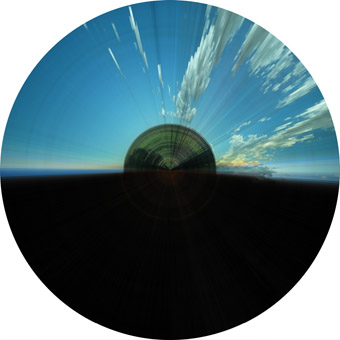
Watching the Sky
Mitchell Whitelaw
Watching the Sky
BEGINNING MIDDLE END WAS AN ANU SCHOOL OF ART THREE-WEEK FORUM, FESTIVAL AND EXHIBITION OF CURRENT DIGITAL MEDIA RESEARCH AND PRAXIS WHICH DREW ACADEMICS, POST- AND UNDER-GRADUATE STUDENTS FROM A NUMBER OF AUSTRALIAN UNIVERSITIES..
The wrap-up exhibition was in various states of repair and dysfunction both times I visited, which left me to ponder the relationship between ideas and imagination, technology and affect, and how much grace we need to give works in development when they come up against their limits.
Some of the ‘game’ interactives, required me to stand at x-distance and utilise y-tools to enact z-function, rendering me as robotic as the faces twitching at me from the screen. Other exhibitors, however, were more thoughtfully at work with an awareness of exhibition space and spectator as co-significant and co-intelligent factors.
Although Ryszard Dabek’s sound was not working on one visit, still the idea of the whole worked both times. His installation, Fader (www.ryszard.net/fader), zooms detailed digital images of 1940s worker figures from Warsaw’s Plac Konstytucji against a bare white wall. A video loop of old vinyl records, “endlessly spiralling and repeating”, is complemented by a wash of sound, ghosting the space with voices and instrumental snatches. These circular and circulating images and sounds are like portals into a ship of lost ideals, reflecting on the patchiness of memory, memorial documents, art and history.
By contrast, Luke Pender’s Longing From New Holland ties my hands and my mind. He projects images of convict love tokens (small metal discs) in a rapid-shuffle video loop, below there’s a tumble of 5,000 shabby cardboard replicas in a heap on the floor. The sound component, which “deliberately overlaps messages from these tokens…making it impossible to hear each” leaves one feeling winded. The original tokens—exquisitely detailed, hand-worked and highly individuated homages to passion, hope, and craft—live down the road at the National Museum, and deserve far more honouring than this (www.nma.gov.au/exhibitions/community/australian_digital_journeys/luke_penders).
The large exhibition centrepiece, InterANTARCTICA, requires the physical presence of the audience and its bodies’ motions. Driven by a motivation to “impart vital knowledge” about climate change, this interactive work-in-progress—created by Dr onacloV, Michael Bates and 14 students from the University of Sydney Design Lab—presumes a lot about how it effects empathic reaction and supposedly manufactures a response-able relationship to this threatened environment.
I doubt empathic connection is made via manipulating the Tangible User Interfaces, which are clunky and cumbersome and just plain odd. A flashing light bulb telling me I’ve won a brownie point is not going to make me want to change my energy habits. Quite apart from how well, or otherwise, this compares with fully functioning interactives already accessible in public galleries, this interactive has a very long way to go to match the calibre of input from its sound artist—Michael Bates’ eerily evocative 3-D soundscape—or that of the awesome landscape footage gathered by CSIRO base scientists doing the ground-level research work in the Antarctic.
In its current form, and in the current exhibition, InterANTARCTICA is highly problematic (www.interantarctica.com). For full effect, it requires room lights out (bad luck for the other exhibitors). It also relies on spatial configurations to be exactly right—eg exact hanging or standing distance for the projections cameras—for which this gallery was not equipped, and which caused the install to malfunction. Multimedia can be caught in an idealised parameter which is hard to achieve and at times unreasonable to expect. Ironically, this exhibition calls attention to itself, as opposed to the subject and intention that it advocates.
Elsewhere in Beginning Middle End, Anna Madeleine’s stop-frame animation Why read the book when you can watch the movie? shows a real match between intention and achievement. The animation reveals hand drawn imagery unfolding from the pages of a book. Its visual story-within-a-story reveals multi-dimensional narratives and reflects on the intimate, interactive, trans-personal and transformative nature of reading itself. Quirky, poetic, playful, spacious, its elements playfully cross paths and challenge relationships between text and image, fiction and reality, and old and new media. (For other works by the artist: www.annamadeleine.com)
Mitchell Whitelaw’s nylon 3D print Weather Ring—“an experiment in transducing form from temporal patterns”—is perhaps the highlight of the exhibition. It presents 365 days of local weather data in a three-dimensional, ‘bracelet’ form. Its circumference texture is as intriguing as a city’s silhouette (http://teemingvoid.blogspot.com/2009/10/weather-bracelet-3d-printed-data.html). It is complemented by Whitelaw’s Watching the Sky (detail, 14/5/08), a kind of Japanese fan of inkjet-printed, composite images—1,440 to be precise—of collected data from a single 24-hour period, visualised using a simple slit-scan technique (www.flickr.com/photos/mtchl/sets/72157604494499057). Poignant and poetic, these two works are both technically and philosophically exceptional, merging the gap between hard data and sense perception, showing how our world and its changes wears at and touches us.
ANU School of Art, Beginning Middle End, digital media showcase, curator Lucien Leon, ANU School of Art Gallery, Sept 3-24, www.bmefestival.com
RealTime issue #94 Dec-Jan 2009 pg. web
© Zsuzsanna Soboslay; for permission to reproduce apply to realtime@realtimearts.net
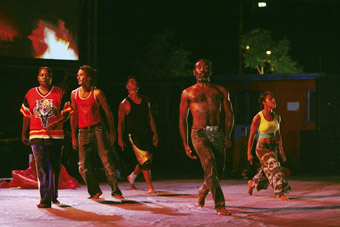
Antonia Djiagween, Owen Maher, Seramsah Bin Saad, Trevor Jamieson and Dalsia Pigram, Burning Daylight, Marrugeku
photo Rod Hartvigsen
Antonia Djiagween, Owen Maher, Seramsah Bin Saad, Trevor Jamieson and Dalsia Pigram, Burning Daylight, Marrugeku
THE TITLE OF MARRUGEKU’S LATEST WORK, BURNING DAYLIGHT, SEEMS ON THE SURFACE A CONTRARY CHOICE. THE SHOW CONJURES A NIGHT-TIME BROOME AND ITS DENIZENS—YOUNG PEOPLE AT A LOOSE END AFTER BEING EXPELLED FROM A BAR AND VISITED ON THE STREET BY UNWELCOME GHOSTS FROM THE TOWN’S PAST. WITH ALL THE EASE OF A HOLLYWOOD OR BOLLYWOOD MUSICAL, BURNING DAYLIGHT’S NIGHT PEOPLE SLIP INTO SONG AND DANCE WITH EVER GROWING PASSION, AS IF SUPPLANTING TIME-FILLING WITH AN UNCONSCIOUS QUEST TO FULFIL SOME DEEP, UNSPEAKABLE NEED. THIS IS NIGHT WORK.
Marrugeku’s Broome fantasia is intensified by a design that is a self-consciously stagey abstraction of the town (inspired in part, says a program note, by Tracey Moffat’s films Night Cries and Bedevil) and by the use of the back wall of the bar and a large billboard as projection screens, often worked simultaneously. A large, semi-circular performance area is ringed by the bar, a road leading into the distance and lined with striking boab trees, a tin shed inhabited by musicians and a park bench beneath a pole—which of course must be climbed and swung from in the time-honoured manner of musicals.
The screens evoke the open-air cinemas of tropical towns, the films mimic 40s and 50s B-grade melodramas from Hollywood’s dream factory, while the accompanying karaoke-style singing to the onscreen lyics suggests the present—though the songs hark back to romantic balladry—and the popular fantasy of being a great singer (they’re very good in this show). This is dream work.
Burning Daylight doesn’t delineate a simple story—it’s played out as a street concert-cum-musical (a relative of Les Ballets C de la B’s rooftop party, Iets Op Bach, 1999). This makes the performance all the more dream-like, the floating structure allowing for an immersive historical layering that merges three generations. The films, for example, include photographs from early 20th century Broome, 40s-ish movie recreations of that earlier period and contemporary karaoke sung live. Here the stage performers appear as their grandparents of a century ago. This collapsing of time and condensing of generations is the stuff of dreams but a deft means to engender a sense of history and inheritance.
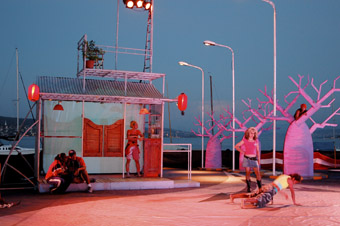
Burning Dayight in Zurich 2007, Marrugeku
photo Christian Altorfer
Burning Dayight in Zurich 2007, Marrugeku
After their expulsion onto the street, the night dwellers’ tensions and reveries are interrupted by the arrival of a black, whip-cracking cowboy (Trevor Jamieson) dressed in red and prancing like a warrior. He provokes immediate wariness, then confrontation, later attraction and then does battle with the ghost of a geisha (Yumi Umiumare). Either the cowboy is a ghost himself or his arrival has unleashed the past into the present; something is being worked through. The unfolding, largely danced, impressionistic interplay between the townspeople and the stranger is interpolated with the films and their karaoke accompaniment. These are central to Burning Daylight and are based on real events in Broome’s history.
In the first of the three films, Stir Fry (“She was a caged bird in a foreign land. He was a lonesome cowboy. Could he set her free?”), after being struck by her cowboy boyfriend, a Broome geisha elopes at night with another man—dressed in red and perhaps the father of the onstage red cowboy. He is killed by the boyfriend in a shootout. A small boy, whom we presume to be the son of the geisha and her lover, grimly watches his mother place flowers on the lover’s grave. A long stick hangs from the boy’s hand—precursor perhaps to the whip we see wielded by the grown man on stage. The second film, Black Pearl (“Can Love Beat the Law?”) depicts a jealous white bar owner betraying an Aboriginal employee to the police for having an affair with a white man. The woman and her children are removed to a reserve. (A newspaper spinning onscreen is headlined, “Native Woman Entraps White Man: Woman Removed For Her Own Good.”) In the final scene in this film, a small boy dressed in red as a cowboy, steps out from behind a shed and aims his toy gun at the policemen. In the third film, Troubled Water (“They Dared To Cross The Colour Line”) a Malay man married to an Aboriginal woman goes to work on a pearl rigger but is deported when he returns to port, never to see his family again. The son ties his father’s abandoned red bandana around his head.
Jamieson’s cowboy, as the child of an era in which white law not only oppressed Aboriginal people but gave licence for cultural groups to turn on each other, appears then to embody all the accumulated wrongs, despair and anger that unconsciously haunt Broome’s psyche. Yet, like Broome itself and its night dwellers, troubled yet richly creative, the cowboy is an ambiguous figure—a winking, narcissistic charmer, undeterred by his poor reception, hanging out as if expecting sooner or later to fit in, and providing moments of emotional support. Burning Daylight’s choreography resonates with this ambiguity as Jamieson slips in and out of group dancing, withdrawing to observe or suddenly displaying intimacy. The cowboy is reminiscent of the classic trickster, a wicked messenger, bringing the unwanted unconscious to attention.
I’m unravelling and reassembling my dreamlike recollections of the show, and my account of the role and purpose of the cowboy is possibly obvious or wrong (the companion book to the production has varying accounts), although the continuity inherent in the red motif associated with the boy children in the film and the cowboy seems undeniable. What is not clear is why the geisha ghost appears vengeful, forcing the cowboy to engage in a gloriously sustained battle, compelling the night community to join in. Perhaps hers is dis- or mis-placed anger for blighted lives. Certainly the cowboy’s recollection of her seems fond: he places the very same flowers on her grave, upstage, that she placed on her dead lover’s in the film as the scowling child looked on.
If Burning Daylight relies for much of its magic and meaning on the dreamy indeterminancy engendered by the overlaying of historical periods and interplay of artforms and images in a night time reverie, it risks opacity by being less than clear in a key area—the narrative you’re having when you’re not having a narrative. As well, it was easy to miss significant clues because each of the three films actually comprises two discrete versions shown simultaneously on the two stage screens. While this ‘splitting’ again heightens the sense of dream it also undercuts the revelatory transparency the work otherwise achieves. This was compounded, though to a lesser degree, by cast changes that meant characters in the films were played by others on stage; of course that can’t be helped.
Post-show queryings aside, the immediate experience of Burning Daylight was deeply enjoyable. The meticulously crafted film mini-melodramas were indicative of the way the production worked its magic, managing to be at once amusingly parodic and deeply affecting, embracing its audience with popular song and dance forms put to complex purpose. This integrative approach was highly evident in the distinctive choreography, an ever shifting synthesis of modern dance and traditional Aboriginal dance, hip hop, gymnastics, Japanese dance, club moves, martial arts and elements of the African dance of co-choreographer Serge Aime Coulibaly, performed with commitment and confidence. In the DVD that comes with the book of the show, co-choreographer Dalisa Pigram speaks of the challenge of ‘staging’ Aboriginal dance: “Our dance is small, [Serge’s] is so big.” Other than moments when there appeared to be a desire to fill the stage and the dancing could have been more focused, the balance seemed about right. Most exciting was the sense of an emerging, characterful choreographic language, rich in detail, unusual shapes and gestures.
Jamieson, Pigram and Uniumare excelled in solo passages in their very different ways. The latter two absorbed a great length of orange roadworks mesh into their performances—Pigram boldly cartwheeling with it, Umiumare wrapping herself up as a bizarre living sculpture—both expressing, true to the spirit of the show, the creative capacity to take whatever is at hand into their art. Pigram’s solo, performed to Jamieson singing the Pigram Brothers’ “Dear Alistair” (as close as the show gets to referring to the local native title claim), is a central moment in Burning Daylight, expressing intense emotional connection to land and family, in which the release from the plastic mesh, perhaps emblematic of both progress and constraint, seems almost cathartic.
The final collective dance performed to rapper Dazastah’s melancholic, addictive Ikebana Tango (“How come me,/ The past come to haunt my soul,/ How come me,/ The past come to call my soul,/ How come me,/ The past come to taunt my soul/ wanna take me home and won’t let me go”) sustains the sense of a haunting for which there can be no easy exorcism. The night work, the work of dreams is not finished. The dancing however seems more optimistic in its pairings of past and present, its sense of youthful communal strength and, not least, a shared, unique artistry. Burning Daylight is an engrossing entertainment from a skilled, charismatic cast, members of an inventive collaborative team producing a complex work in which a rich culture engages recuparatively with its past.
–
Marrugeku, Burning Daylight, concept Rachael Swain, Dalisa Pigram, director Rachael Swain, co-choreographers Serge Aime Coulibaly, Dalisa Pigram, performers, devisors Trevor Jamieson, Dalisa Pigram, Kathy Cogill, Owen Maher, Sermsah Bin Saad, Antonia Djiagween, Yumi Umiumare, designer Joey Ruigrok van der Werven, film director, cinematographer Warwick Thornton, dramaturgy, Josephine Wilson, David Pledger, John Baylis, costume designer Stephen Curtis, lighting designer Geoff Cobham, musical director Matthew Fargher, karaoke songs by Amanda Brown, musicians Dazastah, Lorrae Coffin, Justin Gray; CarriageWorks, Sydney, Nov 11–14
RealTime issue #94 Dec-Jan 2009 pg. 33
© Keith Gallasch; for permission to reproduce apply to realtime@realtimearts.net
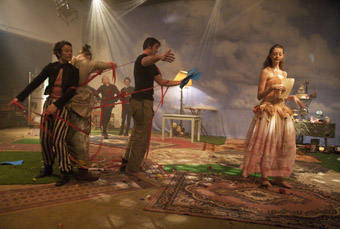
The Garden
photo Ashley de Prazer
The Garden
TWO DISPARATE ENTITIES, STRUT DANCE’S SHORT CUTS AND CHRISSIE PARROTT’S THE GARDEN, EXPLOIT THE REGISTERS OF WHITEWASHED ENVIRONMENTS; ONE TRACING ENERGETIC ARCS ACROSS REFLECTIVE SURFACES, THE OTHER COMPRESSING THE CLOTS AND CLODS OF HUMAN TIME INTO EARTHLESS PLOTS. IN SPITE OF TITLES WHICH MIGHT SUGGEST MATERIALISTIC BLADES AND BENIGN SCYTHES, BOTH PRODUCTIONS VENTURE INTO ART/IFICIAL TERRITORIES OF THE IMAGINATION, COMPOSING COLOURFUL PLENITUDE.
Strut’s decision to air its brief works’ season in the WA Academy of Performing Art’s Studio A profited from the evocative flow of movement ideas bouncing off the studio’s uncluttered whiteness. The best of the program’s six works purposefully skittled images, shadows and projections around the space, dispersing intimacy into open-ended depth and distance. If thinly sliced, a meta-history of Western Australian contemporary dance was simultaneously delivered for the tasting. In the showing’s worthy democratic frame, where artists of undisputed calibre like Chrissie Parrott, Sue Peacock and Stefan Karlsson move alongside succeeding generations of performers and choreographers, dance indentations do make statements.
And what might these statements be? Experience through time accumulates quality, even if admitting an occasional contradiction. There is nothing new in such an observation except that denial of experience, as is more often than not projected by the state’s arts funding, can impoverish the view. Strut’s charter to support emergent and experimental ventures in accessible and alternative venues, like Studio A, is founded on the assumption that the organisation facilitates pathways to professional vitality. That the funding infrastructure makes little allowance for this reverberated gently but insistently in the white space.
Like solitary birds, the dancers assemble suggestively in a gallery-like formation as if intentionally drawn to highlight choreographic fascination with flight and its inevitable undoing: Icarus, Leda, Odette/Odile and, at the beginning of the 20th century, Pavlova/Fokine’s undulating dying. Winged for flight, creatures desire freedom and upward thrusting power, while regurgitated fear pulls their bodies downwards to stasis and decay. Does natural order drag their flight down or are they doomed by the caging propensity of human symbolism?
The most convincing representation of bird and gravitational pull is Parrott’s Cyg.net. Blue and white projections penetrate the whiteness and, initially, slither over the hardly discernible avian figure, Jacqui Claus, whose movements, like Jonathan Mustard’s score derived from black swan soundings, cry towards visibility. White clustering and dispersing lines turn fleshy and feather-fluted touching the figure’s awakened limbs and swan-like nudging. The dark calls and weightless imagery encounter a body enfolding in swan-dance allusions, refolding into her inevitable demise. Parrott has clearly manipulated Claus’ elongation to interplay with bird-like bewilderment in a destiny and density of human mythology.
While Claus’ bird assumes a mythological status imposed by the weight of texts consciously inscribed upon her being, Paea Leach’s evocation in Sally Richardson’s Standing Bird inhabits an alien Australian landscape, struggling against oblivion. The will to freedom again predominates but, in contrast with Claus’ confinement in light, Leach is framed by shadows, voyeuristically driven by Richardson’s roving lamp. Elevated on a platform, Leach conveys entrapment of another kind through alternating wind-caught sobs and dust averted gazes. Her performance captures that sense of being distant and present in a shimmering mirage that pervades excursions into a desert’s singularity: instead of the compression of time, she is trapped in no time. It is a figment of being totally without flight in a baked earth environment, perhaps the wrong environment, foreign and unforgiving. This wingless bird is left standing under its menacing ahistorical shadow. Leach’s performance gains because of its juxtaposition with Cyg.net as a creature denied its own death.
If Standing Bird illustrated how a performer can overtake the limitations of construction, Study in A Major/We the people, Deborah Robertson’s collection of others operating as a minority-in-mass contributed little to its right to political satire. Similarly, David Corbet and Joseph Lehrer’s ICP (Impression Comparison Perspective), or two men in contact, rolled heavily between harsh falls revealing nothing but flesh given ordinary combativeness and brief, inverted humour. Physicality takes on more effect in Brooke Leeder’s work, Throw your eye over, which catches decay at work in steely revenge through a vision of Miss Haversham re-dressed. Charles Dickens’ moulding cobwebs quicken with a dark downward thrust beautifully executed by Sharlene Campbell whose intensity inverts visions of flight and spatial lightness to insist on a narrative direction which Dickens may have initiated but did not pursue.
Peacock and Karlsson’s Epilogue punctuated the evening’s flight with their professional ease of movement. As a critical mass of two, their chatter pivoted on their emerging pensioner status in the funding stakes and turned the yellow Ikea chairs bright and whimsical. The text, probably unnecessarily miked in this particular space, presented a movement/voice potential that begs further spinning with these dancers’ still youthful and wonderfully articulate physicality. They belong in the gallery of birds, more comfortable than most on their perch in spite of the funding dilemma and, in the weight game, they play against gravitational violence with seductive buoyancy.
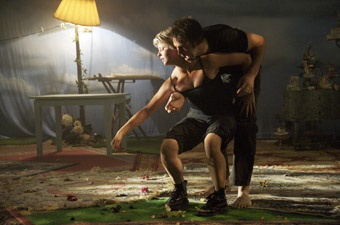
The Garden
photo Ashley de Prazer
The Garden
At the Moores Building, Chrissie Parrott’s The Garden twists Short Cuts’ clarity to baroque brocade and rusting bric-a-brac. It is an off-centre realm of beauty and beasts that graze and teeter in artifice and, occasionally, strike seed in gristle. Stamped with Parrott’s signature, The Garden tills brick and mortar, bone and muscle, installation and performance on an estate of weeded humans and ornate musical boxes, excavated from a time which may never have been—somewhere between Rabelais and Dickens. The audience is transported into a corseted world where the leitmotiv of the piece, the fey, romantic beauty (Quindell Orton) in ‘her’ garden of tinkling melodies abides, like all innocents, in fancy. Black-garbed, emasculated men hide and scurry fustily and fastidiously around her, with no small nod to Black Adder, fending off incongruous intrusions of beastliness—the dancing women. These creatures of infinite unpredictability, who cannot be filed, stamped and contained, are the life-force of this otherwise deathly, decorative garden. They invade and, at least from a kinetic rather than logical point of view, take over, bleeding red and black into the Moores Building space, ricocheting off its powdery façade. Weeds they may be but their occupation is glorious.
Leanne Mason, Rhiannon Newton and Jacqui Claus alternately romp and snarl (erotically as the giggling uncertainties of the female school party around me indicated), tossing the pompously maintained aristocratic artfulness into disarray. The three solos vibrate like expressionistic portraitures amidst the drift of predictable scenes, including the human ventriloquist dummy and the honest-John gardener who manfully protects the flower of his love as she tips and faints in self engrossment. The fall-catch duo tenderly managed by Russell Leonard’s attentiveness is effective enough but it is a repertoire concept where the lady, as usual, remains insensible to her saviour’s efforts. Performance bite remains with the unleashed power of the feminine trio in their distinctive flashy pigments, guile (Mason), stalking greed (Claus) and violent hunger (Newton). Why they explode in such brilliance remains untold.
Unfortunately, their heady fermentation in and of The Garden, only occurs sporadically, causing the work to fall on one of its strengths, its conception in and as a collection of artworks in an exhibition space. Overlays between the visual and performing arts raise intriguing issues about expectations of complementary but distinct disciplines. The tensions arising in their mix is evident in the work’s introduction where the audience was forcibly, if audaciously, directed through upstairs/downstairs gallery spaces sprouting musical boxes, technological environments and, in a brief interlude, the slamming of dancers on walls. The surprise tactic worked but cohesion missed its beat. Once seated in the performance environment, those preliminaries meant very little. Many gardens of display and enactment evolved without a tangible thread to draw them all together except for the artifice. Limited time impeded gallery wandering; multiple frames faulted performance structure.
It may be that what is written on two different white surfaces amounts to the same message: that beast and bird might take off into more vivid territories if greater support was to be given to the time of experienced creators’ flights?
Strut dance, Short Cuts, choreographers Sally Richardson, Deborah Robertson, Chrissie Parrott, David Corbet and Joseph Lehrer, Brooke Leeder, Sue Peacock, Stefan Karlsson, WAAPA, Studio A, Mt Lawley, Perth, Oct 1-4; The Garden, director Chrissie Parrott, composer Jonathan Mustard, performers Quindell Orton, Jonathan Mustard, Leanne Mason, Rhiannon Newton, Jacqui Claus, Tom Penney, Hugh Veldon, Russell Leonard, Moores Building Contemporary Art Gallery, Fremantle, Nov 4-15
RealTime issue #94 Dec-Jan 2009 pg. 34
© Maggi Phillips; for permission to reproduce apply to realtime@realtimearts.net
{$slideshow} FOUR MALE DANCERS WEARING FETISHISTIC BLACK HIGH HEELS AND TINY GOLD SHORTS STRIKE PROFILE-VIEW POSES AS A YELLOW GLOW EASES UP THE SCRIM. STATIC, THEY PROUDLY SILHOUETTE THEIR OVERSIZED PROSTHETIC COCKS UNTIL THE LIGHTS MOVE INTO PULSING GOLD FLOODS. THEN FEMALE DANCERS APPEAR, RAW TECHNO BEATS ASK FOR PASSION, AND THE STAGE HUMS UNDER COPULATIVE DUETS. THE DISPLAY DELIBERATELY QUOTES CIRCUS-STYLE ENTERTAINMENT; IT IS A SPECTACLE OF GOLD CLOTH, BARE SKIN AND TWISTING LIMBS, EMBRACING EXCESS.
The scene is one of the highlights of Canadian choreographer Marie Chouinard’s Orpheus and Eurydice, which played at the Yukon Arts Centre in Whitehorse this September. Chouinard’s innovative work is celebrated, and occasionally denounced for including spectacle, which remains the case with this work. Originally presented in Rome and then Hong Kong in two acts over almost two hours, Orpheus and Eurydice was pared to 65 minutes in one act by the time it toured Canada, allegedly in response to critics’ complaints about repetitiveness.
Whatever the reasons behind the change, the single-act performance is compelling. And spectacle is an important part of its success because it counterpoints scenes where the dancers are silent. Silent but gorged on desire to speak: a dancer hangs her arms forward from slumped shoulders and staggers in giant, weak steps across the stage, all the while stretching her jaw to form a painfully held O. This dancer, and many others in scenes to come, embodies the empty, black space a mouth would be if Orpheus—and poetry—had never existed.
Montreal-based Chouinard is one of Canada’s most distinctive choreographers. She embraced the role of enfant terrible in the 1970s and 80s by pushing the limits of how much primal and sexual energy a choreographer can demand of herself and her dancers.
So it is familiar Chouinard territory when Orpheus and Eurydice dazzlingly celebrates phalli. Costumes by long-time collaborator Liz Vandal that celebrate the entire body are also a familiar, but never predictable, Chouinard mark: men and women wear gold lame short-shorts and gold pasties most of the time, sometimes with white fur ankle cuffs and hats; the other option is loose blue-grey overalls, worn shirtless.
From her position of deep “erotic body” vocabulary—a vocabulary that knows eroticism isn’t always comfortable or beautiful—Chouinard creates an altered narrative between sexual stereotypes. The dance moves repeatedly between the pain of poetry/music/love lost (Orpheus’ journey into Hades) and the unstoppable force of creative power (emphasizing Eurydice’s role as goddess of fruiting trees). Here, the male is lack (those empty mouth holes) and the female is fleshy presence.
Throughout the performance, all the dancers perform the range of full-empty-full options, from gaping need to voluptuously fulfilled eroticism. The loss of voice is, appropriately, often expressed through the soundscape. Orpheus and Eurydice opens with a male narrator presenting the text of the myth by ‘reading’ surtitles. He speaks into a freestanding microphone, mouth deliberately too close. He crackles his voice with convulsive growls and visually distracts us with neck-to-elbow contortions and twisting feet. Then he leans there, open-mouthed, silenced, too weak to stand. At last, a female dancer comes to lead him away.
In this and many other scenes, the other dancers growl and shriek but maintain one of the show’s main images: strange, open-mouthed expressions that look almost palsied. Their wordless universe consumes their muscle power.
In contrast, when the dancers channel Chouinard’s version of Eurydice, they approach the hunger of body, mouth or stage with gifts that fill space and exude energy outward. The best gifts are from each other’s bodies; dancers use their fingers to pull sounds out of each others’ throats, or each other’s bellies. In several scenes, dancers gently place palm-sized jingle bells in each other’s mouths. When any slack-jawed dancer receives a bell, strength ripples up through their weak-posture spines and they can dance again.
The bells form a simple yet profound metaphor for rejuvenation through erotic love. More than this, Chouinard’s Orpheus and Eurydice makes a statement about the resilience of creative energy. The myth of Orpheus as tortured artist is a story of lack, as many operas, ballets and films have emphasized; consider Jean Cocteau’s Orphic Trilogy from the 1950s, or Gluck’s 1762 opera (though in that work Amor restores Eurydice to life and tragedy vanishes).
Marie Chouinard accepts the separation of the lovers, but concludes her work with restfulness, not despair. In the last scene, all 10 dancers repeatedly roll dozens of jingle bells across the stage and across each other’s bodies. Mouths healed, they inhabit a gentle curtain of sound and form a net of gold, reflective light. If traveling to hell and back includes fertility and erotic joy as much as pain, then it too can be embraced.
Compagnie Marie Chouinard, Orpheus and Eurydice, choreography, direction, set, lighting design Marie Chouinard, dancers Mark Eden-Towle, Eve Garnier, Lucie Mongrain, Carol Prieur, David Rancourt, Gerard Reyes, Dorotea Saykalay, Lucie Vigneault, James Viveiros, Megan Walbaum, original music Louis Dufort, costumes Vandal; Yukon Arts Centre, Whitehorse, Yukon, Canada, Sept 18
RealTime issue #94 Dec-Jan 2009 pg. 35
© Meg Walker; for permission to reproduce apply to realtime@realtimearts.net
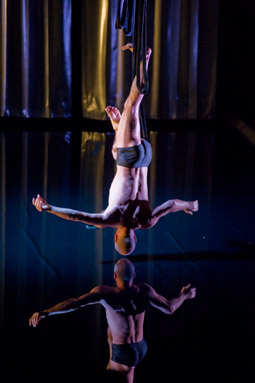
MirrorMirror
photo Pierre Borasci
MirrorMirror
THERE’S A PIVOTAL (NOT A WORD TO USE LIGHTLY HERE) MOMENT IN STALKER’S MIRRORMIRROR WHEN TWO MEN FLY TOWARDS EACH OTHER (THEY’RE ATTACHED BY WIRES TO TWO PARALLEL, HIGH GRID LINES THAT RUN FROM THE BACK TO THE FRONT OF THE STAGE), FOR THE FIRST TIME COMING FACE TO FACE, HOVERING IN MERE SECONDS OF NOT JUST MUTUAL RECOGNITION BUT OF AN APPARENTLY PROFOUND SEEING THE SELF IN THE OTHER.
From then on the already similar appearance and unconscious parallel actions of the performers assume new weight, especially when a thin layer of mirroring water eerily floods the stage. From here the duo becomes a mesmerising, alchemical quartet of mergings and transformations—self into self and self into other—until the only outcome would appear to be a dance into oblivion.
There are other duplications and attempted fusions. If the aerial art of the two men (Dean Walsh and David Clarkson—of similar stature, gait, demeanour, heads shaved, wearing only black trunks) allows them the freedom to worldlessly express a curious kinship, then the presence of two transparent life-sized simulacra adds an opportunity, again using art, for a different kind of symbiosis.
Hanging either side of the stage in marionette-like components, these figures take shape autonomously, attracting each man to step in, to be encased, become a still life. But this solitary merging of self into art, to be preserved like a statue, appears unsatisfactory and is abandoned. Either moving in tandem or watching each other dance with self and reflection, flying above the water and then resting on and becoming one with it (bodies begin to fragment as odd half shapes or dissolve in ripples), this is the art that sustains—the anti-gravitational impulse of dance and aerial work—until the final surrender to gravity, merging with the elements from which we derive.
The performers’ faces betray no emotion, nor do their bodies enact anger or ecstasy or intimacy, and despite the challenges they set for themselves—hanging by an ankle and curling the body upwards, swinging while tautly horizontal or dancing with complex articulation in a cradle-like web of supporting wires—there are few signs of physical stress. MirrorMirror is a work of reflection in several senses: the fundamental role of mirroring in life (mirror neurons, learning from mimicry); the phenomenology of self (perceiving oneself in terms of how you perceive others to be perceiving you); reflection as art (either literal representation or abstract capture of patterns of sound, light and movement); and reflection as contemplation. MirrorMirror’s unhurried pacing, its avoidance of suspense in favour of the contemplation of suspension and reflection, allows its audience the pleasures of meditative immersion.
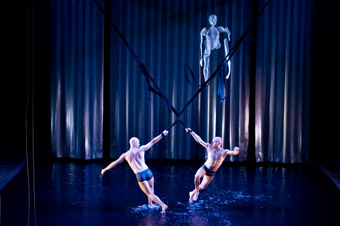
MirrorMirror
photo Pierre Borasci
MirrorMirror
Adding to this contemplative sense is a level of abstraction: the bodies of the performers are close to us (at one point they repeatedly swing up the aisles) and subjected to considerable stress. But as real as they are, they neither display emotion nor adopt discrete personae. There are differences in idiom—one is a dancer, one a physical theatre performer—but theirs is a state of being honed down to that point of discovery of self in another, an extended self (like discovering you have a twin). But it is not portrayed as love, nor as shared sensuality or eroticism. The movement is not without these qualities, nor the water design, but the kinship expressed is not literalised. (The show partly emerged from Walsh and Clarkson discovering they both have Irish ancestry, but save a hint from Peter Kennard’s score for violin, there’s no visible reference to this.)
Like the Hanged Man in Tarot, it’s as if the acts of suspension central to MirrorMirror free artists and audience to contemplate a different reality, released from the passions and distractions of the everyday. Appropriately, we spend a great part of MirrorMirror watching an aerial world in water, upside down. But however you read MirrorMirror, it is a richly suggestive work of great beauty and skill, revealing tireless strength in search of the mysteries of mutuality and the ephemeralities of self. The monkish demeanour of the performers is indeed apt.
The successful realisation of MirrorMirror relies heavily on engineer Max Meyer’s collaboration on a new aerial tracking system, and the magical integration of Joey Ruigrok van der Werven’s design and Sydney Bouaniche’s lighting which so effectively creates a mirror world of incredible clarity and depth.
Stalker, MirrorMirror, concept, direction, choreography David Clarkson, Dean Walsh, dramaturgy, choreography Paul Selwyn Norton, music Peter Kennard, lighting & body cast consultant Sydney Bouaniche, costumes Annemarie Dalziel, set design Joey Ruigrok van der Werven, puppet sculptor, fabricator Kassandra Boswell; Stalker with Riverside Theatres, Noorderzon Performing Arts Festival, Western Sydney Dance Action; Revierside Parramatta, Oct 2-10
RealTime issue #94 Dec-Jan 2009 pg. 36
© Keith Gallasch; for permission to reproduce apply to realtime@realtimearts.net
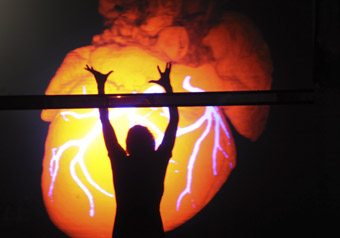
The Curiosities
photo Heidrun Löhr
The Curiosities
SUE HEALY IS A MASTERFUL FILM MAKER, CHOREOGRAPHER AND PERFORMANCE-MAKER. SHE CREATES ART WITH REFINED ATTENTION TO AESTHETIC FORMATION AND PLACEMENT. WITH ACKNOWLEDGED JAPANESE INFLUENCES, SHE CREATES WORKS OF SUBTLETY, SYMMETRY AND UNDERSTATEMENT.
So while The Curiosities asks “what is this body we inhabit?” it does so by containing any seepage in a series of frames. These architectural bodies are cleansed, made of bone more than blood, carefully presented. Serial framing holds this dance at a distance, where it is watched more than felt.
Line is everywhere. Multiple squared screens, varying in size, present image and provide light. To the left of the audience a huge wall screen dangles a strangely three dimensional heart in black space. An unrecognisable shape rotates, commanding the dancer to follow. As it shrinks, dancer Adam Synnott is brought to the floor and, as it disappears, he is cast into darkness. A moving box with four blinds that act as a screen morphs into circus stage then to medical exhibit.
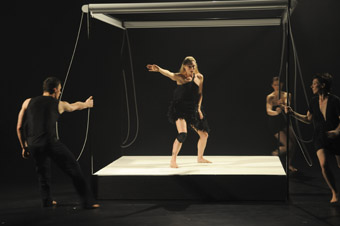
The Curiosities
photo Heidrun Löhr
The Curiosities
Linear clarity appears even in the pools of light made into tight, clear circles by lighting designer Jo Mercurio. And the unusual modern dance choreography aligns space into curved spine against lengthened limb. The paddled hand and the extended foot fashion long bones that are placed into space, full of anatomy.
Nalina Wait appears black clad in the huge CarriageWorks black box. Her body becomes a screen and, as she revolves slowly, images of the human heart play on her back, side, front. Wait dances the heart as the seat of emotion, contorting her face into spooky smiles and wretched frowns. Lisa Griffith is bird girl, complete with tail feathers, who flies and speeds, yet remains grounded in the strength and confidence of her dancing. She athletically duets with Adam Synnott as they dance the dynamics and dreams of a species. Their throwing, catching, falling, lifting unions are easeful and practiced, although, like many of the choreographic bites, are all too brief. But perhaps most potent of all is ‘medical’ girl, Rachelle Hickson, who icily presents her body for view with a matter of factness that seems to fit most powerfully with the overarching coolness of Healey’s aesthetic. She becomes goddess in her rational stillness, turning her body over to investigation, unblinking and statuesque.
At one point, a series of wooden canes are used to prop up body bits: the human on display as living mannequin. It is perhaps the moment when The Curiosities becomes most curious. On the moving box is a sculpture of inanimate limbs, pinned for identification, disabled by objectification, no longer flush with life, but weighty with science or circus.
Maybe all these moments rushed by too quickly. I wished and waited for choreographic immersion, for the bites to linger longer. Within each dancing vignette there was a deep understanding of textured rhythm, as flow was punctured by syncopation, only to re-emerge and be lost again. But overall there was a rush to get to the next bit, which tainted the aesthetic understatement with frenetic timing.
Tempering all the coolness, though, is a lingering memory of shining bodies, of flesh made golden and luminescent through the warm tones of light; Mercurio’s treatment of flesh balancing the formality and flushing the dancers with life.
See the Sue Healey Archive Highlight and a video excerpt from The Curiosities.
–
The Curiosities, choreography Sue Healy in collaboration with dancers Lisa Griffiths, Rachelle Hickson, Adam Synnott, Nalina Wait, film Sue Healey, composer Darrin Verhagen, animator Adnan Lalani, digital artist Adam Synnott, design Wings, lighting Jo Mecurio; Performance Space, Sydney, Oct 28-Nov 7; www.suehealey.com
RealTime issue #94 Dec-Jan 2009 pg. 37
© Pauline Manley; for permission to reproduce apply to realtime@realtimearts.net
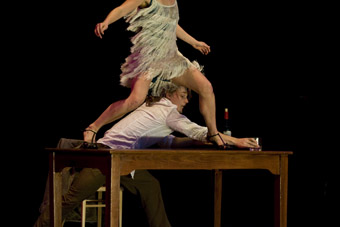
Sally Blatchford, Luke Hanna, Night Café
photo Bottlebrush Studios
Sally Blatchford, Luke Hanna, Night Café
WHAM BAM: THE FIRST 10 MINUTES OF DANCENORTH’S NIGHTCAFE IS A FRENZY OF ACTIVITY AND JAZZILY RAPACIOUS TEXT. FINELY TUNED THEATRICAL RHYTHMS CREATE A SWIRLING SEA OF BODIES, PROPS, MUSIC AND WORDS. DOORS, CHAIRS, HATS AND BOTTLES ARE CARRIED ON, PLAYED WITH AND CARRIED OFF IN QUICK SUCCESSION, CREATING VIGNETTES WITH SLICK- TONGUED HUMOUR DELIVERED WITH SLAPSTICK OVERSTATEMENT.
Establishing speakeasy through noir irony, dancers crawl to a centralising table: a dinner party forms, becoming a multi-focused, mildly orgiastic moving tableau of flinging gaiety. Bottles tumble, drinks are drained, laughter is thrown, laps are sat on and glasses bounce. Drink, movement, sound. Drink, movement, sound. Night Cafe sticks to this rhythm; short pieces of choreography explode then dissolve in a night of tightly organised bedlam. Promoted as a “fun party piece”, Nightcafe is almost vaudeville, almost cirque, almost music theatre and it generates an intense and rolling energy.
The pre-set loneliness of beautifully strange musical instruments acts as a call to their musicians. Waiting for Guinness provides the live music, and what fine music it is. Hard to name or pin down, it’s sometimes Spanish, Cuban, French, Mexican, but most determinedly moves to the uneven beats of European gypsy fusion. These slightly strange and varied instruments perform themselves, making sound distinctive and furnishing the most authentically cabaret elements of the evening. Horns, piano accordion, wooden boxes and the immensely over-sized Mexican bass, the guitarrón, almost cartoonesque in its proportions, make sound the star in a performance that was really a ‘gig’; one that ends up on the dance floor with audience members in each other arms, smiling, moving.
Recently famed for their explosive athleticism textured by piquantly abstracted narratives, DanceNorth has developed a reputation that now conjures slavering expectation. Beware the devil expectation. Originally choreographed by Gavin Webber in 2007, Michelle Ryan has re-staged Nightcafe for a six-week regional tour. As it hit the Parramatta stage it had been touring for a month and this showed in the polished throwing skills and the speedily confident scene changes. It seems Dancenorth have decided that a ‘party piece’ was best suited to a regional tour. Maybe.
But I mourned for the hot athleticism and physically driven poetics of Lawn and Roadkill. I also mourned for relevance and heart. Here dancers are asked to be slapstick actors and the potency of the athletic contemporary body is almost completely squashed. Signature vigour and power are replaced with a strained burlesque. In an ongoing flurry of clichéd facial responses, this burlesque lacks a cellular physical understanding and nuance of delivery that comes only with musical theatre training. Evident is a certain bravado, maybe even condescension to popular entertainment forms. Waiting for Guinness were the most potent element of Nightcafe as these musicians understand and practice cabaret performance.
Audience participation recurred, and we in the front rows shifted with slight terror as the performers approached. I was pulled up to dance twice and had a mighty good time. Some of us were seated at café tables, close to the dancers, and the heat of the performance soaked and stained us with its undeniable energy. But my ears started to bleed from the proximity of the speakers and after 30 minutes I just wanted the show to finish so I could grab some pain killers for a headache that deserved a Marilyn Manson concert.
Dancers Luke Hanna, D’Arcy Andrews, Sally Blatchford, Jessica Jefferies, Danah Matthews and Adam Gardiner all get a chance to star. Short solos all too briefly reveal their movement signatures and it is in these moments that the performance gets a chance to breathe. But lovely moments are lopped off in the rush of ongoing slapstick.
Female dancers must spend the evening on tables in high heels. All cleavage and red lipstick, the women were constantly cast as seductive, lifting their vixenesque dresses to reveal the flesh of the dancerly leg and the arch of a heeled instep. Wolf-whistling men remained surprisingly clothed, dancing in softly comfy leather flats, loose suits and hats. Certainly there was ironic comment on the iconic femme fatal in the “she wore a red dress, no a blue dress” skit, but Nightcafe remained a deeply gendered performance. Dancenorth have, in recent productions, promoted and applauded the physical strength and presence of their female performers. Here they were all bosom and beauty; there was even a slow-mo ‘catfight.’
Despite the refined focus and consistently hectic energy, despite the lively and unusual music, despite the whimsy and practiced skill, this performance remained only mildly engaging: strangely dull in all its frenzy. Beware the devil expectation.
Dancenorth, Nightcafe, choreography Gavin Webber and dancers, tour re-mount and direction Michelle Ryan, dancers D’Arcy Andrews, Sally Blatchford, Jessica Jefferies, Danah Jane Matthews, actor Adam Gardiner, music Waiting for Guinness (Trevor Brown, Tim Bradley, Dave Stephenson, Marko Simec, Natalino Romeo), text Nathan Page; Riverside Theatre, Parramatta, Sydney, Oct 26-28
RealTime issue #94 Dec-Jan 2009 pg. 37
© Pauline Manley; for permission to reproduce apply to realtime@realtimearts.net
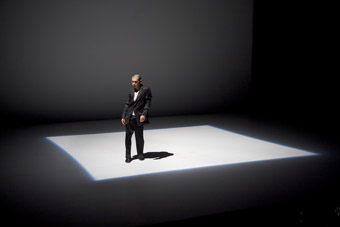
Hiroaki Umeda, Accumulated Layout
photo Laurent Philippe
Hiroaki Umeda, Accumulated Layout
RECENT MONTHS SAW A WELCOME UPSURGE IN THE NUMBER OF DANCE WORKS ON SHOW IN SYDNEY INCLUDING A CELEBRATION ON BANGARRA DANCE THEATRE’S 20 YEARS OVERLAPPING WITH THE SYDNEY OPERA HOUSE’S SPRING DANCE SEASON. HERE ARE SOME OF THE WORKS SIGHTED AND ENJOYED.
bangarra dance theatre: fire
There was a great sense of occasion and reflection emanating from Bangarra’s 20-year celebration, titled Fire and realised as a hugely generous program mostly of short pieces and excerpts from significant works from the mid 90s to the present (Stephen Page became artistic director of the company, formed in 1989, in 1991). Page spoke to the audience before the show, in part emphasising how hard the company had worked to establish a cultural inheritance and spiritual guidance, although this had not prevented the work being seen by some ‘as not black enough.’
Aptly, the engrossing traditional Yirrkala dances that opened the show were counterpointed at the end of the evening with a Torres Strait Islands-based work, including a fearsomely dramatic Saibai Island-inspired archery dance. In between, the Brolga scene from Corroboree (2001) confirmed the brilliance of dancer Deborah Brown (dance solos are not often a feature of the company’s repertoire); Patrick Thaiday also excelled whenever he appeared, for example as West Wind in Frances Rings’ Unaipon (2004); and the Stephen Page-Bernadette Walong Ochres (1995) was a reminder of just how expertly the company has melded western contemporary dance with traditional Indigenous dance, and with surprisingly much more of the latter shaping each dance’s totality than I had recalled. The company’s social issues works fared less well in the celebratory context, their power only glimpsed and a certain datedness evident, although a dance with blankets was disturbingly memorable. What was never in doubt was a sense of continuity and often remarkable invention.
Bangarra Dance Theatre, Fire, Drama Theatre, Sydney Opera House, Aug 28-Sept 26
vicki van hout: pack
Earlier, I had seen former Bangarra dancer Vicki Van Hout’s Pack, staged as part of the Sydney independent dance presenter Dirty Feet’s program, Tipping Point. In an intense work, four dancers, moving with bird-like alertness and the deep stepping of certain Aboriginal dance forms, map out their space territorially (with tape) and on each other’s bodies (with clothes pegs). Moments of intense, swiftly danced collectivity contrast with power plays and grooming displays—pegs removed gently from pinched flesh. This fascinating work, in which the tipping point seems to be whenever ‘enough is enough’ and the dividing tape is ripped up, fuses contemporary dance with Indigenous inflections to suggest that when it comes to territory we humans are pretty much just another animal. Dirtyfeet producers Anthea Doropoulos and Sarah Fiddaman put in excellent performances for Van Hout alongside fellow dancers Imogen Cranna and Verity Jacobsen.
Vicki Van Hout, Pack, in Dirty Feet, Tipping Point, Cleveland St Theatre, Sydney, Aug 19-22
hiroaki umeda, spring dance
The Sydney Opera House Studio was the wrong venue for Japanese artist Hiroaki Umeda. The first of his two works, the 23-minute While going to a condition, places the performer centre-front of a pulsing video projection, requiring the audience to be, in turn, pretty much in front of him, with a clean depth of field, not either side of the stage. On the other hand, being too close can reduce the scale of Umeda’s relationship with the screen. A quick transfer to standing-room-only put me right, and I was soon enveloped in the mutual staccato of Umeda’s video, the mechanical rattle of the sound score and the performer’s minimalist body patternings.
From initial stillness the turn of a foot becomes an almost shuffle-on-the-spot and then the bend of a knee prefigures a discombobulating body, always erect, vibrating, head down to the very end as huge lines, horizontal, then vertical multiply and flicker blindingly behind, and dissipate. He looks up. End. Against something huge, unnamed and noisy, the performer’s body seems fragile, the movements perhaps involuntary or compulsive-obsessive, although this might be the dancer’s idea of fun. Inspired by “the fluidity and jerkiness of butoh and hip hop”, Umeda seems to go “into a condition”, a state of being in the tradition of performance art where he partly places his work.
The second work, the 25-minute Accumulated Layout, is performed over a square of light cast from the right creating a shadow of the performer on our left. This time movement begins with the performer’s left hand until the light reverses to the left and the right hand moves. As the parallel sound world grows denser and more of the body is consumed by movement, from hand, to arm, to torso, it appears as if this time Umeda is responding directly to light changes and then to the sounds, again yielding a sense of keeping up but falling apart while continuing to function in a world of mixed signals. This is mesmerising, tightly framed work, limiting itself to a minimal movement vocabulary and visual effects in order to maximise a sense of entrapment, or is it transcendance? Is Umeda driven by something deep and visceral or by multiplying external forces?
Hiroaki Umeda, sound and lighting design S20, Spring Dance, Studio, Sydney Opera House
larissa mcgowan, slack, spring dance
Australian Dance Theatre dancer Larissa McGowan’s Slack was the standout work in the otherwise uninspiring New Breed program in the Spring Dance season. McGowan is no Garry Stewart clone. Slack is an original work which opens with a strikingly surreal image—a man suspended by a length of plaited hair below a glaring fluoro tube. In turn he holds the plait and weight of a woman beside him. They appear to dangle and swing in an uncomfortable, possibly manipulative relationship. Eventually released from this suspension the woman must engage in an unpredictable world with an unpredictable body subject to imbalance, loss of control, the clutching incursion of others, until finally a new pattern, almost baroque, emerges, independent of suspension. The ensemble work is taut, disciplined and inventive and Jethro Woodward’s score and Lucilla Smith’s design reinforce the otherworldliness of McGowan’s vision.
Larissa McGowan, Slack, New Breed, Spring Dance, Sydney Opera House, Sept 9-12
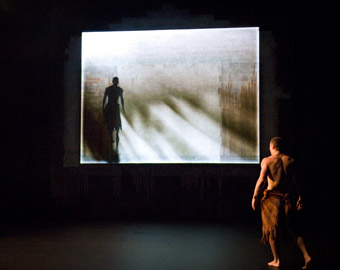
Paul White, The Oracle
courtesy Sydney Opera House
Paul White, The Oracle
meryl tankard: the oracle, spring dance
Meryl Tankard’s The Oracle is a very strange work, overburdened with symbolism and structurally awkward but blessed with co-choreographer Paul White’s committed performance, an act of considerable endurance, fitting for a work which evokes a saint’s fear of his body and his search for union with his god. The sacred dimension is establised with the playing of Joao Rodrigues Esteves’ Magnificat rising over the insect sounds of nature while images of the performer are projected like icons and multiplied in Rorschach doublings. The profane is heard in Stravinsky’s The Rite of Spring, but there are no pagan Young Girls to ritually tempt the solo dancer; his temptations are thoroughly interiorised.
He rocks, he crawls, rippling like a serpent, dances with his huge blanket of a cloak, wrapping it around his head like a turban, flourishing it like a whip, swirling in it like a dervish. At times these images suggest desire, self-obsession, or futile attempts at transcendance. When he dances with a screen image of himself, delusion beckons. At other times he is suddenly afraid, as if having been seen by God. Finally a thin column of light flows from above, widening into a circle. He backs around the perimeter as if not knowing what to do with this ‘holy spirit.’ There appears, however, to be no transcendence, but increasing effort, lunges like siezures, jerks, astonishing hand stands like offerings, moments of abjection—he crawls like Blake’s Nebuchadnezzar. He dances to utter exhaustion. And we applaud him for it, and for the skill and passion with which this torment, this journey to being merely human, where every projected icon is of a false god, the self, has been so cruelly dramatised and endured.
–
The Oracle, concept, direction Meryl Tankard, choreography Meryl Tankard, Paul White, set, video Regis Lansac, lighting Damien Cooper, Matt Cox; Playhouse, Sydney Opera House, Sept 16-20
RealTime issue #94 Dec-Jan 2009 pg. 38
© Keith Gallasch; for permission to reproduce apply to realtime@realtimearts.net
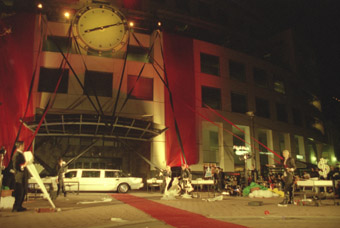
Mini Epic (1999), Odd Productions, Garema Place, Canberra in front of the Department of Employment,
photo ’pling
Mini Epic (1999), Odd Productions, Garema Place, Canberra in front of the Department of Employment,
IN REALTIME 93 (HERE BE DRAGONS), WE TOOK A BRIEF TOUR OF CANBERRA’S ASTONISHING CREATIVE COMMUNITY IN THE MID 1990S AND TRACED ITS RISE. IN THIS ARTICLE, I WANT TO EXAMINE WHAT LED TO ITS DISPERSAL, WHERE EVERYONE WENT AND WHAT’S HAPPENING NOW.
In RT93 I also postulated that the loss of such artistic power makes it important to examine what led to such a flourishing and posed a series of questions that I will endeavour to answer here. The answers can’t be completely objective: I was too involved in it for that, but sufficient time has elapsed to try to make sense of what happened and draw out some lessons that could be valuable in rebuilding a coherent artistic community in Canberra capable of producing performing arts of significance.
The conditions for that community were founded in the educational and artistic revolution arising from Labor Prime Minister Gough Whitlam’s reforms of the early 1970s. The investment in education infrastructure and the opening up of curricula allowed the creative arts to flourish in the education system and suggested that any young person could consider the arts a valid career option. The creation of the Australia Council in the same era freed the profession from the patronage system that had until then kept the arts in Australia as a vocation that meant grinding poverty unless you were favoured by the wealthy establishment.
A generation of teacher/performers emerged who had access to generous project funding and infrastructure in Canberra. The creation of the Gorman House Arts Centre in 1981 provided Red House Theatre, Jigsaw Theatre-In-Education, Human Veins Dance Company and Canberra Youth Theatre a place to work, share ideas and to perform. As noted in my first article, many talented artists came to Canberra to work with these companies, bringing their families and settling here. Young people in Canberra with an interest in the arts had both an excellent training ground and eventually several major theatre and dance companies (Meryl Tankard, Kailash, Skylark and Splinters) that offered the prospect for continuing their artistic development in Canberra after school and university.
The critical mass that Splinters achieved, according to co-founder Patrick Troy, was based on two factors that drew on the surge of young artists this community produced: firstly, anyone could participate—we estimated that by 1994 some 1,000 people had participated in Splinters’ activities. Secondly, the company’s method was one of constant training and acquisition of new skills, leading to the rapid maturation of young artists and an unassailable confidence.
But by 1998 all four major companies had gone. The reasons for their dispersal are varied, but a common element was probably that they had become too large in scope to continue as they were in a small provincial city. Splinters in particular was used as a springboard by many who eventually headed to the big smoke with their own companies: first, and most successfully, Snuff Puppets (RT50), taking with them Simon Terrill, who has built on Splinters’ crowd theory work (RT87); art-rock band Prik Harness and later Mikelangelo and the Black Sea Gentlemen; machine artists Triclops International; Temple State’s event installations; and ODD Productions, which carried on the site specific performance practice. Remaining in Canberra was CIA, the vehicle for Splinters co-founder David Branson until his tragic death in 2001 (RT47).
Splinters, in the end, was also suffocated by external factors. The election of the Howard Government in 1996 meant that living on the dole was no longer viable for artists, and the imperatives of economic rationalism and the paranoia of the parliamentary budget estimates process meant that politicians demanded every penny given to the arts be scrutinised. Suddenly administrators were required for every artistic endeavour and arts bureaucrats became VIPs. The insurance crisis of 1997 provided perhaps the final nail in the coffin. Splinters performed (literally) dangerous work with pyrotechnics which we never dared let the local insurance company know about: out of interest I once sent an unexpurgated description of our work and program to Lloyds of London and was given a quote of US$20,000 to cover public liability.
As I argued in a review of the 2000 Festival of Contemporary Arts (RT46), Canberra’s cultural planners need to be brought to account for what happened. The stark facts are that Canberra has had, and gave up, two noteworthy performing arts festivals and since 1998 has had no full-time professional performing arts company of any sort. The ‘key’ funded arts organisations now mostly deliver infrastructure, services or training. In the absence of full-time jobs, theatre and dance artists have no choice but to leave town. As a direct result, any young performer with serious talent also has no choice but to leave Canberra after finishing school if they wish to pursue a career, and will probably never return to live here.
Canberra has always had a strong DIY aesthetic, and supporting pro-am arts is valid. But the city needs to properly acknowledge what it once had and seriously debate whether it wants it again and also how to achieve it. The chances seem slim. Recently, the interventionist Arts Minister, who is also the Chief Minister, agreed to the neutering of the vibrant small Fringe Festival that had grown around the Multicultural Festival by unilaterally transferring control of its funding to the National Folk Festival.
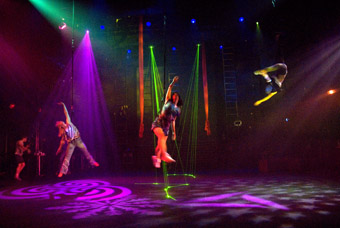
The House That Jack Built, Janine Ayres Areial Dance, Street Theatre
photo ’pling
The House That Jack Built, Janine Ayres Areial Dance, Street Theatre
The once mighty professional dance community in Canberra took a controversial left turn in 1996 when it abandoned the idea of a professional troupe to create The Australian Choreographic Centre. It was a bold experiment but ultimately failed to win the hearts of the public and was recently killed off and its reduced funding redirected to its innovative youth dance offspring, Quantum Leap. Grand dame Elizabeth Cameron Dalman in her bushland Mirramu studio aside, aerial specialist Janine Ayres is one of few left trying to keep and build a company. Her recent production The House That Jack Built (Street Theatre, October 2009) was refreshing and vibrant, with the young dancers throwing themselves into the work with gusto. Ayres should be applauded for having the guts to interpret the uncomfortable relationship between professional and experimental dance and the tribalistic dance of the nightclub world.
The prospects for theatre are no better. While pro-am companies such as Women on a Shoestring made excellent work over the years and The Street is now well resourced enough to support a few local productions, nowhere is there the cohesion offered by a dedicated stand-alone theatre company. Energetic RADA graduate Ian Sinclair, a Canberra native returned, tried in vain for several years to get funding to maintain his small ensemble Elbow Theatre. Eventually he gave up in despair and left town, along with actor Ken Spiteri and writer Mary Rachel Brown, who were beginning to establish national reputations. Gorman House Arts Centre is a shadow of its former self.
While no dance or theatre is taught at tertiary level, the presence of the ANU Centre for Photography and Media Arts ensures a thriving if small sound art scene, strongly supported by artist-run gallery/café The Front. It is a precious little gem, also home to a thriving burlesque movement led by Min Mae. Her Tableau Vivants project—a fusion of burlesque with the contemplative view of nude painting—has evoked the strongest reactions to any art work in Canberra in recent years.
Performance poetry is also showing signs of renewed life. In the 90s, Aktion Surreal took spoken word and performance combined with music into bars and galleries, evolving into publishing collective Abreaktion, while David Branson and poet Hal Judge convened the legendary cRaSh CaBaReT. Judge and Anne-Maree Britton of the ACT Writers Centre also had the vision to engage the hip hop community, with regular Poetry Slams fostering talent such as rapper Omar Musa, who recently won the Australian Poetry Slam at the Sydney Opera House.
My conclusion is this: the arts bureaucracy/peer-assessment model in Canberra, and probably everywhere else in Australia, has reached a state of what Richard Florida calls “institutional sclerosis.” Once an artistic endeavour emerges sufficiently, it takes the coin of the taxman and is forced to comply with the institutional structure that, as we have seen, perpetually marginalises new work. We must begin the campaign afresh for methods that free artists from institutional structures, such as the artist stipend in The Netherlands, the right to draw the dole as arts subsidy, or tax breaks for artists, as exists in Ireland.
The ACT Government is currently reviewing its arts funding policy, for which these two articles will be entered as submissions. I don’t hold out much hope of major change to the bureaucratic structure in a town dedicated to bureaucracy. There are so few left here who still have the energy to try.
In RealTime 95 (February-March), Robyn Archer, Creative Director of Canberra 100, the city’s centenary festival in 2013, will consider the role festivals have played in the cultural history of Australia’s capital in the third part of this series.
RealTime issue #94 Dec-Jan 2009 pg. 39
© Gavin Findlay; for permission to reproduce apply to realtime@realtimearts.net
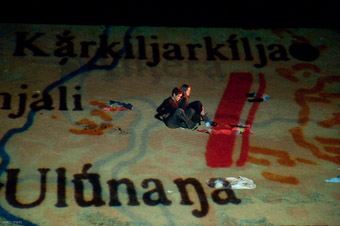
Under Today, red shoes
photo James Spiers
Under Today, red shoes
IF YOU DIG INTO THE SOIL OF ALICE SPRINGS’ EASTSIDE SUBURB, YOU WILL FIND A LAYER OF SHALE PUT THERE BY US TROOPS DURING WORLD WAR TWO TO KEEP THE DUST DOWN. “OCCASIONALLY YOU’LL FIND A PENNY”, ACCORDING TO ONE OF THE LOCALS IN AN ORAL HISTORY RECORDING EMBEDDED IN RED SHOES’ NEW PRODUCTION, UNDER TODAY. IN WW2 THE TOWN BECAME NO 9 AUSTRALIAN STAGING CAMP FOR THE US MILITARY, AND MANY LOCALS WERE EVACUATED SOUTH. IT’S JUST ONE OF THE BURIED SEAMS THAT THIS PRODUCTION SEEKS TO UNCOVER.
The performance—part dance, part multimedia projection—is staged in a drain, a redirected creek that runs between the houses of Eastside and the rocky bulge of Spencer Hill. Patrons are seated along one bank and the work centres on the other, but extends back to take in the hill, two ghost gums, a graffitied storage shed left over from WW2 and a large section of the creek.
At dusk, a low drone sounds from the speakers and figures in black begin to descend from the hills. They are anonymous silhouettes, camouflaged in the landscape. The fading light is used to full effect. Incorporating the natural and built environment has clearly been a priority for director Dani Powell who seeks with this work to “see place as a series of layered stories.”
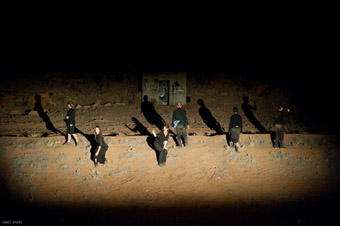
Under Today, red shoes
photo James Spiers
Under Today, red shoes
Alice Springs (Mparntwe) has a 300-generation history with little built intervention on the landscape. Since the establishment of the Telegraph Station in 1872, however, it has gone through several periods of rapid development: growth spurts and demographic shifts because of gold, war, work, migration and the ongoing process of colonisation. It is refreshing that these shifts are treated here without too much finger-pointing or moralising, just presented as facts underlying our everyday experiences of place. The temptation to sentimentalise ‘the old days’ is largely avoided.
There are some bright pennies to be found in Under Today. At the core of the piece are recorded oral histories, many of which were collected specifically for this work. Listening to these is a pure pleasure, and fascinating as this small corner of the world is described in its previous incarnations. The old trees take part in the show and, among the rewards of the site-specific staging, a bat dances a circle around a performer during a solo.
The staging is a highlight. Light and shadow are exploited to full effect as dancers turn old clothes into shadow puppet theatres, their bodies into frames and later become shadow puppets themselves. The rags on the set become ghostly bodies and are finally burned in a reminder of the role of fire in the landscape and perhaps a nod to the real campfires that sparkle down the river as we watch. The innovative use of this otherwise neglected space is delightful.
At times, the extent of the space and an episodic structure make the movement work inaccessible and it can be difficult to understand what the dancers are communicating. The anonymous figures’ reluctance to directly address the audience detracts from the personal nature of the oral histories. This obscurity is in part a problem of interpretation from a distance: the dancers are perhaps dwarfed by the scale of the projections. Under Today might be more effective on a smaller scale, with more robust choreographic intention.
The production also assumes a sombre mood which doesn’t seem entirely warranted. Is history always so serious? Under Today comes alive in moments when it drops this tone and relaxes into the story, embracing humour, such as when six solo waltzers come down the hill as an old Italian pizza shop owner talks about the history of his business.
Projected maps play across the ground, telling us the Arrernte names for the places we see, many of which have been developed and renamed without permission from the traditional owners. The right language for this country is embedded in Under Today with gentle assurance. Later another map of the suburb’s lots scrolls up the creek bed as the figures enact a town-planner dance of finger pointing and line drawing, a parody of bureaucratic discipline which garners more chuckles.
At its best, Under Today is a wonderful exploration of the depth of experience hidden in a specific place. Given that this is a developmental showing, Under Today is a promising work with a gently archaeological intention which has the potential to reach a much broader audience.
red shoes, Under Today, producer, animateur, director Dani Powell, media artist Alexandra Gillespie, sound artist Guy Webster, dancer/choreographer Miriam Bond, performer/maker Frances Martin, dancer/choreographer Mariaa Randall, performers Kristy Schubert, Matty Day, Fina Po, Rita-Mae Ross, lighting designer Kallum Wilkinson, consultants senior Arrernte women Kumalie Riley, Veronica Dobson, anthropologist Mike Cawthorn; Gosse St Park, Eastside, Alice Springs, Oct 17
RealTime issue #94 Dec-Jan 2009 pg. 40
© Jennifer Mills; for permission to reproduce apply to realtime@realtimearts.net
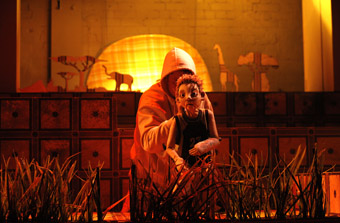
Africa, My Darling Patricia
photo Jeff Busby
Africa, My Darling Patricia
A SUBURBAN HOUSE MADE DISHEVELLED BY CHILDREN: A TERRACED STAGE, FOUR SHALLOW LEVELS OF KHAKI-COLOURED LINO, WELL-WORN FURNITURE, ENGULFED BY THE ORGANIC, OVERGROWN MESS OF PLASTIC TOYS AND WASHING. MY DARLING PATRICIA’S AFRICA, A LITTLE DITTY TO EARLIEST CHILDHOOD, PRESENTS LIFE AS SEEN FROM THE FLOOR. FOR THREE LITTLE CHILDREN, THE SHOW’S PROTAGONISTS, THIS KNEE-DEEP DOMESTIC JUNGLE IS A SPACE OF ENDLESS ADVENTURE. ADULTS, UPSTAGE, ARE REDUCED TO HEADLESS LEGS, ENACTING VERY SERIOUS-LOOKING, BUT INCOMPREHENSIBLE SCENARIOS.
From one visually splendid work to another, My Darling Patricia have been exploring the fraught worlds of the women who raise us: from our starchy, repressed grandmothers, who sabotaged regimented dinner parties in Politely Savage and retreated into gothic, self-annihilating fantasies, to the sedated, distant mothers of Night Garden, wandering through fragile glasshouses in synthetic nightgowns, too distant to comfort. Despite the apparent focus on children’s imagination, it is the tough, suburban single mother, embodied with empathetic grace by Jodie Le Vesconte, who is the complex centre of this new work. Tripping over neglected laundry baskets, she juggles an unreliable boyfriend, hostile social services and temperamental children, in turns neglectful and protective, vicious and affectionate.
Africa could have been a garden-variety condemnation of bogan Australia, depicting the working classes as a social stratum plagued by domestic violence, alcoholism and child abuse. Instead, three children remain sovereign in this domestic chaos, living richly imaginative lives. A documentary on Africa, transformed through their unformed yearnings, becomes the ordering structure for their world. Angry adults roar like lions, a little girl imagines herself a flamingo, and when suburban life becomes unsatisfying they pack their little backpacks and attempt to board the first plane to the savanna.
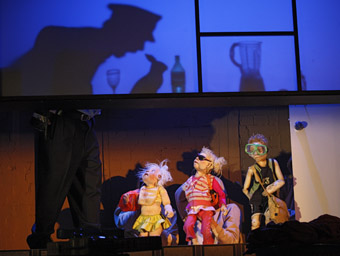
Africa, My Darling Patricia
photo Jeff Busby
Africa, My Darling Patricia
Patricias endow the puppets with a magnificent fluidity of movement. Operated by multiple puppeteers, bunraku-style, three children truly come to life, with a verisimilitude of attitude real actors could not even approximate, and with beautifully observed details: dancing, moonwalking, gasping for air mid-sob, launching into a cacophony of tantrums when their Christmas presents, gifts from their mother’s ex, are taken away. The older girl accuses her of not being her real mother and threatens to get Madonna to adopt her. Curled up on the floor once the fight has subsided, she pokes her mother’s behind, annoyed that she is focusing on the other sister.
Everyday activities in families fatigued by child-raising gravitate towards the ground, where all adult activity seems a tad less real. The cruelty and the tenderness of this family is all conducted among the washing and the toys; the uppermost level reserved for faceless, abstract conflicts: with the police, institutions, neighbours.
Children’s lush, robust escapism gives way to an uncharacteristically naturalistic denouement. Having erred on the impressionistic side before, Patricias now settle for unadorned, complicated realism. The family has to leave; little friends are separated. Arresting imagery swept aside, one boy is left behind on the bare lino, on which a miniature silhouette savanna emerges, but only momentarily. It is a courageous choice. Africa remains a show about a mother, and childhood as it is: difficult, bearable, un-tragic.
My Darling Patricia, Africa, concept, design, creation My Darling Patricia, concept Sam Routledge, writer, director Halcyon Macleod, design Clare Britton, Bridget Dolan, performers Jodie Le Vesconte, Matt Prest, puppeteers Clare Britton, Alice Osborne, Sam Routledge, composer, sound designer Declan Kelly, lighting Lucy Birkinshaw, puppets Bryony Anderson; Malthouse Theatre, Melbourne, Nov 12-29
RealTime issue #94 Dec-Jan 2009 pg. 40
© Jana Perkovic; for permission to reproduce apply to realtime@realtimearts.net
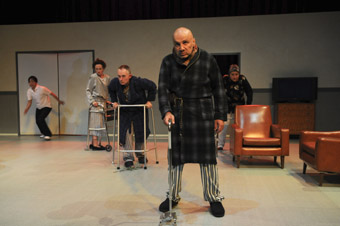
Valerie Berry, Kim Vercoe, Phillip Mills, Arky Michael, Rosie Lalevich, Missing the Bus to David Jones
photo Heidrun Löhr
Valerie Berry, Kim Vercoe, Phillip Mills, Arky Michael, Rosie Lalevich, Missing the Bus to David Jones
IN A MISSIVE FROM THE 2009 WORLD HEALTH SUMMIT, KEVIN RUDD RECENTLY EXPLAINED THAT BY 2047 ALMOST 6% OF US WILL BE OVER 85 YEARS OLD. NEWBORNS, IT SEEMS, WILL GET A LONGER RUN AT IT TOO, WITH RESEARCH SHOWING THAT AT LEAST HALF THE BABIES BORN IN RICH COUNTRIES POST-2000 WILL REACH THEIR 100TH BIRTHDAY.
With growing attention to what it means to be part of both an ageing society and a more generally ageist culture, artistic representations of, and collaborations with, those whom we call ‘the elderly’ are increasingly imperative. Conversations around the politics and ethics of such work are also vital: how might those who have slipped from visibility and vocality re-access the representational structures from which they have largely been erased?
Theatre Kantanka’s Missing the Bus to David Jones, directed by Carlos Gomes, is one recent attempt to deal with the complexities of ageing that invite an equally complex praxis of theatre-making, storytelling, listening and watching. Set in an aged care facility that thrums with various foreboding decor clichés (the pineapple scent of disinfectant, the shiny vinyl of the easy-chairs; the calming LCD TV ‘entertainment centre’, the muffled AM radio), the space is instantly redolent with the uncomfortable sense that this is what we do with our old people in this country—those who now move slowly, who can’t bend, who forget mid-sentence. Despite our best intentions, we take those loved ones here to die.
Missing the Bus is less a critique of the social, economic and family systems that feed an aged care cultural ‘mentality’, and more an investigation into what happens once you are inside such an institution. To make the work, Kantanka (Gomes, Valerie Berry, Rosie Lalevich, Arky Michael, Phillip Mills, Katia Molino, Kym Vercoe) engaged in a hefty research and consultation process that included visits to a range of aged care facilities—and with a mind to understanding their ethnic, economic and remedial differences—the undertaking of conversation, observation and assistance with what Gomes terms “the micro-universe of aged care.” Artists negotiated with staff, with residents and with families of residents, and then with aged care industry consultants at their first development showing.
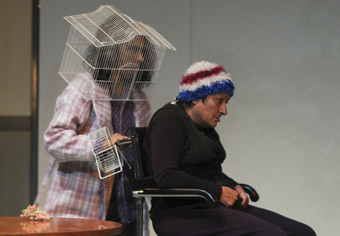
Katia Molino, Rosie Lalevich, Missing the Bus to David Jones
photo Heidrun Löhr
Katia Molino, Rosie Lalevich, Missing the Bus to David Jones
Missing the Bus is hence a theatrical—rather than documentary—reflection on ageing that is contemplated through a string of loosely interweaving vignettes and framed by video material (Joanne Saad) that sits in situ on the television set, and on a larger screen flanking the space. Narratives are sad, sentimental, cruel and ridiculous. The actors take on multiple character roles and are adept at feeling their way into the curvature of a sagging weakened spine (Vercoe), or into the verbal arrhythmias of frontal lobe impairment (Molino). We see (and contribute to in our looking) the shaming that happens when control over bodily functions is lost, and we witness the daily contradictions between despair and frivolity as characters live through their letting go of life.
There are some striking images: a still, unmoving slumber opens the work to evoke a certain edge—this is the kind of sleep from which one may not wake. An extraordinary choreography realised by Kym Vercoe allows one character’s hands to delicately butterfly around the space and shyly seek out touch. A therapy balloon game is catapulted into disaster when the balloon is caught, it seems almost unsurprisingly, by dirty poo fingers.Flanking the performances, the video work sits tentatively between documentary and re-enactment genres to spin fantasy images out of the slowness of real time and into the conditional tense of imaginary past or future selves.
Carlos Gomes describes the work as an “imprint of a set of experiences” and “a theatrical reaction to” the aged care “universe.” Audience reaction to this theatrical world might applaud the tight structure of the work, its thematic interest in ageing and the skills of the performers, whose mimicking of the aged seems to spring from an empathy conveyed through exacting repetition of bodily movements. However, the relationship between the theatrical and the social can be vexed: representations of the new “otherness” called ageing are open to critique where they imitate their subjects. Verbatim theatre, on the other hand, ethically avoids mimicry while a company like Back to Back Theatre inclusively creates and performs works by its subjects.
Disability studies stemmed from an earlier history of feminist and ethnic minority politics, and while a similar lineage in ageing studies might still be a while away, if ageing is the next frontier to be challenged, then Kantanka have made a genuine start.
Theatre Kantanka, Missing the Bus to David Jones, director Carlos Gomes performers-devisors Valerie Berry, Rosie Lalevich, Arky Michael, Phillip Mills, Katia Molino, Kym Vercoe, dramaturgy Annette Tesoriero, video Joanne Saad, sound Nick Wishart, lighting Sydney Bouhaniche; Campbelltown Arts Centre, Oct 8-11, Performance Space, Sydney, Oct 21-24
RealTime issue #94 Dec-Jan 2009 pg. 43
© Bryoni Trezise; for permission to reproduce apply to realtime@realtimearts.net
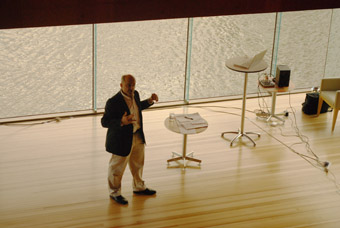
Douglas Kahn in the Red Box, State Library of Queensland,
photo Chloe Cogle
Douglas Kahn in the Red Box, State Library of Queensland,
AS THE RECENT RE:LIVE MEDIA ART HISTORY 09, THE THIRD INTERNATIONAL CONFERENCE ON THE HISTORIES OF MEDIA ART, SCIENCE AND TECHNOLOGY IN MELBOURNE CLEARLY DEMONSTRATED, MEDIA ART IS THE AESTHETIC NEOPHYTE NO LONGER. SHORN OF ITS AHISTORICISING PREFIX ‘NEW’, THERE IS A RAFT OF WRITERS, RESEARCHERS, ACADEMICS AND ARTISTS KEEN TO EXAMINE THE ROOTS OF MEDIA ARTS PRACTICES AND MOVEMENTS, AND THEIR BROADER ASSOCIATIONS WITHIN SCIENCE, TECHNOLOGY AND CULTURE.
Many of these lines of inquiry can be traced back to the social, scientific and cultural spaces, institutions and situations of the mid to late 19th century that brought forth the mediascape with which we have become progressively familiar. However, discernable within these investigations lies a related history of a phenomenon waiting to be discursively unearthed, that of electromagnetism. Whether considered simply as the physics behind electronic consumables or as the invisible frequency spectrum of radio, television and data transmissions, electromagnetism is to some degree intrinsic to most conceptions of media arts, and has a social and cultural history stretching beyond the arts into the natural philosophy of the 19th century which traverses perceived contemporary divides between analogue and digital, between art, science and technology, and between the synthetic and the natural (and, for some artists, the earthly and the spiritual).
American academic and writer Douglas Kahn has spent the last 10 years researching the intersections of electromagnetism, science and art. He is perhaps best known for his book Noise Water Meat: A History of Sound in the Arts, which sought to inject a discussion of the sonorous, audible and noisy practices of artists into the otherwise ‘silenced’ histories of 20th century aesthetics. Kahn recently visited Australia and expanded upon the theme of electromagnetism and the arts during his keynote address at Re:live Media Art History 09, along with a national lecture tour, sponsored by the Australian Network for Art and Technology (ANAT).
This is fitting, as Kahn cites an encounter with the works of Australian artist Joyce Hinterding that explore both natural and synthetic electromagnetism as pivotal for instigating this study: “I was familiar with Joyce Hinterding initially because she was one of the most interesting artists working in sound. But, frankly, I didn’t fully understand what she was doing with pieces like Electrical Storms or Aeriology. Not merely sound pieces, they involved whistlers, atmospherics, Very Low Frequency radio, energy harvesting and the like, ie physical phenomena and concepts that enhanced the poetics and politics of the works. The larger research project that her work occasioned eventually organized itself around electromagnetism. Just as I had experienced in the 1980s with sound in the arts, there was not much scholarly or theoretical work to fall back on. In comparison, however, sound has been ingrained in the culture since antiquity whereas it wasn’t until the 19th century that electromagnetism began to get off the ground, so to speak, in transmitted waves. In ‘historical years’, sound is very old whereas electromagnetism is very young. Aristotle talked about sound but didn’t tune into radio. In one respect, there is little cultural grasp because there hasn’t been time.”
However, Kahn sees an overriding necessity to understand and contextualise electromagnetism, especially as it is the basis for contemporary communications. “To understand Joyce Hinterding, I had to go back to the 19th century, to the birth of modern communications technologies, and become familiar with scientific, cultural, environmental, military and aesthetic engagements with the electromagnetic spectrum. It has demonstrated for me how difficult, time-consuming and invigorating it can be for an arts historian to understand just a few works. Meanwhile, Joyce’s work and her collaboration with David Haines have continued to go from strength to strength. So, they’re not making my job any easier or less interesting.”
Hinterding’s work links back to that of American experimental composer Alvin Lucier and his compositions such as Whistlers and Sferics that also captured the sounds of electricity far above the Earth’s surface, such as solar flares and lightning strikes resounding through the ionosphere. Additionally, an earlier Lucier work, Music for Solo Performer, where amplified brainwaves were used to sound percussion instruments, sourced its natural electrical activity from the biological realm. Hinterding and Lucier’s interest in audible electromagnetic activity in turn harks back to the experiences of early radio and telephone pioneers for whom the seemingly extraneous sounds of electrical interference encountered over the wires were not simply discounted as noise but instead became sources of fascination and pleasure: “The media archaeological precedent for the natural radio work of both Joyce Hinterding and Alvin Lucier comes surprisingly from one of history’s great sidekicks—Thomas Watson—the first name in modern communications: “Watson, come here…” The first telephone test line over the rooftops of Boston acted unwittingly as an antenna.
This was the decade before Heinrich Hertz gave the first empirical proof of the existence of electromagnetic waves, and before anyone knew what an antenna was. Watson listened to the sounds of natural radio for hours at night and into the early morning. They were noisy, musical and mysterious. He was clearly listening to noise for pleasure, predating Luigi Russolo and the Art of Noises by over a third of a century, and listening to electronic music long before its time. Most importantly, he was listening to radio before it was invented.”
The activity of listening out for, and listening in to, electromagnetic activity by artists, inventors and scientists plays an important role in Kahn’s history of electromagnetism, especially as he attributes sound as having played a somewhat prescient role both in the shaping of electronic media in general, and in interpreting the electromagnetic nature of our environment. For example, the principle of electroacoustic transduction—where electrical energy is converted into acoustic energy, and vice versa—enabled these acts of audification (listening in on events and phenomena that are otherwise inaudible, such as atmospheric lightning strikes) and sonification (the realisation of ‘silent’ data or activity as sound, such as brainwaves) to effectively make natural electromagnetism audible, and therefore a potential subject for artistic and scientific exploration.
Kahn has coined the term “Aelectrosonic” to characterise this productive historical interrelationship between sound and electricity: “Music and nature have long performed a duet in ideas of the Aeolian. In the 19th century, many people commented on the Aeolian effects heard in the wind blowing through telegraph lines, heard in the air or with an ear to the poles. Henry David Thoreau wrote effusively about what he heard in the ‘telegraph harp.’ It was along similar lines or, rather, within similar lines that Watson heard the nature of the electromagnetic. There was no word to describe what he heard so I have chosen to call it Aelectrosonic to denote the transduction from electromagnetic to acoustical, with the ‘Ae’ a mark of continuity of natural sound in the Aeolian and a commonality in turbulence.”
In positing the Aelectrosonic, Kahn also seeks to restore some of the implicit, physical specificity to definitions of transduction in order to enrich its application elsewhere: “Metaphors are well-suited to a movement of images whereas ‘transduction’ pertains to a movement of energies, from one energy ‘state’ to another, even though the way ‘state’ implies stasis doesn’t do justice to the movement involved. There is transduction-in-degree and transduction-in-kind. If you imagined the physiological fact of hearing in terms of the former—vibrations in the air moving to the vibrations in eardrum, bones and fluid in the cochlea (some people call this ‘tympanic’)—it would provide an inadequate model for what really happens: the movement from vibrations to the electro-chemical signals of the brain, at the moment of opening ion channels in the cochlea, not to mention the process of reverse transduction in the ear, the brain making vibrations in the cochlea. Thus, what happens in the ear played out along the lines of 19th century communications technologies when the transduction-in-degree of the Aeolian effects on telegraph lines moved to the transduction-in-kind, Aelectrosonics. The nature of music moved into media along the same lines.”
This project is not solely an aesthetic one for Douglas Kahn, who sees it as having both a political and environmental dimension. He cites the conventional technocentric narrative that surrounds communications technologies as the “last/best hope for modernist ideologies of progress: an unimpeded march into the future”, whereas other technologies have “hit the wall of nature.” Uncovering a discourse that locates electromagnetism within the realm of natural phenomena stymies this lionisation of technology as something separate from nature, instead making it subject to, rather than apart from, environmental and social conditions: “Communication technologies have no ‘nature’ primarily because the noises and instability of nature have been exorcised as interference. There is no nature because historians have painted a picture of inventors, patent disputes and business models, imperial and demographic trajectories in which nature does not play a part, despite the fact that the earth was ‘in-circuit’ for decades during the 19th century and the ionosphere from the 1920s through the 1960s.
“This makes it easier for us to imagine, among other things, that there are now innumerable social communities bereft of affiliation with the earth, without any physical habitat. An unnatural reserve is created where communicative activities appear unfettered from materials, energies and environments during a time of accelerated degradation and a fleeting period of opportunity for fundamental ecological transformation. The way that contemporary artistic and activist practices are putting notions of the Earth back ‘in-circuit’ are better aligned with the turbulences and energy systems at the geopolitical and geophysical scales that define the present day.”
Douglas Kahn Lecture Tour, presented by ANAT and Art Monthly Australia, Nov 2009
Joyce Hinterding, www.sunvalleyresearch.net; Alvin Lucier, http://alucier.web.wesleyan.edu; Live VLF Radio, http://abelian.org/vlf; Douglas Kahn, www.douglaskahn.com; ANAT, www.anat.org.au
RealTime issue #94 Dec-Jan 2009 pg. 44
© Peter Blamey; for permission to reproduce apply to realtime@realtimearts.net
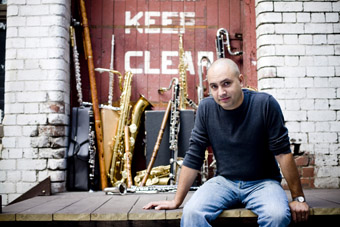
Adam Simmons
photo Mark Chew
Adam Simmons
AT AN AFTERNOON PERFORMANCE AT BENNETT’S LANE, THE GERMAN TRIO LIAISON TONIQUE PERFORMED TWO SETS OF ORIGINAL COMPOSITIONS. WHILE THEIR MUSIC IS STEEPED IN THE JAZZ TRADITION, LIAISON TONIQUE’S IMPROVISED MATERIAL DEPARTS FROM A TRADITIONAL JAZZ VOCABULARY, SHIFTING FOCUS TOWARD THE TACTILE QUALITY OF SOUND.
Joined by local multi-instrumentalist Adam Simmons, this aesthetic becomes all the more palpable. Simmons contributions on the contra alto clarinet, soprano and tenor saxophones are often breathy, rough and always rich in character. His unique voice integrates remarkably well with the trio. As the players move beyond their traditional roles, their instruments blend in unusual ways, creating an intriguing sense of musical foreground and background. Pianist Laia Genc leans into the piano to play its strings, while bassist Sebastian Gramms uses his bow to produce a plethora of effects.
Leaving the realm of jazz completely, Simmons and Gramms engage in an improvised duet. Exploring a variety of effects, their interaction is based on the blending of complex and often very dense textures. There is an obvious rapport shared between these two that suggests a history of working together. Simmons and Gramms first met through an encounter at Music OMI, an international residency program in upstate New York. The purpose of this program is for musicians to learn more about their craft through playing and collaboration. There are no stylistic or technical agendas, but rather an interest in finding common ground on which musicians from different backgrounds can interact.
Simmons comes from a tradition of free jazz musicians such as Anthony Braxton, Albert Ayler and Roland Kirk, this influence felt not only in various sounds and techniques, but also as something that is inherent in their approach. He displays a deep fascination with the freedom and risks that come with improvised music. His passion for finding different ways to present this music has led him to become involved in Music OMI as both resident and mentor. He has since formed collaborations with groups such as Liaison Tonique, and has established himself within an international network of musicians from Europe and America.
Simmons also appears to have an interest in finding ways to connect with audiences unfamiliar with free jazz or avant-garde music. This is perhaps most apparent in his project the Adam Simmons Toy Band: an eight piece jazz ensemble with an added theatrical element. Players perform on a variety of toys, engaging the audience in a sense of play. Sophisticated in its phrases and harmonies, the Toy Band is a vehicle for Simmons compositional work. While this kind of composition might usually appeal more to a specialist audience, the theatricality of the toys sheds a light on the music, helping to broaden its appeal. In a typical performance, an audience will experience a generally chaotic atmosphere, with rubber chickens, bubbles, balloons and improvised solos along with ensemble playing of the highest calibre.
Simmons’ creativity and talent for collaboration make him one of the most in demand musicians on the Melbourne scene. His involvement with groups such as Embers, The Australian Art Orchestra, Bennett’s Lane Big Band, New Blood and Bucketrider (to name a few), testifies to his versatility as a performer. This is no more apparent than in his live shows which incorporate an arsenal of wind instruments and creative approaches to composition and improvisation. A recent CD release, simply titled Adam Simmons, demonstrates his work as a solo performer.
Opening with “Alak-ala”, the CD introduces the fujara—a large folk fipple flute, originating from Slovakia. Using a 7/8 groove with a quasi back-beat feel, the piece gradually moves through and blends overtones, exploiting the full colouristic effect of this instrument. In 5:27am, which follows, we hear short, fast melodic flurries on the piccolo. These fragments gradually evolve into longer phrases. Aside from some variation (a few staccato notes and a flutter tongue passage at the end) this is the basic compositional device from which the piece is constructed. At times it resembles a demented Ross Edwards’ work, its roughness and ambiguity in pitch aside.
The next composition moves into a darker space, created through the low tones of the contra alto clarinet. This piece, “Forbidden History”, is an exercise on the variety of colouristic effects possible on this instrument. Using only one note, Simmons explores and combines its overtones, mixing it with an occasional breath sound. Moving to the shakuhachi, Simmons performs “Tagging”, a work that moves between expansive gestures and abrupt interruptions. Exaggerating this instrument’s breathy character, he uses airy, slurping, coughing, wheezing and vocal sounds, almost to the point of parody. Godel’s Yodel is an exercise in register and note density for sopranino saxophone. Beginning with wild flurries of notes, the texture gradually becomes more sparse, until only single, disjointed notes remain. “Heaven is a Place” also employs a simple device, using only two notes, oscillating a major second apart. There is a constant rhythm throughout, created by Simmons’ finger moving up and down. The click of the key is heard throughout, although the tones themselves fade in and out with the breath.
Simmons’ is a unique voice in Melbourne’s musical landscape. He has an inquisitive approach, investigating all the sounds and characters his instruments can produce. There’s often a sense of humour and light-heartedness in his work that does not detract from, but only enhances its impact.
www.adamsimmons.com; Adam Simmons CD, Fat Rain label, FAT 006
RealTime issue #94 Dec-Jan 2009 pg. 45
© Simon Charles; for permission to reproduce apply to realtime@realtimearts.net
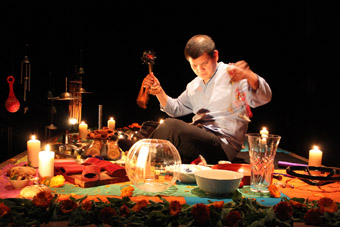
Evaristo Aguilar, Xantolo
photo Thea Baumann
Evaristo Aguilar, Xantolo
I AM IN THE FIRST COHORT OF PEOPLE TO WITNESS THE WORLD PREMIERE PERFORMANCE OF XANTOLO. TWENTY OF US ARE SEATED IN A SINGLE ROW ON THREE SIDES OF A LOW PLATFORM, IN THE MIDDLE OF WHICH SITS MEXICAN PERCUSSIONIST EVARISTO AGUILAR SURROUNDED BY AN ARRAY OF PERCUSSION INSTRUMENTS, FLOWERS, CANDLES AND BREAD.
Xantolo means day of the dead in the Huastecan language of Mexico and, for Mexicans, the Day of the Dead is an annual holiday of remembrance of deceased relatives and friends. This is the first of five performances on November 2, a day which marks All Souls Day in the Catholic Church and the second of the two traditional days of Mexican observance.
Following a taped introduction outlining the origins of the work, Aguilar begins to play the percussion instruments—wooden blocks and tubes, brass bowls and plates, small cymbals, drums, rattles, metal and wooden chimes and found porcelain and glass bowls. He plays gently, almost caressingly, using drumsticks or his hands, each instrument making carefully tuned resonant tones, and he pours dried grains of corn to create a percussive sound. The 15-minute performance appears ritualised, as if we are being led through prayer or meditation, and the dance rhythms are hypnotic. Limiting the audience to 20 allows an uninterrupted view of the performer and also enjoins audience members as an extended family group sitting closely around the table. The instruments are simple and beautiful and some are symbolically suggestive—the bowls represent the home and corn is a staple food—while others have been designed by Aphids artist Rosemary Joy specifically for this work, evoking the kinds of sounds heard on such occasions and perhaps the spirits of the dead themselves.
This production continues Aphids’ long-established concern with collaborative and cross-cultural performance. Evidently, Joy visited Mexico and witnessed Day of the Dead celebrations in Huastecan culture, which combine pre-Columbian and Catholic traditions, and which are typically festive occasions, with participants in costume singing and dancing, and a table or altar in each home set with flowers, bread (pan de muerto), rosaries and candles. A structured improvisation, the work is part percussion performance and part theatrical presentation, an abstraction of certain characteristics of Huastecan Xantolo celebrations, though perhaps more muted and internal. A window into another culture, it is thus a mirror onto our own.
The Melbourne Recital Centre has on its web-site an interview between its CEO Jacques de Vos Malan and Rosemary Joy and Aphids artistic director David Young discussing the origins of the work. Placed in this context, the performance becomes much more than a fine percussion piece. Aguilar, a professor of percussion in Mexico, has adapted traditional Huastec musical forms for presentation internationally. The Melbourne Recital Centre has taken a bold step in supporting a work with a radically different form of presentation, limiting the audience to 100 in five shifts, but the intimacy and close attention afforded are vital to understanding and appreciating this absorbing work.
Xantolo, percussion Evaristo Aguilar, artist Rosemary Joy, instrument construction Adam Stewart, Rosemary Joy, producer Aphids; Melbourne Recital Centre, Nov 2
RealTime issue #94 Dec-Jan 2009 pg. 46
© Chris Reid; for permission to reproduce apply to realtime@realtimearts.net
IN THE NOVEMBER EDITION OF ART MONTHLY, ZITA JOYCE SUGGESTS IT MAY BE DIFFICULT TO ACCESS THE NEW ZEALAND SOUND COMMUNITY, BUT THERE IS NO SHORTAGE OF ARTISTS AND SUPPORTERS. TOGETHER WITH THE DUNEDIN PUBLIC ART GALLERY, THE AUDIO FOUNDATION’S ALT.MUSIC ORGANISATION RECENTLY AUSPICED VISITS BY JAPANESE PERCUSSIONIST HANO SHOJI AND UK FIELD RECORDING LEGEND CHRIS WATSON, IN ASSOCIATION WITH NZ ARTISTS PSN ELECTRONIC AND OTHERS IN AUDIOFEST.
Hano’s solo technique exhibited a fascinating combination of formalism with chaotic free improvisation. Confining himself to the traditional kit, and despite the density of percussive combinations and variety of tones made by hitting the skins at different sites, he always employed the full strike of the drum stick. Hano’s method recalled in this sense mid 20th century ballet or pre-Fusion African-American jazz, where the instrument is used correctly even as one strives to extend its range. Hano’s work therefore possessed relatively little colour or chromaticism, depending largely on temporal variation to construct a series of flows and counterpoints.
Hano also performed with local Dunedin artists, duelling with Rory Macmurdo’s hard-rock drumming. Alex Mackinnon provided destroyed guitar noise, using a near unplayable instrument and a flapping, behemoth amplifier to generate a rich set of dirty textures. Hano was a commanding orchestrator, following a somewhat classical model of free jazz in which each artist has at least one solo, the players working largely in unison or parallel, rather than antagonistically.
Lee Noyes’ contribution dramatised the limitations of Hano’s approach. Noyes has more in common with Australian percussionists Sean Baxter and Will Guthrie, being as content playing the sides of the drums and found instruments as the kit. He ran a metal string over a movable violin bridge placed on one drum, producing a wonderful array of unexpected, changing, resonating notes. His approach suffered from insufficient amplification, but he helped release the gig from Hano’s implicit suggestion that drums must be played as they were designed to be.
The second Dunedin gig featured soundscapes from Sean Kerr and Simon Cuming (Auckland). The electronic palette was appealing without being distinctive, the duo’s work lacking the compositional logic of say Bernard Parmegiani or Janet Cardiff, producing a set of materials which, while interesting, did not cohere. Things livened up when Michael Morley (Dunedin) stepped up, looking like a renegade from Warhol’s Factory (complete with black shades), voicing a harsh wall of guitar feedback. Morley’s indifference to his audience however echoed his music, and while there were great textures, the temporal structure was so opaque as to make the improvisation essentially static.
By contrast, locals PSN Electronic offered a more composed approach to live electronic performance. Susan Ballard, Nathan Thompson and Peter Stapleton used a range of CD players as well as other radiophonic gear to provide a soundscape largely derived from the sound of CDs skipping (1000 faulty copies of their own release). While the palette was familiar to anyone who’s followed glitch, Oval and the Mille Plateau label, the trio maintained interest by allowing their presentation to waver in and out, while nevertheless holding things together with the slippery clicks and cuts characteristic of this style, and a tendency to anchor materials in actual or quasi-subliminal beats. PSN Electronic’s few releases meld buzz and drone well with these models; hopefully they’ll have more to offer.
Chris Watson was the star of the three-night program. He founded Cabaret Voltaire before moving to natural soundscapes in the 1980s and worked on David Attenborough’s blockbuster nature shows. Watson is reluctant to publicly denounce his earlier interest in so-called ‘industrial’, machinic and mediated sounds. His current oeuvre however represents the complete inversion of his previous aesthetic.
Watson is a realist, and while he stresses that recording and re-listening enables him to become aware of creatures and events he is unable to visually perceive—notably the wealth of insect activity that occurs even within an extremely small section of the barren Saharan grasslands and giber deserts—he nevertheless insists that he has not “changed” the sounds which he so skilfully presents. This is an allegedly pure, pre-existing sound world, and not one—as Francisco López, Karlheinz Stockhausen or others would insist—actually created by the microphone.
While the crackling, inarticulate and bizarre rumblings of a Saharan lion provides a highly abstract experience for the average Western listener, Watson’s pieces do not (and are not designed to) grab the listener’s attention. I prefer more overtly manipulated sound, but it is rewarding to hear a fine craftsman present his deliberately seamless edit of over 30 recordings into simple narratives such as day to night to morning (a sequential pastiche of different organisms and hunting noises), or oceanic surface to extreme depths and back up again. Like film critic Andre Bazin, Watson strives to recreate the quasi-spiritual beauty of the world through technological transcription, and this is much to be admired.
Audiofest, artists Hano Shoji, Lee Noyes, Rory Macmurdo, Alex Mackinnon, Peter Porteous, Sean Kerr and Simon Cumming, Michael Morley, Chris Watson, PSN Electronic (Susan Ballard, Nathan Thompson and Peter Stapleton; Dunedin Public Art Gallery, Oct 1, 3, 8
RealTime issue #94 Dec-Jan 2009 pg. 46
© Jonathan Marshall; for permission to reproduce apply to realtime@realtimearts.net
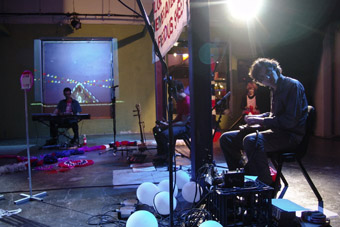
The States
photo Sharka Bosakova
The States
IN THE NO-FIT-OUT SPACE THAT IS THE SHOPFRONT COMES THE STATES, THE THIRD WORK FROM GRISWOLD, PIRRIE AND FOLTZ. THE SHOW IS BILLED AS EXPLORING “THEMES OF GLOBALISATION, DISLOCATION AND IDENTITY FROM AN EXPATRIATE POINT OF VIEW”—GRISWOLD AND FOLTZ BEING EXPATS FROM THE USA AND PIRRIE AN AUSTRALIAN LIVING IN DARWIN, A TOWN SPLIT BETWEEN PERMANENTS AND TRANSIENTS. SO IT’S STATES IN GENERAL AND ‘THE STATES’ IN PARTICULAR.
We enter to Sarah Pirrie, in the role of usher, handing out largish palm cards printed with some of Craig Foltz’s poetry and a few dot point instructions. Things like “cross out the words you don’t agree with”, “tear up the card into little pieces and scatter in the middle”, “read the words out loud.” Instructions differ a little from card to card.
Centred in the space—let’s go with the architects and call it a void—there’s after-party flotsam: election style paper rosettes in red, white and blue, junk on the floor, a chocolate wheel ready to spin. I imagine stale beer and peanut shells in a plasticised paper bowl, occasional piles of crushed chips testifying to jogged elbows and brief apologies. But the design doesn’t go that far. Instead there are nostalgic images—maps of the USA from before it got the U, a projection to the front street-side window of birds, fish, the beach, a landscape from the air. A banner hangs with vaguely readable somethings about the dimpled ocean, transparent membranes, fibrous sheets. The scene is down-home and small scale. A rally for the Party faithful at the community hall but now it’s late and the last to leave are feeling very tired and sort of used.
Erik Griswold announces, “Welcome to the States”, and Alison St Ledger begins wordlessly singing “Amazing Grace” to a seamless accompaniment by Nicholas Ng on erhu. Über-chestnut done ecumenical gospel lite. Post-fundraiser music for a slightly depressed and unpleasantly sobering politico remembering the feelings they had about political change before they went into politics and changed themselves instead.
Into the second song, “If not the Past”, which has text delivered by Craig Foltz. Foltz’s voice throughout the concert is not always as distinct as it could be, maybe problematic acoustics of the space or maybe speaker placement issues (the speakers face away from the audience and toward the performers). Not sure, and a shame because snippets that are clear, “if not the past then perhaps a soundbite of the past”, have me wishing for a better listen. Music stays down tempo, this time though it is more Carole King à la “It’s too late baby, you’ve got a friend”, music I developed a deep, gut-level avoidance response to in the 70s.
Segue into overlapping vocals and a rising hysteria—the mood shifts to performance/conceptual/radio art, Eric Salzman’s Nude Paper Sermon from the late 60s, snippets of culture as new, foreign and rushing past. Stop, and Pirrie-the-usher wanders about pulling down bits of bunting and dumping it on the floor to a slow blues soundtrack of melodica and erhu.
Then it’s trumpet, voice and erhu again sounding out a listless blues. I find the concert lags a little here, sounding a bit like a late afternoon bluesy jam after a few too many beers. I can see how conceptually that fits with a theme of displacement and decline—the expat vision of neither here nor there, the learned helplessness of untappable power, the fading glory of Old Glory.
Break for some audience participation. Foltz spins the chocolate wheel and we all get to follow the colour-coded instructions on our cards—chance and selection in a party atmosphere. And then the final titled work—The Party’s Over—talk and music, serious and reflective, ecstatic—if I could be bothered—but I can’t. Again the work totters at the edge of release, but pulls back, goes no further.
Last, but not least, leave them smiling with a tootling up-beat salsa. We’ve had some sad times, some audience participation, some fun and some flagging, but let’s forget about it now, put the past behind us and move on. Give ourselves something to look forward to, the next country, the next state. Moving along. Getting there.
The States, creators Erik Griswold, Sarah Pirrie, Craig Foltz, vocals Alison St Ledger, Craig Foltz, keyboards Steve Newcomb, Erik Griswold , Chinese strings Nicholas Ng, trumpet Peter Knight; Shopfront, Judith Wright Centre of Contemporary Arts, Brisbane, Oct 1-3
RealTime issue #94 Dec-Jan 2009 pg. 47
© Greg Hooper; for permission to reproduce apply to realtime@realtimearts.net
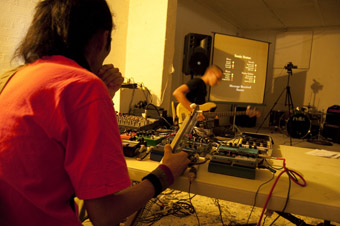
Hirofumi Uchino, Abel Cross, SMS Interactive Music System (S.I.M.S)
photo courtesy the artists
Hirofumi Uchino, Abel Cross, SMS Interactive Music System (S.I.M.S)
WHAT IS ARGUABLY MOST INTERESTING ABOUT IMPROVISED MUSIC IS THAT IT’S FAR FROM A PASSIVE EXPERIENCE FOR THE LISTENER—YOU CAN’T JUST LET IT WASH OVER YOU. TO GET THE MOST FROM IT YOU HAVE TO LEAP INTO A ROLLING SEA OF POSSIBILITIES ALONGSIDE THE MUSICIANS AND WHEN THEY CATCH A WAVE, YOU HITCH A RIDE, EXHILARATED WITH THEM. WHEN THEY SINK, YOU TOO END UP FEELING SORRY FOR YOURSELF—WATER IN EARS, SAND IN PANTS.
This vicarious and precarious experience was perfectly exemplified by the first ensemble of the evening presented as part of The NOW now fortnightly series. Comprising Aemon Webb, Jack Dibben and Sam Pettigrew each musician explored extensions to their instruments. Dibben created textured feedback by placing cymbals over his guitars laid out on the floor; Webb added staticky features to his elastic-metered drumming; and Pettigrew on double-bass mixed extra-musical sounds—scratching, scumbling and hitting—to minimal melodic lines, which often acted as a coagulant to the mix. At best the three players came together in beautiful soaring swathes of intricately textured drone, at worst we were witness to inward searching which teetered on dissolution, though they always managed to find each other again. As an audience we caught a few waves and then the rest of the time bobbed around looking at the view—not an unpleasant outing by any means.
The SMS Interactive Music System (S.I.M.S) took audience engagement beyond the empathetic to hands-, or rather thumbs-on. The brainchild of Fred Rodrigues, S.I.M.S, allows the audience to control aspects of a concert via mobile phone text messages. While an interesting proposition in terms of audience engagement, I was wary about how this would actually sound. Rodrigues managed to allay some fears in his choice of artists: Adrian Klumpes (keyboard), Abel Cross (bass), Kusum Normoyle (voice and laptop) and Hirofumi Uchino (noise guitar/electronics). With a group of great improvisers, how bad can it get? The answer really does lie with the audience.
S.I.M.S allows the audience to turn on and off a range of effects imposed on each musicians’ output. There are four different effects for each artist, chosen one assumes, for maximum impact in relation to the nature of the sound. For example, the bass guitar can have tremelo (sic), crusher, octave up or low shift applied, while the keyboards can have octave down, stutter, looper and jump ‘tremelo.’ The audience must send a text message with the name of the filter (typed exactly) to the S.I.M.S phone number, to turn on an effect. If it is already on, the effect is turned off. A video screen shows the options with check boxes beside them so we can see what is active at all times. It’s a neat little system (co-programmed by Ankur Badhwar and Claire Herbert) which makes the cause and effect perfectly evident.
In order for the audience to get a handle on the system, each musician does a short solo and we all madly text to try it out. Quickly you learn what each filter does and by the time the musicians are playing as an ensemble, you’ve begun to focus your attention on some specifics. However what an audience finds most satisfying to play with—actions which have dramatic results—is not necessarily the most interesting sonically, in particular the effects that break up the continuity of the sounds, like stutter on the keyboard or split cutter on the voice. An interesting progression within the performance is that at some point, the power of negation becomes more satisfying. Going in and turning off effects is just as much a part of the game as activating them.
Being a performer in the S.I.M.S Orchestra requires a particular level of generous detachment—making musical offers on which the texting masses wreak havoc. Perhaps it is the essential timbral nature of the instruments that dictates how these offers maintain integrity. For example, because we are familiar with the timbre of the voice, it seemed to attract extreme alterations, thus the use of split cutter and random shift was excessive. As Kusum Normoyle reached for her phone to turn them off, you could tell that she did not find this a satisfying effect with which to work. On the other hand we have no idea of the ‘dry’ sound of Uchino’s noise guitar, made up from springs, metal objects and at least 10 effects pedals, thus the play with our controllable effects seemed far less evident. Interestingly it was Abel Cross’ bass guitar that seemed to operate naturally within the ensemble. As we are more accustomed to the sound of effected guitars, Cross’ beatific flitterings across the strings held firm in the face of our perhaps more considered texting whims.
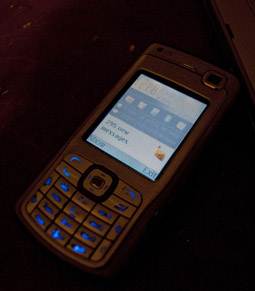
SMS Interactive Music System (S.I.M.S)
photo courtesy the artists
SMS Interactive Music System (S.I.M.S)
Reflecting on the performances (there were also events in Brisbane and Melbourne), Fred Rodrigues stressed that it was most of all an experiment exploring how the more intellectual end of electronic music can engage with the audience, looking for “the equivalent of the sing-along, or lighters held up at concerts.” He was very pleased that, at their best, the concerts became collaborations between performers and audience, and he plans to continue the exploration in future.
But does S.I.M.S make good music? As the nature of ‘play’ preferences the hyperactive and extreme over the subtle, much of the performance was fragmented and scatty, but it was interesting to see that as it progressed the audience usage of effects thinned out and became more considered, allowing an internal structure to take shape. S.I.M.S at this stage doesn’t really make for great music, but it does make for a diverting (and educational) music-based interactive experience. We had fun splashing about even if we never quite caught a wave.
The NOW now series; Aemon Webb, Jack Dibben, Sam Pettigrew; SMS Interactive Music System (S.I.M.S), producer/creative technician Fred Rodrigues, performers Abel Cross, Adrian Klumpes, Kusum Normoyle, Hirofumi Uchino, software engineer Ankur Badhwar, Max/MSP programming Claire Herbert; Serial Space, Sydney, Oct 12
The S.I.M.S software is freely available for download from www.sims-interactive.com. S.I.M.S will be performing at The NOW now 2010, Wentworth Falls, NSW, Jan 22-24, http://thenownow.net
RealTime issue #94 Dec-Jan 2009 pg. 48
© Gail Priest; for permission to reproduce apply to realtime@realtimearts.net
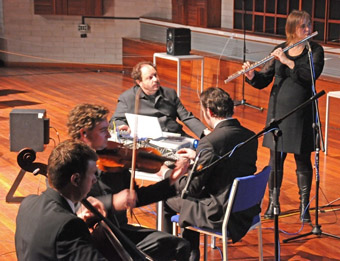
Decibel, Tape It!
photo Ian Henderson
Decibel, Tape It!
I’M SITTING AT A DESK, SYNCHING MY COMPUTER’S CD PLAYBACK INTO A PAIR OF STUDIO REFERENCE SPEAKERS WITH A GLOWING, INDISTINCT IMAGE OF A TV MONITOR PLAYING BACK A SEPARATE DVD OF THE SAME LIVE PERFORMANCE. NEARLY TWO MONTHS AFTER DECIBEL PREMIERED AT PERTH’S TOTALLY HUGE FESTIVAL THIS SEEMS A PERVERSELY APPROPRIATE MANNER IN WHICH TO REVIEW A NEW ENSEMBLE DEVOTED TO EXPLORING MEDIATED MUSICS AND PLAYBACK DEVICES AS INSTRUMENTS. ALVIN LUCIER WOULD BE PROUD (“I’M SITTING IN A ROOM…”).
Decibel is the brainchild of Cat Hope, and the first performance, Tape It!, offered a veritable hit parade of the Perth sound scene: reed-instrumentalist and MAX-patch master Lindsay Vickery, sound designing legend Rob Muir, art-and-rock-crossover cellist Tristan Parr, as well as Malcolm Riddoch, Stuart James and Dan Russell. A diversity of acoustic instruments combined with—or in some instances vied for attention with—assorted electromagnetic and digital sound reproduction technologies (laptops, reel-to-reel tape-players, guitar amplifiers, speakers, portable cassette-players, turntables etc).
The devices and the performers were variously positioned about the auditorium in order to install the works in various ways, and even in the stereo format in which I accessed this performance after the event, the complexity of spatial effects was impressive. Effects of proximity and distance (William Burroughs’ viral radio montages), focussed presence (especially in Mauricio Kagel’s Prima Vista) and ambiguous distance, all enlivened the performance. Broadly, the program tended to shimmer and shift, to grow but rarely arrest or conclude, producing a wonderfully affective series of effects in which musical resolution was alluded to but deliberately avoided.
Hope’s choice of materials, varying from new works of her own and those of Vickery, Warren Burt and Daniel Thorne, through to adaptations of extant pieces by Kagel, Burroughs and Brian Eno, highlighted composers who exploited elements of indeterminacy, collaborative composition, open works and imprecise, impressionist effects. Far from the rigorous precision of post-Serialist composition by the likes of Brian Ferneyhough, Hope’s contention would seem to be that playback devices are best utilised within more rules-based compositions and performative models.
Indeed, several of the pieces featured live projection of graphic or rules-based scores, suggesting an equivalence between this mode of notation and the tape loops employed elsewhere. This was most evident in Althoff’s Front Row, where the looped sounds on cassette are, as the program note explains, intended to act “as a kind of notation”—here scoring a duel of toys and their sounds. Thorne’s contribution was the odd one out in this sense with his tendency to employ urgent string refrains suggesting a quasi-Romantic set of emotional tensions and attempted musical resolutions which other artists eschewed.
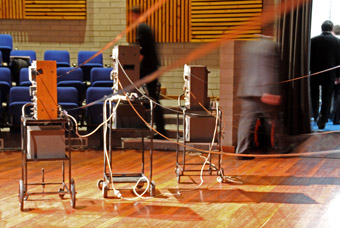
Decibel, Tape It!
photo Ian Henderson
Decibel, Tape It!
Tape It! represented not just an argument in favour of playback machines as instruments—a contentious if not altogether novel concept—but also a coupling of this idea with a specific aesthetic vision of what emerges from the pre-recorded and the acoustic. Hope’s thesis was, in this sense, counter-intuitive but persuasive: that the use of recorded or programmed material produces a greater diversity of only partially predictable outcomes, rather than necessarily supporting closed-off, formal processes of scoring like dots and lines, which have largely tended towards the construction of ever more predetermined outcomes.
Whilst the sonic palette on offer was unambiguously contemporary—the bursts of ringing noise which characterised Decibel’s interpretation of Burroughs, the rapid attacks and micro-gestural acoustic instrumental flourishes of Kagel and Vickery, Hope’s own acoustic drones, the fragmentation of conventional tonality without the imposition of a new over-arching logic such as Schoenberg insisted upon within Serialism, digital glitch, slide and process by Hope, Vickery and Eno, radiophonic sampling by Althoff and Burroughs—the performative logic employed overall by Decibel suggested the present bleeding back into history.
If the much prized staves and points of Western composition from the 18th to mid 20th centuries represented nothing more than an earlier form of “recording” or “playback” technology—the live performer as CD player—then contemporary electromagnetic devices are different from pre-modern ones in character, but not in nature.
In enacting this acoustic, electromechanical cyberneticisation of player and machine, Decibel’s program effected a curious kind of displacement. Despite the spatialisations of Hope, Muir and their collaborators, the sounds seemed strangely unfixed and placeless. Instruments seemed to echo and scratch (notably Kagel), but not sing or voice. There was a kind of materialism to these compositions which simultaneously rendered them as effervescent or impossible to locate metaphorically. Burroughs’ citation of the ever mobile mediascape and Eno’s Music For Airports were paradigmatic here in their articulation of a metaphoric, global or alien non-place.
One cannot and indeed should not reduce Decibel’s multifarious program or explorations to a single effect of what I will here call “aetherisation.” Kagel’s more emphatically theatrical use of the instruments, or Burt’s totally beguiling idea of something which is both ‘noise’ and lulling, suggest a range of processes and moods which are not easily amalgamated under a single affective model or critical paradigm. Decibel is, at least at this point, not about defining or demagogically fixing a unified approach to sound, music, playback and performance. It remains an open project, an exploration.
Nevertheless these trends and arguments over what happened after Serialism, following Cage’s celebration of chance, or what should be occurring in the wake of the rise of electronic composition and noise art as legitimate forms—all of these much debated controversies interact here to produce a number of tensions which Hope’s programming effectively exploits. It was therefore not only musical irresolution which acted as the concert’s dominant motif, but of musical history itself. Indeed, Althoff went so far as to quote the same trains sampled in Pierre Schaeffer’s landmark Étude Aux Chemins De Fer (1948) within his own contribution, driving home the historicist nature of a project such as this.
Hope and her peers (and here I would include Anthony Pateras as striving towards a similar model in his compositions and in his collaborations with Robin Fox) continue to argue that noise art, concrete approaches to sound and to the sample, together with instrumental composition, graphic scores and rules-based ideas, are not incompatible. Whilst there is no doubt that all of these methods productively animated Decibel’s performance, it remains to be seen if they are truly compatible, or should rather be seen as parallel trends which may be employed in conflicted tandem. Just as Cat Hope’s own approach favours the unresolved, so the combination of ideas and processes here might favour an endless, irresolvable dialogue, rather than a new condition of musical interpretation.
Decibel, Tape It!, director, performer Cat Hope, performers, collaborators Lindsay Vickery, Stuart James, Malcolm Riddoch, Rob Muir, Tristan Parr, Dan Russell; West Australian Academy of Performing Arts, Music Auditorium, Totally Huge New Music Festival, Sept 10, http://decibel.waapamusic.com/; http://www.tura.com.au/
RealTime issue #94 Dec-Jan 2009 pg. 49
© Jonathan Marshall; for permission to reproduce apply to realtime@realtimearts.net
IN SPEAK PERCUSSION’S LATEST COLLABORATION WITH FRITZ HAUSER, THE IWAKI AUDITORIUM IS TRANSFORMED FROM ITS USUAL CONCERT SETTING. A SINGLE ROW OF SEATS IS ARRANGED INTO A LARGE SQUARE AND THE LIGHTING RIG IS LOWERED METRES FROM THE FLOOR. TWO PIANOS AND A MULTITUDE OF PERCUSSION INSTRUMENTS ARE SPREAD OUT OVER A VAST PERFORMANCE AREA.
The program opens with Small Talk, a work for solo percussion composed and performed by Hauser. Gradually working his way around a table of small objects, he creates a mesmerising presence. The sounds are often simple, yet the intensity of this piece never wane.
For Speak and Unspoken, the centerpiece of the program, Hauser leaves the stage, but remains distinctly present through his composition and direction of Speak Percussion and special guest, pianist Donna Coleman.
Speak and Unspoken evolved from Coleman’s conceptual image of a pianist surrounded by a sea of percussion instruments. It takes the form of a partly structured improvisation. Opening the work, three percussionists play sparse, contrasting rhythms on woodblocks gradually moving from opposing corners of the room to the piano at its centre. Coleman depresses the piano’s pedal, leaving the sound of the woodblock as sympathetic resonance in its strings.
Following an improvisation passage, the piece enters into a structured section, cued by Hauser off-stage through a changed lighting state, illuminating three timpani. The percussionists play rolls with shifting dynamics, while Coleman plays thunderous clusters.
In the final section, performers play consistent pulses at independent tempi, creating a phasing effect. Percussionists move from sounds with short attacks, to sounds gradually becoming longer in resonance, concluding with resonating federation bells.
These ideas serve as departure points for improvised sections. The performers’ approach to improvisation appears to be in reaction to the sounds happening around them. The resulting sound is a complex blend of textures and klangfarbenmelodie [literally “tone-colour-melody”, where a musical line is distributed between several instruments. Eds]
Hauser’s role as composer not only defines these structures, but also facilitates in preparing an improvised dialogue between the players. This is a bold approach to concert music that challenges the conventional relationship between composer and performers.
The spatial arrangement of the instruments requires the players to blend sounds across the room. Coleman, Matthias Shack-Arnott, Eugene Ughetti and Peter Neville demonstrate great finesse in their musical interaction.
Speak and Unspoken represents an aesthetic interest in the arrangement of sounds in space. This is realised effectively not only in a technical sense, but results in a profound and moving experience. Credit must go to the creative partnership of Hauser and architect Boa Baumann, who oversaw the presentation of this work—space and sound were inextricably linked to delicately crafted and refined music.
Donna Coleman and Speak Percussion, Speak & Unspoken, in collaboration with Fritz Hauser and Boa Baumann, Iwaki Auditorium, ABC Centre, Melbourne, Sept 22, www.speakpercussion.com
RealTime issue #94 Dec-Jan 2009 pg. 50
© Simon Charles; for permission to reproduce apply to realtime@realtimearts.net
I CONFESS TO ATTENDING TO CHURCH ONCE A YEAR, AND BRISBANE’S CANTO CORO IS MY DENOMINATION. FOUNDED BY MUSICAL DIRECTOR MARK DUNBAR AND WITH ITS ROOTS IN BRISBANE’S GREEK AND LATIN AMERICAN COMMUNITIES, CANTO CORO IS A MIXED COMMUNITY CHOIR THAT PRESENTS LARGE CHORAL AND MUSIC THEATRE WORKS WITH THE DISCIPLINE TO TACKLE COMPLEX SCORES AND AN EXTENDED REPERTOIRE THAT TAKES IT BEYOND THE USUAL DEFINITION OF A ‘COMMUNITY’ CHOIR.
In the past Canto Coro have presented such works as Canto General composed by Mikis Theodorakis to poems by Pablo Neruda and Mass by Leonard Bernstein; Little City, 1975: A Love Story, Fatal Shore, Black Cargo by Melbourne-based composer Irene Vela; and Red Cap by Janis Balodis and Ian Grandage.
When many were silent or closeted in despair during the Howard years over the refusal to say sorry, Canto Coro came to the fore. Mark Dunbar, who teaches at the Aboriginal Centre for the Performing Arts in Brisbane, co-devised and composed the music for a trilogy of three dramatic choral works incorporating performers from the Centre: Hornets Wedding (libretto by Indija Mahjoeddin), Anderson & Ipeta, and Damage. These weren’t easy works but, despite the gruesome colonial history depicted or the bleak realities of street life symbolically portrayed by the young students, Canto refused to take a moralising or simply pious stance. Instead in inclusive, challenging and celebratory ways, Canto Coro remained an unambiguous voice for recognising that it is society itself that needs to change.
After what must have seemed such a prolonged time on the barricades, Dunbar indicated a change of pace for Canto’s 15th anniversary, Canto style. Within the moveable feast of the choir were half a dozen fluent German speakers so that Dunbar nursed to life the concept of arranging lyrics by Bertold Brecht and music by Kurt Weill, Hans Eisler and Paul Dessau from a scratchy old cassette of a concert in which he’d played the flute aeons ago in Melbourne. Thus songs of deAth and distrAction/ a post apocalyptic cabaret was born. This was mounted as an independent production during the Queensland Music Festival 2009 and was a runaway word of mouth success.
Dunbar writes in the program that there is often a vicious irony between the sweetness of the melodies and the stark realities of Brecht’s words. Also the songs belong to a rich theatre tradition which choir members interpreted in poor theatre guise by bringing their own costumes. Both elements united disturbingly in the persona of Mark Shortis who looked as if he hadn’t slept in a week, an effect emphasised by thick stubble and the kohl under his eyes which rolled in wicked emphasis as the MC from hell, convincing us that this man was at the very least a dangerous method actor in his brilliantly insinuating bass rendition of “What Keeps Mankind Alive” from The Threepenny Opera.
At the opposite, perverse extreme from the same opera was the inability of soprano Anna Stephanos to disguise herself as anything but the professional rembetika [Greek urban folk music. Ed] torch singer that she is in a version of Pirate Jenny to die for. The beauty of Libby Schmidt’s soprano singing “The Fraternisation Song” from Mother Courage epitomised the searing musical ironies inherent in this music. And so it went on for another 16 acts in different combinations of voices and collective moods…you get the idea. Likewise the Brisbane Canto Coro Band 2009 was a combination of instruments that was sweet Hallelujah.
Canto Coro Inc, Songs of deAth and distrAction; Ellen Taylor Centre, Brisbane, Jul 19-26
RealTime issue #94 Dec-Jan 2009 pg. 50
© Douglas Leonard; for permission to reproduce apply to realtime@realtimearts.net
YOU HEAR IT SAID THAT WE HAVE BECOME ‘TIME-POOR’; HYSTERICAL URGENCY IS UPON US LEST TIME SHOULD LEAVE US BEHIND. A TEMPORAL GRID, BINDING US TO THE MACHINES THAT KEEP TIME, SEEMS TO CONTRACT OR DIVIDE WITHIN ITSELF, CREATING EVER-SMALLER INCREMENTS INTO WHICH OUR ACTIONS MUST BE SQUEEZED. WE ARE PROPELLED BY OUR CHOSEN FORMS OF COMMUNICATION; COMPELLED BY THEIR CRUEL ECONOMY. TIME POVERTY IS SYMPTOMATIC OF AN ANXIETY FORMED BY THE INTERCHANGE BETWEEN THE CONSTANCY OF MATHEMATICAL TIME AND THE TURBULENCE OF SUBJECTIVE TIME, OR RATHER, IN THE DESIRE TO SYNTHESISE THE TWO.
To graft general, spatialised time onto subjective time is to forget that time is learnt; we are subjected to rationalised time but have a fundamentally asymmetrical relationship to it. Time takes time. After all, there was a time at the beginning for all of us when we didn’t know time. It is subject to our erratic unfolding consciousness, constantly oscillating with forgotten unconscious imperatives.
That universal mathematical time is a fantasy embodied in the movie camera underlies the formal concerns of Derek Hart’s video art. Reductive, looped, narrative structures—the synthetic thread between here and there; to and from; back and forth—are matched by the artist’s theoretical concerns with the back and forth between the screen and the spectator.
Hart acquired his training in the UK, receiving an MA in Fine Art from Chelsea College of Art in 2000. His admiration for the traditions of experimental film and video began when he was an undergraduate student of Time-Based Media at the Kent Institute of Art and Design. During the last five years he has exhibited both in Tasmania and nationally and has extended his practice to include site specific installation and curating. Currently undertaking an Australia Council, Inter-Art Connections Residency, hosted by Hydro Tasmania, Hart is in the process of making a number of works that document water flow in the state’s rivers, lakes and catchment areas. They will combine elemental time with the temporal tracking of two machines—the camera and an Acoustic Doppler Current Profiler (ADCP), used by Hydro Tasmania to collect hydrology data.
This alignment of technologies with a ‘found’ source of temporal flow is perfectly suited to Hart’s structural affinities and also discloses film’s scientific roots. He sets up a dialogue with hydrology, mimicking its research methodologies, which are designed to monitor environmental impact and water flow. Here the camera betrays its complicity as an homogenising apparatus filtering particular data requirements. Hart seems to be making reference to the belief, prevalent in mid-20th century film theory, that the camera is of itself irretrievably ideologically bound to a repressive Enlightenment past. Certainly, in a project that merges dispassionate mechanical and natural temporal flow, the connection is there. In fact, Hart’s interest in experimental filmmaking is made evident in all his work through his attempts to highlight the ambiguities of temporal synchronicity and repetition.
The ADCP is a sophisticated sonar machine that crosses waterways collecting readings of underwater topography and water velocity. The concept of sonar producing images through a cyclical emission and reception of sound waves parallels Hart’s formal and technical interests. His residency projects are in their early stages but he intends to attach cameras to the ADCP machine, augmenting its sensory range. Setting it off down rivers and around lakes, becoming the ADCP with a movie camera, à la Dziga Vertov.
The rhythmic pulsations of the sonar are not just a useful metaphor in describing Hart’s formal approach; they also illustrate a fundamental principle concerning our basic scientific relation to reality. The origins of physics have been thought to stem from observation, over centuries, of the cyclical return of the stars to the same place. Reality, then, is the rhythmic return of an object. In psychoanalytic terms the continual regaining of the object is a desire that is set in motion due to a primal lost object. As Lacan writes, “[r]eality faces man—and that is what interests him in it—both as having already been structured and as being that which presents itself in his experience as something that always returns to the same place” (The Ethics of Psychoanalysis). Hart’s consistent use of variations of the looped video creates an intriguing affinity with these ideas.
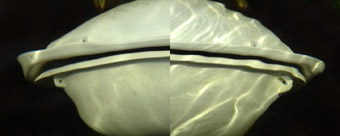
Bivalve (2008), Derek Hart
courtesy the artist
Bivalve (2008), Derek Hart
The pace of water flow lends itself to Hart’s filmic sensibility and it appears in a number of earlier works. Bivalve (2008) is a two-channel video installation work that suggests an aquarium-like point of view. The image is split centrally, one side running forwards the other backwards with no sound. The surreal ‘object’ (formed in your imagination in combining the two quasi-symmetrical sides) resembles a white clam or whale-like mouth. Smouldering (2008) is a related piece made in the same year and contains a part of the same white, lipped object in water. Slightly protruding from the surface of the water flow (that has been slowed down) the ‘lips’ take on an eerie eroticism.
Much has been written of the narcissistic identification that occurs watching film at the cinema; the hypnotic diegetic glue that you give yourself up to. Narrative identification is brought to the works by default but the way Hart utilises the loop stifles it; generally the editing is invisible and the point of view static. Gestures and movements that can fold in on themselves (be edited backwards and forwards seamlessly) are central elements around which the cyclical form of these works revolves.
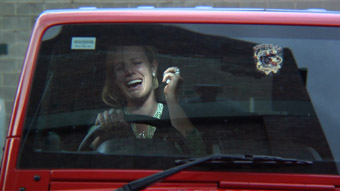
Sound Blocks Pain (2008) written & produced by Yvette Blackwood and directed by LX McGee
Derek Hart’s most recent work, from his solo exhibition Film Stills at The Long Gallery, Salamanca Arts Centre in 2009, relates to much earlier video works that appropriated small segments of repetitive gestures from the films of Jim Jarmusch. The four videos for the Long Gallery exhibition are looped fragments from the works of three Tasmanian filmmakers, Yvette Blackwood, Catherine Pettman and Roger Scholes, who gave Hart permission to use their films.
These videos are more complex, formally and psychologically, than his earlier appropriation works, combining apparent and hidden temporalities. In Eclipse, a black screen lightens to reveal an emotionally distraught woman seen through the windscreen of a car. She is shaking the fist of her left hand with varying intensity. At the height of her grief and anger she is clearly screaming (although the film is silent) and her whole body shakes, the image fading to black again only to return to the start as if merely a shadow had passed briefly over her eternal misery. This work takes the form of a palindrome and actually begins at the end of the original film running backwards; it then runs forwards and so on. However, from the viewer’s temporal perspective the symmetry is false; the film can only ever run forwards.
Disruption of symmetry is also disclosed in a more complex way in Sitting Room. Two women and a man are sitting in a lounge room; a tense surly atmosphere is suggested through their silent, nervous mannerisms. Repetitive gestures of leg swinging, eating and drumming a wine glass are basically all they do, as if unconsciously revealing something through body language. This repeated short segment appears just as it would in the original but in order for the artist to maintain the looped suspension he has divided the screen three ways, one segment for each person. They share a diegetic space but are in fact living in three entirely different time zones, backwards and forwards independently; diegetic time becomes a mise en abyme, an interlacing of multiple quasi-narratives. The filmic object is sutured but when a bottle moves toward the hand of the man the spell is broken.
Philip Watkins is a contemporary arts writer and curator. He writes for various national journals and is currently Exhibition Coordinator for the Hobart City Council’s Carnegie Gallery.
Video excerpt, Sitting Room (2009) Derek Hart.
RealTime issue #94 Dec-Jan 2009 pg. 51
© Philip Watkins; for permission to reproduce apply to realtime@realtimearts.net
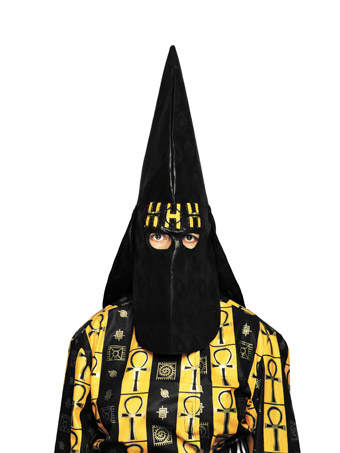
HHH #2 2004, Fiona Foley, image courtesy the artist, Andrew Baker Art Dealer, Brisbane and Niagara Galleries, Melbourne
© the artist, photo Dennis Cowley
HHH #2 2004, Fiona Foley, image courtesy the artist, Andrew Baker Art Dealer, Brisbane and Niagara Galleries, Melbourne
A 25-YEAR RETROSPECTIVE OF FIONA FOLEY’S WORK IS CURRENTLY SHOWING AT SYDNEY’S MCA. WHO IS THE REAL FIONA FOLEY? SHE ONCE SCOFFED WHEN I SUGGESTED SHE CREATE A PERFORMANCE PIECE DRESSED AS A BONNETED ELIZA FRASER OF FRASER ISLAND FAME. FOLEY HAS APPEARED IN MANY GUISES: A DEFIANT, SEMI-NUDE BADTJALA WOMAN IN NATIVE BLOOD (1994) AND BADTJALA WOMAN (1995); IN COSTUME AS A SEMINOLE INDIAN MAIDEN (WILD TIMES CALL, 2001); A MASKED AFRICAN-AMERICAN REVERSE KU KLUX KLANNER (HHH—HEDONISTIC HONKY HATERS, 2004).
Foley was present only symbolically in earlier works: her hair clippings in Lost Badtjalas (1991) and in the red chilli and charcoal floor installation Black Velvet II in Meridian at the MCA in 2002. She is visible only as her ‘spoor’— a predator lurking—in the photographic sets Venus and Sea of Love (2007) and more recently as a burkah-clad Islamic Australian woman in Nulla 4 eva (2008). “Nulla”, I’m told, is the local colloquial name for the Sydney suburb of Cronulla. “If you are an ‘other’, can you then be any and all ‘others’? With all the dress-ups, is it just a fashion shoot?”, I once asked. “I don’t think so!”, flew the reply. Paris is Burning perhaps?
roles & masks
Notably Fiona Foley is not alone in this fascinating ‘role-playing’ that has formed a special part of her work. A number of Aboriginal artists have adopted various guises/forms in their work, some blatantly—Tracey Moffat, and later Darren Siwes and Christian Thompson. Others have played with pseudonyms of a kind—Gordon Bennett as John Citizen and, soon after, Richard Bell as Richie—or used masked people as Tony Albert does in No Place (2009). Ego, parody, comedy, wit, shyness or shame?
At the memorial service in 2007 for acclaimed Aboriginal actress Justine Saunders at Sydney Opera House, her partner mulled over his feelings that despite her success in many roles, colonial history and racism within Australia forced Justine from early in her life to carry a deep hurt, a wound, “hidden inside, to question her own self-worth”, he said. This burden scars how many Aboriginal people?
Feminist discussions of the body usually propose a liberating confessional self-representation while post-colonial histories often began with autobiographical telling and imagery. Though cathartic this approach can also fail, clumsily reducing the personal to just another form of stereotype.
speaking through objects
Fiona Foley’s inclusion of herself in her work appears early in her career though in a quite different way, almost ritualistic and honorific. Majoring in sculpture at art school, she took to installation of objects or series of related images around certain concepts. More often than not she was invisible, speaking through objects and other people in her image series. Of late, she has laid out her ideas in constructed sets of photographs accompanied by auxiliary objects. In 2001, the floor of the Tampa Florida Gallery was covered with 30cm deep golden, ripe corn that visitors had to struggle through to view the soft sepia images of Wild Times Call. In her 2004 series, HHH, colourful costumes, like a set of eyeless ghosts, stare out in contrast to the simmering, hateful gaze in the HHH photo series next to which they hang. In Black Opium (2006), a set of traditional Australian Chinese opium pipes accompanies the painting series, and in the MCA show Foley adds her evocative short film, Bliss (2008).
The seven images comprising the recent Nulla 4 eva series (2008) portray a truly multicultural nation. Several social issue sites are visited including the little remembered but historically significant 19th century Chinese opium house meeting place and a playful, if reserved, youthful, contemporary ‘Cronulla’ beach scene. Aboriginal and non-white youths pose slightly self-consciously on the beach—the boys semi-naked, the girls ‘coiffured’ and wearing a variety of outfits that reflect a range of cultural backgrounds. Here, all are ‘wrapped up’ and yet appear perfectly comfortable in assemblage and setting.
an unofficial historian
There is more than one history, even though white, western history dominates. In Australia there is a lack of national in-depth engagement with this history except for our narrow, official, paper-thin view. The ‘history wars’ debate has been intense and highly political over the last decade and still smoulders. Meanwhile, Fiona Foley has taken on the role of a kind of unofficial historian. Nobody has asked for or authorised this role but the history she explores is in fact our common national history, from both sides of the racial divide. Beyond its strong visual appeal, it’s really in this context that I believe her art should be read.
One of the first laws enacted concerning Aboriginal people in Queensland was The Protection of Aboriginals and the Restriction of the Sale of Opium Act (1897). Foley’s Opium—Shackled and Bliss (2008) both talk of the place of Chinese Australians and their relationship with both black and white Australia. Historically this active and visible engagement has been only lightly recorded.
More recently, the Cronulla ‘incident’ was one of contestation, historically as well as physically: contestation of the site—the beach as an Australian social interactive space, for many a ‘sacred’ place. Aboriginal people were never asked for comment about the incident—white Australians simply claimed the site (to keep an escape route open perhaps?). There was no reference to Aboriginal history even though many Sydney coastal and harbour beaches carry Aboriginal names—Akuna Bay, Barrenjoey, Bilgola, Bondi, Coogee, Curl Curl, Dee Why, Elanora, to name just a few.
Successive waves of migrants have washed up on our shores—each challenged as they arrived by the previous wave, each vilified and to an extent subsumed and then dismissed. They are all strangers to us Aboriginal people. Who owns the beach? Aboriginal people, if anyone.
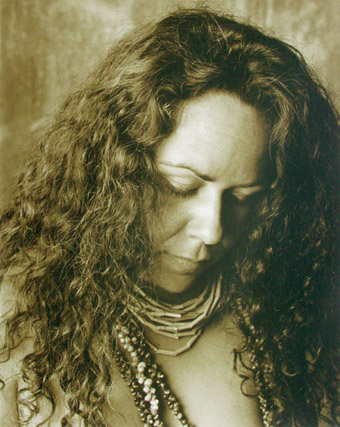
Native Blood 1994, Fiona Foley, image courtesy the artist, Andrew Baker Art Dealer, Brisbane and Niagara Galleries, Melbourne
© the artist
Native Blood 1994, Fiona Foley, image courtesy the artist, Andrew Baker Art Dealer, Brisbane and Niagara Galleries, Melbourne
the artist as auditor
Fraser Island is often called the world’s largest ‘sand island.’ To know your country means to watch each small, warm movement, to see movement when there seems no movement, to recognise the residual shadow of each being present and passing.
Fiona Foley has spent long periods of time engaged in auditing Fraser Island in several series of single sign drawings of flowers blooming, skulls, footprints, seed pods, fish bones, nautilus shells, middens, tide lines of leaves, birds, feathers, dingos, flotsam and jetsam. In 2006 she left her own marks in Signpost 1 and 11.
Song-lines—creation begins with the sunrise and a spirit being who crosses the land seeing, hearing, naming and animating the environment. The late 1980s found Fiona Foley working in Maningrida and Ramingining in Arnhem Land where she spent time with local artists Jack Wununwun and John Bulun Bulun. They had both completed single subject song-lines in arrays of bark paintings.
Mukarr’s real purpose was to name all living things.
Jack Wununwun, 1988
The paintings went into the Robert Holmes à Court collection and Wununwun’s were soon part of the important Magiciens de la Terre exhibition at the Pompidou in Paris (1989).
none so blind…
The fellow traveller of invisibility could be that of selective blindness. A contemporary Australian artist accused me (and, to a similar degree, Fiona Foley) of being a ‘traditionalist’; how could one express a sense of the spiritual that one has lost or had driven out of you, apparently never to return, they asked.
Aboriginal art has been used as evidence in land claims and Native Title claims across Australia. The closing scene of Warwick Thornton’s poignant Aboriginal romance Samson and Delilah is set where the couple, though battered, return to country, to ‘heaven’ and happiness. Many contemporary western artists flavour their art and construct their thinking around western mythical cultural sites—Paris, New York, Madrid, Venice and so on. Aboriginal relationships to land and site are ‘same but different.’ Fiona Foley is special, being born, living and practising ‘on country.’
making visible: claiming country
Fiona Foley was born in 1964 in Maryborough Hospital where Destiny Deacon arrived in 1957. Foley is one of the few artists of eastern Australia that I know who is intimately and intensely pursuing a Native Title claim with her family for their traditional land on Fraser Island. It’s an enormous personal commitment and intellectual process that has occupied at least a decade of her life. With all its complications around the personal and social, these intra-family issues are challenging enough. The unconcealed ambition and bitterness uncovered make the inherently complex western legal and political processes appear trivial in comparison.
You didn’t come out of a hollow log
My mother taught me
You came from me.
Shirley Foley to Fiona
Fiona Foley began this journey with her mother Shirley, now deceased, who was born in a little humpy on the water’s edge on the mouth of the Mary River where it enters Harvey Bay opposite Fraser Island. Foley installed the sculpture commission Tribute to A’vange (Mother) in the grounds of Parliament House in Canberra (2001). From this strong relationship emerges a person of considerable intellect with a determination never to be patronised, belittled or ignored. She possesses a strong sense of duty to Aboriginal history and an empathy with those unprotected or disempowered. These ideas and her social commitment are constant and essential elements in the art practice of Fiona Foley, a practice that is neither cynical, defeated nor shallow, that allows the widest imagination in spaces of object, image and personality.
seeing black
White is apparently the combination of all colours in physics and black the absence of colour. When the British came to Australia in the late 1700s it appeared to be a world if not upside down, then definitely back to front. Furred animals laid eggs and swans were not white but black. It was an environment that demanded acute observation to see the unbelievable—the platypus took some time to be ‘discovered.’ The Oenpelli Python wasn’t ‘discovered’ until the 1970s despite it being one of the largest, if not the largest reptile in Australia.
Every mother crow thinks her crow is the blackest
My mother told me
Well I am the blackest!
Fiona Foley
Part of this article originally appeared in Djon Mundine’s catalogue essay “Invisible Women—Invisible People” for the Fiona Foley show at Melbourne’s Niagara Galleries, March 31-April 24, featuring the Opium and Nulla 4 eva series.
Works referred to in this article appear in the retrospective, Fiona Foley: Forbidden, presented by UQ Art Museum and MCA, Sydney, Nov 12, 2009-Jan 31, 2010
RealTime issue #94 Dec-Jan 2009 pg. 52
© Djon Mundine; for permission to reproduce apply to realtime@realtimearts.net
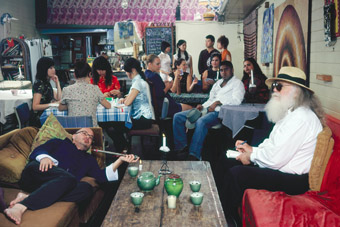
Nulla 4 eva II, 2009, Fiona Foley; image courtesy the artist, Andrew Baker Art Dealer, Brisbane and Niagara Galleries, Melbourne
© the artist, photo Carl Warner
Nulla 4 eva II, 2009, Fiona Foley; image courtesy the artist, Andrew Baker Art Dealer, Brisbane and Niagara Galleries, Melbourne
WALKING THROUGH FIONA FOLEY’S EXHIBITION, FORBIDDEN, WHAT STRIKES YOU FIRST IS THE VARIETY OF FORMATS AND PERSPECTIVES EMPLOYED BY THIS ARTIST THROUGHOUT HER CAREER. THIS EXHIBITION COVERING THE PERIOD 1994-2009 INCLUDES ETCHINGS, SCULPTURE, INSTALLATION, FILM AND PHOTOGRAPHY. A PUBLIC CONVERSATION WITH ALISON KUBLER IN THE WEEK OF THE EXHIBITION’S OPENING ALSO REVEALS THAT MANY OF FOLEY’S MAJOR WORKS ARE PUBLIC AND PRIVATE COMMISSIONS NOT TO BE FOUND IN SURVEYS SUCH AS THIS ONE. A BUSY ARTIST AND TEACHER, FOLEY ALSO HAS A STRONG INTERNATIONAL PROFILE. LOOKING AROUND, YOU’RE AWARE THAT HER FIRST MAJOR SURVEY EXHIBITION REPRESENTS JUST A SMALL PART OF WHAT IS A LARGE AND IMPORTANT BODY OF WORK.
In her photographs Foley switches genre with ease. In Native Born (1994) she reclines in the formal pose of a found image of a Badtjala Woman in grass skirt and beads, adding her own touches in the form of black tights and platform soles. In Wild Times Call (2001) she is pictured in the Bayou Country of southern Florida wearing American-Indian skirt and blouse, the sepia tone of the framed images suggesting documentation of time past, the final group shot situating her among colleagues and clearly in the present. The HHH (Hedonistic Honky Haters; 2004) series comprises eight large format ‘mock’ portraits of African-Americans wearing richly patterned garments the style of which is otherwise copied from those of the KKK. Among the serious gazes ‘burning holes’ in the fabric is Foley’s own. In her most recent photographic project, Nulla 4 eva (2009), she stages scenarios featuring a range of non-white participants in iconic settings—milk bar, beach and a cafe-cum-opium den. In the playfully combative beach scene, Foley dons a full burkah.
There are installations—a thick carpet of corn kernels in Wild Times Call (2001) and the ornate African-print robes worn by the subjects that hang beside the HHH photographs. In Land Deal (1995), familiar elements from colonial history return to haunt us. Flour spirals powerfully across the floor while tomahawks, knives, scissors and looking glasses (objects once exchanged for Aboriginal land) cling tightly to the walls. Blankets speak boldly of Aboriginal women defiled and discarded (Stud Gins 2003). Intersecting the room, the word Dispersed, once used euphemistically to refer to what were in reality acts of murder and forced displacement by colonial governments, asserts itself in 52 centimetre high, heavy metal letters, the D embedded with .303 calibre bullets (Dispersed, 2008).
Amidst the variety of media in the exhibition is a recurring image of opium poppies. They appear in a line of delicate etchings and, in a commissioned work (documented in the accompanying monograph), hanging in an infinity-shaped metal mass (Black Opium, 777 cast aluminium poppies, State Library of Queensland, 2006). There’s a further reference in the Nulla 4 eva photographs in which a multi-racial congregation is casually arranged in a cafe or club, playing cards and mahjong. In the foreground, a young man of possibly Chinese ancestry smokes an opium pipe.
The flowers appear poignantly in Foley’s film, BLISS (2008), which screens in a room of its own. A vast field of pale lilac poppies shifts in the breeze. Inscribed at intervals across these alluring images is a story of exploitation—Aboriginal people paid for their labour in opium ash, a practice officially sanctioned until 1897 when a “Protection” law was instituted that had even more dire effects. A woman next to me is taking notes. “Did you know about this?” she asks.
Conversing with Kubler, Fiona Foley states her pre-requisites for her work: that it is “understated, has aesthetic beauty and packs a punch.” She is, she admits, “an artist by stealth.”
“I want to reach out, pull you in”, she says. “I’m desperate for dialogue. Nothing’s coming back. It’s because people in this country don’t know their own history. Why?” She believes in portraying history as it really is admitting that she too came from a place of not knowing. As a child she asked her mother why there were no Badtjala people left on Fraser Island.
“Did you find out?” asks someone in the audience. “It happens slowly”, Foley answers and quietly lists the iniquities that have threatened to destroy the precious indigenous knowledge held by the first people of this land—venereal disease, punitive state-based violence, starvation, Christianity distorting local custom and ritual, opium addiction, kidnapping… “There’s an immense sense of loss in this country”, she says. “We’re all deeply scarred because of that loss.”
Fiona Foley is an artist of deep political conviction who manifests the depth of her knowledge and commitment in elegant iconic works of art. In person she is also light-hearted and optimistic in spirit. Her works are intriguing but insistent. Ideas recur and transform: the same shapes materialise in dilly bags and in sand sculptures; the same words transposed from blanket to stone; the same images form delicately on paper and forcefully in cast aluminium—insistent reminders of unfinished business. Foley’s work is never obvious. She creates seductive and provocative images that worry at us, like the evidence of truths that are staring us in the face.
Fiona Foley: Forbidden, Museum of Contemporary Art and University of Queensland Art Museum, curators Michele Helmrich, Christine Morrow, Rachel Kent, MCA, Sydney, Nov 12, 2009-Jan 31, 2010. A handsome, large format catalogue on Foley’s career is also available.
RealTime issue #94 Dec-Jan 2009 pg. 53
© Virginia Baxter; for permission to reproduce apply to realtime@realtimearts.net
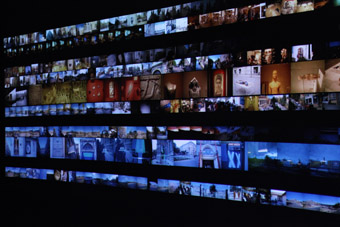
installation view of Brad Miller, augment_me
photo Brad Miller
installation view of Brad Miller, augment_me
HARDER, BETTER, FASTER, STRONGER. NOT UNLIKE THE SOUPED-UP CHARACTERS OF A DAFT PUNK FILM CLIP, EVERYDAY WE ENHANCE OURSELVES WITH AN EVER-INCREASING PROFUSION OF APPENDAGES, FROM SIMPLE ACCESSORIES LIKE SUNGLASSES AND RUNNING SHOES TO THE HIGH-TECH ‘ADD ONS’ OF MP3 PLAYERS, MOBILE PHONES, DIGITAL CAMERAS, THE LIST GOES ON.
Just how this stream of augmenting items might be impacting our sense of identity is explored in new media artist Brad Miller’s video installation augment_me, one of three shows presented at Artspace in Sydney. While not formally connected in any way, Miller’s project and the work of fellow exhibitors James Charlton and Simon Barney do chart some similar territory. In particular, their projects reveal, to varying extents, a common interest in the challenges, and possibilities, that the blurring of the natural and artificial pose to how we experience, perceive and recall the world around us.
A relatively simple set up, augment_me consists of a large video screen that spans the width of a single wall in a darkened room enlivened by an evocative soundscape of rumbling noise composed by Sydney artist Ian Andrews. Running along the screen is a stack of parallel horizontal strips resembling film reels that move in opposite directions and at different speeds presenting a plethora of images in a seemingly endless and apparently self-generating stream. The images have been accumulated by the artist over several years. Some depict obvious augmenting objects like bicycles, laptops, a backpack, an umbrella, yet these are submerged in a substantial amount that appear quite random or only loosely connected to the idea of augmentation, such as snapshots of landscapes, beaches, swimming pools and the like.
The content of the images, however, appears to be of less significance than the relationship between them which is in fact not random but stipulated by a software program specifically developed to re-order the sequence of images in response to audience movement in the room. It is this re-modelled relationship, then, between the viewer, screen and images that appears central to the work and points also to a deeper concern to do with exploring how the viewing experience itself might be enhanced or ‘augmented’ in an interactive cinematic environment.
This tension over whether meaning ultimately resides in how the work is made or in the final aesthetic presentation is common to much new media work and not easily resolved. In the case of Miller’s installation, the diaristic nature and loose relationship of many of the images to the theme does present a challenge to interpretation, however, the more personal and abstract treatment is rewarded by an open approach to viewing. As much as the software’s re-ordering of the images has a destabilizing effect, it also gives way to an appreciation of the poetry in the televisual medium’s capacity to activate memories while simultaneously charting the insatiable, and sometimes disorienting, currents of consumer desire.
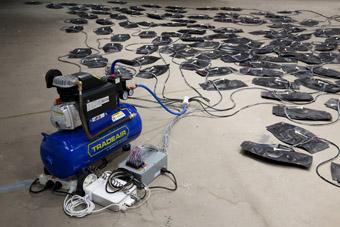
installation view of James Charlton, TradeAir, Artspace, Sydney, 2009
photos Silversalt
installation view of James Charlton, TradeAir, Artspace, Sydney, 2009
At the other end of the gallery, walking into the space of New Zealand-based artist James Charlton’s TradeAir, the first thing that strikes you is the smell. The scent of rubber wafts from a sea of recycled truck inner tubes that litter the floor, a subtle clue that this is indeed a sensual installation although not in the ways one might expect.
This mass of black tubes is in fact connected in a network and hooked up to a series of industrial air compressors which inflate the empty tubes when activated by a visitor blowing into one of a number of small fan devices suspended from the gallery ceiling. Beyond the initial thrill of seeing the tubes instantly inflate, the action gains greater resonance upon realising the air capacity of each tube is roughly equivalent to that of your average human lung. Indeed, the black rubber tubes are slightly bladder like in appearance, adding a more macabre dimension to the installation; have these organs been spilled in some kind of crash? Are they awaiting human breath to resuscitate them?
At the same time, TradeAir can of course also be considered in an environmental context. Climate change in particular is now discussed in a discourse of exchange, as polluted air in one part of the world is ‘offset’ by the planting of trees in another, distant place. This telematic dimension to the work is deepened by the fact the artist has installed himself remotely in his studio in Auckland where he receives alerts when a visitor activates a fan to which he can respond by inflating a tube in the gallery at the touch of a button from his remote set-up.
The result is a work that is effective both sculpturally and conceptually. It appears continuous in some ways with earlier investigations like the American artist Ken Goldberg’s robotic Internet installation The Telegarden (1996-2004), but with a harder, more industrial edge. Constructed around a series of technical constraints, Trade Air resembles a post-apocalyptic medical experiment conducted Mad Max style, in a manner neither clinical nor sterile but instead powered by the juices of dirty machinery and the exhalations of one of the most potent polluters on the planet, human beings.
Finally, in the front room of the gallery one finds Sydney artist Simon Barney’s series of unconventional landscape paintings, The Known World. In contrast to the Miller and Charlton installations, which produce a certain kind of sensory overload when viewed in succession, this series demands patient study on the part of the viewer.
Each painting is titled North Road and is rendered in a similar palette dominated by browns and grey-greens that strip the bush-scapes of any nascent romanticism, granting them instead a sense of overall ‘sameness’. But within this cohesive whole, the composition of each painting in fact shows considerable variation particularly in the density of the scrub portrayed—in some it appears thick and impenetrable while others depict a path, or the beginning of a path, cleared through them. This metaphor of path clearing also stands in for the nature of the artist’s investigation into painting. Critical to this exploration is Barney’s use of a silver background that “borrowed from modernism and thereby, supposedly antithetical to landscape tradition, provides the new terrain”, the exhibition statement points out.
The experimental paintings of The Known World, then, occupy a unique place among these three Artspace projects. Not bound by any unifying theme or medium, taken together the three shows reveal just how far contemporary art is diversifying in the variety of subjectivity-engendering experiences it offers to viewers. From an interactive video seeking mental communion between viewer and screen and a telematic art experiment conflating time and space to new ways of seeing ‘into’ the painted canvas, if these projects are any indication of things to come then the future, it appears, increasingly points toward a giant head trip.
Brad Miller, augment_me; Simon Barney, The Known World; James Charlton, TradeAir; Artspace, Sydney, Nov 20-Dec 20; http://www.staff.cofa.unsw.edu.au/~bradmiller
RealTime issue #94 Dec-Jan 2009 pg. 54
© Ella Mudie; for permission to reproduce apply to realtime@realtimearts.net
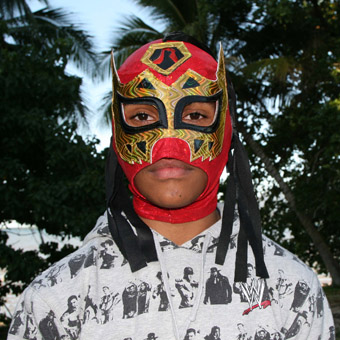
Tony Albert, No Place (4), 2009, type-C photograph, image courtesy the artist and Jan Manton Art, Brisbane and Gallerysmith, Melbourne; from Putsch at Tandanya National Aboriginal Cultural Institute, Adelaide Festival of Arts
AS EVER THE VISUAL ARTS PROGRAM IS AN IMPORTANT PART OF THE ADELAIDE FESTIVAL. BUT FOR THE FIRST TIME THERE’S AN AN AMBITIOUS, CURATED PROGRAM TITLED ADELAIDE INTERNATIONAL AS WELL AS THE WELL-ESTABLISHED BIENNIAL OF AUSTRALIAN ART. IN THE SYDNEY FESTIVAL THE FOCUS IS ON LEADING CONTEMPORARY MEDIA ARTISTS, LYNETTE WALLWORTH (AUSTRALIA) AND OLAFUR ELIASSON (ICELAND/FINLAND) AND A NEW THREE-YEAR PROGRAM THAT CONNECTS THE CITY AND ITS COMMUNITIES WITH THE ASIA-PACIFIC REGION.
adelaide
The first Adelaide International, titled Apart, we are together, is curated by Victoria Lynn, bringing together the Anne & Gordon Samstag Museum of Art, Australian Experimental Art Foundation, Contemporary Art Centre of SA, Flinders University City Gallery and JamFactory Contemporary Craft and Design. Exploring the festival’s ‘heart’ theme (see page 13), the exhibition will ask, “What does it take to survive, to keep the heart going? What forms of resistance and resilience are at work?” The art will embrace “a spirit of inclusion and hospitality, as well as a celebration of difference…that in being ‘apart’, we can also be ‘together’.”
Apart, we are together will show the work of 11 international artists in a rich cross-cultural mix, including an important Thai filmmaker, Apichatpong Weerasethakul (Tropical Malady, Blissfully Yours, Syndromes and a Century). The other participating artists are Rossella Biscotti (Italy), Julian Hooper (NZ), Nina Fischer/Maroan El Sani (Germany), Iman Issa (Egypt), Donghee Koo (Republic of Korea), Li Mu (China), Raeda Saadeh (Palestine), Apichatpong Weerasethakul (Thailand), Lucy Orta (UK), Jorge Orta (Argentina), Tara Donovan (USA) and Praneet Soi (India/Netherlands).
The Art Gallery of South Australia will present the 2010 Adelaide Biennial of Australian Art: Before & After Science, curated by Charlotte Day and Sarah Tutton, featuring the work of 22 artists and groups, with strong Indigenous representation and many of the works making their first appearance. Day says, “The works will all respond to the resurgence of mythology, spirituality and mysticism across political and social spectrums of this global society.”
In the third component of the Adelaide Festival visual arts program, Tandanya National Aboriginal Cultural Institute is presenting Putsch by Brisbane-based proppaNOW. The collective of artist innovators and activists will show large-scale works ranging from painting to installation, printmaking, sculpture and video. As Putsch, the artists Richard Bell, Vernon Ah Kee, Tony Albert, Bianca Beetson, Andrea Fisher, Jennifer Herd, Gordon Hookey and Laurie Nilsen have a clear agenda, to defy white expectations of Aboriginal art and to eliminate self-censorship.
The fourth component of the festival’s visual arts program is, of course, Artists’ Week, wisely re-located to the UniSA’s Hawke Building (the home of the Anne & Gordon Samstag Museum) and focused on art and politics (Gerald Raunig), contemporary studio practice (Lucy Orta), “peer to peer urbanism” (Geert Lovink) and “The Edge of Reason” (Michael Taussig)
sydney
In the Sydney Festival, Australian media artist Lynette Wallworth, who had a well-received major show at Adelaide’s Anne & Gordon Samstag Museum during the 2009 Adelaide Film Festival, will be represented at CarriageWorks by three works—Invisible by Night, Evolution of Fearlessness and Duality of Light—now functioning together as a single installation. Wallworth challenges our visual and spatial perceptions in order that we re-consider ethical perspectives. Olafur Eliasson (Denmark/Iceland), in one of the festival centrepieces at the MCA, likewise plays with our perceptions, including our relationship with nature, the artist drawing on his connections with the landscape of Iceland. Titled Take Your Time, the show includes sculpture, photography and immersive, large-scale installations from collections around the world in a show from the San Francisco Museum of Modern Art.
the edge of elsewhere
In an exciting development with regional ramifications, Campbelltown Arts Centre, Gallery 4A and the Sydney Festival are combining to present Edge of Elsewhere, an Asia-Pacific art project spanning three years. The aim is to “bring together some of the most exciting contemporary artists from across Australia, Asia and the Pacific to develop new artworks in partnership with Sydney communities.”
The 2010 selection of artists?is a strong one: Brook Andrew (Australia),?Arahmaiani (Indonesia),?Richard Bell (Australia),?YOUNG-HAE CHANG HEAVY INDUSTRIES (Korea),?Dacchi Dang (Australia),?Newell Harry (Australia),?Shigeyuki Kihara (Aotearoa New Zealand),?Jun Nguyen-Hatsushiba (Vietnam),?Lisa Reihana (Aotearoa New Zealand),?Khaled Sabsabi (Australia) and?Wang Jianwei (China).
Lisa Havilah, director of the Campbelltown Arts Centre, and co-curator with Aaron Seeto and Thomas Berghuis of Edge of Elsewhere, tells RealTime that some projects have already begun. Shigeyuki Kihara worked with Indian and Samoan communities in Minto on a performance in August this year and is involved in an ongoing collaboration with local Aboriginal people and the Campbelltown Pipe and Drums band. In January she will commence work on a project in Chinatown. Lisa Reihana will collaborate next month with a Minto Women’s Tapa group (tapa is a Samoan beaten bark cloth). Edge of Elsewhere is not simply about hosting visiting artists, but is a direct response to the cultural diversity of Sydney itself through regional collaborations. Havilah says that the first exhibition will comprise outcomes from current commissions and extant works by participating artists.
For dates and venues: Adelaide Festival, Feb 26-March 14, www.adelaidefestival.com.au; Sydney Festival 2010, Jan 9-30 www.sydneyfestival.org.au
RealTime issue #94 Dec-Jan 2009 pg. 55
© RealTime ; for permission to reproduce apply to realtime@realtimearts.net
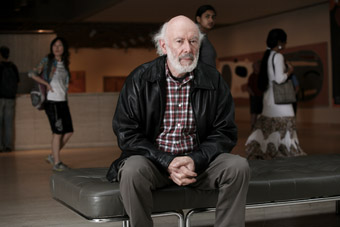
Nick Waterlow
photo Olivia Martin McGuire
Nick Waterlow
nick waterlow
We were shocked and saddened to hear of the death of Nick Waterlow on November 9. He was Director of the Ivan Dougherty Gallery at Sydney’s College of Fine Arts since 1991, a curator of three significant Sydney Biennales (1979, 1986 and 1988), was a senior lecturer in COFA’s School of Art History and Art Education and had been honoured with an OAM. He was also Director of the Visual Arts Board at the Australia Council 1980-83. Before his death, Nick had been working on a book addressing the place of Australian art internationally and was involved with the master planning of a new University museum at COFA. We fondly recall Nick’s keen engagement with Performance Space and the performance community in the 25 years of Performance Art in Australia exhibition and showings in 1994. Respected as a teacher, mentor, writer, curator and historian, Nick Waterlow was affable, accessible, gentle, supportive and quietly influential. He will be greatly missed.
Virginia Baxter, Keith Gallasch
janice mcculloch
We were distressed to hear that Janice (Jan) McCulloch, editor and publisher of Art Almanac for the past 30 years, died suddenly in mid-November. Jan was a great supporter of innovative Australian artists and a significant collector of their artworks. In June 2005, Nick Vickers made Art Almanac, “the Bible of the Australian art world”, the subject of an exhibition at the University of Sydney Union’s Sir Hermann Black Gallery with hundreds of the magazine’s covers on display along with 60 works from Jan’s private collection. We got to know Jan in the 1990s when she generously allowed us to use the Art Almanac office on Day Street in the city to lay out RealTime. Sydney’s artworld has lost another significant figure.
Virginia Baxter, Keith Gallasch, Gail Priest
RealTime issue #94 Dec-Jan 2009 pg. 20
© RealTime ; for permission to reproduce apply to realtime@realtimearts.net
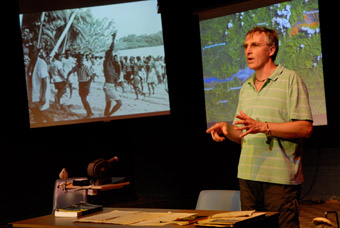
Paul Dwyer, Bougainville Photoplay Project
photo Heidrun Löhr
Paul Dwyer, Bougainville Photoplay Project
THE SLIDE NIGHT MIGHT BE DYING IN THE SUBURBS, THANKS TO THE RISE OF DIGITAL PHOTOGRAPHY AND FLICKR, BUT IT STILL PERSISTS ON THE STAGE—ALBEIT IN A SLIGHTLY MORE ELEGANT FORM—THROUGH THE WORK OF PERFORMERS SUCH AS WILLIAM YANG AND NOW PAUL DWYER IN HIS SHOW THE BOUGAINVILLE PHOTOPLAY PROJECT. LIKE YANG, DWYER TELLS INTIMATE TALES THAT BELIE THEIR LARGER POLITICAL SIGNIFICANCE AND HE DOES SO WITH SIMILAR RESTRAINT, SHARING EMOTIONAL STORIES WITHOUT NECESSARILY EMOTING.
Sitting at a desk on a small trapezoidal stage, surrounded by computers on his right (manned by video artist Sean Bacon and director David Williams), a wall of maps and old newspaper articles on his left and two screens above his head, Dwyer braids together three narrative threads: the story of his late father, the orthopaedic surgeon Dr Allan Dwyer, and his pro bono work in Bougainville in the 1960s; the story of Dwyer’s own academic research there 40 years later; and the broader history of Bougainville itself.
Dwyer tells us about his father’s “beautiful hands”, his revolutionary screw and cable treatment for scoliosis (variously illustrated with x-rays, photographs, an onstage skeleton and a reenactment where the scalpel is a black marker pen), his smoking habit, and most importantly his work in Bougainville. The surgeon made several trips there during the 1960s and we relive them in all their Kodachrome glory with photos, slides and snippets of film as well as some amusing excerpts from the notebook of Dwyer’s then 13-year-old brother who recounts a tale of window seats, lost jackets and slightly clammy pants.
The father passed away before Dwyer had the opportunity to accompany him to Bougainville, however he followed in his footsteps in 2004 when he went on a fieldtrip as part of his research into restorative justice and the performative ceremonies associated with it. Like his brother, Dwyer is endearingly frank, particularly about the practice of fieldwork: he reads out the first polite, hesitant email; lurches through a language lesson; and enacts encounters in Tok Pisin and English. He is also honest about his dependence on the good will of his informants, his efforts to build rapport (Rugby League comes in handy) and his self-consciousness about the colonial connotations and the postcolonial context of the whole ethnographic enterprise.
These themes are dealt with more explicitly in the third strand of this story, which rehearses the history of Bougainville’s mine, its war and now its peace. Dwyer explains how the copper mine devastated the local community and why it lead to the rise of the Bougainville Revolutionary Army (BRA) and the retreat of the Papua New Guinea Defence Force, which then funded—with Australia’s assistance—various militia collectively called the Resistance. This long and brutal civil war only came to an end in 1998 and since then Bougainvilleans have worked hard to keep the peace and attain autonomy. The performance ends with Dwyer attending a reconciliation ceremony with more than a thousand participants, who witness perpetrators crossing the circle to apologise to their victims, shake hands and begin to forgive each other.
In his program notes, Dwyer suggests “there is something to be learned from the people of Bougainville about how to do reconciliation” but there is something to be learned from him too. In telling three stories of reconciliation, Dwyer causes us to reflect on the nature of reconciliation itself. In Bougainville, reconciliation emerges as a generous intersubjective encounter and a genuine attempt to right a wrong. Between Bougainville and Australia reconciliation resembles resignation, as if Australia were too preoccupied with its internal reconciliations to contemplate an international one right now. Finally, there seems to be a smaller reconciliation—or reckoning—between Paul Dwyer and his father. More than once, he cites John Berger’s classic, A Fortunate Man: The Story of a Country Doctor, and asks “How does the cure of serious illness compare in value with one of the better poems of a minor poet? How does making a correct but extremely difficult diagnosis compare with painting a great canvas?” The implicit question here is, “How does one compare doctors? How does an MD compare to a PhD?” Perhaps it is indicative of the measurements we all make at some point: how do I compare to my parents, my peers, my neighbours? What is it to be the fortunate child of a fortunate man or the citizen of the so-called lucky country? To whom do we owe a duty of care? To whom do we owe an apology?
Version 1.0 in association with Tamarama Rock Surfers and Paul Dwyer, Bougainville Photoplay Project, devisor and performer Paul Dwyer, director David Williams, video artist Sean Bacon, lighting designer Frank Mainoo, technical assistance Russell Emerson; Old Fitzroy Theatre, Sydney, October 14-31
RealTime issue #94 Dec-Jan 2009 pg. 42
© Caroline Wake; for permission to reproduce apply to realtime@realtimearts.net
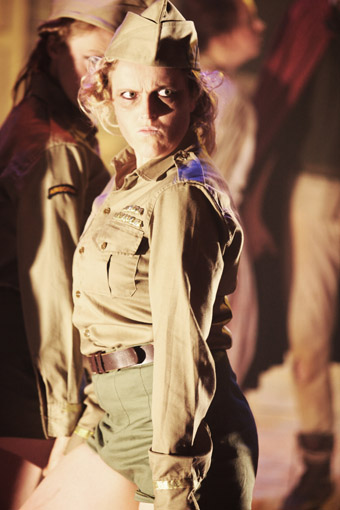
Oda Aunan, Heart of Gold
photo Kim Tran
Oda Aunan, Heart of Gold
“WE CARE NOT FOR THE POLLUTED IDEALS OF THE DECADENT EAST, FOR WE KNOW WHO WE ARE!”, BLEATS ANGUS BROWN, THE UNHINGED CHILD PATRIOT AT THE PSYCHIC HEART OF THEA COSTANTINO’S LAVISHLY COMIC MUSICAL, HEART OF GOLD. THIS IS ‘WESTRALIA’—WHERE SECESSION WOULD SURELY GARNER MORE VOTES THAN DAYLIGHT SAVING; AND WHERE SAND, SURF AND OL’ FASHIONED VALUES CLEARLY PROVIDE RICH AGISTMENT FOR NEW WA PRODUCTION COMPANY HOLD YOUR HORSES, CO-FOUNDED BY COSTANTINO WITH VISUAL ARTISTS TARRYN GILL AND PILAR MATA DUPONT.
A beautifully staged rural-gothic extravaganza, Heart of Gold is directed confidently by Zoe Pepper and made larger than life by composer Ash Gibson Grieg and an accomplished cast of actors and dancers. It centres on the hard-done-by Brown family—Iris and her two strange kids, Angus and Violet—who find themselves grappling with the malevolent charms of smooth, manipulative Constable Irving Saddle, an unexpected intruder into their lives in the isolated WA town of Paucity.
Heart of Gold dramatically extends Gill and Dupont’s previous works in the Heart of Gold series, in development since 2004. Its forerunners have largely consisted of sets of lushly produced photographs, tableaux vivants and live art performances memorable for their military-style pin-up girls and lipsticked lifesavers and their conflation of a distinctly Australian 50s kitsch with wartime Hollywood glamour and patriotism, Busby Berkeley style.
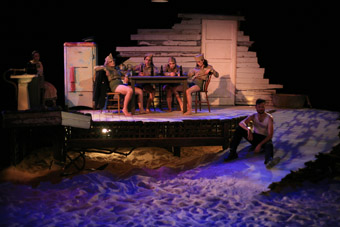
Heart of Gold
photo Kim Tran
Heart of Gold
The synergy within this team is palpable, and the performers bring such confidence and accuracy to their hammed-up roles that what could read like a bad school play is frequently stunning in its clarity—in moments of both audacious madness (such as the anthem, Sausages, the National Treat, featuring a chorus of sequined snags) and bleak poignancy. Watching Iris and Irving tango their way through a kitchen courtship dance complete with 50s Latin flute riffs is more than satire: the scene holds real pathos. The same kitchen becomes truly sinister when, amid the dramatic denouement, it becomes populated with a troupe of demented, un-dead soldier girls, who seem as much to offer a last line of defence to poor Iris and Violet as to rally to the cause of regional independence in a world raped and plundered by Saddle and his parasitic kind.
Costantino’s writing is luscious and pointed, the vernacular spot on and the many comic shifts and turns accurately placed. Investing the character of a 12-year-old boy with the role of madman, critical enquirer and unsettling animator of the feminine is a stroke of genius. Angus evokes both weird nationalism and Freudian Oedipal angst, extolling the glories of war as the intruder besets his sister and mother.
Heart of Gold, the musical, carries a distinct layer of shadow, exposing the tattered values and desperate hopes of a world reduced to…Paucity. A kind of gothic vaudeville, its tale of paternalistic violence, feminine subjection and patriotism-run-riot faintly echoes Baz Luhrmann’s preposterous Australia, while sticking firmly to its softly lunatic, sandy terrain. It’s a critically aware, overblown lunacy; a cleverly twisted allegory of a quest for independence.
–
Heart of Gold, script, lyrics Thea Costantino, direction, dramaturgy Zoe Pepper, composition, performers Tim Watts, Shirley Van Sanden, Sarah McKellar, Brendan Ewing, chorus Natalya Alessi, Oda Aunan, Maree Cole, Lily Newbury-Freeman, Whitney Richards, sound design, musical direction Ash Gibson Grieg, choreography, costume design Tarryn Gill, set design Pilar Mata Dupont, lighting Lucy Birkinshaw; Perth Institute of Contemporary Arts, Oct 29-Nov 14
RealTime issue #94 Dec-Jan 2009 pg. 42
© Urszula Dawkins; for permission to reproduce apply to realtime@realtimearts.net
One of the legacies of modernism is a collection of established tropes that performers can dip into and retool to their liking. The video installations of Dominic Redfern recycle some of these tropes to affect an instant replay of the heroism of the modern man.
In massive screens attached to either end of the Perth Institute of Contemporary Art’s central gallery, Stonewall (2008) shows Redfern climbing the rocky slope of a hill above Queenstown, Tasmania. Here copper tailings have poisoned the landscape, producing an apocalyptic environment. This devastated scene offers the artist a site to stage a parody of romantic modernism. As he climbs, Redfern recites a stream-of-consciousness prose piece that recalls the parodies of late modern literature, by such French authors as Blaise Cendrars and Raymond Roussel. These writers are famous for playfully reworking the tropes of romantic literature to create abstract, meaningless machines of novels. They pastiche the classic ‘quest’ structure of the novel into a pointless, ridiculous escapade. The ghosts of Cendrars and Roussel linger in Stonewall as a recording of a French translation of Redfern’s monologue plays in the background, lending a Francophone cultural credibility to the piece. As Redfern writes, Stonewall is “promising significance yet consistently failing to deliver closure” (artist statement, www.dominicredfern.net).
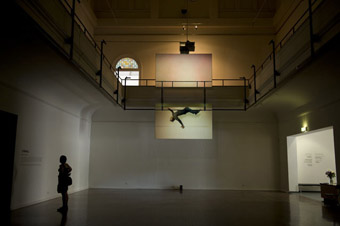
Stonewall 2008-09, Dominic Redfern
photo by Eva Fernandez, courtesy of PICA
Stonewall 2008-09, Dominic Redfern
It is between the tragedy of the masculinity on show and the comedy of its repetition that we can locate the other video pieces in the show. As a part of a series of video installations called Mythos (2007-9), Redfern is videoed walking across a salt lake, and on another screen wanders amongst grass trees, as if to mimic the loss of the modern artist in the vast Australian continent. In a piece called Emerge, again a part of the Mythos series, he surfaces from under the water of a magnificent European mountain lake. Walking onto shore, dressed in a soaking pair of jeans and a t-shirt, he picks up a branch before wandering out of shot. Once again the performance makes banal the tales of modernity, this particular tale located somewhere between Charles Darwin’s theory of evolution and Stanley Kubrick’s 2001 (1968). As Redfern occupies the place of the heroic modern protagonist, and performs a man who finds nothing at the end of the existential rainbow, his piece recollects the absences of art after modernism.
The French philosopher Jean Baudrillard has claimed that there can be no art after the Modern had exhausted the quest for art, and that contemporary art only occupies the place of an art that has in postmodern times disappeared. Redfern occupies the place of the artist in the absence of art, playing out the heroism of making an art that is not really there. He makes a tragic figure, who can only redeem himself through simulation and, like these late modern writers, parody. So it is, that the other screens of Stonewall, at the opposite end of PICA’s massive gallery, intermittently show a cardboard cutout image of Redfern falling, as if he has lost his grip on the side of the mountain. The flatness of this image renders the masochism of the solipsistic male an image like any other, to be retooled and repeated, pointlessly, by contemporary art.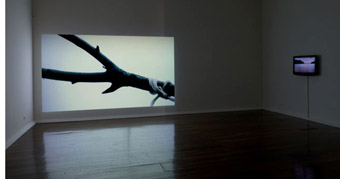
Mythos 2008-09, Dominic Redfern
photo by Eva Fernandez, courtesy of PICA
Mythos 2008-09, Dominic Redfern
Dominic Redfern, Perth Institute of Contemporary Art, Perth, 31 Oct-20 Dec, 2009
www.dominicredfern.net
RealTime issue #93 Oct-Nov 2009 pg.
© Darren Jorgensen; for permission to reproduce apply to realtime@realtimearts.net
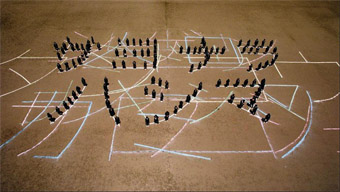
Spelling Dystopia 2009, Nina Fischer & Maroan El Sani
© the artists
Spelling Dystopia 2009, Nina Fischer & Maroan El Sani
Downstairs, in the dark of the Gallery of Modern Art’s black box Cinema B, a bevy of gorgeous, entirely naked Eurasian women cavort with a flock of bemused sheep in the stony Kazakhstani countryside. These slender beauties gleefully gorge on a roasted sheep’s head, starting with the molten eyes and then, flinging their waist-length black tresses with ecstatic abandon, writhe erotically with the animals amidst the straw, pee and liquid shit of a sheep-pen.
Set to a thumping ethno-electronic soundtrack, Almagul Menlibayeva’s sensual, telluric video Headcharge (2007) is as mesmerizing as it is perplexing. As Kathryn Weir cautions in her catalogue essay for The view from elsewhere, GoMA’s program of moving image art from Asia and the Middle East, the temptation for those schooled in Western avant-garde art traditions is to try to read this artwork in the transgressive tradition of the Viennese Aktionists, whose experiments, as Stephen Barber notes, “disassembled the human body and its acts into compacted gestures of blood…and meat.” However, as Weir goes on to note, beyond surface similarities of public nudity, freeform sexuality and “abject smears”, to place Menlibayeva’s highly specific video practice in this Western tradition is as much a misreading of the work as the other common responses—”exoticising fascination or complete misunderstanding”—to the art of ‘elsewhere’ explored in this extensive, challenging show.
Complex art such as Menlibayeva’s “Romantic punk shamanism”, which synthesises Central Asian and European references—specifically Kazakhstani cultural iconography with distinctly Western countercultural, psychedelic and Baroque flourishes—poses a unique challenge. The double gesture of familiarity and difference in this kind of work requires a viewer capable of stillness, observation, and “cultivating an openness to what is not known or cannot be known.”
The view from elsewhere offered Brisbane audiences a unique opportunity to cultivate that openness through the installed white cube show, Small acts, and the black box cinema program in which Menlibayeva’s dynamic videos were shown alongside realist documentaries and poetic short films from across the region. In Thai auteur Apichatpong Weerasethakul’s typically languid Primitive: A Letter to Uncle Boonmee (2009), a contemplative, searching camera rakes over the interiors of various wooden houses in a near-deserted village. Young soldiers dig up the ground outside one dwelling as the voices of three young men are heard repeating a letter to a man named Boonmee, about a tragedy in a small community, Nabua, which forced residents to flee their homes in panic. As a fearsome tropical wind seizes palms and banana trees and whips them into a wild frenzy, a swarm of bugs invades. Then the sky darkens, the camera tilts slowly to reveal a tracery of tree branches, and the bugs disperse. Weerasethakul’s earlier film, Like the Relentless Fury of the Pounding Waves (1996), shown with Primitive on the final Sunday of the program subtly explores four lives connected by a radio play, a “mysterious comedy and tragic drama!”, about the sea goddess Mae Ya Nang. As with countrywoman Sasithorn Ariyavicha’s meandering, reflective works (My First Film, 1991; Drifter, 1993; and Birth of the Seanema, 2004), this work is emblematic of the “dual consciousness” Mark Nash writes about in his catalogue essay, which sees international artists drawing on and developing aesthetic codes both culturally specific to Thailand, as well as histories of North American and European avant-garde and art cinema.
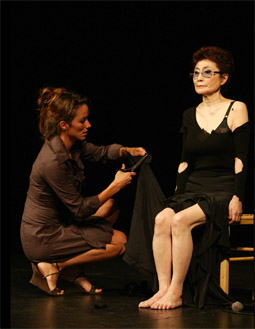
Cut Piece 2003, Yoko Ono
photo by Ken McKay © Yoko Ono
Cut Piece 2003, Yoko Ono
As the curators point out, video and performance art emerged roughly coincidentally, and the Small acts show makes explicit the links between historic performance art captured on early video and contemporary trends in video art, in which performance documentation features heavily. Nam June Paik’s pioneering Hands and Face (1961), featuring the artist passing his hands over his face in a kind of trance, frames the entry to the media gallery in which Small acts is housed. The viewer is then greeted with an installation of Yoko Ono’s Cut Piece (1964, restaged 1996). In this seminal piece, Ono sits impassively as spectators are invited to cut pieces of her clothing away; while it’s hard not to notice the way male participants are quick to refashion her a décolleté (both in the early version and the later re-staging), the video also powerfully brings together other notions of sadism/masochism, desire/exhibitionism, and reciprocity in the art exchange.
In the next room, Kimsooja’s videos, A Beggar Woman, Lagos (2001) and A Homeless Woman, Cairo (2001) feature the artist adopting the forlorn poses of society’s most vulnerable members. With her back to the audience, lying or sitting begging in a public street, Kimsooja recalls the public struggles of non-violent activists, foregrounding her body as a political object and using video as witness. The majority of works in Small acts, however, reflect the easy availability of user-friendly, cost-effective digital technology and the way early video art’s political imperatives have given way, in a large part, to smaller aims constellated around self-expression. Of the documentation of simple performance gestures, particularly memorable are the sweetly domestic games of Guy Ben-Ner, and Taiyo Kimura’s absurdist acts, as they recall early cinema’s climate of wonder and discovery, and the period before genres such as ‘documentary’—or even ‘the trick film’—had fully crystallised.
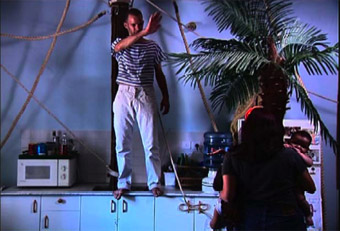
Moby Dick 2000, Guy Ben-ner
© the artist
Moby Dick 2000, Guy Ben-ner
The documentary urge, discussed at length in the catalogue essays, defines both Small acts and the cinema program of The view from elsewhere. The show offers an opportunity to explore the outermost contours of documentary form, such as in Lida Abdul’s beautiful, unexpectedly ludic In Transit, where a rusting military airplane is joyously transformed into a plaything by a group of children; the haunting found-footage explorations of Ayisha Abraham and Yoo Soon-mi; and Kyrgyzstani artist Shaarbek Amunkul’s potent ethnographic studies. Legendary filmmaker Amos Gitai’s ‘archaeological’ exploration of a single street in West Jerusalem, in Bait (House, 1980), and News from Home/News From House (2005), which centres on the displacement of a Palestinian family, the appropriation of their property, and subsequent ‘lives’ of the house, is also a lesson in the power of non-fiction film.
In the light of so much pro-filmic reality, more constructed works such as Menlibayeva’s, Mona Hatoum’s exquisite Measures of Distance (1988), and Nina Fischer and Maroan El Sani’s study of Japan’s infamous uninhabited Gunkanjima (Battleship Island) Spelling Dystopia (2009), are a breath of fresh air. In particular, Inoue Tsuki’s remarkable A Woman Who is Beating the Earth (2007), about the hard rock fantasies of a woman struggling with an abusive relationship, stands out from the rest for its bravery, wit and raw poetic force.
The view from elsewhere was an expansive exhibition, involving numerous works and requiring multiple visits. It highlighted the unique ability of the relationship between the Gallery of Modern Art and the Australian Cinémathèque to articulate, with sensitivity and scope, the dimensions of contemporary moving image practice and how, in both gallery and cinema setting, the elsewhere of the title, in Mark Nash’s words, “is not just the elsewhere of the artist’s location, but that space which opens up within the viewer when they engage with the individual works.”
Small acts, curator Kathryn Weir, Media Gallery, GoMA, July 25-15 Nov 15; The view from elsewhere, curator Kathryn Weir, Australian Cinémathèque, GoMA, Brisbane, Oct 7–Nov 15
RealTime issue #93 Oct-Nov 2009 pg.
© Danni Zuvela; for permission to reproduce apply to realtime@realtimearts.net
Sue Healey is a leading, Sydney-based choreographer, described by Erin Brannigan in her introduction to a 2004 RealTime interview as “a survivor in the Australian dance scene.” Her capacity to survive in the under-funded Australian dance ecology is doubtlessly fuelled by the strength of her vision:
“I create dance that acknowledges the potency of the human body to take us into the realm of the extraordinary. I believe dance to be vital human research and as a means to communicate across cultural boundaries. I am committed to creating a theatrical language that illuminates and transforms, revealing subtle layers of movement and perception” (www.suehealey.com.au).
As a choreographer Healey appears pretty much a formalist, producing with her dancer collaborators geometrical patternings (accentuated by the poles and lines the performers dextrously manipulate in Healey’s Fine Line Terrain, 2004) that are at once taut and fluid. Finely responsive dancers like Shona Erskine, Lisa Griffiths and Nalina Wait are expert in realising Healey’s demand for heightened, abstract articulation in this dance essay about our manipulation of space as habitation.
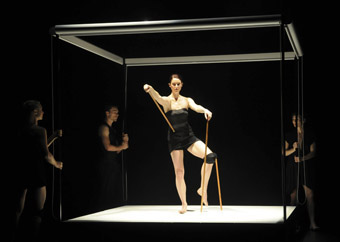
The Curiosities, Sue Healey, Performance Space
photo by Heidrun Löhr
The Curiosities, Sue Healey, Performance Space
On the other hand, in As You Take Time (2007), with its multiple performance sites and screen duplication of performers live and recorded, there’s a more open performativity, with witty filmed encounters and stagings in Japan alonside live embodied recollections of cross-cultural experiences.
What’s particularly interesting about Healey is her sense of exploration (of time, cultures, perception, body mechanics), of research become art or, better, art as research. Above all it is her preoccupation with perception (amplified by her filmmaking craft and its multimedia manifestations) that gives her body of work its enduring substance: “(Experiencing) dance, whether as observer or performer, can enhance the way we perceive our reality as moving, sentient beings interacting on this fragile planet.”
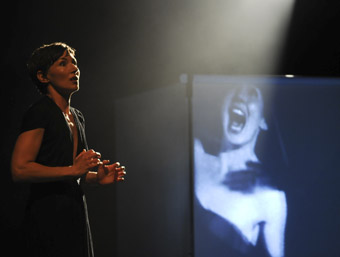
The Curiosities, Sue Healey, Performance Space
photo by Heidrun Löhr
The Curiosities, Sue Healey, Performance Space
Healey began a degree in Science at Auckland University, New Zealand, before coming to Melbourne in 1981. She graduated from the Victorian College of the Arts with a BA (Dance Performance) and then a Masters Degree in Choreography at Melbourne University. She was a founding member of Danceworks in Melbourne and performed and choreographed with the company from 1983 to 1988. In the 1990s she created works for many dance companies in Australia and has been Artistic Director of Vis-à-Vis Dance Canberra (1993-95) and the Sue Healey Company from 2002, touring the United States, United Kingdom, China, Japan and New Zealand. Her film Will Time Tell? won Best Dance Film at the 2008 Australian Dance Awards. Sue Healey was awarded the 2008 Robert Helpmann Scholarship by the NSW Ministry of Arts. Her company is touring to the International Festival of Media and Arts, Yokohama Japan in November 2009. Healey is currently a Visiting Fellow at the School of English, Media and Performance, UNSW. A review of Healey’s latest work, The Curiosities, will appear in RealTime 94.
Keith Gallasch
reviews
the body: re-examined, recreated, restless
jodie mcneilly: sue healey, the curiosities
dancing cultural time zones
keith gallasch: sue healey, as you take time
reeldance: the dance-cinema hybrid
karen pearlman: reeldance 2004
dancing the labyrinth
richard james allen: sue healey, fine line terrain
niche #2 a salon performance
erin brannigan: antistatic 2002
interviews
the slippery path
erin brannigan: time series
the fine lines of creation
erin brannigan: niche series
dancewrite workshop feature
For the 2008 RealTime-Critical Path DanceWrite workshop, Sue Healey showed and spoke to her film Will Time Tell?, after which participants wrote their responses to the work.
will time tell?: into the cultural vortex
ashley syne
will time tell?: precise moves
jane mckernan
will time tell?: multiple beings
yana taylor
will time tell?: many times
pauline manley
Video excerpt embedded with permission from the artist
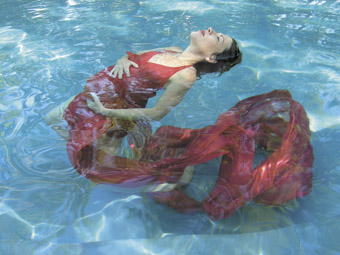
Rapt, Dance on Camera Festival 2007
© the artists
Rapt, Dance on Camera Festival 2007
RealTime is a leader in developing critical writing around dance screen in all its various manifestations. Dance Screen is a relatively new term that has replaced others such as videodance, describing a much broader field of practice than the single screen works that established the field through television and dedicated festivals in the 80s. In typical style, choreography has demanded much more of the two-dimensional screen than videodance allowed, forcing a shift to multiple screens and then interactive environments, forging new experimental partnerships with science and emerging technologies.
RealTime has published reviews of individual films and installation exhibitions, coverage of local and overseas festivals, profiles on major new media/science projects in the field, and interviews with leading artists. In so doing, it has helped establish dance screen not only here in Australia, but internationally. As both a writer and curator in this field I appreciate the rigorous discussion RealTime has encouraged on dance screen and the regularity of commissions and comprehensiveness of the coverage. Festivals and related institutions provide links to RealTime on their websites and it has thus become a significant resource for collecting and exchanging information.
More importantly, RealTime has progressed debates on a form that is morphing much more rapidly than often lumbering theoretical discourse. Along with English language critical activity in the 80s in the US and the UK in the 1990s, this archive represents a concerted effort to develop and circulate writing on choreography and the screen, and joins the work of Opensource [videodance] in the UK and Screendance conferences at Duke University in the US in providing a platform from which things can progress.
Major festivals such as the Austrian-based IMZ Dance Screen, Moves in Manchester, Dance on Camera in New York and iDN in Barcelona form the backbone of this archive as these festivals and their committed directors have really advocated for, and framed the parameters of, this slippery interdisciplinary form. Significant space is also given to Australia’s ReelDance Festival with coverage from a broad variety of writers. Also important are interviews with key artists such as UK-based David Hinton and Gina Czarnecki, New Zealander Daniel Belton, and Australians Margie Medlin, Gideon Obarzanek and Sue Healey. These in-depth discussions provide an invaluable resource as case studies for inclusion in teaching and learning about the form.
While the archive includes articles written by experts in this field such as the UK-based artist and curator, Chirstinn Whyte, this body of writing also represents the work of many emerging, local writers who tackle this interdisciplinary relative of dance, providing critical feedback for Australian artists and curators.
Erin Brannigan
reeldance festival
dancefilm: making choices
karen pearlman: 2010 reeldance awards
tears in time
virginia baxter: reeldance installations #04
between space, people & camera
jane mckernan: interview, tracie mitchell, reeldance festival
judging the body-media meld
pauline manley: reeldance festival awards
forsythe, bausch, platel…
martin del amo: contemporary dance on screen
global shorts: music: dance: image
jodie mcneilly
global shorts, this dancing life
jane mckernan
global shorts, the art of moving
ashley syne
reeldance festival awards
pauline manley
reeldance festival: contemporary dance on screen
martin del amo
reel-dancing: the 5th reeldance dance on screen festival
realtime
magic dance patterning
keith gallasch: reeldance installations #03
dance cinema, cinematic dance
karen pearlman: 2006 reeldance finalists
installation dancing
mike leggett: reeldance installations #02
reeldance: the dance-cinema hyrid
karen pearlman: reeldance 2004
eyes wide open
virginia baxter: reeldance festival 2002
moves festival, uk
from screen dance to screen based
christinn whyte: moves10, liverpool
screendance 2.0 is with us
chirstinn whyte: moves09, manchester, uk
multiplying screens & means
chirstinn whyte: moves08, manchester, uk
post-dance, everything is choreographic
chirstinn whyte: moves07, manchester, uk
reviews and articles
tanja liedtke: in the accumulation of traces
justine shih pearson: life in movement
dance, animation & other realities
realtime: physical tv, entanglement theory
reframing the dance screen
chirstinn whyte: dance for camera, brighton, uk
investing in dance screen
justine shih pearson: empac and dance on camera, new york
the challenge: teaching dance on screen
erin brannigan: take 7 dance dvd
art on the side of cinema
carl nilsson-polias: eve sussman, melbourne festival
screendance: artform in transition
richard james allen: imz dancescreen & opensource
dance screen treasure chest
keith gallasch: film dance at the sydney opera house
dancing cultural time zones
keith gallasch: sue healey’s as you take your time
dancing at the interface
erin brannigan: iDN, barcelona
crossing the divide
karen pearlman: dance on camera festival, new york
seeing anew
becky edmunds: videodanza festival 2006, buenos aires
down there for thinking
chirstinn whyte: dance on screen festival, london
cutting it
renee newman-storer: wa dance film
a dance of definitions
karen pearlman: screendance, usa
monaco’s unwieldy dance fest
erin brannigan
interviews
matchbox magic: dance as film
jonathan marshall: daniel belton, nz choreographer & filmmaker
making dance film: influences, cultures, bodies
erin brannigan: interview with dance film director david hinton
after glow
keith gallasch talks with chunky move’s gideon obarzanek
dance film: spiritual odyssey
keith gallasch: richard james allen and karen pearlman of thursday’s fiction
music makes the moves
erin brannigan talks with sciart winner margie medlin about quartet
the fine lines of creation
erin brannigan interviews sue healey
portal
karen pearlman: dance film online: a starter survey
newweirdaustralia.com
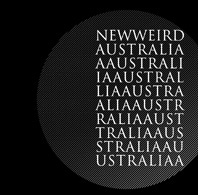 New Weird Australia is a series of free downloadable albums compiled by Stuart Buchanan and Danny Jumpertz, the team who also present the show of the same name on Sydney’s FBi radio. The naming draws inspiration from the New Weird America moniker (in turn influenced by Old Weird America), which loosely categorises a range of alternative musics such as the neo-folk stylings of Joanna Newsom and Devendra Banhart; the psychedelic jams of the No Neck Blues Band and The Sunburned Hand of Man; and the laptop-folk fusions of CocoRosie and the Animal Collective plus more. Boldly borrowed by Buchanan and Jumpertz, the Australian usage is a little more expansive incorporating electronica, contemporary classical, lo-fi electronics and laptop experimentations that dwell on the outer edges of the ‘alternative mainstream’. Two compilations have been released so far, with the third due in November and already they are exposing listeners to some great hidden treasures—from artists well known in experimental circles, and from fresh discoveries—with an impressive Australia-wide representation.
New Weird Australia is a series of free downloadable albums compiled by Stuart Buchanan and Danny Jumpertz, the team who also present the show of the same name on Sydney’s FBi radio. The naming draws inspiration from the New Weird America moniker (in turn influenced by Old Weird America), which loosely categorises a range of alternative musics such as the neo-folk stylings of Joanna Newsom and Devendra Banhart; the psychedelic jams of the No Neck Blues Band and The Sunburned Hand of Man; and the laptop-folk fusions of CocoRosie and the Animal Collective plus more. Boldly borrowed by Buchanan and Jumpertz, the Australian usage is a little more expansive incorporating electronica, contemporary classical, lo-fi electronics and laptop experimentations that dwell on the outer edges of the ‘alternative mainstream’. Two compilations have been released so far, with the third due in November and already they are exposing listeners to some great hidden treasures—from artists well known in experimental circles, and from fresh discoveries—with an impressive Australia-wide representation.
Interestingly there is a subtle difference in the range of styles between Volumes One and Two. The first compiled by Stuart Buchanan alone (renowned for his previous International Music radio program, Fat Planet), offers a wider scope of weirdness for this listener. It ranges from Pimmon’s finely detailed crackle, hiss and hum on “On The Other Hand This Carbon Fire Is (Flammable)”, to “Heartburn”, the lengthy (13mins) energetic, angular impro by Predrag Delibasich on soprano saxophone with band. In between we get a gorgeously climactic piano and drum séance from Telafonica’s “Time and Distance”; electroclash-cute with mind boggling lyrics and intricately glitched up rhythms from Loom’s “Snail Shell”; Raven’s dark, propelling beats with mellow strings in “Presumption #1”; and Anonymeye’s shimmering bluegrass guitar morphings in “If At First You Don't Secede…”. Mass choruses made popular by bands such as the Animal Collective and Tunng are definitely in fashion on this volume, with some exploring the area well, such as Lessons in Time – “Those Plastic Street Signs Are Not To Be Followed”, and others descending into urban primitive noodlings that make you skip on second listen. The choral epiphany on Kyü’s “Sunny in Splodges” with its epic massed military drum crescendo and close harmony, multi-tracked wailing is simply magical. Expect Kyü to be plucked from the obscurity of weirdness sometime soon.
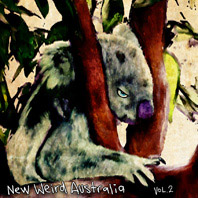 Volume Two is co-selected by Buchanan and Danny Jumpertz and steers away from the Freak Folk that is influencing Volume One, into the territory of exploratory electronica and ambient. Some of this is pretty much what we expect from electronica—which is not bad, just perhaps more neatly classifiable. Broken Chip’s “Summer Stars” offers pleasing glassy ripples and Björky-clockwork multi-rhythms. There is a similar machinic style, overlayed with a more militaristic drum exploration in Sam Price’s compelling “Auto Hackney”. Kharkov’s “Crustacean” keeps edgy by drifting swathes of sharpish tones over a subtle propulsion while Mieli’s fat beats of “Hometime”, though finely produced, offered me no weirdness at all.
Volume Two is co-selected by Buchanan and Danny Jumpertz and steers away from the Freak Folk that is influencing Volume One, into the territory of exploratory electronica and ambient. Some of this is pretty much what we expect from electronica—which is not bad, just perhaps more neatly classifiable. Broken Chip’s “Summer Stars” offers pleasing glassy ripples and Björky-clockwork multi-rhythms. There is a similar machinic style, overlayed with a more militaristic drum exploration in Sam Price’s compelling “Auto Hackney”. Kharkov’s “Crustacean” keeps edgy by drifting swathes of sharpish tones over a subtle propulsion while Mieli’s fat beats of “Hometime”, though finely produced, offered me no weirdness at all.
The burning question Volume Two raises is why do I find some of this fairly standard electronic music (not weird), and some more worthy of the title? Cock Safari’s “8MH” pushes the barriers with off-kilter nagging loops of sampled psychedelic rock that satisfies in its lo-fi exuberance. Similarly the crunchiness of Maddest Kings Alive’s “Measels”, with joyous 8bit-sounding arpeggios, keeps it in edgier terrain. The more satisfyingly weird tracks are by Oceans, Transmissions, Panoptique Electrical and Splendid Fields which offer more challenging timbral palletes, and if using beats, don’t rely on them as the unifying structure of the piece. However several of these are rather short, as though afraid of testing the listener too much.
William Gardiner’s “Sonance Arboreal” is a stand-out, not only as it is from the more contemporary classical end of town, but also because its Minimalist tuned percussion sequences, choral drifts and sparse piano lines are powerfully emotive. As is my favourite track on Volume Two, Paul Fiocco’s “Torsions and Drifts”, a 13-minute, microscopically detailed field recording of walking through shifting terrain accompanied by dark and haunting drones—disturbingly visceral.
Listening to the two collections in search of the definitive ‘weirdness’ becomes agitating and perhaps is not in the spirit of the venture. In the introductory notes Stuart Buchanan states “Neither popular nor alternative, neither one genre nor another, New Weird Australia represents a new breed of Australian musicians that find refuge in the space between us.” And on the whole it does, in an indefinable way.
Perhaps it is not the ‘Weird’ that is so important as the “Australia’ part of the naming. These styles of music are already in the alternative mainstream with reasonably large fan-bases and niche airplay, but it is still primarily the international artists who are foregrounded. What these compilations achieve, along with the associated radio program (and several others on FBi), is to bring to light some of the more interesting and innovative Australian artists who are also making challenging and chewy music across a range of genres. I’m looking forward to Volume 3.
Gail Priest
Free download available from http://newweirdaustralia.com/nwa-releases/
New Weird Australia radio program, Thursdays 9-11pm, FBi 94.5 FM, and is streamable. www.fbiradio.com
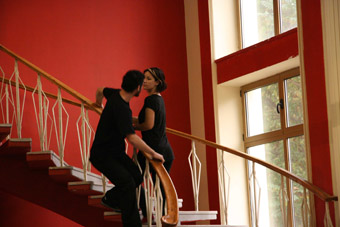
Johanna Billing, I’m lost without your rhythm 2009
photo by Lavinia German, courtesy the artist and Hollybush Gardens, London
Johanna Billing, I’m lost without your rhythm 2009
Swedish artist Johanna Billing is clearly no stranger to a striking concept. Wildly differing renditions of 80s pop song You Don’t Love Me Yet are presented as raw footage, accessible at viewing stations in Bristol’s Arnolfini Gallery. Recorded at a rolling program of global events from 2002 onwards, quavering unaccompanied vocals give way to slick retro synth and alt. rock, as viewers stay with each version for as long as individual stamina levels allow.
Billing’s work is featured as part of a collaboration between Arnolfini, London’s Camden Arts Centre and Modern Art Oxford, with the commission I’m Lost Without Your Rhythm and earlier work Magic & Loss exhibiting in Bristol over the last two months. In the first of these pieces, a performance project documented over seven days is reconstructed as a fragmented landscape of tiny increments in a 13 and a half minute video loop. A national flag, passersby, cleaning workers preparing a space, suggest a context shifting in and out of traditional performance states, as a patchwork of visual information accumulates around the event itself. The faces and limbs of non-dance trained Romanian teenagers move through a blue-carpeted studio; the formal sweep of a curving staircase and a slate-grey terrace of wide stone ledges. Disjointed, inconsequential actions give way to head rolls, sideways falls and knee rotations, building and repeating between each space, and wedded to a drumbeat and lyric-dominated soundtrack of escalating complexity. Moments of abstracted detail, a close-in lattice of crossed hands, a mesh of running shadows, appear to exist apart from the work’s formalised choreographic language, as if Billing’s creative engagement with the material is experienced more freely at one remove, breaking through in occasional sideways glances.
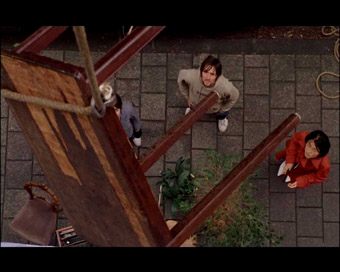
Johanna Billing, Magic and Loss 2005
Images from Magic & Loss, a 17 minute loop filmed in Amsterdam in 2005, settle and resonate, creating an ambiguous space for the viewer’s own narrative associations to arise as a group of silent 20-somethings dismantle the minutiae of domestic habitation. The absence of dialogue and use of diegetic sound allows for a focus on texture and fragility, as wine glasses are wrapped in tissue paper, books are boxed and a pliant cargo of bedding is lowered to street level from an overhead hoist. While Magic & Loss contains no recognisably codified dance content, rhythmic structure emerges from low-key internal pacing, with the weaving together of image states appearing much closer to a contemporary notion of direct screen composition. Viewing both works in adjacent spaces raises pertinent questions about visual stimuli and breathing space, external frameworks and internal phrasing, about the amorphous, process-driven nature of screen choreography, and of the impossibility of neatly defining product-based end results. Screendance has undergone a recent shift away from the studio, and towards the gallery. Billing’s work mirrors this shift, reflecting it back from a documentary and conceptually-oriented basis. The seamless circularity of the looped works, allowing viewing engagement to begin and end at any point, makes perfect sense of carefully constructed beginnings when viewed retrospectively as a cycle’s end—much like life.
Johanna Billing, Arnolfini, Bristol Sept 12-Nov 8
RealTime issue #93 Oct-Nov 2009 pg.
© Chirstinn Whyte; for permission to reproduce apply to realtime@realtimearts.net
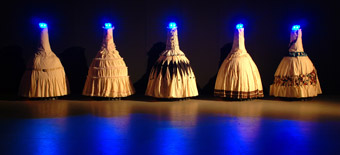
Wade Marynowsky, The Hosts, Performance Space
the artist
Wade Marynowsky, The Hosts, Performance Space
That huge foyer in Carriageworks: commodious enough to play jump-rope in, and wholesome enough too. It’s a chunk of light cut from the atmosphere in a heavy industry sized serving, populated in work hours by those expert occupiers of knee-grazing surfaces, small running children.
Then, you enter the show in Bay 21, and nothing could be more distant than the memory of that air and light.
When the double door thumps shut I can see only the stippled patterns on my retina in the dark. A beam of light pins me from above, radiating from a transparent dome two arm spans above my head, just over … there. It stirs, glides toward me, revealed as the crowning cupola atop a towering robot. Wearing a gigantic bustled dress.
The scale of the creature makes the theatrical dimensions of the space seem domestic, even claustrophobic; I’m the one built on the wrong scale, an interloper in another’s intimate space. My illuminated host makes me welcome nonetheless, stopping an alarming few centimetres away for a curtsy. It (she?) mumbles some indecipherable pleasantry, and as the lights and the sound swell, I can see the room throngs with these enormous things, marking out the sporadic steps of a disjointed dance that I seem to be the only one not to know.
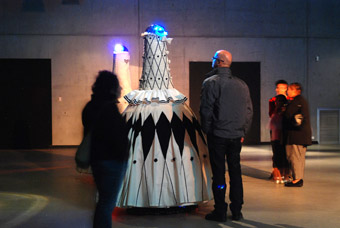
Wade Marynowsky, The Hosts, Performance Space
the artist
Wade Marynowsky, The Hosts, Performance Space
If these creatures owe something to the Victorian automata to whom their creator claims a debt, then it is the fashion. Their clothes are a pastiche of dress gowns, corsets, lace and military paraphernalia, an alien forensic anthropologist’s reconstruction of a Southern plantation ball demolished by stray cannon shot, familiar but dissonant.
Their performance lacks the endless repetition of those parlour automata. These are unsettlingly interactive, personal, provoking. Each robot approaches in turn, offers some vocal non-sequitur (“Do you love me?”) and then pirouettes, inviting me hopelessly to some dance you would surely need prostheses to participate in. I intuit with unease that my faculties are inadequate for the social world of these creatures, and find my ears trying to demodulate the drones that fill the room as a modem decodes signals from a telephone line. Have I stumbled onto a mechanical rehearsal for some obtuse celebration? Are these machines taken aback to find a human among them half way through their private training in the finer points of the graces of the fleshed? Or is that what they want from me? This performance doesn’t feel like spectacle—rather it fills me with the suspicion that I am the spectacle. As the indecipherable noise spilling from the ‘gramophone horns’ crescendos, it becomes so close in there that that it feels an effort to breathe. I go.
It’s not only the lace trimming that links this show to Marynowsky’s earlier robotics experiment, The Discreet Charm of the Bourgeoisie Robot [see Studio]. In both, Marynowsky plumbs the crevices of the shifting contemporary anthropology of robotics, and it is we punters who are on display, with the grating awareness of self that uncertainty about our observers provides. What are these beings? If the society of the 1800s was taken in by Wolfgang von Kempelen’s notorious hoax Mechanical Turk, are we perhaps more vulnerable to that same hoax today? How much looser might the criteria be now for an entity to merit social pleasantries, in this age of digitally mediated conversation, public surveillance, machine learning? There is a kind of inversion of the panopticon here. I know I am watched, but I do not know truly by what. Is it another of Wade Marynowsky’s telepresence hoaxes, or some automated trickery, or perhaps something more unnaturally intelligent? Is the moment at hand when we reprise our ancient animism, catching ourselves being polite to our appliances just in case there is an intelligent mind of any sort peering back at us that we might offend? Are we anticipating the time that our contraptions will accuse us of being mere imitations? In my case, I am startled and sheepish at the faint Frankenstein paranoia that characterise my part in this gothic techno social comedy of manners.
I do have to say, though, those preschoolers from the foyer love it.
The Hosts: A Masquerade of Improvising Automatons, media artist/artistic director Wade Marynowsky, electrical engineer Aras Vaichas, programmer Jeremy Apthorp, lighting Mirabelle Wouters, costume Sally Jackson, camera John Douglas, edit Sumugan Sivanesan; Performance Space 14 Aug-12 Sept
RealTime issue #93 Oct-Nov 2009 pg.
© Dan MacKinlay; for permission to reproduce apply to realtime@realtimearts.net
“Everyone likes to look through the net curtains, on a dark night when they walk down the street. Everyone likes to hear and see what’s going on over their neighbour’s fence. It’s partly because you want to know if things are better than your lot, or worse than your lot.”
Paul Watson, Director of Sylvania Waters, interviewed for the 7.30 report, ABC 1992
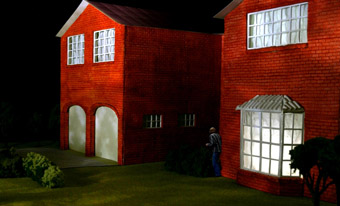
David Lawrey & Jaki Middleton, The world’s more interesting with you in it 2009
Image courtesy of the artists
David Lawrey & Jaki Middleton, The world’s more interesting with you in it 2009
As if mirroring the words of Sylvania Waters’ British director, Paul Watson, Jaki Middleton and David Lawrey have created a miniature version of the once infamous million-dollar waterfront home occupied by the Donaher family. In this three-dimensional environment, inserted into the a wall of the Hazelhurst Regional Gallery, the artists represent their video selves through the device of the Pepper’s Ghost, peering around the house’s garage and lurking in front of the bay windows of its living room. A replica Victorian streetlight wetly illuminates the empty driveway as the artists haunt the house’s exterior like apparitions of nosy neighbours.
Described as a long-term project by curator Daniel Mudie Cunningham, Reality Check deftly intertwines analysis and discourse around popular cultural forms of entertainment with the commissioning of works by 10 established and emerging Australian artists whose practices variously remix, retroactively adjust, repurpose or re-mediate our cultural ephemera. The exhibition is firmly situated within a specific locale; The Sutherland Shire where Sylvania Waters was filmed and the Hazelhurst Gallery resides. Reality Check not only focuses on the histories and legacies of this community—but how, in the rarified moment of Sylvania Waters, and through a single family, it shaped and challenged ideas of representation and the construction and international dissemination of national identity.
In Reality Check, the rapid proliferation of confessional-style entertainment and exploitative forms of television since the early nineties is of course a recurring theme. As a teenager and recent migrant to Perth at the time of Sylvania Waters’ original airing on ABC TV, I have to admit to never watching a single episode of the docu-drama that seemed to polarize the nation. In a 7.30 Report interview, accessible via YouTube, the Donaher family—in defence of themselves—grappled with the problematic and cynical machinations of so-called Reality TV; the subjective nature of which we now expect, enjoy and take for granted.
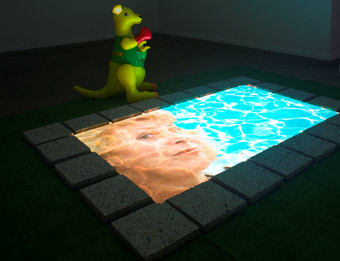
John A Douglas, Ask Noeline….(not the ogre) 2009
Photo by Silversalt. Courtesy the artist & Chalk Horse, Sydney
John A Douglas, Ask Noeline….(not the ogre) 2009
Cunningham’s exhibition is filled with phantoms of the Donaher family, from manipulation of actual Sylvania Waters footage, to representations of the home and family members; in particular their outspoken matriarch, Noeline. The Kingpins’ series of colour photographs and towering blonde-humanoid-wig-sculpture Blonde Ambition resurrect her domineering feminine presence and aggressive consumption of particular products: Jim Beam, Coke and Winnie-Reds. John A Douglas’ video installation, Ask Noeline…(not the ogre), reframes the ubiquitous Australian backyard pool as a kind of wishing-well where sound-bites of Noeline dispensing advice like an agony aunt are aired as her face shimmers across the screen’s blue surface. Carla Cescon’s installation with Donaher effigies situates Noeline’s caricature within the kitchen as the central hub of the family’s operations, while two shack-like ‘outposts’ on the grounds of the gallery are connected by walkie-talkies.
The exhibition space of Reality Check is filled with the sound of Elvis Presley’s Edge of Reality courtesy of Ms + Mr’s video Alternate Realities 1992/2009, which presents a spectral, uncanny parallel universe/narrative to Sylvania Waters by working with a video archive acquired through another Sydney-based family, the Archibalds of Glebe who were shortlisted, but not selected for the BBC show. In this work, several short scenes of the family interacting are treated as if the digital archive were permeable in real time: wormholes appear and people slip-through, while the poster image of Elvis (Time traveler? Alien abductee?) looms in the background. In Luis Martinez’ detailed pencil drawings, the Donaher mansion on Macintyre Crescent is contrasted against the humble Cabramatta home the artist was living in at the time, drawing attention to the wealth disparity of ‘average’ Australian families.
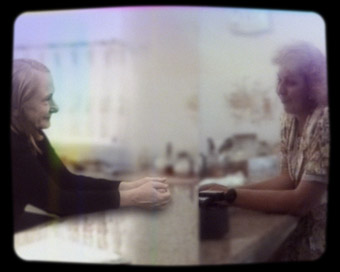
Ms & Mr, Archibalds/Donahers 1992/2009
Courtesy the artists & Kaliman Gallery, Sydney
Ms & Mr, Archibalds/Donahers 1992/2009
Elvis Richardson’s Sylvania Waters/Elvis Rants Away considers the constantly overwritten and obsolescing format of the personal VHS archive in two large-scale photographs representing VHS spines with assorted anagrams of the TV show’s title. Holly Williams’ card game Happy Families also addresses the decline of analogue forms of domestic interaction and play. The live-feed video installation of Archie Moore conversely reveals the instantaneous and manipulable nature of digital image-making technologies, effected directly upon the gallery visitor.
While the monochromatic abstractions and pared-back symbolism of Mitch Cairn’s work require a deeper knowledge of the Sylvania Waters episodes to adequately decode, they bring in to focus from my perspective the tendency to misread and misinterpret edited and decontextualised information or images—which is a constant criticism of the reality TV format. For Sylvania Waters novices (like myself), the curator has also assembled episodes from the series, Noeline Donaher’s one and only cringe-worthy hit single No Regrets, as well as works by artists who responded to the show at the time of it’s first screening including ceramicist Peter Cooley and performance artist Simon Hunt.
Seventeen years after Australia’s first brush with reality TV, the Hazelhurst Gallery’s curator, Daniel Mudie Cunningham has presented the organisation and its community with a curatorial coup. As an artist whose practice operates at a sometimes dazzling intersection between popular culture, performance art and fandom, Cunningham’s curation of Reality Check is richly informed by not only his creative methodologies but by rigorous research, as evidenced in the exhibition and it’s ambitious and thoroughly absorbing publication.
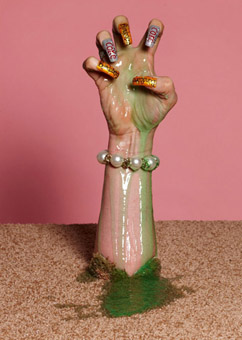
The Kingpins, Unstill Life 2009
Photo by Jordon Graham
The Kingpins, Unstill Life 2009
Reality Check: Watching Sylvania Waters, curator Daniel Mudie Cunningham, artists Jaki Middleton and David Lawrey, Elvis Richardson, Mitch Cairns, Holly Williams, The Kingpins, John A Douglas, Carla Cescon, Ms + Mr, Luis Martinez, Archie Moore, Hazelhurst Regional Gallery 10 Oct–29 Nov
RealTime issue #93 Oct-Nov 2009 pg.
© Bec Dean; for permission to reproduce apply to realtime@realtimearts.net
Splitrec CD19
www.splitrec.com
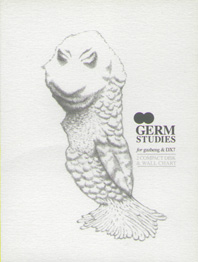 Germ Studies is a double CD produced by the duo of Clare Cooper of NOWnow Festival fame and Chris Abrahams of The Necks, and the two have been collaborating on it since 2003. Each CD comprises no less than 99 tracks, 198 in all. That is a lot of material and it represents an extensive investigation into the endless range of sounds that can be created by combining the venerable DX7 synthesiser and the even more venerable Chinese zither, the guzheng. It is also a deep exploration of musical language. Rather than producing longer, more self-contained compositions, Cooper (guzheng) and Abrahams (DX7) have created a series of sonic moments that flit through conscious awareness, sharply distinguished from each other by the nature of the sound, the sum of which creates a substantial and engrossing oeuvre. Many of these exquisite tracks are less than a minute in length, some just a few seconds. A few are longer, at 2 or 3 minutes, and, perhaps ironically, the track entitled Neutrino (referring to the almost weightless sub-atomic particle) is an epic at 8 minutes.
Germ Studies is a double CD produced by the duo of Clare Cooper of NOWnow Festival fame and Chris Abrahams of The Necks, and the two have been collaborating on it since 2003. Each CD comprises no less than 99 tracks, 198 in all. That is a lot of material and it represents an extensive investigation into the endless range of sounds that can be created by combining the venerable DX7 synthesiser and the even more venerable Chinese zither, the guzheng. It is also a deep exploration of musical language. Rather than producing longer, more self-contained compositions, Cooper (guzheng) and Abrahams (DX7) have created a series of sonic moments that flit through conscious awareness, sharply distinguished from each other by the nature of the sound, the sum of which creates a substantial and engrossing oeuvre. Many of these exquisite tracks are less than a minute in length, some just a few seconds. A few are longer, at 2 or 3 minutes, and, perhaps ironically, the track entitled Neutrino (referring to the almost weightless sub-atomic particle) is an epic at 8 minutes.
Cooper seems to play the guzheng in every conceivable way, generating a range of sounds as broad and nuanced as the DX7. The two instruments, acoustic and electric, together produce highly colourful timbres and textures—squeaking, ringing, whistling, popping, vibrating, beeping, pulsing, resonating, grinding and scraping, with fleeting hints of melody and occasional sustained excursions, miked-up and mixed to add emphasis or presence. Cooper and Abrahams have orchestrated these organic and inorganic voices into tight musical statements, each unique for the choice and manipulation of its sonic elements. Both are experienced improvisers (including collaborations with the Splinter Orchestra), and with such a broad sonic palette available, they are working within a much expanded and very rich and rewarding compositional field.
The CD package includes a fold-out sheet of 198 drawings, one for each composition. The title of each drawing, combined with its imagery, creates its own micro-world. The evocative titles are often cryptic or ironic words or phrases, like crossword clues—for example, Acid Shower, Ability, Pulitzer, Mariah, Barrister Incident, Competitive Edge, Prejudice Stopper, Jogging, Eating Own Shoulder, Farnham—and the drawings range from a few abstract, squiggly lines to expressionistic doodles and complex, narrative tableaux that are variously funny, sad, happy, mad, realistic, surrealistic and satirical. It looks as if Germ Studies has emerged from a game similar to Pictionary (sonictionary?). There is Rosalie Coccario’s winged, white-faced snake flying away from the city and crying big tears of farewell (Pale Faced Adios) and Gerard Crewdson’s leering court jester and skull (Big Chill). The artists include well-known names from the world of contemporary music (Robin Fox and Jim Denley among others), while some drawings look to be by children, suggesting that Germ Studies is the product of an extended musical family.
Sometimes the music seems deliberately programmatic, parodying or exemplifying the concept embedded in the title—for example, Acid Shower suggests lots of nasty droplets, Jogging is rhythmic like footsteps, Bass Needle is a series of low frequency tones, and the onomatopoeic Crackle sounds crackly. Mingus Germs, presumably referencing the jazz musician Charles Mingus, incorporates jazz-like syncopation, though the hissy growling sound suggests a badly tuned radio or perhaps Mingus’s spirit. Some sounds resemble speech elements or the omnipresent electronic signals of contemporary life. Or the character of the music might seem to recreate the psychological or emotional state associated with the title. Overall, the Germ Studies sound world evokes the chaotically dense and polymorphous sonic panorama of the real world. But always the work is complex and layered and there is an overriding and beguiling musicality.
We’re not told whether each title was a response to the composition, whether the image was used as a graphic score or whether the title was used to trigger a musical gesture from which an improvisation developed. While on CD#1 each drawing and track generally share the same title, on CD#2 they don’t match, as if the tracks have been shuffled, so that each title/drawing is disconnected from its analogous composition, denying the listener the opportunity to read fixed meanings into the music or to draw conclusions about its genesis. Your imagination is teased in all directions by the potential interpretations of these images, phrases and sounds, inspiring vivid daydreams.
The musical language Cooper and Abrahams have created thus addresses the use of sound as an analogue to speech, text and imagery, and examines the relationships between sound, image, word, memory and meaning. Cooper and Abrahams are fine musicians and composers who have developed a closely shared musical sensibility, and this is an intriguing CD.
Chris Reid
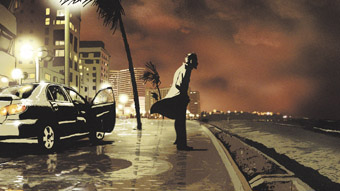
Ari Folman's Waltz with Bashir
I began writing about Australian animation in 2003, but only by default. I was in the queues for the Melbourne International Film Festival waiting to see various short film programs, which is what I intended to review. I kept overhearing the names 'Adam Elliot' and 'Harvie Krumpet' in conversations between fellow filmgoers, and noted they were talking about animation, not short film. I wasn't aware Australia had much of an animation industry. I had known student friends who made cartoons, but professionally? It wasn't like local animators were ever mentioned in mainstream media, therefore they didn't exist, in that if-a-tree-falls-in-the-forest kind of way. But there was an insistence about this Elliot character that made me want to know more, and that's how I came to interview him. That was before Adam's Oscar success, and I was left with admiration for those who made painstaking animations in a country that barely acknowledges Australian live-action film, let alone something as marginalised as this medium (it seems likely there'll always be a cross-section of society that sees animation as strictly 'for kids').
There have been some hiccups. A few RealTime writers, including myself, have criticised the oft-simplistic nature of Australian animation, usually directed towards storytelling. Generally, the technique is admirable and improving, especially since the CGI fad seems to be waning. RealTime's reviews of the annual Melbourne International Animation Festival demonstrate this: some years, the festival's local component seemed out of touch; recently, it has held its own with the international selections. The RealTime archives highlight other significant developments and patterns. Danni Zuvela's review of Aboriginal animation from Canada and Australia focuses on work blessed with much storytelling potential at the historical and mythological levels. Ashley Crawford declares the slapstick Dadaism of Arlo Mountford's extraordinary work in a league of its own. Dan Edwards takes a timely look at the 17-minute Sweet and Sour, an Australia-China co-production and a welcome change from what he terms Australia's “depressing myopia” when it comes to non-US/UK film influences. And Keith Gallasch admires Lee Whitmore's compelling The Safe House, “in which childhood, history and politics…come seamlessly together, a rarity in Australian film.”
Appraisals of international productions include no less than four reviews of Boca del Lupo's theatre/animation hybrid, My Dad, My Dog; Angela Ndalianis's seduction at the hands of ACMI’s Pixar exhibition; and Megan Carrigy's analysis of the extraordinary animated documentary Waltz with Bashir, making the salient point that having the film “in general release…is significant since animation has become a major site for innovation in Australian short films”. A couple of historical overviews serve to contextualise: Adrian Martin passionately introduces The Illusion of Life II, a 576-page collection of essays from animation scholars past and present; while my own look at Flickerfest's historical overview of Australian animation allows me to revisit the beloved “Life. Be In It” commercials of my youth, leading to the revelation that this country has always had an animation industry, just not where you'd expect to find it.
Simon Sellars
reviews
animating dream into action
danni zuvela: big eye aboriginal animation from canada & australia
mary and max: little people, big imagination
kirsten krauth
animating the interactive spin
greg hooper: knowmore (house of commons), state library of queensland
active recall: animating history
megan carrigy: waltz with bashir, an animated documentary
australian animation:quality wins
simon sellars: flickerfest’s oz animation celebration
from chinatown to china
dan edwards: sweet and sour, an australia-china animation co-production
traditional animation, the computer finish
angela ndalianis: acmi’s pixar exhibition
small tales tall and true
simon sellars: australian short film at the melbourne film festival
unleashing the inanimate
adrian martin launches a new australian book on animation
art animated and dissected
ashley crawford: arlo mountford’s animations
re-animating australian history
keith gallasch: lee whitmore’s the safe house
animation: in the moment
keith gallasch: 2004 afi awards
education feature: the intricate making of animators
simon sellars
the library withoutbridget currie: jenna woodburn and ben howard's [site-works]
melbourne international animation festival
tricks and treats
simon sellars: miaf 2009
puppet power & scary magic
simon sellars: miaf 2008
animation: access, artistry, limits
simon sellars: miaf 2007
animation: potential or impasse?
rebecca l stewart: miaf 2004
my dad, my dog @ PuSh festival: live art and animation
my dad, my dog: unfinished tales
anna russell
my dad, my dog: disconnection sketched
meg walker
my dad, my dog: between worlds
andrew templeton
my dad, my dog: fuzzy friend
eleanor hadley kershaw
interview
krumpet wins!
simon sellars talks to adam elliot
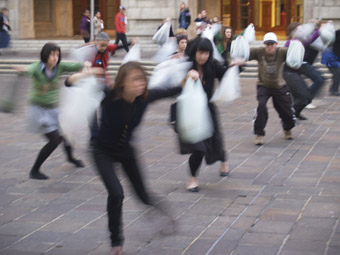
FOR HUNDREDS OF PEOPLE AROUND THE WORLD, TANK MAN TANGO: A TIANANMEN MEMORIAL (2009) WAS NOT SIMPLY ART, AN EXHIBIT, BUT A DANCE THEY LEARNED TO MAKE THEIR OWN, TO SHARE AND PERFORM COLLECTIVELY AS PROTEST, OR AS VIGIL, FROM INSTRUCTIONS ON YOUTUBE IN ENGLISH, CANTONESE, GERMAN AND MANDARIN. THE PROJECT GAVE NEW MEANING, DIMENSIONS AND FORM TO THE NOTION OF PUBLIC ART AND THE POSSIBILITIES FOR PROTEST.
Sydney-based artist Deborah Kelly recently won the inaugural James Cook University Screengrab New Media Art Award for Tank Man Tango: A Tiananmen Memorial. It has been shortlisted for the Sadler’s Wells Global Dance Contest, London, to be awarded by popular vote in November. The work featured in Kelly’s solo show at Adelaide’s CACSA (June 12-July 19), at Serial Space’s 649 (June 4-14) and at Screengrab (p23).
Kelly describes Tank Man Tango as “a monument, a memorial, on the 20th anniversary of the Tiananmen Square massacre, built of dancing bodies.” She is very specific about her intentions: “it’s for those who would remember; to give it shape, duration, experience and ritual. Against forced amnesia, it remembers the protests, and the murdered protestors, through that one person, the symbolic tank man. The work pays homage to courage, to fighting tyranny: and god knows, all our governments are bad. It hopes to bring life to history—our lives, and our history. Dancing this memorial is a way to be, to act, in a city or a town, to make a public sphere, to be an agent in it.”
The geographical distribution of the work is impressive. Kelly writes that “[Tank Man Tango] was made on June 4 in Perth, Brisbane, Sydney, Warrnambool, Daylesford, Hobart, Leipzig, Weimar, Bielefeld, Erfurt, Singapore, Mexico City, Melbourne, St Catharines in Ontario, Philadelphia, Auckland, Dunkerque, Belgrade, Athens, Richmond in Virginia, Bristol and in three different parts of Brussels. And maybe other places.”
Kelly had to accept that Tank Man Tango would develop a life of its own in other hands, some with different intentions: “I love that people accepted it as a gift—no, as their right. Many didn’t let me know they were doing it, many didn’t know an artist, or even a person, had made it. Many I have found by sleuthing—some had intentions very different to mine. Some strangers did it somewhere in the US and subtitled it Dancing on the Grave of Maoist Atheism (Jesus!). In Athens, the artists who took it up there seemed to frame it in an understanding that the protestors of Tiananmen Square were demanding capitalism. I realise I undermine my own will for the work by releasing it so freely that people can and have filled it with their own meaning. But that makes it all the more interesting to me; the work’s own disseminated autonomy means I get to understand it newly, over and over.”
If many people made Tank Man Tango by performing it, Kelly also pays tribute to those other makers, the many who helped her realise this unfunded project before it was even danced: Teik-Kim Pok who “taught the steps of the dance Jane McKernan choreographed”, Sumugan Sivanesan who “made the videos in all the languages” and many other contributors who provided space and equipment, translation, dramaturgy, institutional support, live streaming and those who acted as dance leaders. The thank you list reads like credits for a movie, a reminder of the scale of this dispersed, collective project. RT
–
Tank Man Tango, Deborah Kelly, June 4, www.forget2forget.net
RealTime issue #93 Oct-Nov 2009 pg. 2-3
© RealTime; for permission to reproduce apply to realtime@realtimearts.net
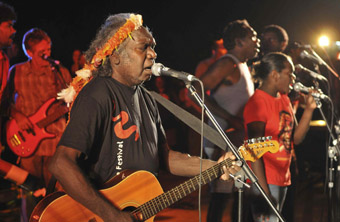
Mandawuy Yunupingu and Yothu Yindi Band, Garma Festival
courtesy Yothu Yindi Foundation
Mandawuy Yunupingu and Yothu Yindi Band, Garma Festival
PEOPLE WHO’VE BEEN TO THE FESTIVAL OFTEN REPORT HAVING A ‘GARMA MOMENT.’ NOW IN ITS 11TH YEAR, THIS EVENT ON YOLGNU LAND AT GULKULA—CLOSE TO YIRRKALA, NUMBULWUY AND THE MINING TOWN OF GOVE—BRINGS TOGETHER UP TO 2,000 PEOPLE IN TENTS AND ENDLESS FOOD OR SHOWER QUEUES, THERE FOR INDIGENOUS CULTURAL TOURISM OR BECAUSE SOME ASPECT OF THEIR LIFE INVOLVES INDIGENOUS MATTERS OF THE MOMENT.
In the latter case, they may be invited by the Yothu Yindi Foundation to contribute to the three-day forum at the heart of the event. As you may imagine, it’s such a rush of experiences, it’s significant when one stands out.
For me, that happened on a quiet backtrack leading from an open-air art gallery to a peaceful point where the escarpment drops suddenly away towards the distant Gulf of Carpentaria. Out of nowhere, eight local kids were walking towards me doing it all—yidaki (didjeridu), clap sticks, song and even some dance. This is something that gets turned on nightly for visitors on the huge ‘bunggul’ oval—traditional dances kicking sand up into the evening air accompanied by frenzied commentary. But here I was privileged to experience transmission of culture through the generations—itself a sub-purpose of the festival—quite spontaneously.
For Robyn Archer, there to make a keynote speech at the forum and to participate in Reconciliation Australia meetings, it was an experience which she delightedly described as “a blow job” from a senior Yolgnu man. She sat in the sand before him and his mighty yidaki, which she was told to place against her chest. He blew, all but sending her flying. And, as her body recovered equilibirium, she realised that the asthma that had been with her since arriving in Arnhemland, had magically cleared.
Earlier, Archer had given us the word of the festival—“detritus.” In her definition, this is “what’s left over after the creation process; ie the product, which shouldn’t be thought of as the end-product. For creative work is a continuum. And the best way to keep working usefully is to think of that product as detritus—for sale or review. The latter’s not a judgment; an artist takes what’s necessary from reviews, and keeps developing. An artist who doesn’t grow, doesn’t try new projects, or investigate new markets with each new work, is the equivalent of a cover band!”
To the Yolgnu in the audience, this was coals to Newcastle. For, of course, their ‘art’ had originally only been valuable to the extent that it performed a role in ceremony, after which it literally became detritus. Even since we gave them reason to achieve permanence in their painting, an Emily Kngwarreye could say “That’s pretty” about an eight-metre canvas, and leave it to the white art system to turn into ‘green’ ($100) notes—for she despised all inferior yellow or orange ones!
Emily had what we’d call an ephemeral attitude to her painting. But Robyn Archer worried, “We don’t protect ephemera in Australia. Our laws derive from the squattocracy, who fenced things and owned them. For them a book had a physical form they could respect; an idea or Indigenous culture has no physical form, no hierarchy, no celebrity.” It’s “ars nullius.”
But it’s there that the squattocracy, the last two Federal Governments and possibly even Robyn Archer are wrong. She bravely issued the battle cry, “The [Prime Minister’s] 2020 [Summit] get-together revealed a white search for a central role for the arts in ordinary life. Why not look at the Indigenous example?” We’re surely in danger here of confusing the ephemerality of the Indigenous arts and the absolute centrality of Indigenous culture.
Their culture’s physical form was stated simply enough by the use of the word “dig”, with all its earthy associations, by the siblings at the head of this year’s Garma—Mandawuy and Gulumbu Yunupingu. “Our past is what makes us tick”, said Mandawuy in a welcoming speech; “We must dig out the Yolgnu experience from the past to pass on to Australia today. Song, dance and painting is the vehicle for us to do that.” Gulumbu, the painter proffered, “People should listen to my paintings—dig in, they’re full of stories.”
This was the ur-text from Aborigines at the Forum—whether from Arnhemland, the Kimberley, the Desert or wherever. Everything comes from the land. “Art is what our ancestors left in this country”, declared Djambawa Marawili, clan leader and one of four Aboriginal artists at this year’s Moscow Biennale; “those patterns and designs, the culture and the names.” From the 1930s, he explained, illiterate Yolgnu had used art as “the only way of listing our country.” When the miners turned up to dig bauxite, the Yolgnu believed that their land was all documented in their paintings; something acknowledged by the courts, which then applied our law of terra nullius, and gave the land away.
In fact, it was only when Marawili pulled all the Yolgnu clans together to paint their Saltwater Country in detail, following a terrible desecration by crocodile hunters, that the essential link between land, culture and art was accepted by the courts. In the Blue Mud Bay decision, the Yolgnu gained 80% title to the intertidal zone. Their 2008 festival had celebrated that with a glorious sacred crocodile and fire dance.
But we give with one hand and take with the other. This year’s forum endlessly argued that the culture lay not where the Northern Territory and Federal Governments wanted it to be—in 20 designated townships across the Territory—but in the Homelands that are often remote from easily deliverable services. Waturr Gumana was scathing: “All our names and our arts come from nature in Arnhemland; it’s a stupid idea to take us away from that. And in the end, our bones have to be buried in our own estate.” Barayuwa Munungurr concurred, “You just can’t teach our culture in the wrong place—you’ll end up with the wrong songlines, the wrong kinships. And you can’t teach in the towns anyway—young people are so distracted by the crowding they don’t listen to their elders.”
And returning to Djambawa Marawili for a concept that even Minister Macklin might understand: “Walking in the fresh wind along the beaches of my homeland gives me strength.” So it was a great pity that the Minister flew all that way for a photo-op at Australia’s first Indigenous life-saving club, then turned her back on the forum, where she’d been scheduled to speak. Professor Marcia Langton did the same. It was widely assumed that their noses were put out of joint by local big man, Galarrwuy Yunupingu’s decision to turn against the Intervention, which he sees as causing change from a position of Indigenous weakness. For him the Yolgnu roots in the land from which all else flows are a source of strength.
Much else that the white side of the Indigenous Creative Industries considered important was also mentioned in dispatches, from philanthropy with an Aboriginal slant to resale royalties for visual artists; from the negligible policing powers behind the Code of Conduct for art dealers to a daring proposal for a National Indigenous Cultural Authority. Famous figures like Rhoda Roberts, Archie Roach, Wesley Enoch and Ursula Yovich popped up. Jack Thompson, as ever, was there. And Peter Garrett spoke good sense about “controlling the reception of indigenous art” and may even have gone home realising that his oddly mixed Ministry of Environment and the Arts is already an Indigenous concept; but he resisted the opportunity to sing. Mandawuy Yunupingu spoke and pulled Yothu Yindi out of retirement to sing a new Healing Place Song to the biggest gathering of the festival, telling us sadly how kidney dialysis plays a far larger part in his life today than touring with the band.
But none of that seemed worthy of debate beside the matter that Northern Territory Aborigines clearly cared about most intensely, their Homelands. That concern did afterwards lead to a three-man delegation armed with 27,000 signatures via Get Up getting to see Jenny Macklin in Canberra. On that occasion, delegation leader Barayuwa Munungurr summed up the importance of Homelands as “the place where we can live on the land that makes us who we are.”
Garma Festival, 2009, North East Arnhemland, Aug 7-11.
Jeremy Eccles was a speaker on a Garma Key Forum panel on “How well does the industry manage ethics and intellectual property rights” with Terry Janke, Lydia Miller, John Oster, Robert Collins and chair Damien Carrick.
RealTime issue #93 Oct-Nov 2009 pg. 4
© Jeremy Eccles; for permission to reproduce apply to realtime@realtimearts.net
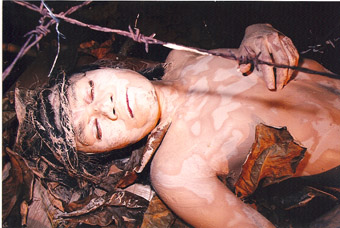
Bandung-based artist Kuncoro from JAKER, an underground art network ‘performing suffering’ at a community protest, Lampung, Sumatra Dec 2000
THE PAST IS A PERFORMANCE IN THE NOW (AND HISTORY THE STRUGGLE OF MEMORY AGAINST FORGETTING). THE PERFORMANCE WORK OF CONTEMPORARY INDONESIAN ARTISTS REQUIRES A TIGHT GRASP ON THE PAST, AND A LOOSE SENSE OF THE TERM ‘INDONESIA’ TO ALLOW FOR CENTURIES OF COLONISATION, CONFLICT AND CONTRADICTION. IN LIEU OF BEING ABLE TO TRAVEL BACK IN TIME, THE FOLLOWING OFFERS A FRAGMENTARY AND ANECDOTAL CHART OF WHERE CONTEMPORARY ‘INDONESIAN’ PERFORMANCE PRACTICE MAY BE RESIDING AND/OR HIDING.
In December last year I decided to ‘pulang kampung’, and journey back to the island of Java to gain a fresh understanding of performance and contemporary arts practice in this newly ‘democratic’ country. It has been 11 years since the overthrow of the dictator Suharto and less than a year since his death, a day celebrated by many of the country’s 220 million people. I embark armed with barely three weeks and a familiar wary sense of the Indonesian culture of jam karet (where time is relative to the elastic length of a piece of string).
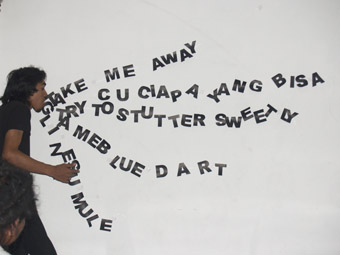
Mukmin Soge Ahmad (Indonesia) performing at Birds Migration Dec 2006, National Gallery, Jakarta
Yogyakarta is a good place to start and I am fortunate to land myself in the close-knit quarters of Nitipuranm an area populated by many artists, both foreign and local. I am given the directions to find Fitri Setyaningsih who lives not far from my friend Hestu. He draws me a map marking out along the way Sangkring (an artist-run gallery) and Rumah Panggung (a performance/rehearsal space). It should be straightforward except that there are two houses on the same street with the same number—urban planning in Indonesia is not well known for adhering to any system of order, least of all an order of numbers.
When I finally arrive at Fitri’s house I am greeted by seven dogs, all barking furiously, and all appearing to share a genetic line descending from the Alaskan Malamute. For a tropical climate and a predominantly Muslim nation, this is most unusual—though it is in keeping with the quietly unorthodox Fitri Setyaningsih. A contemporary dancer with a background in classical Javanese movement, Fitri works with objects and collaborates with a writer, Afrizal Malna, named in 2008 as Writer of the Year by Jakarta’s equivalent to Time Magazine.
Over cups of sweet Javanese tea, our conversation travels around the edges of contemporary performance culture in Indonesia, and finally settles on the situation for collective devising across art forms. The frustration expressed by Fitri and Afrizal arises from the lack of models for collaboration when working outside conventional art forms. How does a dancer work with a sculptor, a designer or a writer? Where are the local expressions and models for artist residencies and art form development and dramaturgy for contemporary performance practice emerging? Afrizal’s performance texts seem naturally to have inhered alongside the development of Fitri’s spatial performance idioms, more easily since they are also partnered off stage. Models for artform boundary crossing appear to have been more readily pursued in underground quarters where a rejection of the canon fused with a rejection of the new world order, catalysing a growth in ‘happening art’, ‘seni pertunjukan’, and laying the seed bed for emerging live art discourses.
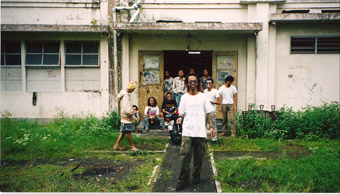
Old Indonesian Institute of the Arts
courtesy Rebecca Conroy
Old Indonesian Institute of the Arts
During my time in the late 1990s and early 2000s researching and squatting in the abandoned ISI (Indonesian Institute of the Arts), ‘performance’ seemed the answer to every occasion whether it was a protest, an art exhibition opening or a dinner party. These occasions blurred the easy lines drawn in the Western world between the estates of theatre, music and art. The common purpose was liberating art-making from the commodifying universe of the art market.
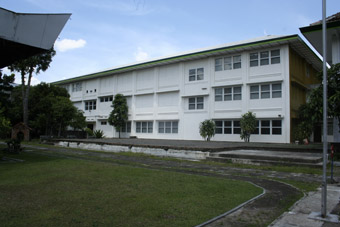
New Indonesian Institute of the Arts
courtesy Rebecca Conroy
New Indonesian Institute of the Arts
Now as I wander through the old squat, newly crowned the Jogja National Museum and run by the fresh Prince Nico (son-in-law to the sultan of Yogya), I am battling a surreal fog. The Prince, in casual slacks and polo shirt, invites me in for a drink to a room upstairs with a large flat screen TV, barely metres from the room that was once my bedroom shared with a number of other dreadlocked, tattooed romantic revolutionaries. The walls once heavily decorated with graffiti and poetry have been sanitised with a fresh coat of white with just one mural remaining in the downstairs lobby, a memorial gesture to a moment in time now reserved for the history books. Prince Nico pours me a Johnny Walker, Red Label. It is barely 11am. Not wanting to offend, and to prove his assumptions about my wild Western ways, I thank him and raise my glass. “To the revolution!”, my fading punk friend Yustoni Volunteero proffers. Typically of course, Toni is rarely serious.
It is a perfect irony that ISI, the once hotbed of radicalism suspected by the Suharto regime, became home to a ragtag collective of artist activists peddling a home-grown version of anarchist community politics, some real life international permaculture action and an uber cool street punk aesthetic which managed to catch the eye of many a visiting foreigner, myself included. They were the days of ‘seni untuk rakyat’ (art for the people). Now it seems that at least in this part of the Yogya art scene, having been bucketed by several waves in the boom crash opera of the international art market, many of my once starving artist friends have been able to purchase houses and, in at least one instance, expensive DJ equipment. The scene may be growing up, or at least their army of small children is.
There is still some nostalgia for the past world, the bit in-between, before the crest of the wave that dumped everyone on this strange new democratic island quickly followed by a succession of failed presidents. But some good things emerged as a result of the three decades of military repression. For one thing it could be said that it gave birth to a contemporary live art scene, spawned from a genetic line of art traced imperfectly from street performance to happening art to performance art to a version of what one could accuse the art institutions of accelerating before its time—Live Art. With ties to the blinded oligarchies of postcolonial fashions, truncated intercultural exchanges and the short-sighted international circuit training of biennales and festivals, Live Art in this country is grafting itself to the domestic scene in rather interesting ways.
When performance took to the streets in 1997 it did so out of a desire to overtly challenge the Suharto regime, which strictly forbade gatherings of people in public spaces that the military interpreted as “spreading hatred against the government.” Political critique had long since silently disappeared into the subtextual lines of the theatre estate, where the plays of WS Rendra, (who recently passed away), Nano Rianatiaro of Teater Koma and the poetry of Widji Thukul (‘disappeared’ in 1998) were frequently banned and their creators arrested. Street performances usually took the form of passionate orations, a ‘performance of suffering’, typically on street corners and most often during a mass mobilisation of students, peasants or factory workers. The script of the performance frequently invoked the hand of justice to intervene in the fate of the ‘wong cilik’ (little people), with frantic gestures demanding the whereabouts of justice or, with eyes averted, intimating the ignorance of the masses suffering under the weight of a brutal regime.
During this period hundreds of performance groups mushroomed, many of them germinated on university campus grounds, developing standard repertoires which they would perform at frequent interludes during mass assemblies of demonstrators. In the years after the events of May 1998, street performance or ‘happening art’ as it was frequently referred to by the underground scene, gathered a critical mass, while performance art, also emerging as a distinct practice within the counter culture gallery scene, started to gain international attention along with artworks of an explicit political flavour.
Three performance art/live art events in the past few years have been driven by persons and groups characteristic of three different threads or streams in the contemporary art scene. Perfurbance [see articles in RT73 & RT79] in its fourth incarnation in April 2008, is nurtured by performance artist Iwan Wijono and the Performance Klub based in Yogyakarta and largely connected internationally through a counter culture scene. Birds Migration in 2006 was an event which had its genesis in the Jakarta and Bandung gallery world and connected heavily to an international scene through the art market. Undisclosed Territory held three times since 2007 exhibits elements of the other two, driven by gallery-based performance and live art practioners but situated in Solo, Central Java, it also has strong links to an international, mainly European circuit of live art, and is directed by well-known performance artists Melati and Suprapto Suryodarmo.
Common to all these streams is the working outwards and against a prevailing domination of artforms aligned to the theatre, dance and visual arts estates in both the traditional and contemporary realm. Distinguishing between them is often harder, although it’s superficially done through geography and the political economy of art scenes. Generally, the further one approaches the centre, the closer one gets a sense of the awkward and imposing influence of the international art world and the gaps in local knowledge and appropriation. The further out one moves, in particular off the island of Java, the deeper one moves towards a more nuanced hybridity grounded less in the desire to ascend the discursive ladder and more in a desire to make meaning out of the everyday contemporary experience and rebuild a critical culture recovering from three decades of the New Order regime.
Along the periphery reside clusters of collective action, enveloped by the surge in DIY aesthetics driven in part by necessity and increasingly by the international style market and disposable cultures aping capitalism’s desire for the surface, including zine culture, easy access to technology and piracy’s easy access to everything else. Artist-led spaces and organisations, such as the internationally fettered and adored Ruangrupa (Jakarta), have for a long time understood the communion and commerce between such things, and pioneered fresh thinking, which has finally infiltrated the Biennale arena. In Yogyakarta, the discursive terrain is similarly taken up through project based groups and collectives such as MES56, Kunci and Taring Padi.
This October more than 30 Australian artists are descending on Yogyakarta for the South Project and in a nearby town, Salatiga, for Festival Mata Air, in the interests of creative exchange and collaboration across artforms. Both of these projects bear witness to the very real and active fascination Australian artists have for our nearest neighbour. Perhaps bound by a common desire for something grounded, live art and creative exchange is paving the way for a common past to be reimagined in the here and now.
Rebecca Conroy visited Yogyakarta in January 2009 on behalf of Performance Space, Sydney, where she works as Associate Director.
RealTime issue #93 Oct-Nov 2009 pg. 5
© Rebecca Conroy; for permission to reproduce apply to realtime@realtimearts.net
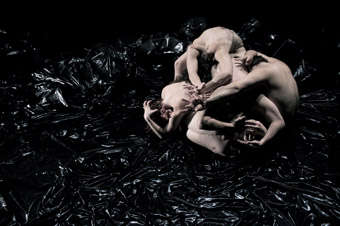
Black Marrow, Chunky Move
photo Alexandra Mein
Black Marrow, Chunky Move
THERE IS A SLICK OF MELTED BLACK PLASTIC SEEPING ONTO THE TARKETT IN THE CHUNKY MOVE STUDIO. ON ONE SIDE, THE WALL IS PLASTERED WITH BROODING IMAGES OF SKULLS, SHADOWY FIGURES AND DESOLATE LANDSCAPES. ON THE OTHER, A CLUSTER OF MOULDED PLASTIC HORSE SKULLS NESTLES AGAINST A PILE OF PLUSH DINOSAURS AND A TWISTED BLACK PLASTIC BACKBONE.
In the middle of this macabre scene, four barely clad dancers toil and sweat, contorting themselves into strange headless unions, sidling, scuttling, lumbering across the floor. French-Belgian choreographer Damien Jalet looks on. Icelandic choreographer Erna Omarsdottir works behind him with the actors Julian Crotti and Paulo Castro, observing them scuffle and clamber clumsily over each other’s back. The disparity in their heights makes for strange couplings; sometimes they are figures from myth or legend, at others they are bar room brawlers. A CD player quietly emits high pitched yips and grunts in Omarsdottir’s voice, mixed with squeaky, squelchy sounds and the noise of wind and water.
I am at a rehearsal for Chunky Move’s Melbourne International Arts Festival production, Black Marrow. Belgian fashion and set designer Alexandra Mein has just arrived with a suitcase full of black plastic and the Australian lighting and sound designers are due to join the team in a few weeks. This commission by Gideon Obarzanek, on sabbatical from making work on his Melbourne based-company, marks yet another left-field move from this unpredictable artistic director.
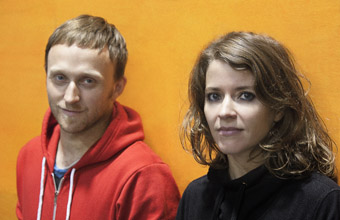
Damien Jalet, Erna Omarsdottir
photo Byron Perry
Damien Jalet, Erna Omarsdottir
Whilst Jalet and Omarsdottir have long been seen on stage together with companies such as Les Ballets C de la B and both have significant independent careers as dance makers, they are a relatively new choreographic team, having made just one film and two full productions together. Obarzanek was impressed by their first piece together Ofaett (Unborn) and the short film The Unclear Age, both created in 2005. He invited them to run a Choreolab professional development workshop at Chunky Move in June 2006. Discussions about a commission began immediately, but the pair’s busy schedules prevented them from even being able to come together to create another work in Europe for three years. In 2009 they created transaquania, a one off performance in Iceland’s blue lagoon for the Iceland Dance Company. The collaborators on this project were visual artists Gabriella Fridriksdottir and Raven, who worked on Ofaett, and Iceland-based Australian composer Ben Frost, who is part of the creative team for Black Marrow and who also composed for Chunky Move’s Glow and Mortal Engine.
“The Icelandic piece is related to this one”, Jalet tells me as we talk during a break in rehearsals. “If you stuck a stick through the Earth, you would connect Iceland and Australia”, Ormasdottir says. ”There is something untamed in both countries. You feel the power of nature, a moving energy, something very overwhelming. Of course there are a lot of differences too. Iceland is a young country. You can feel the earth moving under your feet. Australia is more ancient. But in both countries, people live on the periphery of a desert. The glaciers in Iceland are a kind of desert. It’s humbling. You feel how small you are as a human being. The earth could eat you up any minute. In both countries you can feel the origins of life. A lot of Iceland is a sort of primal soup. Here people still find huge dinosaur fossils scattered across the desert.”
These images of early life are visible in the choreography I observe both in the studio and in archival footage of their previous collaborations. There is a gravitational pull on bodies, a sense of the ground swallowing up limbs and forcing heads downwards, with a constant dragging force. There are a lot of mutant bodies, seemingly in transition from one species to another, sometimes part bird, lizard or fish. Dancers Carlee Mellow and Sara Black writhe together like starfish, all flailing arms and groping feet. “Keep your fingers alive”, mutters Jalet as he watches Black’s arms encircle Mellow’s waist in a parasitical embrace.
“We are exploring a kind of struggle for life”, Jalet says of the choreography. “Sometimes it looks like a primal conflict—deers butting…The bodies are defining themselves.” Alisdair Macindoe and James Shannon are locked in a deathly embrace, their vertebrae jutting as they bend their backs into impossible arcs. The combination of strength and precision required looks exhausting. Jalet and Omarsdottir are impressed by the Australian dancers, praising their hard work and commitment to this new vocabulary. The rehearsal days are long and the lead-up to the premiere at Malthouse’s Merlyn Theatre is unrelenting. Once Mein has started work in her studio, the performers will be creating the choreography in moulded plastic masks and costumes. A close look at the horse skull headpieces she has delivered, suggests the dancers will have to summon all their dedication to create in such suffocating apparel. I ask Omarsdottir whether the actors are contributing anything distinct to the work. She demurs. Whilst the choreographers have worked with Paulo Castro previously, they chose all the performers from auditions and are excited about the expressive range of the group.
We talk about the darkness of the imagery which inspires the production and both choreographers are eloquent in their concerns for the health of the planet. “In the last decade it’s incredible how fast we have destroyed nature. Every generation has this feeling of doom I am sure”, says Jalet, “but we are really sucking all the resources out of the earth. Oil, coal, ash and lava are the blood of the earth with oil at the end of the cycle. There is an energy of death in all of this.” “This is our fantasy of the end”, says Omarsdottir. “We are creating our mythology of apocalypse, our own rituals out of our fears and paranoia.” Whilst this all sounds extremely gloomy, both choreographers insist there is humour in the piece, and poetry. “We are not provoking for the sake of provoking. We are interested in creating something beautiful out of this horror, maybe not aesthetic, but beautiful in its own way.”
The way the artists finish each other’s sentences testifies to the bond they recognised as soon as they began to work together. “We are like brother and sister”, says Jalet. “We started to work on the material for this piece during Foi [a 2003 production by Les Ballets C de la B].” They share a highly theatrical and coherent vision for the work, which even in rehearsal focuses intensely upon visual detail. Omarsdottir has worked with artist Matthew Barney and fellow Icelander Björk. Jalet has worked with fashion photographer Nick Knight and designer Bernhard Willhelm. Despite these red hot collaborations, I suggest to the artists that their virtuosic work must leave them somewhere on the margins of contemporary trends in dance in Europe. “There are lots of taboos in dance it seems”, says Jalet, “People are less scared of feeling in music and visual arts. But we think that physical engagement is very important. Work can be conceptual and smart and physically and emotionally engaging. I like to be taken to a dark place in order to feel something and return to recognise the things I have all the more strongly.”
What Melbourne audiences will think of the dark place Jalet and Omarsdottir are taking them to remains to be seen, but from the moment the curtain rises on the post-apocalyptic setting of Black Marrow to the moment it falls upon the tangled bodies of the performers there will be no escape.
–
Melbourne International Arts Festival, Chunky Move, Black Marrow, CUB Malthouse, Melbourne, Oct 20-24
RealTime issue #93 Oct-Nov 2009 pg. 6
© Sophie Travers; for permission to reproduce apply to realtime@realtimearts.net
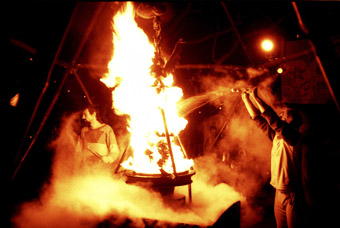
ACME/Splinters, Faust – The Heat of Knowledge, 1996
photo ‘pling
ACME/Splinters, Faust – The Heat of Knowledge, 1996
“YOU CAN’T HAVE THE WILDLIFE WITHOUT THE JUNGLE”, SAID BRUCE KELLER. FOR A FEW DAZZLING YEARS IN THE 1990s MANY EYES IN THE AUSTRALIAN THEATRE, DANCE AND PERFORMANCE WORLDS WERE TURNING TO CANBERRA.
The centre of attention was a brash young company called Splinters, recommended to us at The Performance Space by the late Bruce Keller who had been working in Canberra with theatre-in-education company Jigsaw. In 1992 I quit my plum PS job with no promise of anything other than a chance to be a part of the dark magic this company was to weave in Cathedral of Flesh at the Adelaide Fringe Festival.
That landmark work, voted Best Promenade Theatre of the 1992 Festival (mainstream as well as Fringe) by the notoriously prickly Adelaide Advertiser critics, marked the arrival of Splinters to a position of eminence and influence on the national scene. It was during one of these performances that a member of the audience was heard to exclaim, “How can something like this come from Canberra?” to which another replied, “It’s like this because it’s from Canberra!”
What I found in Canberra was an artistic landscape unlike anything I had imagined. Everyone knew each other and went to the same places and saw each other’s work: a real of sense artistic community impossible in as large and diverse a city as Sydney. As well as Splinters, there were three professional performing arts troupes the equal in their fields of any in the country: the Meryl Tankard Company, Kailash Dance and Skylark Puppet Theatre, as well as a thriving milieu of smaller companies and individual artists whose work was respected nationally. Most importantly, there was a real sense of engagement with and by the wider community. These companies and artists really mattered to a lot of people, and people mattered to them.
Yet by 1998 these companies were gone, and nothing remotely approaching their stature has ever arisen to take their place. Canberra is nowadays very well-ordered artistically, full of well-appointed arts facilities, attended by well-mannered patrons. There is some fine work being made, but the creative community that made Canberra for a few years the engine room of cutting edge work has dispersed, perhaps forever.
There are serious questions to be asked and there are lessons to be learned. In the intervening years, having given up my part in such doings, I have often wondered if what occurred was a unique product of the combination of people, place and time, or whether there is a deeper knowledge to be drawn out and used by others. If anything, in our lives as artists we have posed more questions than any of us can any longer make use of. At some point we have to answer to ourselves.
It is the loss of such artistic power that makes it important to examine why and how Canberra gave rise to such a flourishing: what were the conditions that supported it? Could such conditions be created again? And the dark side: where has this power gone? What has changed that might prevent it arising again? In a second RealTime article to follow, I will argue that while there were unique factors that made that period so brilliant, the prevalent structure of arts bureaucracies and peer-assessment funding has reached a stage of institutional sclerosis where it stifles the very thing it is supposed to support. Finally I will explore what has occurred in Canberra more recently and what prospects there are for the future.
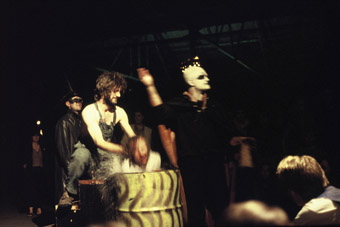
Ross Cameron, Stewart Vaskess, Anne-Marie Sinclair, Patrick Troy, Flowers of Gold, Bezerkii Carnival, Old Kingston Bus Depot, Canberra (1993)
photo Katherine Pepper
Ross Cameron, Stewart Vaskess, Anne-Marie Sinclair, Patrick Troy, Flowers of Gold, Bezerkii Carnival, Old Kingston Bus Depot, Canberra (1993)
It’s impossible to convey in a few words what Splinters was about, or to capture the essence of its many performances. In its heyday the company became known as Splinters Theatre of Spectacle, which highlights its trademark—seducing and overwhelming the audience through bravado, trickery, enticement and sheer audio-visual power. Examples: over the three nights of Guardians of the Concourse, commissioned by Robyn Archer for the 1993 National Festival of Australian Theatre, an army of marshalls wearing yellow raincoats and armed with light wands rounded up some 10-15,000 shoppers and passersby who ended up having huge gouts of flame shot over their heads from a giant motorised flamethrower, the Triclops. The effect was so powerful that the ACT Government was moved to install a commemorative monument several years later. Even more astonishing was the idea that Splinters could be commissioned with $20,000 to produce a one-off work in front of an audience of many thousands at that most bogan of events, the Summernats National Street Machine Exhibition, just a few months before being invited to produce a work for the opening of the 1994 exhibition 25 Years of Performance Art in Australia in the rarefied air of Sydney’s Ivan Dougherty Gallery.
Splinters’ work was underpinned by a distinctive open-ended theoretical framework that drew on the theatre of Grotowski, Artaud and Peter Brook, which led to the evolution of the company as a vehicle for immersive experience both for performer and audience. Even in its heyday, however, the massive major works were interspersed with performance in an intimate mode informed by the visual arts tradition. Several key members of Splinters were trained at the Canberra School of Art, where the presence of artist-performers such as Gordon Bull and the late Neil Roberts encouraged the crossing of genre boundaries and fostered the notion that all and any modes of creative expression could be used to create theatre.
The company was formed in 1985 by a group of former school friends David Branson, Patrick Troy, John Utans and Ross Cameron, with the aim of creating site-specific performance. I like to think of them as young Dragons, that being the Chinese year in which they were born, archetypally the sign of the free spirit: energetic, gifted, magnetic and full of grand plans. Troy, the principal writer and a key performer, says that the original inspiration came from their history teacher at high school who directed the creation of a Roman Carnival day for the whole school. The idea that a large group could be simultaneously audience and performers took hold.
To trace the environment of the time, I shared a few beers with the formidable Joe Woodward. Woodward has for many years refused to have anything to do with the arts establishment, preferring to teach drama in schools and run his own unfunded and uncompromising Artaud-flavoured company, Shadowhouse PITS. In 1981 Woodward and David Bates founded PITS (Pie In The Sky), a cabaret theatre-restaurant at the Canberra Rex Hotel, producing commercially-oriented shows to subsidise their experimental work. The Rex, of course, is famous for hosting visiting politicians and dignitaries such as US President Lyndon Johnson and then Vice-President George Bush Snr. The hotel is also notorious for the regular trysts many famous politicians had there, taking full advantage of Canberra’s thriving and later legalised sex trade, which PITS explored in George’s Peepshow, one of several productions that earned the company regular threats and abuse. PITS was a magnet for the likes of Troy and Branson, who Woodward remembers sneaking in to see shows while still under legal age.
Prior to this, the amazing Carol Woodrow had founded Canberra Youth Theatre in the early 1970s, Reid House Theatre Workshop, Jigsaw and then Fools’ Gallery, a touring vehicle for powerful feminist theatre in the mid 1980s that produced a number of significant theatre practitioners. These companies fostered local talent and brought many young theatre workers to Canberra, including physical theatre maestro Stephen Champion and Renald Navilly, both of whom later collaborated significantly with Splinters.
Alongside these are names from before my time, like performance groups Grotesqui Monkey Choir and Red Weather, and Don Asker’s Human Veins Dance Theatre, later to become Meryl Tankard’s company. These companies (I am told) produced distinctive, visceral and intelligent work. The intellectual aspect of the Canberra scene is perhaps epitomised by Boris Kelly and Monica Barone’s People Next Door, which also worked extensively with Neil Roberts to explore the boundaries between the visual arts and theatrical traditions. Barone had started out in Canberra Youth Theatre, as had Roland Manderson who later directed the company 1991-97 and was director of the Festival of Contemporary Arts in 1999.
In those carefree days when artists could live on the dole with the tacit blessing of the CES, public liability was a term perhaps used to describe a former lover, and economic rationalism was a demon child festering in John Howard’s basement, great things were being made in Canberra and elsewhere which spoke to the broader community. Where did it go and how can we work to make it happen again?
Gavin Findlay worked for many years as a professional musician and administrator (Tasmanian Symphony Orchestra, The Performance Space, Splinters, Australian Choreographic Centre, Canberra Youth Music) before he grew up and got a proper job, which he kinda regrets.
RealTime issue #93 Oct-Nov 2009 pg. 8
© Gavin Findlay; for permission to reproduce apply to realtime@realtimearts.net

Burning Dayight in Zurich 2007, Marrugeku
photo Christian Altorfer
Burning Dayight in Zurich 2007, Marrugeku
BURNING DAYLIGHT, A MAJOR DANCE THEATRE WORK FROM INTERCULTURAL PERFORMANCE COMPANY MARRUGEKU, HAS HAD A VERY LONG GESTATION, INCLUDING A COUPLE OF PREMATURE APPEARANCES, OR “AVANT PREMIERES”, AS ARTISTIC DIRECTOR RACHAEL SWAIN CALLS THEM, ALONGSIDE HER OWN VENTURE INTO MOTHERHOOD AND THE DEVELOPMENT OF NEW WORKS—FOR BOTH MARRUGEKU AND STALKER, OF WHICH SWAIN IS ALSO AN ARTISTIC DIRECTOR.
Not surprisingly, when I phone Swain, she describes her current state as “crazy.” 2009 has been a year of working “on the floor”, she explains, while “2008 was at the desk”, organising tours and doing preparatory work for 2009. “That’s how it works now”, Swain declares with just a hint of ambivalence, “some years on the floor, some not.” This is not surprising given the scale and international ambitions of her productions.
Burning Daylight will achieve its apotheosis in Broome in late October and then tour to Perth, Melbourne, Sydney and Hobart in November. Before that Swain is developing Shanghai Lady Killer for Stalker, with film director Tony Ayres among her collaborators, and pulling off Marrugeku’s first International Indigenous Choreographic Workshop in partnership with Sydney’s Critical Path choreographic laboratory.
Swain established the Marrugeku Company in 1994 with the particular aim of engaging with both Australian Indigenous culture and an enlarged vision of performance entailing dance and multimedia. Mimi (1996) and then Crying Baby (2001) were developed with traditional Aboriginal communities in the Northern Territory and successfully performed there, around Australia and overseas. For Stalker, Swain directed Incognita (2003) and was commissioned by the European Capital of Culture to create Sugar, an intercultural dance project, in the cities of Marseilles and Liverpool in 2006-07.
Since I saw an early work-in-progess version of Burning Daylight in 2005, the work has had two more developments in Broome, including the shooting of three short films (by Warwick Thornton, director of Samson and Delilah), which are integrated into the work. An ‘avant premiere’ was staged for the 2006 Shinju Matsuri Festival in Broome and a documentary on the making of the work was screened on ABC TV. Burning Daylight would have been fully realised earlier than late 2009, says Swain, but for a shift in funding timelines in WA and the collapse of plans to tour Europe in 2007. Nonetheless, it was performed in the ‘avant premiere’ version at the last of Maria Magdalena Schwaeggerman’s Zurich Theatre Spektakls where it was well received. The final realisation of the work has been aided by the West Australian Government’s Department of Culture and the Arts’ new Major Production Fund, Ignite.
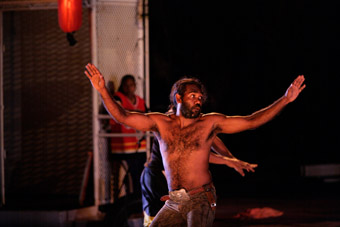
Trevor Jamieson, Burning Dayight in Broome, Marrugeku
photo Rod Hartvigsen
Trevor Jamieson, Burning Dayight in Broome, Marrugeku
Swain describes Burning Daylight as having three main stories. “Set outside a karaoke bar the show reflects the first story, the contemporary reality of the young in Broome, late night Thursday or Friday or Saturday on the streets. The karaoke video screen reveals a second story, the history of the town, with the onstage characters portraying their grandparents—a world of the White Australia Policy and forced removals.” The third story, she says, “emerges between street and screen…a ghostly present.” She felt this ghostliness as palpable during the development of Burning Daylight in Broome where “the shadow of the testing of a Native Title land claim had a big effect on the community, and on the storytelling and dance in the show. It meant that we were not allowed to work with the traditional stories of the Indigenous community. So, the ghosts came out, an implicit dialogue about what haunts Indigenous people when land and story are lost.” She says this can be felt strongly when Trevor Jamieson and Yumi Umiumare perform the Ikebana Tango while the screen reveals their grandparent lovers: a stockman and a geisha (Japanese pearl divers have played a significant part in Broome’s history).
Swain says that alongside modern Broome, Burning Daylight evokes the older town, once regarded as “an Asian wild west”, and characterises Thornton’s contributions as “karaoke noodle western videos.” The contemporary aspect will be heightened with music by MC Dazastah of Perth-based hip hop crew Downsyde. As well as Trevor Jamieson (of Ngapartji Ngapartji) and butoh dance performer Yumi Umiumare, the cast includes Sydney dancer Kathy Cogill, Sermsah Bin Saad (Suri), a So You Think You Can Dance finalist, and Broome-born dancer Antonia Djiagween.
Compared with its antecedents, Burning Daylight has become, like Broome itself, a more cosmopolitan mix of collaborating artists. I asked Swain how this came about. After the tours of Mimi and Crying Baby, Swain explained, she found herself wondering about European expectations of Aboriginal dance, particularly in northern Europe where there was “a lot of hype around traditional dance. I wanted to make something more playful and diverse, to say, ‘this is contemporary aboriginality, cosmopolitan and global, but with a deep connection to the land’.” To break from stylistic constraints, Swain invited West African artist Serge Amié Coulibaly (founder and Artistic Director of Faso Danse Theatre, based in Ouagadougou, Burkina Faso and a collaborator with Belgium’s Les Ballets C de la B) to “workshop a new way for Marrugeku”, with what was essentially a new company in a different community, Broome, “to join the dots between Aboriginal dance and contemporary performance.” It was an opportunity “to reconceive the intercultural process. It took Dalisa Pigram and I two years just to get our heads around the piece and how to realise it in the much more hybrid context of Broome. It took a long time and was like learning a whole new language. It felt like a beginning, a new beginning for Marrugeku.” Pigram, a performer and founding member of Marrugeku comes from the Yawuru people of the Kimberley, and is co-choreographer of Burning Daylight with Coulibaly.
In RealTime 92, Bangarra Dance Theatre’s director Stephen Page asked where were the other dance opportunities for Indigenous artists outside his company. Marrugeku is addressing the issue in several ways: in its own productions, through a dance laboratory and in a training workshop for 10-20 year olds culminating in a production, Buru. The International Indigenous Choreographic Laboratory is a three-year project that Swain considers a logical extension of Burning Daylight. Curated by Swain and Pigram it’s inspired by an “empowering West African-European model that embodies resonance and difference.” Serge Amié Coulibaly will lead the first workshop in October, which includes Indigenous Australian and Maori participants.
Buru will be a new Marrugeku production in 2010 coming out of training workshops for 10-20 year old Indigenous participants gathering across their school holidays. There’s also a solo work for Dalisa Pigram in development and Swain is hoping a new Marrugeku work for adults might emerge from this year’s Choreolab to be worked on in 2010.
As for Burning Daylight after its Australian tour, Swain says, “It’s difficult to know in a global economic recession. US festivals are keen but often don’t know their budgets until very late.” In the meantime, development and diversification are firmly on the agenda. She welcomes the prospect of having a smaller work like Pigram’s in development, given “the enormous amount of time and the expense of working in remote communities on the big projects. We need a broader portfolio.”
Swain’s personal life, sometimes “a big juggling act”, she says, but inseparable from her art, has changed significantly since the earliest incarnation of Burning Daylight. Two weeks before the first ‘avant premiere’ of the show she gave birth to a daughter, Jade Jet, who arrived on schedule and, four days later, Swain was back in rehearsal. Resonating with the show’s local culture cosmopolitanism, the child’s grandfather, of Chinese descent, was born in Broome and her great grandfather had lived there too.
Marrugeku, Burning Daylight, Mobile States tour: Goolarri Outdoor Venue, Broome, Oct 28-31; PICA, Russell Square, Northbridge, Perth, Nov 4-7; CarriageWorks, Sydney, Nov 11-14; Arts House, Meat Market, Melbourne, Nov 18-21; Princes Wharf, Hobart, Nov 25-28; Performing Lines, www.performinglineswa.org.au
RealTime issue #93 Oct-Nov 2009 pg. 10
© Keith Gallasch; for permission to reproduce apply to realtime@realtimearts.net
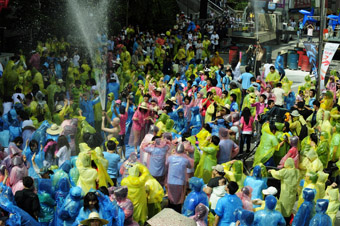
Opening Ceremony
photo courtesy Chuncheon International Mime Festival
Opening Ceremony
THE VERY EXISTENCE OF THE CHUNCHEON INTERNATIONAL MIME FESTIVAL AND ITS HUNDREDS OF PARTICIPANT PERFORMERS, MOSTLY FROM ACROSS EASTERN ASIA, IS AMPLE IF SURPRISING EVIDENCE (TO AN AUSTRALIAN LIKE ME) THAT MIME IS STILL ALIVE AND WELL. BUT ALTHOUGH THERE WERE EXAMPLES OF THE FINE ART FROM MARCEL MARCEAU-TRAINED EXPONENTS, HYBRIDITY ABOUNDED—MIMES WORKING WITH MAGIC, CLOWNING, JUGGLING, DANCE, RITUAL—AND NOT A FEW WORKS SIMPLY PASSED AS FINELY HONED MOVEMENT-BASED CONTEMPORARY PERFORMANCE.
Chuncheon’s mime festival is famous for the many acts that populate the small regional city’s streets for over a week, climaxing in an all-nighter. Unfortunately, the suicide of a beloved former Prime Minister required the cancellation of the street performances and the redirection of visiting performers into workshops. Over four days I managed to experience a variety of work. I had to leave before the all-nighter but with a strong desire to see a complete festival, on the streets, in the near future.
A city of modest size, ringed by high hills and lakes, Chuncheon is a couple of hours north-east of Seoul. The centre of this year’s festival was a small, new shopping plaza, open to the weather and complete with restaurants and cinema. The cinema foyer was the ideal location for Australian artist Jordana Maisie’s magical human scale kaleidoscope, The RealThing, passersby puzzling at and ‘dancing’ to their multiplying refracted selves (RT 87, p33).
A stage at the centre of the plaza was the site for a number of free performances enjoyed by inquisitive families. The highlights in the session I saw were provided by two Japanese artists.
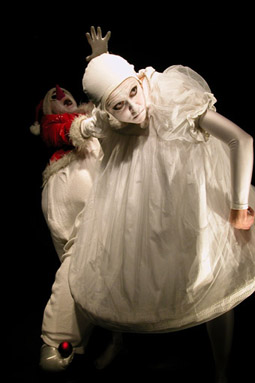
Astronomy for Insects 70, blackSKY white
photo courtesy Chuncheon International Mime Festival
Astronomy for Insects 70, blackSKY white
Jidai’s Witch Clown, a stooped, hooded European medieval character with a very long nose, a big wart to one side, is calculatedly ingratiating, countering her mocking of the audience with moments of comic self-deprecation and an ironic attitude to the art of mime. First, in a facile display of power, she stages a savage battle between her familiars, a pig and a lizard, both toys. She then attempts to fly on her broomstick but it weighs a ton, until a small balloon gives it a short-lived lift. Later, while miming a scary, seductive feminine self she’s shocked to find she has no breasts (Jidai is male) and then loses her nose. The dynamic in the swings between smug condescension and moments of failure and panic is deftly sustained in this half-hour performance.
The other Japanese performer, Chiemi Kyomoto, opens her performance as one of those appalling living statues, seen too often in public places. She’s a silver-masked, puppet-like woman who wears a rose that goes limp, has a hand that falls off and finds herself trapped in another mask beneath the first. Removing it, she then ‘cleans’ the fourth wall and is surprised to see us. Now she transforms into a ballerina-cum-balloon-sculptor, parodically dancing a dying swan while dextrously sculpting a balloon version of the bird. In a third phase, she uses a life-size male dummy to create a wish-fulfilment love story for herself that turns comically bad. Underpinned by mime, dance and modest skills in illusion, Chiemi Kyomoto’s clowning is refreshingly idiosyncratic.
The opening event was on a vastly different scale from these intimate showings, running some three to four hours on a warm Saturday afternoon in front of a new department store on a street adjoining the festival plaza. At one end of the street a female trio from a French aerialist company, Compagnie Retouramont, with the assistance of a huge crane, hoisted themselves on high, engaging in lyrical solo swings and rolls and then interlocking trios to the instruments of the air (recordings of flute, didjeridu, accordion), all very slow motion and low on dynamism, like watching spiders doggedly moving about a web. The tone was about to change at the other end of the street as the crowd swelled. Atop the fully extended ladders of two large fire engines were mythical figures, gods of fire and water (I assumed), wearing large head pieces and flowing robes and issuing roaring challenges and declarations via head microphones.
On the road below was a dancing Japanese performance artist, Oikado Ichiro, who, after discarding his long white robes, ignited a two-metre wide roller which he pulled after him. A gang of young men burst through the crowd with extinguishers and dowsed the flaming roller and then the crowd before heading back to the site worked by the aerialists. There, a tuxedoed conductor directed an orchestra of sweepers and carriers who sloshed the street and shop facades with water, the brooms scratching their way towards the gods on their fire engines.
A surprising addition at this point was the appearance of two giant two-metre-tall baby dolls (created by Hamish Fletcher of Australia’s Men of Steel) who wobbled their way down the huge sheet of an undulating blue plastic ‘river.’ There was no holding back the crowd eager to touch and photograph the babies close-up. Swept into the fray I was saved by a water spray from a fire hose on top of a nearby building and then, from other roof tops, by a shower of hundreds of plastic, yellow, pink and blue raincoats—diverting the crowd from the babies before more water flooded from above. Soon the street was a riot of colour and moisture and fumes.
From an underground carpark an army of young people carrying two long timber rafts, waving banners and pounding drums stormed onto the street. Riding the high rearing rafts in a sustained ritual war of words and provocative moves were the two gods. Then in the late afternoon, the crowd, still excited, danced with the drummers before drifting away. The festival had begun: comic, epic, diverse and participatory.
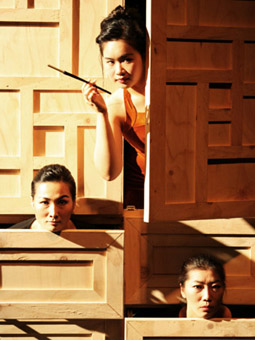
The Maids, Sadari Movement Laboratory
photo courtesy Chuncheon International Mime Festival
The Maids, Sadari Movement Laboratory
The variety in the program’s evening peformances further amplified the sense of the festival’s diversified focus on mime. In the Bomnae Theatre complex, a co-production between Korea’s Sadari Movement Laboratory (their production of Buchner’s Woyzeck is in Adelaide’s 2009 OzAsia Festival) and the Macao Cultural Centre yielded an intriguing rendition of Jean Genet’s The Maids. A cupboard (“a closet that symbolises the space that confines [the maids’] egos”; program note) stands mute centrestage. A drawer slides open, the head of a maid appears; from another drawer, the other maid. Later they open the cupboard doors to reveal Madame, their youthful employer. At one point, they dance beneath her dress, turning her momentarily into the doll-like puppet of their fantasies. Later they undress her to reveal sagging old age. The limited space heightens the play’s already claustrophobic intensity while the truncated appearances of the performers lends them the fatalistic air, for all of their machinations, of manipulated puppets. When one of the maids is locked out of the cupboard the panic is palpable. The performers’ dexterity at working extremely constricted spaces was truly impressive.
Japan’s Imuro Naoki Mime Company, who apparently trained with the late Marcel Marceau, performed Follow the Arrows, a tightly choreographed, whimsical tale of lost opportunities for love, rich in comic coincidence. Simple props—newspapers, arrow shapes—became magical and bodies swirled and tumbled about evoking a great range of locations and states of being. My initial resistance to the sometimes endemic cuteness of this kind of classically informed mime gave way to admiration for the production’s inventiveness and rich sense of humour.
Close to midnight, as I was about to leave the Bonmae Theater, I was whisked into a small, darkened, packed studio to witness a female shaman, elaborately costumed in flowing silks, reeling about, snatching paper money and tugging resisting female associates, while three traditional musicians generated a hypnotic pulse from flute, drum and cymbal. The Seoul Jinogee Gut ritual is apparently an exorcism ritual focused on the relationship between the living and the dead as they are separated and the passage of the dead to the otherworld.
In the second part of the ritual, before a table loaded with fruit and vegetables, the shaman’s associates unfurled a long strand of gauzy material and held it taut at chest height while the shaman pushed, shearing through its length, collecting the paper money resting on it and tucking it into her headband and clothing. She then appeared to ‘become herself’, speaking fluently and distributing the offerings on the table to the audience. A naive witness, I was taken by the raw theatricality, beauty and unpredictability of the ritual.
A contemporary, shaman-inspired performance followed, titled Hyang (Incense). Four musicians established a sonorous percussive hum in the dark while a small, blurred circle of red light danced on high and then down at our feet. A soft stage light revealed the source as a bundle of glowing incense before which sat a woman in prayer. Behind her, emerging from the dark, two hands danced from the wrist with increasing speed and acute articulation only to disappear and be replaced with the soles of two feet that moved with a similarly remarkable if more lyrical fluency. When the performer (revealed to be the festival’s director Jin-Gyu Yu) stood, he and the woman reached for the incense as the stage light cut out. What ensued was an entrancing dance in the dark of expiring incense sticks, long red lines sketched and evaporating across the black as our sense of height and distance dissolved amidst the enveloping music.
A festival highlight was the Moscow-based blackSKYwhite’s Astronomy for Insects 70, a nightmarish epic (only an hour, but in dream time), directed by Dimitri Ariupin. It’s wordless and almost impossible to describe let alone interpret—an episodic, discontinous fantasy (to an apocalyptic surround sound score) framed by 10 tall internally lit columns and a huge mutating door, collectively evoking a temple or sci-fi palace. A woman in a wheelchair managed by two bald, wide-eared giants in squarish white suits is wheeled on. This disabled figure, a recurrent image in the work, is helpless but also vigorously rejects massage and manipulation, especially in a late episode where she turns viciously on an eccentric Santa Claus who has given her legs. In between, among others, there’s a protracted scene with another kind of woundedness, a soldier in a state of psychological and physical dissolution (his weakening legs an elaborate dance of death), the music evocative of early 20th century conflict between Germany and Russia. There’s no literal mime involved, but the evocation of crippled being, physical decay and a recurrent motif of delicate bird-like movement are evidence of advanced skills of mimicry. The London Times aptly wrote of “diabolically pixilated human animation” when the work was presented at the London International Mime Festival.
Australia’s Men of Steel, working on a relatively tiny scale, presented a fantastical, intimate adventure experienced by two ‘puppeteered’ gingerbread men cookie cutters. In encounters by turns vicious and comic, the men grapple with fruit, doughy selves and bloody sprays of tomato sauce, enter a broccoli forest and are Star Trekked into outer space by a portable gas cooker. The company battled bravely with a huge venue, the Chuncheon Puppet Theatre, and restless hordes of the tiniest of tots, but never faltered. Men of Steel, Jordana Maisie and Strange Fruit comprised the Australian component of the festival, part of a larger program of artists, including Snuff Puppets, in Korea in May with the support of the Australia Council for the Arts and with more visits on the way.
A forum in the festival addressed “Activating Critical Writing for Interdisciplinary Arts and Building a Network.” The brainchild of Kyu Choi, the festival’s deputy artistic director, it brought together organisations feeling a need for joint action to raise the level of critical commentary and build audiences for the hybrid arts. Visiting Australia for Time_Place_Space in Brisbane earlier this year, Kyu Choi was taken by RealTime as a possible model for promoting interdisciplinary practices and so invited me to come to Chuncheon to talk about the magazine’s evolution and functioning. Attending the forum were In Ja Im (Marginal Theatre Festival), Sung-Hee Kim (Festival Bom), Baek-Gi Kim (Korea Experimental Arts Festival, run by KoPAS, Korea Performance Art Spirit), Jung-Ja Bae (Physical Theatre Festival), Doo-Eun Choi (Nabi Arts Center, a new media arts organisation with an international, collaborative program), So-Yeon Kim, a theatre and interdisciplinary arts critic (one of the few apparently), and from Arts Council Korea, Hae-Young Jung. Also present were Bo Young Lim from the Australian Embassy, Erik Kuong, Macau’s first independent producer and associate of the Macau City Fringe, and Catherine Lau, administrator of the Hong Kong Fringe Club.
Each of the festival directors spoke about the challenges they faced as their artforms hybridised, audience expectations changed, reviewers failed to connect and works went undocumented. The forum represented a first step in identifying shared needs and discussing the possibility of action. It certainly gave me some insight into the organisations and a desire to see them at work, not least those like Nabi Arts Center and the intriguing Korea Experimental Arts Festival that have Australian connections. The opportunities for exchange, collaboration and co-production have great potential. Thanks to a Chuncheon Mime Festival initiative, Jordana Maisie has been part of the Korea Arts Council-funded Moving Space Project, working on Time Slices with Young-Ah Noh (aerial and physical theatre artist, Korea) and Matthias Erian (sound designer, Austria).
Although I only saw a portion of the 2009 Chuncheon International Mime Festival, I was struck by its intimacy, intensity, inventiveness and collaborative spirit. The festival’s friendly staff and the huge army of amiable, efficient volunteers, many of them arts students from across the country, made the visit additionally pleasurable, as did the town’s relaxed mood, lively markets and new food experiences. Mime is alive and well in this festival, if adapting and evolving and eager for a matching critical responsiveness.
Keith Gallasch was a guest of the Chuncheon International Mime Festival. Thanks especially to Deputy Artistic Director Kyu Choi.
Chuncheon International Mime Festival, Korea, May 24-31, www.mimefestival.com
RealTime issue #93 Oct-Nov 2009 pg.
© Keith Gallasch; for permission to reproduce apply to realtime@realtimearts.net
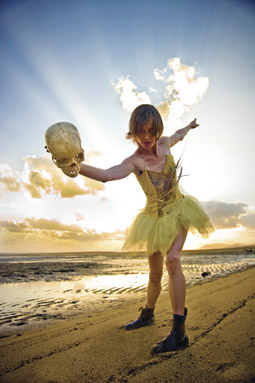
Rebecca Youdell, Bonemap
photo Russell Milledge
Rebecca Youdell, Bonemap
THE 2009 ON EDGE PERFORMANCE FESTIVAL INCLUDED NEW WORKS FROM BONEMAP AND ZANE SAUNDERS, A DANCE EVENT, STREET PERFORMANCES, GALLERY SHOWS, LIQUID ARCHITECTURE AND AN INDUCE WORKSHOP PROGRAM WHICH INCLUDED ARTIST MENTORING, A REALTIME WRITING WORKSHOP AND A WELL-ATTENDED FORUM ON HYBRID ARTS PRACTICES WITH GUEST SPEAKERS DAVID WILLIAMS OF VERSION 1.0, MEDIA ARTIST AND CURATOR JENNY FRASER AND JACKSON CASTIGLIONE OF PERTH’S PVI.
The festival highlight was Cairns performance group Bonemap’s Whispering Limbs, a collaboration with the members of Brisbane-based Polytoxic (Lisa Fa’alafi, Efeso Fa’anana, Leah Shelton) and Aboriginal dancer Earl Rosas who has worked with Chunky Move, Aboriginal Dance Theatre and the Australian Ballet. His was a powerful presence that framed the work, carrying a fish in a large glass bowl on his head, doubtless representing the fragility of our relationship with nature and the Aboriginal guardianship that has been for so long ignored and denied. Other images were ironic: a raincoated trio copiously leaking valuable water; a man dragging a ‘For Sale’ chunk of lawn, which he meagrely waters before giving away a precious slice to a member of the audience; and Rebecca Youdell’s memorable ballet brat in tutu and Blundstones—culture with Australian affront and a bouquet of dead weeds. Moments when all the performers come together are particularly strong and underline the collective power of the work which is reinforced by Russell Milledge’s sweeping diorama projections that reveal the performers in an almost gothic natural world, and by Steven Campbell’s percussive electronic score, mixed live. This was a work I saw twice, admiring its cogency, dynamism and the Bonemap-Polytoxic merger, and hoping Whispering Limbs would have another life beyond the festival.
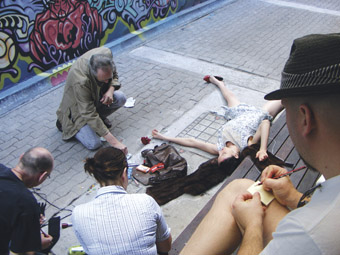
LAPS (Live Art In Public Space)
courtesy On Edge
LAPS (Live Art In Public Space)
One of the midday street performances (LAPS, Live Art in Public Space) was set up like a movie shoot in a narrow lane with two ‘dead bodies’ and potential clues littered about. The audience attached post-it notes to the objects and the bodies, on which they wrote, with a mix of wit and TV-informed savvy, the likely meanings of the forensic evidence.
The other major festival work was local artist Zane Saunders’ performative installation, Blueprint. It was strongly sculptural, as you’d expect of Saunders, presented with a live art informality and included some vigorous dancing as well as delicate moments when Saunders’ quiet presence took centrestage. An evolving work created with extremely limited rehearsal time, Blueprints generated strong if elusive images that spoke even more strongly than Whispering Limbs of the necessary guardianship of the land, in this case by fire management.
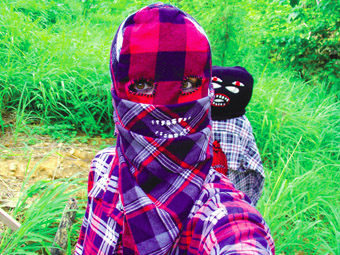
Combat Drag (video still), 2008, Jemima Wyman
images courtesy the artist and Milani Gallery Brisbane 2009.
Combat Drag (video still), 2008, Jemima Wyman
Striking video works by Jemima Wyman were on show at the KickArts gallery, alarming some of the locals (if the guest book was to be believed) with eerie images of masked figures—young men playing ‘terrorists’ in the bush in balaclavas and with sticks for guns, and on another screen sinister glove puppet figures. Victoria Carless wrote about the show in the RealTime writing workshop: “This work disconcerts by skewing the familiar. Cultural symbols, ideas about identity and images of extremism trip over each other” .
Jenny Fraser’s Big Eye Animation program (RT 91, p26) was on show at Mofo Gallery, William Duckworth & Nora Farrell’s (US) wi-fi Media Garden featured at KickArts (when you could connect), and video images from Beth Shorter’s Peripheral impressed at the eccentric Digital is the new Analogue show at Crate59 gallery where Liquid Architecture artists vibrated the corrugated iron roof until rusty fragments fell lightly.
It was a pleasure to experience On Edge, to meet artists we rarely see and to enjoy the intense discussions about the works in the festival and where they fit in the bigger arts picture. The Induce program, organised by Nicholas Mills, formalised and heightened the sense of exchange of ideas and information that comes with a festival. On Edge continues to be an admirable rarity, an Australian festival of contemporary performance and media arts.
Bonemap and The House of Falcon, On Edge, Contemporary Media + Performance, Cairns, July 3-18
RealTime issue #93 Oct-Nov 2009 pg. 14
© Keith Gallasch; for permission to reproduce apply to realtime@realtimearts.net
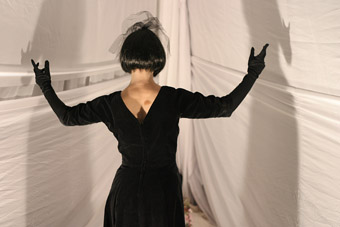
Leaky Heaven
photo Tim Matheson
Leaky Heaven
THIS ARTICLE SHOULD HAVE BEEN A CELEBRATION BUT I FEAR IT WILL BE MORE OF A EULOGY. SHORTLY AFTER WINNING RE-ELECTION IN MAY 2009, THE GOVERNMENT OF BRITISH COLUMBIA SLASHED FUNDS TO THE BC ARTS COUNCIL (BCAC) BY 40%. THEY FOLLOWED THIS UP IN AUGUST BY WITHDRAWING ALL FUNDING TO ARTS AND CULTURAL ORGANISATION DISTRIBUTED THROUGH THE DIRECT ACCESS PROGRAM, WHICH USES REVENUES GENERATED FROM GAMBLING TO SUPPORT GOOD CAUSES. POPULARLY KNOWN AS “GAMING”, ITS CONTRIBUTION TO THE ARTS SECTOR FAR OUTSTRIPPED THE TOTAL BUDGET OF BCAC AND WAS, INDEED, THE LARGEST ARTS FUNDER IN THE PROVINCE.
Saved from the axe were a small percentage of companies with three-year funding commitments, although the Government originally wanted to pull the plug on them as well. The news gets worse: if the government follows through with plans outlined in their recent draft budget, provincial funding for the arts is projected to be down to $2.2 million by 2010/11. $2.2 million for culture in one of the richest provinces in the country, with a population of approximately 4.5 million.
The history of Vancouver theatre is ultimately defined by funding. While this might sound like a self-evident truth, I do believe that the traditionally meagre subsidy and the way it was delivered supported a unique flowering of creativity and risk-taking in Vancouver theatre. This flowering was, I suggest, wholly unexpected given the circumstances—and a credit to the individuals responsible—but like an exotic bloom it was vulnerable to changes in conditions and we may have just seen it pulled up by the roots.
I should be clear. The arts have always been starving in Vancouver. While the city prides itself as being home to the largest percentage of “cultural workers” in the country (it also has the largest homelessness problem, but it’s not clear if those two things are somehow linked), cultural assets have always taken a back seat to parks and community centres. It is a city that prides itself on inclusion rather than excellence and as a consequence has never made the same critical investment in cultural infrastructure that cities such as Montreal and Toronto have. Toronto, for example, made a decision to invest in its theatre infrastructure in the 1970s, a decision still paying dividends not just in the level of activity but also the place that theatre occupies on the cultural landscape. Toronto is a theatre city because a decision was made that it should become one. Indeed, it could be argued that Vancouver lags behind other major Canadian cities, including Calgary. When that city hosted the Olympics in 1988, a new performing arts centre was built. When Vancouver—a city with twice the population—hosts the Olympics (which take place in 2010) not a single cultural asset will have been created.
In Toronto, there is a network of mid-sized theatres able to support and train new and emerging artists through mentorship programs and the sharing of resources and space. There is no equivalent in Vancouver. What is termed ‘independent’ theatre—that is everything below the two major ‘regional’ companies, the Vancouver Playhouse and the Arts Club—are without venues. I would like to stress this: some of the most accomplished, professional theatre companies not just in Vancouver but in Canada do not have dedicated theatre spaces. This includes companies such as Touchstone, The Electric Company, Neworld, Green Thumb, Pi, Boca de Lupo and Ruby Slippers. Not one of them owns or operates a venue. Instead they are forced to compete with one another to rent from a tiny stock of venues, none of which is dedicated to theatre.
I think it’s fair to say that in the public imagination, theatre is associated with specific buildings; buildings that act as reservoirs of memory and provide what I call a sacred space for performance. It doesn’t matter how shabby the conditions, it is a space given over to performance as opposed to any other form of activity. In Vancouver those spaces can and are also used for Pilates and kick-boxing. Indeed, by way of a personal example, in trying to book a space for a theatre event next summer one of the prime locations in the city wasn’t available for the weekends because it was booked for weddings. Monday and Tuesday evenings were free. As Ivan Habel, General Manager of Green Thumb, told me in an interview last year, “We’re so poor in Vancouver that we don’t even realise the level of our poverty.”
So what happens in a city where theatre is almost invisible? Well the most obvious answer is you turn to found locations. Site-specific theatre has become one of the forms for which the city is now most widely recognised. I think it’s fair to say that in reality very few theatre companies explore location as a rigorous part of their process; Radix is the one exception that springs to mind—their work genuinely comes out of the locations they work in—but for most of the others, location is a sort of backdrop to production. Perhaps the best example would be Boca del Lupo who ran an annual summer show in Stanley Park which involved performers abseiling from trees (until a wind storm a couple of years ago laid waste to the trees). Another example is Other Freds, a production created by Only Animal, which took place on Granville Island and used False Creek as a backdrop. Other Freds, like the Boca shows, was not specifically about that particular place and time, rather it was held outdoors and could best be termed adventure theatre. These shows were very popular and the usual justification provided is that this sort of large-scale, outdoor theatre is somehow in tune with the city’s adventurous spirit. While there may be an element of truth to this, in a city where it rains for eight months of the year it seems unlikely that we crave the outdoors as much as we like to pretend.
And this brings me back to funding and the flowering of theatre in unpromising soil. Over the last decade Vancouver has seen an explosion of theatre activity and a proliferation of small and micro theatre companies. Given the lack of infrastructure and the meagre funding available, this may appear baffling. It is my contention that it was actually these very restrictions that caused the proliferation and through this proliferation an explosion of creativity (if not always quality).
On a practical level, with no formalized system of support, emerging theatre artists were left with little choice but to “do it for themselves” and start a company in order to get their work produced. This push to form a company was further compounded by the fact that to qualify for Gaming funding, groups had to formally constitute themselves as non-profit organisations with all the requirements that entails. In other words, what in other cities might have been an informal collective of artists in Vancouver became legal entities. It is also worth noting that there were no artistic standard requirements attached to securing funds through Gaming. To receive the funding you just had to prove certain levels of activity and community engagement. As long as you were doing what you said you would do it didn’t matter if it was any good. This situation was then further compounded when BCAC adopted a policy—perhaps in the face of so many companies requesting funds—of handing out smaller grants to more companies. This ‘scattergun’ approach meant that over the last 10 years Vancouver has been home to dozens of tiny theatre companies all surviving on micro budgets (and hundreds of hours of unpaid labour). Under these conditions, it was quite possible for a micro theatre company to be able, within a couple of years, to legitimately compete with established companies that had 30 years experience.
The downside of this situation: companies were thrown into competition with one another over scarce resources and there was fragmentation within the community. The upside: with no formal mentorship to guide practice and no major funders asking for accountability, Vancouver enjoyed over 10 years of theatre experimentation and risk-taking. When no one really cares, you can pretty much do what you want.
Although many theatre artists in Vancouver would reject this assertion, I do believe that a sort of Vancouver school came out of this period; a school with an aesthetic style very different from the cool sophistication of Toronto. The work had a much more anarchic ‘in the moment’ feel of experimentation that put one in mind more of the visual arts. Often, the work would focus on the experience itself—either in a circus tent (Leaky Heaven), walking through Stanley Park (Boca del Lupo’s summer shows), sitting in your car or wandering through IKEA (in two of Radix’s more famous pieces), being in a warehouse (The Electric Company), a nightclub (Screaming Weenie) or a rave (Upintheair Theatre). Linked to this, the work was often conceptual in nature, for example Theatre Replacement’s Clark and I Somewhere in Conneticut, which was constructed around the idea of performer/co-creator James Long finding a suitcase of photographs (see review). Indeed, it often felt as if Vancouver shows could be reduced to a Hollywood style pitch: drive-in theatre, the show set in the trees, a show based on a suitcase of photos.
And like Hollywood, narrative and storytelling were frequently lost in the service of the visual or the experience. Many of our leading companies have a strong visual style—perhaps most obviously Electric Company, Leaky Heaven and Boca del Lupo. These visuals almost always derive from a mixture of high and low technology. Good examples are Boca’s My Dad, My Dog (see review) which had puppets mixed with projections and anything by the Electric Company (see review). This influence can be seen in the work of companies which are notionally text-based such as Rumble, Touchstone and Ruby Slipper who produce work with a high sense of visual style.
The generation of theatre artists I’m talking about are now in their thirties and forties and have arrived as mid-career artists with impressive track-records as creators and producers of work. An attempt to bring the community together was spearheaded by Kim Collier of the Electric Company with an initiative called Progress Lab. Made up of 11 of the largest independent—and for the most part creation-based—companies in the city, the original purpose of Progress Lab was to share resources and knowledge, in effect to make up for the lack of infrastructure. As Collier explained to me, there was a generation of theatre artists working in the city of whom she knew very little, despite being of similar ages and having similar career paths.
The success of Progress Lab has been demonstrated by the recent opening of a dedicated rehearsal and administrative centre shared by four of the companies. In terms of public perception, the real breakthrough came with an event called HIVE. A three day affair, the concept of HIVE was of a central hub—a bar—with 11 a la carte short performances going on simultaneously in different rooms. Taking place in a converted funeral parlour in the Downtown Eastside, HIVE was a tremendous success—a sort of coming out party for the city’s independent theatre sector. It was such a success that when our national English Language Theatre Festival—Magnetic North—was hosted here in 2009, the programming included HIVE2. Although the number of companies remained consistent, HIVE2 was bigger in every way, the venue was now an old factory warehouse and the companies were given more money to create more elaborate work.
The change of location dramatically altered the experience. Where the focus of the first HIVE was as much on the collective experience of being at the event (ie it was enough to just hang out), HIVE2 was much more about creating a frame in which to present 11 separate productions. The increased space allowed the companies to exercise far greater control over the environment and many of them, including the Electric Company and Leaky Heaven, actually built their own mini-performance spaces. Another interesting aspect was the way that companies were borrowing from one another. The Only Animal’s piece in HIVE2 had a clear echo of the show Radix made in the first HIVE and both were deeply affecting and honest works.
Now, as part of the Cultural Olympiad—attached to the 2010 Olympics—we have HIVE 3. In theory, the work of Vancouver’s independent theatre sector is about to be presented to an international audience. But just as the companies prepare themselves, they learn that the precarious funding system that created the circumstances for HIVE to exist—the culture of risk-taking and adventure, the lack of oversight—has been ruthlessly cut away.
For their part, the federal government provides substantial cultural funding to the theatre scene here through the Canada Council for the Arts and to a lesser degree Heritage Canada. The holy grail of federal funding for theatre companies is a Canada Council operating grant which covers three years of activity. Many of the larger independents will be on operating grants but by no means all of them. Companies not on these are forced to compete for project funding annually with no guarantee of subsidy from one year to the next.
If all the proposed cuts to arts funding in BC are carried out over the next two years, those on Canada Council operating grants should be able to continue but in reduced circumstances, although it is unclear what will happen without the BC contribution given the requirement of securing mixed sources of funding. Those applying for project funding will be in a more precarious position.
This is the second of a series of articles on the performing arts in Vancouver. The first, by Alex Ferguson looked at the relationship between theatre and community in the city, and the third will survey the dynamic dance scene. Coverage of the 2008 and 2009 PuSh International Festivals of Performing Arts can be found in RT83 and 90.
RealTime issue #93 Oct-Nov 2009 pg. 16
© Andrew Templeton; for permission to reproduce apply to realtime@realtimearts.net
IN 2008, CHRIS MEAD, ARTISTIC DIRECTOR OF PLAYWRITING AUSTRALIA, CONTRIBUTED AN ESSAY (WHAT IS AN AUSTRALIAN PLAY; HAVE WE FAILED OUR ETHNIC WRITERS?) TO CURRENCY HOUSE’S PLATFORM PAPERS CHALLENGING THEATRE COMPANIES TO SEEK AND NURTURE WRITERS FROM DIVERSE CULTURAL BACKGROUNDS, ARGUING NOT ONLY FOR IMPROVED OPPORTUNITY BUT THE ENRICHMENT AND RELEVANCE OF AUSTRALIAN THEATRE. SCHEMES HE’D LOOKED INTO IN NEW ZEALAND AND ESPECIALLY THE UK CONVINCED HIM THAT THESE GOALS WERE FEASIBLE. HE AGITATED FOR ACTION, BUT MORE SIGNIFICANTLY HE DECIDED THAT PLAYWRITING AUSTRALIA ITSELF NEEDED TO ACT.
A common response from theatre companies to his essay, said Mead, was “Our door is always open.” That’s fine, Mead thought, “but people don’t just walk into cultural temples.” He had argued for the importance of finding young writers, so he was surprised to hear that “‘Young people don’t like plays, they want to skateboard, they want to listen to their iPods.’ It struck me as a rather odd argument. If you’re an artist you usually don’t know what you’re going to do when you’re young. You use whatever’s accessible and playwriting seems incredibly inaccessible.”
He also encountered disappointment in the arts community that nothing much had come of “the huge movement in the late 80s and into the 90s of migrants writing about their parents’ experience or their own dislocation or disempowerment or re-awakening, a new kind of distillation of what it was to be Australian.” Then there were people overseas who expect of Australia’s famed multiculturalism a rich mix of plays: “In trying to explain it you sound like a white South African from 20 years ago—’It’s very complicated…. You wouldn’t understand’.”
Mead and I discussed the growing success of Australian Aboriginal film, its careful nurturing over two decades (http://realtimearts.net/feature/Archive_Highlights/9558) and recent, well-received feature films about being young and Lebanese in Western Sydney (Cedar Boys; The Combination). Mead is impressed by the work and amused, “Well the fun part about that is that it’s given us a kickstart. People can read about it, talk about it, wave it at us. Of course, everyone makes a lot of noise about wanting to do it; colleagues in theatre sit around and talk about it. But the exciting part is that Playwriting Australia is rushing off and doing it. We want to build a model that’s relatively flexible and we don’t want to do it everywhere. We want to trial something and then see people pick it up. So we’re working across a number of venues in Western Sydney. We’ve just started training people we’re calling “cultural leaders.” Playwriting Australia has selected a group of eight people including actors to be deployed in different places to start ‘building capacity.’ The model is fairly straightforward.”
Playwriting Australia has determined that its initial focus will largely be on young people through arts and cultural centres in different parts of Australia, “working with infrastructures who know their populations well and kids who’ve self-identified as wanting to be artists. If we start with, say, 150 participants over a series of small half-day sessions, we’ll be happy to get five writers out of that.” Mead see these sessions as “principally looking to interest people in the whole idea of theatre or how to you tell a story. Some might end up as cinematographers or visual artists, we don’t care as long as we can start the conversation.”
Mead elaborated on the structure of the program: “It’s in four parts starting with a half-day ‘taster’ workshop with perhaps two actors, a writer-director and a translator if necessary. Stories are told, scenes acted. If the participants show interest we invite them back for, say, five days or five Saturdays and work deeper and deeper into whatever we make together. Then there’ll be a 10-week course and, beyond that, a six-month mentoring.”
The first trial workshop was held at Fairfield Intensive English Language Centre in Sydney’s west. “The group was half Iraqi and half Cambodian-Chinese. One of the Iraqi kids who’s 19 and with no proper schooling since he was ten, said ‘No-one’s ever asked me to use my imagination before.’ The group was excited and keen for us to come back. At base, we look at what elements make a story and move that into the theatrical realm and show the tools you can use. We want to excite them with the idea of what’s possible—just that infectious thing of being around amazing actors and, especially, having your work taken seriously from the earliest moment. We’re also clear that we have to steer it away from the English Class structure. For a lot of people, drama is something you do in school or something you do because you need to be able to understand grammar, but it’s about voice and expressing that and what tools you can make that work to keep an audience entertained in real time. At the end of the five-day course, we’re hoping they’ll have created a scene.”
The response has been really positive so far, says Mead. “It’s a long-term strategy and it’s quite expensive, so we’ve had to be quite explicit about the model. We’ve just got the thumbs-up from the Australia Council for a project in Broome, a two-year course which will have to continually replenish itself. It was really encouraging talking to Dot West who runs Goolarri Media in Broome. She was very straightforward that people need to understand the industrial conditions, that ultimately they have to deliver on time and to particular criteria. She really wants people to write comedies because audiences coming in from communities are nervous about seeing depressing black stuff, although they’ve turned up in droves to see Samson and Delilah.”
Mead is well aware that much of the significant performance that has developed in Sydney’s west, in works by Urban Theatre Projects and various youth companies, has often been image-based and not conventionally narrative, despite the strong storytelling traditions of the many cultures in the region. Perhaps this kind of work has been especially attractive because its language demands are not always onerous. However, Claudia Chidiac of Powerhouse Youth Theatre told Mead of young people she works with who are keen to write plays, as is Samoan performer Leo Tanoi, one of the performers Mead worked with on The Riot Act at Campbelltown Arts Centre (RT92, p38). Tanoi and Latai Tauoepeau, also in Riot Act, have become ‘cultural leaders’ for Playwriting Australia’s workshops. “It’s really exciting, this groundswell of interest, rather than us saying, ‘Write a play. It’s important. It’s culturally worthy!’” Some of the more able emerging writers, Mead says,”are ready to jump into the Professional Playwrights’ Course, which is the 10-week component working with a professional writer.” But overall, he sees the project as comprising trialling and “tiny steps”, seeking out partners and finding participants.
This exciting Playwriting Australia initiative sits side by side with the organisation’s ‘core business’, inherited from the Australian National Playwrights Centre (and its annual conference) and Playworks (National Centre for Women Performance Writers). “We’ve just passed our one-thousandth submission. We’ve got to 1,016 over three years: that’s 454 writers who have submitted their plays to us. We decided to break the conference into two segments, one to allow creative people development time, the National Script Workshop, and the other to showcase work. The National Play Festival is held at the beginning of each year. Of the eight plays we featured in 2008, six will have gone into production by the end of this year. And a number of other plays we’ve supported have also got up.”
At a time when theatre companies read fewer and fewer submitted plays, Playwriting Australia has developed Post Script. Mead explains that “people send plays to us and we send them to colleagues who actually program in theatre companies. We’ve got about 40 signatories to it from big to little companies. They write a very brief report which is then available on a database. At the very least, people’s plays get read.”
At the marketplace end of the spectrum, as well as the National Play Festival there are a number of strategies in place to further the careers of Australian playwrights. Susanna Dowling is the organisation’s International and Community Development Officer. “She’s Irish”, says Mead, “and grew up in theatre but has been working in advertising and marketing. Half of Susanna’s work is to go overseas and talk to companies about Australian work. We now work from before the play is written through to international promotion. Last year she visited a number of theatre companies in the States with a CD-ROM list of plays and we pitch very clearly what we think they might be interested in. Susanna created a list of works that have sold well in Australia, that have had good reviews.”
Of the 1500 entries to the 2009 Summer Play Festival in New York, seven were selected, controverisally two of them Australian—Nicki Bloom’s Tender and Rick Viede’s Whore. Meade reports that Dowling has “been able to get a couple of commissions up in Ireland for Lally Katz and Angela Betzien. This international approach came out of a devolved initiative of the Australia Council which we’ve delivered and now we’re making it part of what we do.”
Playwriting Australia has also initiated a Graduate Program “supported by the Potter Foundation and in partnership with as many universities as we can, looking for graduates with potential as dramaturgs, directors and writers.”
Playwriting Australia has also been negotiating relationships between theatre companies and commissioned playwrights; offering financial support for people to travel so they can work together; supporting cross-artform collaborations (for example Tasmanian playwright Finnegan Kruckemeyer working with Sydney choreographer Rowan Marchingo) and plays already with creative teams; and is always aware, Mead asserts, that “we need to sell plays and playwrights need to get produced and we’re about income generation for writers. So the work needs to get on.” Co-commissioning with theatre companies is also under consideration. Looking further into the future, Mead would like to encourage the development of a playwrights-in-residence program in schools given that the English and Drama courses have great potential to yield new writers.
Playwriting Australia is clearly a busy organistation working from a very practical market base, the developing and selling of Australian plays here and overseas, but with an expansive vision of who the writers might be—in secondary schools, just out of universities and training institutions and, not least from the diverse cultural mix that is Australia.
As to how the organisation copes, Mead is cheerful and, as ever, has his eye on the future: “There are three of us—we’ll be fine! We’ve just finished our first triennium and looking to expand a bit next year. We’re an enabler. But we want to look at our relationship with the industry and what it means. We’ve emerged from an old-fashioned framework where the ANPC and Playworks largely gave their work away for free. We’ve also made a commitment to make it free for writers at entry level because we don’t want to tax people who are just starting out. But when they make money, we might want to recoup some of that investment we’ve made, but not from the writers. We’ve started talking to film people about how they structure that but also to film funding bodies because it seems so strange to me, in such a small artworld, that we don’t talk more often. Their core business is new work. Surely we have skills to share.”
Chris Mead, What is an Australian Play; Have we failed our ethnic writers?, Platform Papers No 17, July 2008,Currency House, Sydney; Playwriting Australia, www.pwa.org.au
RealTime issue #93 Oct-Nov 2009 pg. 18
© Keith Gallasch; for permission to reproduce apply to realtime@realtimearts.net
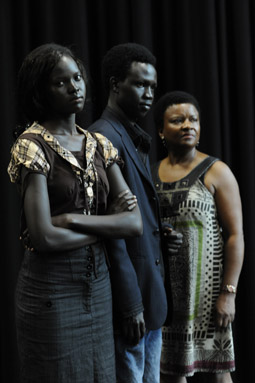
Awuol Deng, Awek Akech, Claudette Clarke, My Name is Sud
photo Adam Hollingworth
Awuol Deng, Awek Akech, Claudette Clarke, My Name is Sud
my name is sud
My Name is Sud, pronounced ‘soo-d’ (and meaning ‘black’) is a theatre work developed by members of the African community and premiering at Blacktown Arts Centre in Sydney’s west. The 2006 Australian Census counted almost 2,500 families from Sudan, Liberia and Sierra Leone, many of them refugees, who had settled in Blacktown. In response to the tensions that have arisen from a such a large influx of migrants, Blacktown Arts Centre committed to a three-year project that would give the African community a voice and an audience an opportunity to listen.
Written by an ensemble of first time Sudanese writers, Yuol Yuol, Akoi Majak, Monica Kualba and John Garang, My Name is Sud “follows the story of a family who have escaped the conflicts of war in Sudan and now face the conflicts of freedom in Sydney. Daughter Akoi dreams of being a writer. Her brother Machar struggles for a new identity. Their mother Kuei fears losing her son to the ‘streets of Blacktown’ and to his Australian girlfriend.”
Drawing on the strong traditions of storytelling and performance in these communities, South African director and writer, Robert Colman, has mentored writers and actors while resident artist at Blacktown Arts Centre.
Blacktown Arts Centre, Sydney, Nov 19-28, bookings: 9839 6558; Forum Nov 28 10.30am
wayfarer v 2: urban agents, melbourne
Media artist Kate Richards and performer Martyn Coutts are taking their locative, multiplayer media game, Wayfarer, to Melbourne after successfully premiering version 1 for Performance Space at Sydney’s CarriageWorks (see review). Version 1 was played by audiences tracking and directing a group of performers. In version 2, this time on the streets, the audience who sign on become the performers.
In the artists’ words, “teams of urban agents armed with mobile phones…will create and enact socially responsible experiences—large or small, planned or improvised including art projects, urban renewal, improvisation and drifting, liminal explorations, parkour and skate, gifting, green living/carbon neutrality/light footprint, flash mobs—anyway and anywhere they want to engage ethically and positively in the city. Videos of the experiences are streamed from players’ mobile phones directly to the Wayfarer website. Here web visitors, futurists and expert commentators in the field of social media will view, discuss and vote on the videos and drive a broader discussion about social responsibility.” For information and to register to play, go to www.wayfarer.net.au or info@ wayfarer.net.au; Arts Centre, Melbourne, Oct 26-31, Nov 2-7
real time collaborators: saskia falls
A group of Adelaide performers who have cheekily titled themselves Real Time (but with respectful spacing) are being hosted by Adelaide’s Vitalstatistix as part of that company’s Incubator program. Emma Beech, Sarah John and Holly Owen subject a returning traveller, Saskia, to existential fundamentals around the concept of home. An audience of 25 is invited to meet Saskia in real time, face to face: “You will have the chance to be curious, to be nosy while you explore the gallery of a life. Look at Saskia’s pictures, listen to her phone calls, touch her things and move through her space. It’s up to you how much you find out.” Saskia Falls, Waterside, Port Adelaide, Oct 7-18; www.vitalstatistix.com.au
craig walsh, artefact h10515
Australian media artist Craig Walsh’s magical large scale installations have appeared over the years on RealTime covers and in our pages. He’s filled Martin Place bank windows with (projected) fish and the Art Gallery of NSW portico ceiling with giant cockroaches. Now he’s created Artefact H10515: “Living within a large museum-like showcase, Artefact H10515 is highly responsive; moving and breathing within its physical boundaries and feeding on digital sources supplied via the web. Feed it your favourite objects.” Put more precisely, “Artefact H10515 prowls around feeding on content from a variety of sources from across the internet including the Powerhouse Museum’s own collection to present a constantly changing organism.” Anyone can contribute.
The work is the result of a collaboration with Powerhouse Museum, programmer and 3-D animator Steven Thomasson and composer and sound designer Lawrence English. http://artefact.powerhousemuseum.com.
danielle freakley, quote generator
Performance artist Danielle Freakley’s epic project has taken her to many countries. She’s in New York now and soon will be in Adelaide as part of the Experimental Art Foundation’s series, gone in no time (gone in no time). The series “proposes the EAF exhibition space as a site for making and being, as opposed to its usual function as a space containing objects and actions made or devised elsewhere. Eight artists have been invited to occupy the 25 by 10 metre space for a period of two weeks each and engage in their particular determination of creative action.” For most of the series, two artists at a time will occupy the space each fortnight. Freakley will be partnered by Austrian artist Margit Brünner, October 13-24.
Freakley has bravely committed herself to collecting, documenting and recalling statements of many kinds from daily life and then delivering them back to the world. The effect, on screen, is amusing and slightly alarming when quotes roll off her tongue, suggesting a human who might just be programmed. Freakley herself is The Quote Generator, “read[ing] aloud the quote in its ordinary speaking voice, not in character. The quote is always followed by a spoken reference.” She says of her performance at www.thequotegenerator.com, “The Quote Generator is absorption of unoriginality. The Quote Generator is a regurgitation library to live by. The Quote Generator is a frustrating constant acknowledgement of ever-present, inescapable mimesis.” Experimental Art Foundation, Adelaide, www.eaf.asn.au
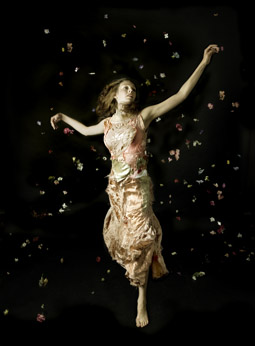
Quindell Orton, The Garden, Jambird
image Eva Fernandez
Quindell Orton, The Garden, Jambird
new dance: launceston, hobart, perth
Tasdance is premiering works from the idiosyncratic talents of Frances Rings (who has danced and choreographed for Bangarra) and Anton (ADT, Tanja Liedtke’s Twelfth Floor etc) at the Earl Arts Centre, Launceston,?Oct 16-24 and Theatre Royal Hobart, October 30-31.
In the 2009 Fremantle Festival, hybrid performance company Jambird (Chrissie Parrott, Jonathan Mustard) present The Garden, which “will transform the entire Moores Building Contemporary Art Gallery into a dark secret garden, filled with the sound of one hundred music boxes…altered and adorned by some of WA’s top visual artists.” The six galleries in the building will house immersive installations created in collaboration with artists from theatre, dance and music as well as the visual arts in a work Parrott describes as “more like performance art than a regular dance work.” Performances: Moores Building Contemporary Art Gallery, Fremantle Nov 4-15, 8pm; installation: daily 10am-5pm; producer Performing Lines.
Strut, Perth’s support organisation for independent dance, is going ambitiously mainstage with Counter Point at His Majesty’s Theatre. The program features French choreographer Didier Theron’s Harakiri, “a highly physical and emotive exploration of notions of self-sacrifice”, Jo Pollitt’s Re-Render in which Chrissie Parrott? performs revealing aspects of her dance career, and Soul Searching from WA Ballet dancer Cass Mortimer Eipper. His Majesty’s Theatre, Perth, Nov 13-14, www.strutdance.org.au
RealTime issue #93 Oct-Nov 2009 pg. 20
© RealTime ; for permission to reproduce apply to realtime@realtimearts.net
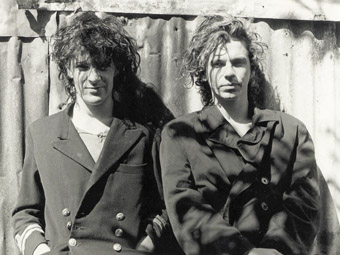
Sam Sejavka and Michael Hutchence on the set of Dogs in Space (1986)
image courtesy of Ghost Pictures Pty Ltd
Sam Sejavka and Michael Hutchence on the set of Dogs in Space (1986)
THE PROSPECT OF A DOCUMENTARY FILM ABOUT THE PUNK AND POST-PUNK ERA IN MELBOURNE WAS ALWAYS ASSURED A BUMPER OPENING NIGHT. WHEN THE FILM IS MADE BY THE DIRECTOR OF DOGS IN SPACE (1986), A CULT FEATURE FILM ABOUT THE SAME PERIOD, YOU CAN EXPECT THE JOINT TO REALLY ROCK.
And it did. There was something uncannily familiar about the queue that wound its way up two flights of stairs all the way from the cold Federation Square palazzo outside. All it needed was sleeping bags, deck chairs and a few fires burning in 44 gallon drums and it would be not so far removed from the establishing shots of the film the ACMI crowd were about to see.
We’re Livin’ on Dog Food begins with behind the scenes footage of the opening sequence of Dogs in Space, which recreates another legendary queue from 1978, when fans camped out for two weeks at the MCG for David Bowie tickets. These images immediately convey a sense of reflection, of one film in dialogue with another, teasing out different perspectives on events depicted in Dogs in Space with the benefit of 25 years hindsight.
We’re Livin’ on Dog Food is an extension or consequence of Richard Lowenstein’s longstanding desire to re-release a restored Dogs in Space on DVD. “I discovered a number of boxes of 16mm film and audio tapes of ‘behind the scenes’ interviews with Michael Hutchence and some of the other cast and crew so the overall package of a DVD and ‘Extras’ was looking pretty good.” Those “extras”, like so many punks ingloriously littering the MCG footpath, would eventually find their place in the first comprehensive documentary of what has been referred to as the “blank generation.” Music journalist Clinton Walker’s commitment to documenting the indie, punk and ‘Little Bands’ scene in his Inner City Sound (1982) and accompanying CDs has been for too long the only systematic account of the incredible diversity and creative energy of the period, the time of The Slugfuckers, Equal Local, The Boys Next Door, Essendon Airport and The Young Charlatans, among many others. On the heels of two compilation CDs of Australian post-punk music released by Chapter Music in 2001 and 2007, as well as a series of post-punk videos at the Melbourne International Film Festival this year, We’re Livin’ on Dog Food adds another dimension to a music scene in which being despised was the ultimate accolade.
For a long time this period has remained underground, but for all the wrong reasons. Invisible and absent from the official social and cultural histories of Marvellous Melbourne, it shares affinities with another crew elbowing its way back into popular consciousness, the sharpies of the 1970s. Dogs in Space begins with the decline of one subculture and the ascendency of another, as a bunch of agro sharps and boneheads are given a hiding by strung out and doped up punks waiting in that long queue (a changing of the guard also announced at the end of Michelle Moo’s 2004 novel, Glory This). In a weird coincidence, the significance of this moment accounts for the very fact that We’re Livin’ on Dog Food has appeared at a time when independent Adelaide-based filmmaker Paul Nassari is making a documentary about the Melbourne sharpie scene. And not before time, too. In a remark made to me a number of years ago by a former Thomastown sharp, one Mark Brandon Read, the sharpies are a “neglected part of Australian history.”
At the time documented in the film, however, the very concept of punk was hostile to memorialisation and longevity, to making history. As Lowenstein has suggested, “no-one in the ‘scene’ ever went on to occupy any serious position in the media or the ‘establishment’.” The Punk scene was about smack, fast music, having a good time and, well, as Iggy famously put it, “livin’ on dog food, so what!” A common theme in the film is that for the punk sensibility food was a non-essential item. As The Ears’ Tim McLaughlan suggests, if push came to shove Gravox eaten off newspaper is more than sufficient sustenance for a big night out. As a legacy of the Whitlam Government the dole was good back then and living the punk dream amounted to, in the words of Primitive Calculators’ Denise Hilton, a Government sponsored arts grant.
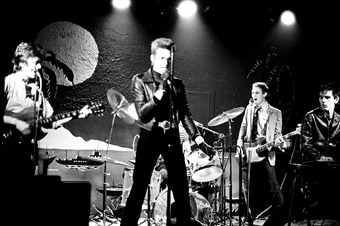
JAB featuring Bohdan X as lead singer during a live performance
image courtesy of Ghost Pictures Pty Ltd
JAB featuring Bohdan X as lead singer during a live performance
The faded glory of the old George Hotel in Fitzroy Street St Kilda, with its raffish street cred of the drug and sex trade, was an ideal, downbeat venue for the centre of the punk vortex. For the bands that played at the Seaview and later Crystal Ballrooms at the George, as well as the crowds that went to hear them, having a good time was about here and now. But consistent with the film-about-a-film-about-a-period vibe, We’re Livin’ on Dog Food is a vital, necessary and timely account of a largely unrecognised subculture that, as Lowenstein asserts, “seems to have become officially summarised and condensed into the life and times of Nick Cave as if nothing else and no-one else actually existed.” The use of footage from Tony Stevens’ and Sue Davis’ 1980 film Punkline, depicting crowds of nameless suburban youths at the Seaview Ballroom, reveals how Melbourne’s punk scene borrowed influences from the UK and US then kicked them into shape with the distinctively Australian vernacular of hard pub rock and all that went with it.
The narrative concerns of the film are carried by lively, astute and at times hysterical reflections by various band members, personalities and decisive figures of the punk demi-monde (Alannah Hill, Bruce Milne, Dolores San Miguel, Rowland S Howard, Stuart Grant, Sam Sejavka, Ollie Olsen, Clinton Walker, Philip Brophy). Combining personal reminiscence and “therapeutic purging” with plain factual details on what went down and where, these talking heads counterpoint the gritty, often rare footage of the streets, venues and squats so vividly brought to life in Dogs in Space.
Lowenstein reflects that the “punk scene was an embarrassment to the Australian music industry back then. In a similar way, Dogs in Space was a total embarrassment to the Australian film industry because it preferred and knew how to handle innocuous candy-coated fare, like The Man from Snowy River.” Not one to shy away from avidly embracing such ignominy, Tsk-tsk-tsk founder and resident bill-poster artist of the Melbourne punk scene, Philip Brophy has the last word as the credits roll. As a film about “a bunch of nobodies in a Richmond squat”, Dogs in Space, he asserts, is a “punk moment” in the history of Australian cinema. We’re Livin’ on Dog Food joyfully and democratically asserts that as far as the Melbourne punk and post-punk scene was concerned, everybody was a nobody who could do stuff until it hurt.
We’re Livin’ on Dog Food, director, editor Richard Lowenstein, director of photography Andrew De Groot, sound Rob McKenzie, producers Richard Lowenstein, Andrew De Groot, Lynn-Maree Milburn, 94 minutes, Ghost Pictures, 2009. Distributor Umbrella Entertainment. Premiere: Melbourne International Film Festival, Aug 2
RealTime issue #93 Oct-Nov 2009 pg. 21
© Darren Tofts; for permission to reproduce apply to realtime@realtimearts.net
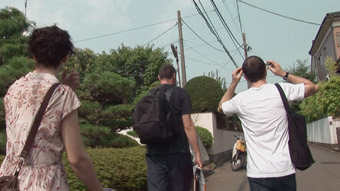
Three Hams in a Can
THREE HAMS IN A CAN IS AN UNASSUMING FILM ABOUT AN UNEVENTFUL TOUR OF TOKYO BY THREE EXPERIMENTAL MUSICIANS FROM PERTH: CHRIS COBILIS, PREDRAG DELIBASICH AND STINA THOMAS. WE FIRST MEET THEM AS THEY SIT IN SEPARATE ROWS ON THE NIGHT FLIGHT AND THEN FOLLOW THEM, SHAKEY HANDHELD-CAMERA-STYLE, OVER THE NEXT WEEK THROUGH THE STREETS OF MID-SUMMER TOKYO AS THEY SIGHT-SEE, VISIT PEOPLE AND MAKE A LITTLE MUSIC.
Despite being about musicians on tour, the film’s director, Kenta McGrath, chooses not to make their adventures in the experimental music scene his focus, opting for what he argues is a film that is “universal and accessible to those who don’t care less about the music these people were playing” [Director’s Statement]. It is hard not to question the logic. Not to focus on the underground music scene of Tokyo and the artists’ engagement with it is surely to waste a valuable opportunity, and as McGrath does not specifically select another angle, his film teeters on the brink of bland travel doco.
On the other hand, it is the uneventfulness of the film that provides its charm. The three musicians don’t have a lot to say to each other, at least not on camera anyway. But as the film progresses (and a few beers are sunk), we see them open up, particularly in two key scenes which involve interaction with Japanese people. In an extended sequence (which begs serious editing) the gang visit a Japanese family to whom Delibasich, a tall Serbian-Australian, seems somehow related (by marriage one suspects from reading the credits). They are treated to an afternoon of Japanese hospitality, including bbq-ing and playing with a spoiled West Highland Terrier, finishing with the inevitable family photo session. With minimal shared language, the polite strain is evident but so too is a sense of warmth and generosity. The idea of bonding beyond language is driven home in the following scene between a tipsy Delibasich and a sodden Japanese train driver. They sit in a gutter late at night, sharing cans of beer and drunken philosophising, repeating themselves and gesturing goodwill. It’s a moving scene saved from sentimentality by the robustness of the personalities.
At 79 minutes, Three Hams in a Can over extends itself. Perhaps a 50-minute work may have prevented some of the ennui that I experienced watching it (strange given Tokyo is such an exciting city). The hand-held doco style limits the cinematographic palette somewhat, with music performances in clubs filmed from dull angles, or shots of objects blocking vision in tedious ways. And there are simply too many shots following the backs of the musicians as they trudge through the excessive humidity. McGrath’s camera, for the most part is completely passive, lacking a sense of commentary or intention. This may have been an attempt to banish ego, but if so the visual content needed to be more charged to provide greater insights. There are a few moments in which the sequence of events creates its own poetry, such as the walk through the Meji Jingu gardens, where we witness mating butterflies and then a traditional Japanese wedding procession. The final scene where Delibasich and McGrath board a peak hour commuter train, filling beyond capacity, forcing the camera into backpacks and armpits provides one of the film’s more interesting moments.
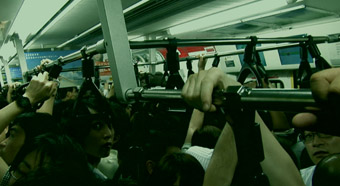
Three Hams in a Can
In his intention to avoid making a ‘music film’, McGrath missed an opportunity for more innovative use of the artists’ music as his score. The possibilities are glimpsed in a scene of swirling turtles which uses some of Delibasich’s frenetic guitar in parallel with the image, or the sequences with the barking dog and in the packed commuter train where we hear sweet piano pieces by Thomas in intriguing juxtaposition. The concert footage is sometimes informative, showing a range of Japanese artists with styles from rock noise assault to intricate acoustic improvisation. Whether intentional or not, what is revealed about these international gigs, so sought after by Australian musicians in the quest for profile, is that they are quite low-key, humble affairs—just like home. The Australian live set segments are too brief to really show the artists at their best, however the accompanying CD, Smell You Later, with five tracks each from the artists, demonstrates their work to better effect.
Co-incidentally, I was in Tokyo in August 2008 when the film was shot, so I was filled with nostalgia, seeing the gang wander the streets past the same mysterious posters, mopping sweat, marvelling at the swarming turtles and hearing the screaming semi (cicadas). Perhaps the strength of the film is its authenticity and its avoidance of ‘Lost in Translation’ clichés. I wonder if its understated charm is as universal for those who have not been to Tokyo in mid-summer. Three Hams in a Can is an interesting film, just one that I wished had explored its subjects and its form more thoroughly.
Three Hams in a Can, director Kenta McGrath, featuring Chris Cobilis, Predrag Delibasich, Stina Thomas, Little Boy Pictures/Heartless Robot Productions; www.threehamsinacan.com
Three Hams in a Can premiered at the 2009 Revelation Film Festival
RealTime issue #93 Oct-Nov 2009 pg. 22
© Gail Priest; for permission to reproduce apply to realtime@realtimearts.net
THE SUMMER HOLIDAYS USUALLY PROVIDE RESPITE FROM THE DEMANDS OF WORK, BUT SOMETIMES GREATER RELEASE CAN BE FOUND IN CREATIVE LABOUR, IN FINDING ANOTHER YOU THROUGH LEARNING NEW SKILLS. INSTEAD OF SEEKING REFUGE FROM THE HEAT IN ICE-COLD CINEMAS AND HOME-BOUND TV SPORT, WHY NOT LIVE LIFE ON THE OTHER SIDE OF THE CAMERA, OR IN THE EDITING SUITE OR PRODUCING OR WHATEVER YOU’D LIKE TO TACKLE IN FILMMAKING?
Filmmaking courses have proliferated across Australia over the last decade. They vary greatly in duration, intensity, cost, resources and quality. Sometimes it’s wise to temper your grand vision of yourself as filmmaker with a try-it-out-and-see attitude by enrolling in a short intensive course, especially when you have the time to focus entirely on putting your fantasy to the test.
The Summer School in Filmmaking, part of Melbourne University’s Screen Studies’ film education programs, has been running for many years with a compact January program taught by experienced film professionals. Prominent among this year’s presenters are Nadia Tass and Mac Gudgeon. Tass’ credits as director inlcude Malcolm, The Big Steal, Stark, Mr Reliable and Amy. Gudgeon has worked as writer and script editor on Waterfront, Ground Zero, Halifax f.p., Good Guys and Bad Guys. His screenplay for Glendyn Ivin’s Last Ride, released this year (RT91, p24), is a masterly example of effectively spare dialogue and crisp scene construction.
Also teaching in the school will be writer, producer, director and cinematographer David Parker (Mr Reliable, Stark, Matching Jack), sound designer, editor, mixer Craig Carter (Romeo & Juliet, Rabbit Proof Fence, Kenny, Home Song Stories) and composer Cezary Skubiszewski (Two Hands, La Spagnola, Bootmen, Black & White, After the Deluge, Blessed, Bran Nue Dae) among many others.
Areas taught include screenwriting, cinematography (a four day intensive, including steadicam), documentary filmmaking, producing and production management, directing actors, production and sound design, editing, digital effects, film music, screen language, film business and legalities, marketing and distribution.
Individual courses vary substantially in terms of time and cost so participants can determine the degree of their involvement and just how far they want to go in their exploration of filmmaking. To lessen even further the potential distractions of the everyday, you can rent accommodation on campus during the course. A working holiday. RT
Course details and enrolment forms: www.summerfilmschool.com
RealTime issue #93 Oct-Nov 2009 pg. 22
© RealTime ; for permission to reproduce apply to realtime@realtimearts.net
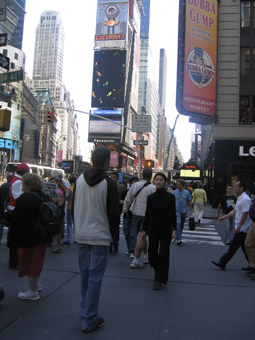
Hye Yeon Nam, from Wonderland (video), Screengrab
courtesy the artist
Hye Yeon Nam, from Wonderland (video), Screengrab
“THE MOTIVATION FOR SCREENGRAB WAS TO BRING THE WORLD HERE—TO BRING NEW MEDIA ARTS INTO THIS SPACE FOR STUDENTS TO SEE WHAT PEOPLE ARE PRODUCING, TO SEE THE POTENTIAL FOR THEIR OWN WORK, AND FOR THE PUBLIC TO UNDERSTAND AND INTERPRET NEW MEDIA ART.”
Mitch Goodwin is a lecturer at James Cook University’s School of Creative Arts in Townsville, and a member of the team convening eMerge Media Space, along with Elly Murrell, Richard Gillespie and, in Cairns, Russell Milledge.
The appellation ‘new’ can be applied to almost everything within reach of the conversation. SoCA is a recent convergence of the university’s various visual arts, theatre and music strands under a creative arts umbrella. It is physically housed in a striking cluster of buildings barely a year old, and the inaugural Screengrab exhibition and prize celebrates the establishment of the eMerge Media Space, while flying the flag for SoCA’s new direction: “A statement of intent”, says Goodwin. “People think we’ve stopped making art, and we are debunking that myth.”
Screengrab’s theme, “Intervention”, gave digital practitioners a broad concept to work with. “[It] can be a bit political and edgy, a word and concept relevant to 21st-century life. It can address issues like government control, but also the technological, social and personal. It’s a standardisation of how we look to control things”, Goodwin explains.
The selection panel considered 70 low-res entries from around the world, and narrowed the field to 15 finalists for the exhibition. “A whole range of people responded. Some entrants were very web savvy, others not at all; video artists for whom the computer is a secondary consideration, a tool for editing and dissemination.” Goodwin’s catalogue essay notes that, “Artists and programmers tackled the theme from a number of positions; some were technological interventions of the medium itself, while others placed notions of communication and exchange formats at the centre of their critique while others pursued directly the politically mediated currents of our time.”
tank man tango
The winner of the open award, Deborah Kelly (Sydney, Australia) addressed intervention and every sub-theme of “place/identity/space/community” with her poignant Tank Man Tango: A Tiananmen Memorial (2009) [see photo feature]. This two-screen work drew on the ubiquitous original footage of the unknown man with the plastic shopping bags stopping the tanks in Tiananmen Square, Beijing, when the Chinese army crushed the student uprising on June 4, 1989. Kelly notes that “he became a global symbol of courage—except in China, where the past has been erased and memory outlawed.”
Kelly distilled the man’s tank-blocking tactics into a simple choreography, disseminated these instructions in a number of languages via YouTube and urged people to “forget to forget” by performing the piece wherever they were on June 4, 2009. All this is documented on the first screen, while the second screen shows stills and videos of small and large groups of people clutching their plastic bags and silently performing the Tank Man Tango in public spaces everywhere from Warrnambool to Barcelona, and even in front of the Chinese Embassy in Brussels.
The whole work is engaging to watch, its simplicity belying the emotional response it elicits in viewers, even those not old enough to remember feeling equal parts hope and horror as Tiananmen played out in 1989. The demonstration of the choreography, performed by an Asian man under a spotlight as the narrator counts the time, the only music the rustling of the plastic bags raised and lowered, is poetic. The work’s clever basis in an unforgettable image cannot undermine Kelly’s sincerity in creating a piece featuring tiers of intervention and fulfilling her intent to make us feel, remember and act.
wonderland
A simple but effective premise also underpins Wonderland (2008), Hye Yeon Nam’s evocation of the migrant experience, and winner of the Focal Press Tertiary New Media Arts Prize. The Korean artist, now studying in Atlanta, USA, appears in her video walking tentatively through the streets of that city, while those around her are rushing past, backwards. Of course the video has been reversed—she is walking backwards along the crowded sidewalk, which explains her slightly awkward gait and air of vulnerability—she can’t see what lies ahead of her, only behind. “I understand space as the sum of cultural and social forces that act on me. Through the space, my body feels all changes around me instantly and intimately. When I moved from Korea to the United States, my body became a gauge that felt my displacement”, explains Hye’s catalogue entry. The sense of isolation is made palpable by her movement against the stream and the fact that no-one in the crowds in the video seems to take the slightest notice of her odd behaviour. www.hynam.org
twins
The sound for almost all of the works in the exhibition is supplied through headphones (necessary to fully utilise the gallery, which comfortably housed the 15 works, but isn’t huge) with two exceptions. Ambient music emanated from Alison Locke’s Twins (2009, Sydney), while the big screen work dominated one end of the darkened gallery, creating a laidback feel with its swirling translucent lava-lamp forms. The mesmerising, warm visuals resembled a slow dance of jelly blobs and rippling silk, and I was surprised to find on reading Locke’s catalogue entry that the work is about medical intervention in childbirth, meant to convey anxiety as well as mystery.
one two three. five
In complete contrast, the other audible track was a series of periodic sharp claps from One Two Three. Five (2009) a video work by Tomoyuki Yago (Japan) which deals with the “negotiation between index time and subjective time.” He filmed many people separately, each silently counting to 123.5 seconds after hearing a metronome for three seconds. When they think they have reached 123.5 seconds, the subjects clap their hands and disappear from the screen. When the screen is blank, another group appears and the cycle begins again. This strangely compelling work had me counting along and wondering who would negate their existence first, but an index time is not given—it is not a competition, just a quirky reflection on individual perception of time units.
Sharon Lenger (Israel) is “peering into windows to feel a bit at home…” in her subtitled, sweetly voyeuristic video work To Be There (2008), set to a soundtrack of street noise, footsteps, distant music and snatches of conversation. Clint Enns’ (USA) offering, putting yourself out there (2009) is also voyeuristic in the online sphere, showing random chatroom addicts on a pixelated small screen—twitching, scoping eyes and fingers in mouths. The accompanying song wistfully intones, “I wrote the book on how to be lonely.” Do they know they’re being observed?
Most entries were video works, with only a few interactive pieces, among them Jason Nelson’s I made this, you play this, we are enemies (2008, Gold Coast) and Matthew Randall’s The Digital Harmonograph (2009, UK) in which sine waves are manipulated to form complex patterns.
With artists from Australia, USA, Germany, Czech Republic, Japan, Israel, UK and India among the finalists of the inaugural Screengrab, eMerge is planning an expanded version next year, fulfilling its mission to bring a world of new media arts to an unlikely corner of regional Australia.
Screengrab, Intervention Place/Identity/Space/Community, School of Creative Arts New Media Arts Prize, Focal Press Tertiary Prize, eMerge Media Space, SoCA, James Cook University, Townsville, Aug 7–21
RealTime issue #93 Oct-Nov 2009 pg. 23
© Bernadette Ashley; for permission to reproduce apply to realtime@realtimearts.net
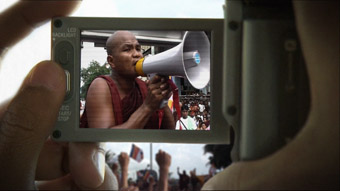
Burma VJ; image courtesy of Distributors, First Hand Films; www.firsthandfilms.com
ISSUES OF LANGUAGE AND CULTURAL REPRESENTATION IN AUSTRALIAN DOCUMENTARY FILMMAKING HAVE BEEN BROUGHT INTO THE LIMELIGHT. STOLEN, SCREENED AT THE SYDNEY FILM FESTIVAL, PROPOSED THAT THERE IS SLAVERY IN THE POLISARIO REFUGEE CAMPS IN THE WESTERN SAHARA. BUT TRUTH WAS A STUMBLING POINT FOR THIS DOCUMENTARY WHEN ABC TV’S 7:30 REPORT REVEALED MISTRANSLATIONS OF SCENES THAT APPARENTLY REVERSED THE MEANING OF THE CONVERSATIONS TAKING PLACE.
stolen
For Stolen’s second main outing, at the Melbourne International Film Festival (MIFF), the film was recut by the filmmakers with corrected subtitles. The filmmakers maintain these corrections have not changed the meaning of the scenes. The trouble is, how can anyone living in Australia really know who to believe here?
Other than Melbourne film writer David Tiley (Barista is his blog), the documentary community has been muted in its reaction. Privately though, there has been a bizarrely George Bush style ‘You’re either with us or against us’ view of film. To be with the film is to believe there is slavery in Polisario camps, to be against it is to side with Polisario wholeheartedly. Surely you can be for or against a film for a number of different reasons, some of which have nothing to do with its central argument? For instance, after watching the first version I think that there is complex cultural inequality in the camps, and that the filmmakers got carried away with the black and whiteness of slave and master (or this case mistress) as labels. They had ‘story creep’, and chased the story of slavery rather than focusing on how a society that has recently de-legalised slavery functions.
But what worries me is not whether or not you can call it ‘slavery’, but whether or not the filmmakers broke the bond between filmmaker and audience through mistranslation. In documentary, if you break that, what is left? Exotic pictures and a piece of fiction? No doubt the filmmakers suffered the constraints of a small budget, but the Stolen story is a lesson in how not to organise your translation pathway in post-production. The maker’s defence of their film can be read at www.unitednotionsfilm.com/Index.htm.
10 conditions of love
In Melbourne, 10 Conditions of Love stole the limelight at MIFF. Jeff Daniels’ film went from lacklustre ticket sales to the hottest film of the festival. Even the star festival guest, Quentin Tarantino, was being asked what he thought about the controversy.
10 Conditions of Love is a film about an exiled Uyghur businesswoman and her struggle for Uyghur rights in East Turkestan. The film’s rise from rags to riches was generated by the Chinese Consul’s attempt to shut down the screening and cancel the principal subject’s visit to Melbourne. According to the Chinese, Kadeer is a Muslim terrorist; according to the filmmakers she is a Uyghur rights activist. The battle over 10 Conditions of Love centred on this labelling of Kadeer. The Chinese pumped their own propaganda machine into action to discredit her and in doing so, brought the film and the issues explored in it a larger audience. Polisario’s attempts to discredit Stolen by challenging the veracity of the translations was a cleverer tactic. 10 Conditions of Love also dealt with content spoken in an uncommon language, but unlike Stolen, it did not lose access to its subjects or principal locations. This meant Jeff Daniels could run the translations by Rebiya Kadeer to check they were correct. Even if the Chinese wanted to follow Polisario’s lead, it would have been very difficult.
However, neither of the juggernaut films, 10 Conditions of Love or Stolen, challenged film language or ways of perceiving. For new and exciting ways of looking at ‘other’ cultures there were two lesser known works: the Danish film, Burma VJ and, from Australia, Intangible Asset No. 82. Neither was made by a filmmaker from within the culture observed, but both broke down 21st century perceptions of the ‘other.’
intangible asset no. 82
In Intangible Asset No. 82 Emma Franz follows jazz drummer Simon Barker to Korea in search of a musical shaman. Barker’s guide on the journey is Korean musician Kim Dong-won. The structure follows the classic hero’s journey. We hear Barker’s thought track as we watch him in the observational footage. So far, all normal narrative fare. However, fairly early in the documentary we leave the subject’s inner musings and enter the head of his guide, Kim Dong-won. Suddenly the ‘other’ character, the Korean, is also central to the storytelling. We hear what he thinks about Barker and the journey. This is done through non-sync audio from interviews with Kim Dong-won laid over the observational footage. Franz has skilfully combined the two perspectives of into a multi-narrative, multi-perspective on a journey. She is doing for documentary what Robert Altman did for fiction film. It is a ground-breaking and exciting shift in the usually mono perspective of the hero’s journey. Franz is a former jazz singer, and this may have influenced her decision to include parallel narrative lines in her story.
burma vj
The Danish film, Burma VJ, is promoted as an activist documentary, with the oh-so-familiar accompanying website on how you can save the world. So it was a great surprise when it turned out to be the most amazing documentary I’ve seen since Bastardy (2008; see review RT91), or maybe even since Darwin’s Nightmare (2004). Just when I thought I’d seen everything that film language had to offer, along comes Burma VJ.
The film is constructed from footage recorded by a group of underground video reporters who filmed the 2007 uprising by monks in Burma. Amateur filmmakers with handicams hidden in bags create a strategy of how to film in a society in which those they film could be watching them. The counter-gaze can have deadly consequences. They turn the camera on in a safe quiet place, leave it running inside the bag, unzip at key moments and quickly rezip after the moment has passed and escape to a getaway car. The camera darts about and captures an impression of the camera person’s own fears as well as the emotions of the people around them. They often inadvertently provide a running commentary on what they are filming because they are constantly on their mobile phones to HQ explaining what they are getting, where the action is heading, and receiving instructions about what to film next. Each camera person is one of many strategically placed around any given space to ensure that at least one will capture the moment and not get arrested.
The footage these amateurs capture is simultaneously epic and deeply personal. You can’t help but be moved to tears. It is the artistic culmination of the early 21st century proliferation of image capturing devices in the hands of the amateur. The ultimate ‘user-driven’ footage. We are literally watching events unfold through their eyes.
Director Anders Østergaard has allowed the unique POV of these Burmese guerrilla filmmakers to completely envelop the documentary. Even the voice over, provided by one of the former camera people, contains just the right mix of subjective and analytical—the kind of voice over you’d expect from an Agnes Varda film.
If Østergaard had taken his own camera into the 2007 uprising he could never have got this footage, precisely because he would have been an ‘other’ in relation to the culture and the events. These anonymous Burmese camera-people have created a unique film language. Burma VJ was gripping, I wouldn’t be surprised if we see more of this kind of filmmaking generated at future uprisings around the world.
Melbourne International Film Festival: Stolen, directors, writers, photography Violeta Ayala, Dan Fallshaw, producers Tom Zubrycki, Violeta Ayala, Dan Fallshaw, Deborah Dickson, music John McDowell, United Notions Films; 10 conditions, director Jeff Daniels, directors of photography John Lewis, Dennis Smith , sound Jeff Daniels, WS TVF International; Intangible Asset no 82, writer, director, producer, photography Emma Franz, editor Daniel Kerr, sound Matthew Ferris, sound mix Michael Gissing, Andrew McGrath; Burma VJ, director Anders Østergaard, writers Anders Østergaard, Jan Krogsgaard, directors of photography Simon Plum, The Burmese VJs, editors Janus Billeskov-Jansen, Thomas Papapetros, producer Lise-Lense Møller, producers WG Film, Mediamente, Kamoli Films; MIAF, July 24-Aug 9
RealTime issue #93 Oct-Nov 2009 pg. 24
© Catherine Gough-Brady; for permission to reproduce apply to realtime@realtimearts.net
{$slideshow} WITH JOHN HUGHES, NOTHING WOULD SURPRISE ME. HE IS NOT A DOCUMENTARY FILMMAKER WHO CAN BE UNDERSTOOD ON A SURFACE LEVEL, AND NEITHER CAN HIS FILMS. THERE ARE LAYERS AND CROSS LAYERS OF IMAGES, TEXT AND VOICE.
Hughes is respected as Australia’s foremost exponent of the ‘essay’ style documentary. He has been experimenting with this style since the 1970s. In the brilliant All That is Solid (1988), he hands objects, eg a snow dome, to the interviewees, and the film is constructed from their responses. The ‘essay’ of the film is the fragmentation of meaning and the absence of any shared vision. Hughes modestly says of this film, “Yeah, that’s mad.”
These earlier films do not employ Hughes’ trademark layered screen design. This came later, as a response to problems presented by conveying complex ideas in a scene. “When Uri [Mizrahi] and I did One Way Street [1993], we had this fantastic little sequence to do about Freud’s idea of the slip of the tongue, the accidental moment that produces the flash of insight. If read critically, that idea has got a lot of content…but we had to do it [with separate] rolls of video. But it was possible for the first time, in 1992, because we had digital videotape, so you could have layers without losing generations. Now you can just simply do it on a screen.”
Hughes also talks about his layered screen design as a Dadaist technique. Once you know this you can see how the idea expressed itself in different ways in his earlier work and has shifted in response to the rapid changes in film technology. In his earlier films the Dadaist experience was created through the use of actors or objects, or both as in the snow dome in All That is Solid.
Hughes’ use of a complex screen design has not completely replaced his earlier fascination with objects as metaphors. In his latest film, Joris Ivens: Indonesia Calling, he filmed street mime artists performing with a glass ball. His focus on the ball can be read as symbolising the elusive relationship of filmmaker to light and image. As in his earlier works, the layers of meaning come from the various readings of the object within the film’s montage, rather than the layering of images on top of each other.
Hughes says, “It’s often about using found material and building collages with them so you have the capacity to engage a spectator in a temporal way. You build one idea and one image in relation to the next—illustrating or enhancing or playing with whatever material that you are delivering in an audio track. But you have also got the capacity to build those montages in the form of a collage. It gives it a denser complexity. And it theoretically [he laughs] generates a spectator experience which is more active.” When asked why he would want to create that sense of distance or alienation between the audience and the material, Hughes says, “Because you favour a critical mode of spectatorship over a consuming one.”
With his mix of the anti-logic of a Dada screen design and the logical formality inherent in an essay film, Hughes finds “the essay form often allows more creative originality and more editorial freedom. In some way the term ‘essay film’ is quite close to what IDFA [International Documentary Film Festival Amsterdam] and Toronto’s Hot Docs like to call the ‘creative documentary’ as distinguished from ‘specialist factual’, for example, science programs, or history programs like the ABC has been doing with their ‘dramatic re-enactments’ and so on. [It has parallels with] the essay form in literature, as distinct from reportage, current affairs, or other modes of journalism. It can be more subjective, more speculative, more discursive, more ‘authored’, if you like…”
It may be more authored, but with Hughes’ films it will not be more personal. The two are not the same for Hughes. For instance, in his latest film Joris Ivens: Indonesia Calling, preference is given to understanding Ivens’ filmwork over understanding the man.
Hughes doesn’t use anecdotes or biography in the construction of his films. This creative decision influences not only the stories included in his films, but also the use of elements within the film, for instance, the narrator. He says, “In my work I like to recess the narrator as much as possible in favour of the material itself. That’s consistent with me not liking um… biography-based articles, or interviews in general!”
Joris Ivens: Indonesia Calling completes a trilogy of films concerning the interface of filmmaking and Communism in Australia during the mid-20th century. This has been a subject that spans Hughes’ working life. The first part of the trilogy is Film Work (1981), which rediscovers the work of the Waterside Workers’ Federation Film Unit. The second is The Archive Project (2006; RT72, p17), where Hughes rediscovers the work of the Melbourne Realist Film Unit. In a break with his usual style he cast himself in this film as the filmmaker narrator delving into suitcases full of old rolls and written records. The final part of the trilogy is his latest documentary, which looks at events surrounding the mysterious creation of the film Indonesia Calling.
At a surface level the last part of the trilogy can be seen as a semi-biographical work. There is something about the film that evokes the spirit of Hughes. Possibly this is because the theme has been one that he has returned to throughout his life, perhaps because at first glance there seem to be similarities between Hughes and activist filmmaker Ivens. In the Howardian late 90s Hughes’ film work moved away from his examination of meaning to look at issues of the day. “Richard Frankland rang me up and said I had to make a film about the amendments to the Native Title Act…After Mabo [1998]. And that took two years…Then, while I was doing that, someone said I had to do a film about the dam in Broome. They were trying to dam the Fitzroy River [River of Dreams, 1999]. So I had to do that.” In the 2000s Hughes also became part of the Time to Go John group of filmmakers.
But when you delve into the layers of John Hughes filmmaker and Joris Ivens: Indonesia Calling, it becomes clearer that the similarity between Ivens and Hughes is not an activist filmmaking style: Hughes is too contemplative for that. For instance, his film for Time to Go John took footage from one of his earlier ‘activist films’ and closely examined the meaning and consequences of Howard’s use of the word “blemish.” Activist filmmakers find the links between real world entities; Hughes finds the links between the real world and meaning.
On closer viewing it becomes apparent that the evocation of Hughes in this film is a complex one. Joris Ivens forms an avatar for the ideas behind Hughes’ trilogy on filmmaking and politics in the mid-20th century, embodying the themes in the films and the reason Hughes made them. Ivens was spurned and harassed throughout his life for ‘red’ ideas, his works marginalised and lost, but near the end he was ‘rediscovered’ and only then was it accepted that in amongst the art was insight, and amongst the insight, art.
Joris Ivens: Indonesia Calling, writer, director John Hughes,?editor, graphics, design Uri Mizrahi, music Brett Aplin, producers John Hughes, Andrea Foxworthy.
?editor, graphics, design Uri Mizrahi, music Brett Aplin, producers John Hughes, Andrea Foxworthy.
RealTime issue #93 Oct-Nov 2009 pg. 25
© Catherine Gough-Brady; for permission to reproduce apply to realtime@realtimearts.net
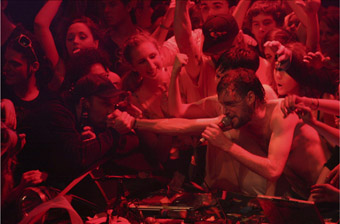
RiP: A Remix Manifesto, Brett Gaylor with Girl Talk at Concert in Montreal, Nov 13, 2008
photo Kat Baulu, copyright National Film Board of Canada
RiP: A Remix Manifesto, Brett Gaylor with Girl Talk at Concert in Montreal, Nov 13, 2008
VIDEO IS EVERYWHERE ON THE WEB THESE DAYS. THE PROBLEM IS THAT WHILE VIDEO IS ARGUABLY THE MOST INFLUENTIAL MEDIUM, IT’S ALSO THE MOST “CLOSED” ONLINE MEDIUM—THE CODECS AND SITES WE USE TO SHARE MANY OF OUR VIDEOS ARE MOSTLY OWNED BY GLOBAL CORPORATIONS (THINK ADOBE’S FLASH, APPLE’S QUICKTIME, OR THE COMMERCIALLY SUPPORTED VIDEO STREAMING SITE HULU).
While Google-scale entities like YouTube have grown to become the default state of online video, many critics, artists and activists are now wary of the proprietary systems that underlie their operations. As large corporations stake out more and more of the technological platforms needed to deliver video online, critics ask whether there is a danger that the ubiquitous, “free” and interoperable characteristics we find in email, wikis and blogs will also apply to online video. Many fear the worst.
Earlier this year in New York, a coalition of organisations and individuals met to discuss the dilemmas faced by many developers and content creators who have an interest in the newly emerging marriage of the open web and online video culture. Organised by the Open Video Alliance, the event brought together a wide range of people interested in creating and promoting free and open technologies, policies, and practices in online video (ongoing information can be found at their website http://openvideoalliance.org).
According to many of the presenters and participants, we have reached an important fork in the road. In the long-tail economy of the digital era, web-delivered video could easily become a glorified TV-on-demand service, and a central component of a permissions-based culture. Each time we want to exchange, upload or download a video file, we need to ask permission to use the codecs and protocols that allow us to share the video.
That’s why many of the independent producers and activists gathered at this event suggested that the values of transparency, interoperability and decentralisation in online video must be seriously considered if we are to avoid a hyper-commercialised hijacking of the web’s participatory culture.
Well-known figures such as Yochai Benkler and Jonathan Zittrain (from Harvard’s Berkman Center), Xeni Jardin (co-editor of Boing Boing) and Brett Gaylor (director of RiP: A Remix Manifesto) were among the presenters arguing for a more open and transparent online video culture. Benklers’ well-known work on participatory culture, distributed innovation and distributed creativity also finds its way into this emerging concept of open video. Citing mashup artists like Blacklantern, (www.theblacklantern.com), popular videos such as Let’s Bomb Iran and Jonathan Coulton’s Code Monkey as instances of decentralised human capability, Benkler’s exemplars also point to the inescapable contradictions: none of these works could have existed without YouTube.
But they could just as easily exist in other more open platforms. Michael Dale, a senior developer from the open source online video platform Kaltura, has been working on just such a project, entitled Metavid. It’s a wiki-based community archive project that hosts public domain legislative footage from the US Congress, and allows users to access metadata (such as transcripts) in order to reuse the footage in mashups or for political research. While it started as a small project by artists, it soon became a massively popular repository of political video.
Dale sees the Kaltura project as “the Apache of open video.” And that says a lot to many from the burgeoning online video community. (Apache is one of the leading open source foundations, run on a collaborative, consensus based development process. It offers an open and pragmatic software licence for high quality software that is collectively produced.)
Based on Wikimedia principles, Kaltura is a big proponent of the push towards non-Flash video standards. Dale reminded us that Wikipedia’s enormous success is largely due to its simple browser-based editing, which has removed the barriers to participation. The new HTML5 specification (which is the next major revision of the core mark-up language of the web) similarly allows open source codecs (such as OGG Theora) to play natively within the browser and to be accessible to anyone without having to use proprietary codes and players.
While this may not seem like much of a big deal, it means the world to many in the emergent open video community. One of the aims of open video is to decouple the video from the player, which is now possible with HTML5. In other words, why do we need to ask Adobe’s permission to download their Flash player or Apple for Quicktime to watch a movie on the web, when HTML 5 and OGG can do it for “free”?
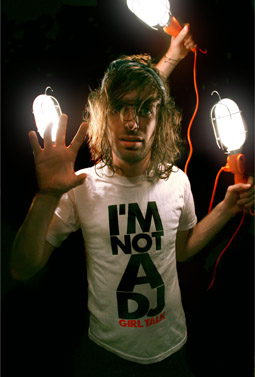
Greg Gillis aka Girl Talk
photo Andrew Strasser, copyright EyeSteelFilm
Greg Gillis aka Girl Talk
Some view this open source approach as a little utopian, even evangelical at times. For people working in public institutions or archives that need to guarantee broad ‘universal’ access to their digital collections, non-proprietary open video standards are essential. But there’s also a business case to be made. Open standards (like HTML) can drive innovation and build markets. They also add public value, as the more open video becomes, the more social value is created.
Perhaps most importantly, open video raises questions about who will control and define the social and economic spaces that are emerging around online video. Will we see a repeat of the major structure of corporate television on the web, or can we shape the world ourselves, and insist on openness at every level?
The following projects represent the beginnings of this nascent movement:
Xiph, www.xiph.org, a non-profit corporation dedicated to protecting the foundations of internet multimedia from control by private interests.
Kaltura, http://corp.kaltura.com, an open source online video platform.
Miro, www.getmiro.com/blog, an on-profit video player and podcast client built on open source principles.
Opencast, www.opencastproject.org, an initiative driven by higher education institutions to empower them to make informed choices about capture, processing, and distribution infrastructure for audio/video.
MythTV, www.mythtv.org, a free open source digital video recorder (DVR) project distributed under the terms of the GNU GPL.
Metavid, http://metavid.org/blog, Abram Stern and Michael Dale’s open video archive of US Congress footage.
Utagit, http://utag.it, a free software web service that provides spontaneous, rich, multi-dimensional tagging of media streams.
Metabroadcast, http://metabroadcast.com, a London-based start-up that develops video distribution software.
OpenImages, www.ohloh.net/p/openimages, a platform to upload, edit and publish video, audio and images.
TransmissionCC, www.transmission.cc, a network of citizen journalists, video makers, artists, researchers, programmers and web producers who are developing online video distribution tools for social justice and media democracy.
Open Video Conference, New York, Vanderbilt Hall, NYU Law, June 19-20; http://openvideoalliance.org/blog
RealTime issue #93 Oct-Nov 2009 pg. 26
© Ross Harley; for permission to reproduce apply to realtime@realtimearts.net
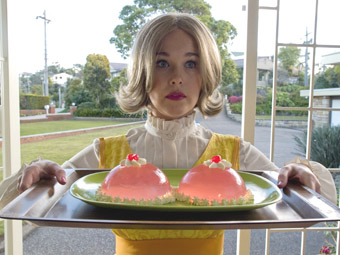
fOUR
SIL-NYIN CAMERON, DIRECTOR OF THE WORLD OF WOMEN FILM (WOW) FESTIVAL IS KEEN TO GET THE WORD OUT—WOW’S GOAL OF “GIVING THE OPPORTUNITY FOR INDEPENDENT, USUALLY LOWER BUDGET FILMS TO HAVE PUBLIC EXHIBITION—IT’S UNLIKELY THAT THE FILMS WILL GET WIDE RELEASE UNLESS THEY ARE ‘NOTICED’ PERHAPS AT OUR FESTIVAL. OUR AIM IS TO GIVE PUBLIC EXHIBITION TO MAINLY SHORT FILMS WITH KEY CREATIVE INPUT BY WOMEN—AND THIS CAN HELP FILMMAKERS FURTHER THEIR CAREERS.”
Each year, filmmakers are invited to enter works in the categories of Fiction, Documentary, Animation, Music Videos and Student films of less than 55 minutes duration. New this year is a prize for the best Vodule. A growing arena for women producers of digital media content, Vodules make use of the emerging market of mobile technology and internet distribution.
Says Cameron, “The festival promotes and awards the talents of women directors, producers, writers, editors and cinematographers in the Australian film industry and in Oceania. It is a unique festival that offers emerging and established filmmakers the opportunity to screen short works giving a thematic perspective of ‘seeing the world through the eyes of women’.”
Director of last year’s hit feature The Black Balloon and this year’s festival patron, Elissa Down, acknowledges WOW as an important part of her career trajectory. In 1991, the festival screened and toured her short, HMAS Unicorn, presenting the film to a broad audience and Down was on her way up.
Among the films screening this year are Four of a Kind, the debut feature from Melbourne-based Fiona Cochrane, a director with an extensive filmography of award-winning documentaries, music videos and producer credits to her name, not to mention a medical degree which might account for the forensic feel of her film. Though showing signs of its beginnings as a stage play, Helen Collins’ script is sustained by some intriguing plot turns and good performances on the whole. The film premiered last year at the Montreal World Film Festival and was nominated Best Feature at the 2009 ReelHeART Film Festival in Toronto and Best Feature at 2009 SkyFest Film & Script Festival, USA.
I Wish I Were Stephanie V, produced by Laura Sivis, directed by Jon Cohen and written by Chloe Traicos, who also stars in the film, combines immigrant experience, teenage angst and tennis in what is described as “a vibrant romance, comedy and drama in the My Big Fat Greek Wedding and Bend It Like Beckham mode.” Meanwhile, in fOUR directed and written by AFTRS student Erin White, “it’s 1974 and two couples with troubled marriages meet in a quiet Australian suburb and suddenly find themselves embroiled in a sexual revolution.” fOUR won best short film at the 2008 IF Awards.
Misconnect, directed and written by Aloura Charles from the USA, was filmed in Sydney and Los Angeles: “A mis-dialed phone call connects Mei, a Chinese woman with Will, a boy in Sydney, each isolated and trapped in different ways.” Charles will be a guest at the WOW Film Festival and will introduce her film on the festival’s Opening Night. She’ll also take part in the Filmmakers Forum, “Director’s Vision Through the Cinematographer’s Lens” with her cinematographer, Ming D’Arcy, on Sunday October 18 at the AFTRS Theatre.
Among the documentaries are the wonderful Maverick Mother produced, written and directed by Janet Merewether who, in her fiercely honest film, turns the camera on her own perilous journey into solo motherhood.
Experienced Canberra-based filmmaker Lara Van Raay offers what sounds like a a curious feature-documentary in her Palestine, Beer & Oktoberfest: Under Occupation: “Meet the father and daughter team who created Palestine’s first brewery…Filmed at the Oktoberfest in the Christian town of Taybeh on Palestine’s West Bank.”
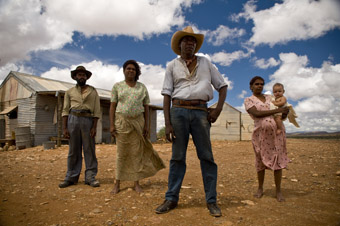
Jacob
The shorts program includes the animation, Huriyya & Her Sisters made by a group of young Muslim women in Western Sydney working with director Paula Abood. Jacob is a promising new indigenous drama set in the 1940s produced by Rhea Stephenson for Blackfella Films and directed by Dena Curtis with some lush cinematography by Murray Lui. This one has the makings of a more substantial feature. There’s also the cleverly succinct Be My Brother by Genevieve Clay (Best Film, Tropfest 2009).
As well as these and many more screenings, there’ll be Q&As, chance meetings and all the celebration that comes with events like WOW that offer a diverse group of filmmakers and their audience the chance to share, for a time, the intensity of immersion in mulitple female views of the world.
16th WOW Festival, Chauvel Cinema, Paddington, Sydney Oct 14-18; www.nsw.wift.org/wow. For updates go to the WOW blog: http://wowfilmfestival.wordpress.com
RealTime issue #93 Oct-Nov 2009 pg. 27
© Virginia Baxter; for permission to reproduce apply to realtime@realtimearts.net
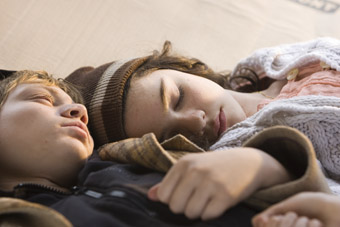
Blessed
FROM HER FIRST SHORT FEATURE, ONLY THE BRAVE (WHICH SCREENED IN VENICE AND WENT ON TO WIN AFI AWARDS FOR BEST SHORT FICTION, BEST SCREENPLAY AND BEST PERFORMANCE) TO HEAD ON (ONE OF THE BEST AUSTRALIAN FILMS OF THE 90S) AND HER RECENT THE BOOK OF REVELATION, ANA KOKKINOS HAS ALWAYS MADE CONFRONTING AND EXCITING CINEMA.
Her new feature Blessed continues this trajectory, extending the themes explored in the Melbourne Workers’ Theatre play, Who’s Afraid of the Working Class (1997), with the same writers who produced the play (including Andrew Bovell and then newbie Christos Tsolkias), fine-tuning the screenplay, which has become more an ensemble piece about children and mothers, submission and subjugation, how we judge and are judged.
Like the dynamic Head On, Blessed takes place over 24 hours but employs an unusual structure to examine the lives of children and mothers about to topple over the edge. Split into two parts, the first focuses on the perspectives of the children, the difficult terrain they are forced to negotiate; the second half returns to the start of the day, flipping the coin to fill in the gaps, exploring the mothers’ lives and how they’re implicated in the children’s often dangerous behaviour. The repetition of images, like a visual refrain, brings a poignant reminder of what they all share: we are introduced to each character as they sleep, in peace, with the dawn light on their faces; we farewell them as they look towards the sun in that magic hour of dusk where the light is just beginning to fade.
Christos Tsolkias, in his award-winning novel The Slap (and, earlier, Loaded), proved a talent for capturing contemporary Australian culture in all its goddamned complexity, particularly the heart and soul of Greek immigrants. Here all the characters are strong but the standouts are best friends Katrina (Sophie Lowe) and Trisha (Anastasia Baboussouras). Lowe proves she is more than just ‘Beautiful Kate’ (see review) with wonderful comic timing and that right mix of vulnerability and sophistication girls her age possess. Newcomer Baboussouras is both tough and brittle. The dialogue between the two hits the mark, capturing the seeming banality of the girl’s smart-arse banter while exploring darker issues underneath: “You don’t cut yourself because you’re fat…I’ve seen heaps of fat Goths.”
There’s also the tragedy of young kids who don’t see the full picture, forced to deal with unexpected consequences, often too much to bear. In one of the film’s best scenes, Daniel (Harrison Gilberson) breaks into an old terrace looking to steal some money (as his parents Tanya (Deborra-Lee Furness) and Peter (William McInnes) have falsely accused him of pinching from their room) and accidentally injures an elderly woman. As he looks at the bookshelves, filled with the writings of Marx and Steinbeck, Daniel comes across Laurel (Monica Maughan) who, rather than being confronted or intimidated, tries to befriend him. When he demands money she says, “Take what you need…you’re lovely…There must be something I can give you” and he becomes indignant; this isn’t the script he has in his head. As she gains his confidence he tells her about his mother and, sensitive to the boy’s plight, she replies: “It’s hard for mums when sons reach a certain age. You’re not sure how to love them anymore.” But as she asks him in desperation to repeat “I love you mum”, we realise that she is not just benign but also using him, seeing him as a replacement for her own absent, adopted son. Her tenuous relationship with James (Wayne Blair) is explored later when she is haunted by the ghost of a memory: his Aboriginal mother appearing at the door with gifts that she hides.
The dynamic between younger kids is perfectly explored. Orton (Reef Ireland) and Stacey (Eva Lazzara) are sleeping in a charity clothing bin to escape their edgy mum Rhonda (Frances O’Connor), whose “whole life is just one big assessment” and is pregnant to the latest abuser after a string of boyfriends have assaulted Stacey. Playing in the sand with blood on her dress (she has just got her period but doesn’t know what to do), Stacey is under-resourced and ‘not all there’ with a blunt naivete that makes Orton protective. When she sees prostitutes get into a client’s car she asks, “What do they do?” On hearing Orton’s response she says, “It’s like Nathan. But he doesn’t give me any money.” O’Connor is all sinewy gristle and seething resentment in her gutsy portrayal of a mother having to deal with the unendurable, and the film’s final scene is a ripper. Pregnant and adrift, Rhonda dances alone at the local club in complete desolation, reminding me of Claire Denis’ final bar scene in her majestic Beau travail (1999): characters obliterating the pain with bodies in movement. But it only lasts for so long; they know the pain returns with daylight.
With the current trend in Australian cinema (and probably the same goes in our cinematic history) being for films about crises in masculinity (Three Blind Mice, The Square, West, Ten Empty, Cedar Boys, The Last Ride) it’s wonderful to see a film based around an ensemble of women and their roles in families and community—with an emphasis on motherhood. Often under-utilised performers like Miranda Otto and Frances O’Connor (who’ve had success recently on US television together in Cashmere Mafia) and Deborra-Lee Furness seize these meaty roles with relish. As with the intricate entanglements of Lantana (that Bovell wrote), all the characters and relationships in Blessed are enigmatic and interesting enough to carry off an entire feature on their own. It’s a good sign when you leave the cinema wishing you could follow them further.
Blessed is screening nationally after being selected for the Toronto International Film Festival in the Contemporary World Cinema program and the official competition of the San Sebastian International Film Festival. The writers recently won an AWGIE for Best Adapted Feature Film.
Blessed, director Ana Kokkinos, producer Al Clark, writers Andrew Bovell, Melissa Reeves, Patricia Cornelius, Christos Tsolkias, editor Jill Bilcock, production designer Simon McCutcheon, DOP Geoff Burton, composer Cezary Skubiszewski
RealTime issue #93 Oct-Nov 2009 pg. 27
© Kirsten Krauth; for permission to reproduce apply to realtime@realtimearts.net
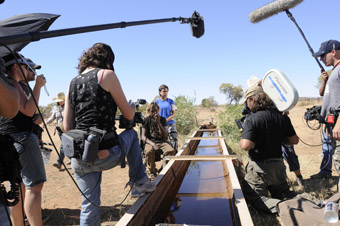
Beck Cole and team; R: Warwick Thornton and team, The Making of Samson and Delilah
photo April Goodman
Beck Cole and team; R: Warwick Thornton and team, The Making of Samson and Delilah
WARWICK THORNTON’S SAMSON AND DELILAH, CAMERA D’OR WINNER AT THE 2009 CANNES FILM FESTIVAL, IS A GRUELLING IF FINALLY UPLIFTING EXPERIENCE BLESSED WITH RARE BUT REVEALING FLASHES OF HUMOUR. BECK COLE’S THE MAKING OF SAMSON AND DELILAH IS QUITE THE OPPOSITE, A FREQUENTLY FUNNY DOCUMENTARY WITH MOMENTS OF PAIN AND FRUSTRATION AS IT SHOWS THE PRESSURE OF FILMMAKING ON ITS YOUNG, UNTRAINED PRINCIPAL ACTORS AND, IN TURN, ON ITS DIRECTOR.
“Making of…” documentaries have become a necessary add-on in the age of the DVD, but rarely do they achieve notable artform status and most are simply promotional tools. Exceptions include Fax Bahr and George Hickenlooper’s feature length Hearts of Darkness: A Filmmaker’s Apocalypse (1991) documenting the making of Francis Ford Coppola’s Apocalypse Now (1979). But that film was made well after the event, drawing on Eleanor Coppola’s footage from the original shoot. More modest ventures, like James Thomas’ 2001 35-minute account of the making of Phil Noyce’s Rabbit Proof Fence, made for Channel 9’s Sunday program, can be illuminating, in this case revealing challenges inherent in directing non-professional child actors and, most chillingly, the stress for the Indigenous performers involved in the reenactment of the child abduction scene.
Beck Cole, a formidable filmmaker of short dramas (Plains Empty, Flat) and documentaries (The Lore of Love; Wirriya—Small Boy; First Australians), followed the filming of Samson and Delilah with camera in hand and an ear for detail and circumstance that allowed the finished documentary not so much to stand on its own as to provide a dynamic counterpoint to Thornton’s film; together they make a great pairing.
Cole follows the chronology of the making of the feature film from the auditioning of young adolescents for the principal roles to the shooting of some of the key scenes and, finally, the win in Cannes. Much to his astonishment, Thornton finds his Samson (Rowan MacNamara) very quickly, though wonders “will he last” the challenge of the filming. Asked later if he’s happy about being cast by Thornton, Rowan smiles, “I like the bit where he said ‘famous’.”
Finding a Delilah proves more elusive. Among the painfully shy 13,14 and 15 year-olds are faces for a camera to fall in love with. “Can someone be too beautiful?”, asks Thornton when reviewing the audition of one youngster. Producer Kath Shelper suspects the delicate relationship at the film’s centre might then become “about lust, not love.” They’re finally attracted to Marissa Gibson, young but with a certain air of maturity and not conventionally pretty. But to secure her, Thornton, Shelper and translator and casting assistant Peter Bartlett have to travel the long distance by road to Papunya, suffer a flat tyre on the way, and convince the girl’s family. It’s worth the effort, as the first reading reveals; they’ve found a “grounded Delilah.”
Parading in a string of briskly edited costume tryouts, Rowan reveals a throwaway sense of presence—a quick oscillation between self-consciousness and proud self-possession. Thornton meanwhile is not planning to shape the actors, he’ll let them be the characters: “they own this already…I’m not going to fill their heads with Samson and Delilah back stories.” In a glimpse of an informal workshop he simply asks Rowan to sneak a sideway look at Marissa. It’s a telling and apt look.
But before filming can commence, Rowan has to face people from whom he stole and seek to be released from associated legal obligations. Soon we see him performing for the camera, Thornton instructing off-camera, like a silent movie director for a film largely without dialogue. It’s exciting to witness the filming of the pivotal scene where Samson dances—the suddenness of the shift into focused performance is gripping. Later, there’ll be sulky reserve and resistance, but at this stage Thornton can confidently assert, “We’re going to have the best six weeks of our lives.” He’s relieved, “These two can act!”
The filmmakers take over a deserted fringe town near Alice Springs where they are joined by Mitjili (Nana in Thorntons’ short, sharp comedy of the same name and also in Cole’s Lore of Love). Cole cuts away to an exhibition about the woman’s life and family. It’s revealed that as one of three wives to one man she is related to Marissa as a grandmother. Back on location, in the filming of the funny scene where Delilah’s grandmother encourages the girl to form a relationship with Samson (“He’s your skin”), Mitjili is focused on the reality of the scene, not the fiction. Encouragement and intepreting ensue and, suddenly, she’s got it.
It’s fascinating to watch the filmmaking team at work, good humoured, alert and often funny. Kath Shelper’s laughter and good sense is contagious and translator Peter Bartlett quietly ubiquitous—responsible, as the company website puts it for “casting, acting, organising, animal wrangling, driving, translating, and snake-removal…”
Despite a short break for Rowan to travel to be with his family and attend church, his mood is darkening and he’s not happy to be documented, fleeing the camera as soon as he can. Marissa’s rare moment of dissension comes when she has to cut her hair after the death of Delilah’s grandmother. Cole focuses tightly on successive stages of despair, barely restrained tearfulness and, then, Marissa’s quiet pleasure in her new look.
Cole’s documenting of the supermarket shoplifting scene (the actors overhelmed by “too shame”at having to enact such behaviour with people witnessing it) and a key late scene in a petrol station reveal the range of pressures on both director and actors. (It’s amazing that the latter scene works given Rowan’s behaviour and the lack of connection at this stage with Marissa.) Thornton’s disappointment with Rowan is more evident in his face than in words, although they’re strong enough.
But the success of Samson and Delilah at Cannes lifts us out of momentary gloom. And in between we’ve had the pleasure of meeting Thornton’s brother, Scott who plays Gonzo, a homeless alcoholic. Scott explains that, at Thornton’s insistence, he had to “go into re-hab” to get the role, and is grateful for it. Like the feature film, The Making of Samson and Delilah too has its moments of redemption and miracles large and small. As for its own making, the documentary’s informality, humour and insistence are virtues that subtly belie the significance of what it has to say about the very difficult art of filmmaking, not least where the director has fashioned his own rules for making and is working within, and beyond, the limits of his own culture.
Beck Cole is to direct her first feature film, The Place Between, in 2010 from her own screenplay. The Making of Samson and Delilah premiered at the Melbourne International Film Festival, screened at Wellington in the New Zealand Film Festival and will be seen on ABC TV in late November.
–
The Making of Samson and Delilah, director, camera Beck Cole, producers Kath Shelper, Beck Cole, editor Karryn De Cinque, sound recordists Ray McGinnes, Vance Glynn, music Cliff Bradley, sound design Liam Egan; Scarlett Pictures 2009, 55 minutes.
See interview with Warwick Thornton and review of Samson & Delilah in RT90
RealTime issue #93 Oct-Nov 2009 pg. 28
© Keith Gallasch; for permission to reproduce apply to realtime@realtimearts.net
![Bios [Bible], robotlab](https://www.realtime.org.au/wp-content/uploads/art/29/2960_crosby_ars_bible.jpg)
Bios [Bible], robotlab
photo Alex Davies
Bios [Bible], robotlab
I EXIT THE ALL DAY SYMPOSIUM ON CLOUD ACTIVISM A LITTLE CONFUSED. MY EYES ARE STILL FLICKERING FROM TRYING TO KEEP UP WITH THE THREE SIMULTANEOUS PROJECTIONS: THE ‘TWEETSCREEN’ (STREAM OF RELATED TWITTER FEEDS), THE LIVE IMAGE OF THE PRESENTERS AND THE SLIDES OF MAPS AND DATA. ALTHOUGH IT FEELS AS IF THE DISCUSSIONS HAVE BEEN AROUND ACTIVIST USES OF THE INTERNET, THE APPARENT CONCLUSION IS THAT ALL OF US NOW LIVE AND WORK IN A ‘CLOUD.’
Outside the Brucknerhaus auditorium, still thinking of clouds, I look up to see three vacuum-sealed figures suspended in large freestanding frames. This is Lawrence Malstaf’s performance, Shrink (see cover image). The physicality of these performances, staged three times a day during the festival, is a constant reminder of the sensitive relationship between our bodies and the insulating qualities of technological developments, whether we term them clouds, networks or some other metaphor.
The History Lounge downstairs in the Brucknerhaus celebrated the 30-year anniversary of Ars Electronica with a comprehensive retrospective of the festival including fantastic pieces such as Lifewriter (2006), by Christa Sommerer and Laurent Mignonneau. [You can see this act of typing unleashing a flood of creatures on YouTube. Eds] The works here have stood the test of time and remained poignant as society faces new issues, a difficult task in the dynamic world of electronic arts. Also exhibited here is a complete collection of the festival posters, reflecting how the event has branded itself with three decades of progressive themes, daring typography and curious imagery.
There was also plenty of exciting new work in the Prix CyberArts show at the OK Center for Contemporary Art. The strongest category was Hybrid Arts. Three very interesting and very different works received awards of distinction: Bios [Bible], EarthStar and the New York Times Special Edition. All point to the instability of social systems, namely religion, science and the media.
Bios [Bible] by the German group robotlab is an industrial robot that transcribes the Bible on scrolls of paper, producing the whole book over seven months. The precise movement of the calligraphic pen nib is mesmerising to watch, inviting us to consider how something produced ‘by hand’ could have such continuing impact on humanity. Australian artists David Haines and Joyce Hinterding present Earthstar as an exploration of the sun’s elemental and mythical qualities [see article RT88; see article RT89]. In a world dominated by images, their work aims to bring to our attention the unseen, using sound and scent, reintroducing the possibilities of sensory experiences to science. The New York Times Special Edition, by Steve Lambert and a herd of collaborators, was released on November 12, 2008, one week after the election of Barack Obama. The paper was distributed across the streets of New York City, Boston, Los Angeles and San Francisco with the headline “Iraq War Ends” and stories on a maximum wage, a new national public transit system and other hopeful prophecies. The aim of the authors was to suspend the disbelief of readers for at least 15 seconds in order to collectively imagine the idea of peace.
80+1/A Journey Around the World was an Ars Electronica project for the 2009 European Capital of Culture. The general idea was to exhibit several technologically driven approaches to the globalised future. Sound a little too wide-ranging and optimistic? The exhibition housed a very strange project called WIAWIA, Water in Africa, Water in Austria. In this work, a public toilet was installed, purportedly to be linked to an African village’s well via the internet. The water usage data gathered would be transmitted in real time and drive the flushing of the Linz toilet with the same amount of water being used in the village. It turns out the exchange is completely fictitious, as is the artist, Melissa Fatoumata Touré. In fact, it is an intriguing ‘creative hacking’ by German artist Niklas Roy looking at how arts festivals are desperate to include content from the underdeveloped world. If their global research radar was a little wider, I am sure Ars would not only have realised this earlier, but could have found some very interesting and genuinely African projects to exhibit. However, the choice to go ahead with the installation even after it was exposed as a hoax is a courageous one. It shows that even after 30 years, the festival still has the capacity to be self-reflexive. On the other hand, perhaps it was simply too late to cancel.
While the installation does encourage valuable skepticism of ‘feel good’ virtual collaboration, it is also intensely problematic. Firstly, the true nature of the project was revealed only in the festival display in the Brucknerhaus, complete with Photoshop images of the imaginary African village and stills from skype conversations with a digitally ‘blackened’ white German person wearing an Afro wig. The other display, in the main square of Linz, where the actual toilet is installed, has few hints to expose its illegitimacy. This exhibition has been open to Austria’s public for months, and has undoubtedly attracted a far bigger audience than the Ars Electronica Festival. So, is it fair game, even ‘subversive’, to dupe the general public as long as you let your fellow artists in on the joke? The second major issue is the representation by the artist himself as an African woman. He employs a series of racist stereotypes in the form of crude English language and naive imagery and we are left with nothing but another Eurocentric view of Africa, albeit an ironic one. I can’t help thinking such a project would never go down in Australia, Canada or the US, let alone, and perhaps most importantly, in Africa.
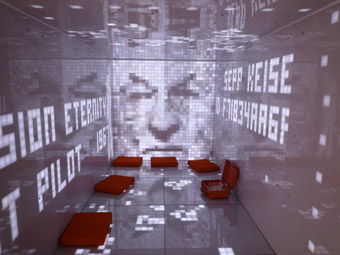
M∞ Sarcophagus, etoy.CORPORATION
photo Alexandra Crosby
M∞ Sarcophagus, etoy.CORPORATION
This year is the first time that the newly built Ars Electronica Centre has hosted the festival, and the four storey permanent exhibition takes a whole day to get through. Most impressive here is a temporary installation, unfortunately up some stairs and rather off the beaten track, of etoy’s fabulous M∞ Sarcophagus, part of the ongoing project, Mission Eternity. The ambitious aim of this work is to create a cult that can explore life after death in the digital age and “forever after.” The etoy.CORPORATION, most famous for their victory in the ‘toywar’ in the late 90s, defines the work as “a metaphysical adventure: an arcane network of computers, mortal remains, emotions, cargo containers, scientists, artists and hackers.” To view the process, we enter an immaculately designed shipping container. Inside are the digital and physical remains of pioneers of the information age who fit the criteria to be test pilots. So far there are two pilots: LSD guru and cyber writer Timothy Leary and Sepp Keiser, who broke new ground in microfilm and photocopying technologies in Switzerland. Keiser, in fact, is not yet deceased, but his contract with etoy ensures that when the time comes, his ashes will be cemented into the container’s pixel display. His digital portrait will be perpetually created, as fragments of safeguarded data are transmitted by thousands of ‘angels’ around the world.
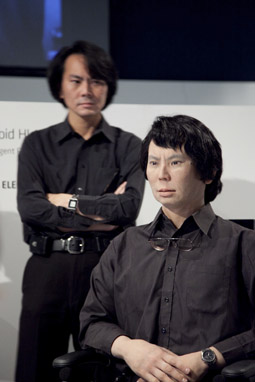
Geminoid Hl-1, Hiroshi Ishiguro
photo Alex Davies
Geminoid Hl-1, Hiroshi Ishiguro
More than 300 events were packed into this year’s Ars Electronica. One of the stars of the week was Hiroshi Ishiguro’s clone of himself, Geminoid Hl-1, which can be operated remotely using complex network and sensor technology. Perhaps with my own Geminoid, I could have made it to all the performances, forums, and symposia during the festival, but without robotic assistance, I had to contend with the limits of human nature.
Ars Electronica 2009, Festival for Art, Technology and Society; Linz, Austria, Sept 3-8
For more images and information on Lawrence Malstaf’s Shrink see www.360cities.net/image/shrink-performance-ars-electronica-linz;
www.fortlaan17.com/artists/lawrence-malstaf
RealTime issue #93 Oct-Nov 2009 pg. 30
© Alexandra Crosby; for permission to reproduce apply to realtime@realtimearts.net
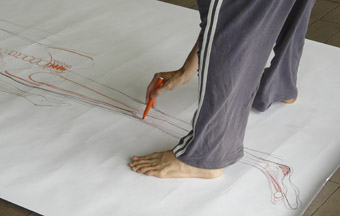
Thinking Through The Body, workshop, Bundanon Trust
photo Catherine Truman
Thinking Through The Body, workshop, Bundanon Trust
THE BODY OBSERVED IS A KEY TO OUR CULTURE. THE BODY AS TEMPLE PERMEATES PARTS OF THAT CULTURE IN WAYS THAT ARE REGARDED WITH CURIOSITY. THE TEMPLE OF KNOWLEDGE IS ANOTHER APPROACH TO THE BODY, UNDERSTANDING OUR EXPERIENCE OF THE WORLD THROUGH REFLECTIVE PRACTICE AND EXPERIMENTATION WITH TOUCH, MOVEMENT AND THE SENSE OF ONE’S POSITION AND VOLUME IN SPACE—PROPRIOCEPTION. THINKING THROUGH THE BODY (TTTB) IS A NSW-BASED INTERDISCIPLINARY RESEARCH PROJECT EXPLORING THE USE AND POTENTIAL OF THE BODY IN INTERACTIVE ART PRACTICES.
While for the past five decades research around the potential of the body in contemporary culture has developed exponentially, from philosophy and sociology, to contemporary arts, healthcare and human-computer interaction design, including haptic displays, bio-metrics, robotics etc, the lived experience of the body-as-subject has remained largely unexamined.
The project began over two years ago in response to the Australia Council for the Arts Inter-Arts Office ArtLab 2008 initiative, that set out to fund up to $75,000 development projects “with an artistic process that demands a very high degree of risk-taking from all involved.” Artists would be expected to experiment with “radical creative processes and be flexible to outcomes that cannot be predicted in advance.” The industry partners with TTTB in this process included Campbelltown Arts Centre, Bundanon Trust and Performance Space, who provided quite different spaces in which the work could proceed.
Without a doubt all the parties involved took risks, launching into unknown territories both as individuals, groups and organisations; no neat outcome could be assuredly predicted. TTTB demonstrated the need for focused research applied to interdisciplinary practice—many of us often seek material contexts for achieving this—but how are we now situated using the knowledge gained through the series of events pursued by this group of collaborators?
One of the project’s initiators, Lizzie Muller, framed some initial conclusions about what has happened as “an experiment in exchanging knowledge and also an experiment in making.” As a curator and recent researcher in the area of interactive media arts, she had previously worked with George Khut on the Cardiomorphologies project through the Creativity & Cognition Studios at UTS and Beta_space at the Powerhouse Museum (RT72, p10). Carefully developed approaches to observing and understanding audience experience of the bio-feedback gained through interaction with the Cardiomorphologies installation led Khut towards recognising the need “to spend some time thinking about connections that I was very interested in between interactive art and somatic bodywork practice. The practice is essentially about a way of re-experiencing the organisation of yourself—of your muscles and skeleton and the movement patterns that you’ve learnt through your life from infancy…Comparable forms of somatic bodywork might be the Feldenkrais Method, the Alexander Technique, things like Body-Mind Centering from Bonnie Bainbridge Cohen…”
The eight TTTB collaborators included Catherine Truman, an artist and certified Feldenkrais practitioner and another Adelaide-based trainer in the discipline, Maggie Slattery; Jonathan Duckworth, artist and interaction designer from Melbourne; Garth Paine artist and academic researcher at the University of Western Sydney’s VIPRe Studios; Lian Loke, artist and Interaction researcher at UTS Human Centred Technology Design group; and media artist and writer Somaya Langley.
Initially, when the group assembled at Campbelltown for the first residency in mid-2008, the differences for Slattery were palpable: “I’ll never forget the first time we had a meeting and everybody but me sat with a laptop on their lap; and I felt naked because I didn’t have a belly that was a screen where I could play my work…The emergence of interactive art began to make sense to me, as somebody outside of a generation who has grown up with technology. One of the things I picked up on was where the word interface is about a relational point between technology and self”, a difference amplified later by Langley: “most of the work that I do is in front of a laptop, so my brain’s out there, the laptop’s my entire interface to what I’m doing.”
Reflections about the initial shared space continued on the TTTB website leading on to the residency six months later at the Bundanon Trust on the Shoalhaven River in rural NSW. Muller observes that, “we were all abducted by aliens, which sounds extreme, but as a metaphor for what an intense experience we’d had it conveys a sense of it to other people.” The Feldenkrais practitioners took a lead, with Truman working through a series of awareness-through-movement lessons interspersed with workshops based on drawing the body; then moulding the body from clay, repeated both sighted and unsighted. “I’m finding each person in this workshop through my philosophy, I guess, and I’m trying to say, what is it you’re asking in your work? Or what is it that interests you? I think it’s really that simple. Rather than what’s out here, what does this technology do, I’m just trying to get people to—and it’s a question I ask myself, it’s my learning, my questions, things I need to know—why is it so important that I need to ask this of somebody else?”
For Khut the outcomes from Bundanon were about establishing a shared language and working through questions as they arose. “So we’re not making art from Feldenkrais or making Feldenkrais from art, it was something else, an understanding. It was about trying to identify these shared approaches and shared sets of questions that these two areas had and how they could enrich each other…[W]e had a session where we brought in some different interactive systems that made sounds from movement or light, or you would hear things in relation to a landscape and we were able to reflect on that in combination with the two workshops that Catherine [Truman] did; and then the workshop that Jonathan [Duckworth] did, which was about being in the landscape and how that connects to an experience of embodiment.“
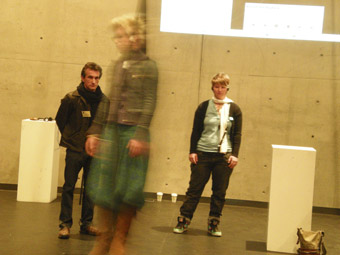
participant in pendulum piece, Jonathan Duckworth, Sensorium Gymnasium, Performance Space
photo Alejandra Mery Keitel
participant in pendulum piece, Jonathan Duckworth, Sensorium Gymnasium, Performance Space
Duckworth works professionally with patients who have suffered traumatic brain injury and as a result their body self-image is fragmented, resulting in difficulty moving and coordinating a number of motor functions. “So this workshop has helped me realise that the sensing required to become aware of your own body was in much finer detail than the way that I’d been exploring previously.”
At Sensorium Gymnasium, a day-long opportunity for visitors to engage with TTTB’s experiments, Garth Paine’s installation was constructed to demonstrate some provisional conclusions: “I’ve been recording motion capture data [gathered from] subtle Feldenkrais manipulation and it does have incredibly fine nuance which is something I can take away and continue to work with and share…I’m sonifying data at the moment and might also generate some visualisations. So there could be an experiential space that becomes a real-time sonification and visualisation of motion capture data in the space.”
Lian Loke’s understanding of the body comes from dance. The design approach to working with motion-sensing technologies has encouraged her to map relationships between the languages and vocabularies of other disciplines for her use as a designer, to negotiate the different perspectives afforded. The experience has been “about skilling up in that way so I can actually come from a more established foundation myself when designing things.”
Lizzie Muller in describing the “profound gift” of the experience concludes that, “Working in this way with these people has helped me to understand what it is that draws me to art. It is to do with the way it transforms our ability to understand the world.” George Khut has concluded “what motivates me is a desire to create systems and situations that support us to become more alive to the worlds around us and within us; and to be able to experience and engage with this aliveness with a sense of grace, delight and care.”
Thinking Through The Body: Campbelltown Arts Centre, Bundanon Trust, Performance Space, http://thinkingthroughthebody.net/; Sensorium Gymnasium, Performance Space, CarriageWorks, Sydney, Aug 3
RealTime issue #93 Oct-Nov 2009 pg. 31
© Mike Leggett; for permission to reproduce apply to realtime@realtimearts.net
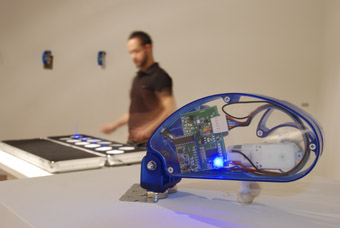
Eugene Ughetti and Radiobot
photo Matthew Gardiner
Eugene Ughetti and Radiobot
“WAS THAT THING FROM PREDATOR?” TWO SHEPPARTON TEENAGERS AMBLING AWAY FROM MATTHEW GARDINER’S NEW SHOW RADIOBOTS WOULD MISTAKE THE WORK’S CENTRAL INTERACTIVE CONSOLE, WITH A SERIES OF SEQUENTIAL INSIGNIAS, AS BASED ON THE EXPLOSIVE DEVICE ON THE ARM OF THE 1980S ACTION FILM’S ALIEN. OF THE WEIRD CONNECTIONS ONE CAN MAKE WHILE OPERATING RADIOBOTS, IT MAY NOT BE SO INCONGRUOUS TO ASSUME OF THEM AN OTHERWORLDLY ORIGIN.
The work is presented as a contraption in the truest sense; a short slideshow loop plays on a screen across the gallery, detailing the design and construction process. The Rabiobots themselves are meticulously constructed objects, looking somewhat like products of a marriage between a stapler and a cockroach. Inside their blue carapace, radio receivers are connected to a simple mechanism that makes them loudly tap a sinister pair of proboscises against the surface to which they are attached. Inside the front rooms of the Shepparton Art Gallery, they are affixed to plinths of various heights, to walls, to ceilings. One, most satisfyingly, is on a strip of metal, looking all the world like a caterpillar with a leaf to itself. To signal each of them to act, visitors approach the console and tap on hexagonal plastic drum pads.
While surly teenagers and roaring children are happy to experiment with hardcore death metal speed-drumming and group concertos, the noise that the contraption produces with a single tap is just as vital. Percussive art practices have often found silence as pliant and malleable as clay. Yet the quietude of the Shepparton Art Gallery, apart from anything else, is manifestly different, not the least reason being the phantasmagorical surprise of the Radiobots’ clack-clack when you are elsewhere in the gallery. The sonic force reverberates around the rooms and halls to symbiotic effect—what seems like an infestation of the alien quickly becomes a polyvocal chorus of the environment. The gallery grows itself a tongue with which to clack.
Gardiner recapitulated this impulse by performing a series of Radiobots workshops and performances with collaborators, percussionist Eugene Ughetti and Aphids’ director David Young. With a residency with Ars Electronica in Austria, Gardiner has positioned this generation of Radiobots as a nursery for future percussive installations internationally while attenuating the exhibit to the local environment. His work has concentrated on hybrid practices for many years; the Oribotics sequence from 2004-2008 also invoked a range of concerns to do with local environments and the swarming memories of people interfacing with his artworks. Shepparton, then, demands that it uses the gallery’s tongue as well. 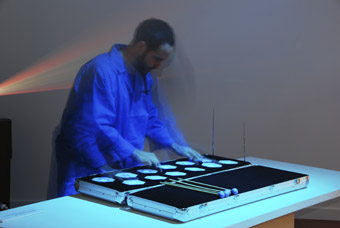
Eugene Ughetti, Radiobots
photo Matthew Gardiner
Eugene Ughetti, Radiobots
With a diverse range of gallery programs growing and changing in the vast Australia outside the capital cities, it becomes harder to dismiss regional galleries as provincial. Shepparton’s upstairs pottery collection, was one of the best places to experience Gardiner’s installation. Through the peculiarities of sonic accrual, it was possible to sense the Radiobots sending a disturbance in the air, and in the vibrations coming up through the ground, it was like listening to sealife converse underneath a sheet of ice. There, generations of handicrafts posed for ornament and historicity emanated slight hollow echoes each time a pad downstairs was pushed. Just a few feet away, Rita Lazauskas’s melancholic daily sketches and drawings were similarly altered, as the distinction between the heaviness of her images from home and the lightness of those made during travel were punctuated and made more pronounced by the aural hammering.
A quick visitor to the gallery, however, might see a more inchoate and disconnected form of life, perhaps parasitic in the best tradition rather than romantically symbiotic or expressive. The work is, despite the cool and clinical construction, also an agent of purest bedlam. The percussive effects swarm around the rooms as the pads are struck in sequence, while the work is arranged in such a way that they likewise fold behind the front desk and its staff, who also become agents in this unusual biosphere.
All sound art is also about the spaces and volumes in which the sound lives. In a sense, the teenagers were right, the Radiobots are predatory after all. If you do not stay to inhabit the space yourself, the work dominates. The future installations and generations of Radiobots promise Ars Electronica in Linz as a site of infestation, alongside bridges and public objects—more localities in which to grow tongues, and new audiences to speak in them.
Radiobots, artist Matthew Gardiner, ?technical designer Ray Gardiner?, composer David Young, ?percussionist Eugene Ughetti?, producer Aphids in association with Shepparton Art Gallery and Riverlink, Shepparton Art Gallery, Victoria, Sept 1-20
RealTime issue #93 Oct-Nov 2009 pg. 32
© Christian McCrae; for permission to reproduce apply to realtime@realtimearts.net
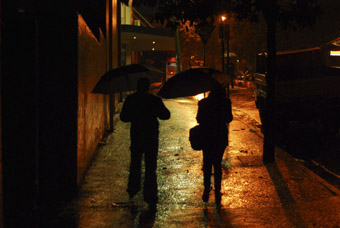
Razorhurst participants
photo courtesy d/Lux/MediaArts
Razorhurst participants
IN BARCELONA, A SMALL PLAZA IN THE MOSTLY GENTRIFIED BARRIO GOTHICA HAS BEEN LEFT PURPOSELY UNRENOVATED. THE STONE WALLS ARE HEAVILY POCKMARKED BY GUNSHOTS FROM A FAMOUS BATTLE BETWEEN LOYALISTS AND REPUBLICANS. VISITORS RUN THEIR HANDS OVER THIS EERIE AND VISCERAL REMINDER OF ALL THAT CITIES WITNESS AND ABSORB. YET THE BARRIO GOTHICA HAS ARGUABLY BEEN SAVED BY THE GENTRIFICATION OF ITS LABYRINTHINE ALLEYS. IF THEMED HISTORY PROTECTS AN ENCLAVE, CAN IT BE ALL BAD?
I entertain myself with these thoughts while I wait to play the GPS game Razorhurst in Sydney’s East Village pub. I start writing on the branded beer coaster (nice touch). This once notorious hotel—in my youth The Tradesman’s Arms and a well-known hangout for ‘fences’—is friendly on a Friday night yet retains its patina of criminal mystique. A group of suits discuss tax minimisation, three old blokes with beers are on first-name terms with the barmaid, a tranny and her sidekick cruise by, a paint spattered renovator realising his rendezvous hasn’t materialised reaches for his phone. The original pressed tin ceiling bears witness: if, as JG Ballard imagined, it has absorbed all the sounds that were emitted under its canopy, what stories would it know? What would the original art noveau wall tiles reveal under forensic analysis? I’m clearly ripe for transportation to Depression era Darlinghurst.
Considering the links between the visceral and memory, what role do digital media have in enhancing the powers of historical imagination and in reinvigorating lost histories and spaces? With Razorhurst, presenters dLux/Mobile and creative developer Richard Fox combine urban history with game elements in a GPS-based locative experience. Inducted at the pub, players proceed with GPS enabled handsets and headphones to explore the surrounding streets, collect ‘sly grog’ and fight or join roving groups of razor-wielding gangsters. The content of the game comprises some excellent graphics, stills, movies and audio, both original and archival (sourced from the City of Sydney archives, the Historic Houses Trust NSW and ABC radio drama). The original sound, movies (shot by Mattias Morelos) and graphics have been designed and produced by Fox, and his background as a professional art director hold him in good stead—the overall look and feel are great, from the aforementioned beer coasters to postcards, posters and screen graphics. I liked his voice on the audio, too—a good thing as the experience is heavily audio-based.
The main interface is a GPS-enabled street map, and while this worked well technically, on the night I played I felt that a less heavy reliance on GPS would have benefited the game’s experience design. Using analogue wayfinding and self positioning (eg asking players to orientate to buildings or topography) would lessen the dependence on map reading and allow them to look up at the district. Reliance on location to trigger content, when GPS is quite a coarse grained technology, is also problematic, and possibly a combination of temporally and spatially triggered content would prove more flexible. I would have been happy to have more developed character through-lines and these may be a better direction to pursue than the incorporation of game elements (collecting bottles, losing health to gangsters). The experience straddles themed historical walking tours and games, and as such it must achieve a textured pace. While it succeeds at times (I do literally run from the gangsters), at others I would have preferred dwell-time to stand and hear the narrative more developed.
Overall I found the experience affective. Ever ready to be engaged, I felt that the close-miked audio (perhaps enhanced by unintended looping), the rainy streets and the fast walk around the district darkly familiar to my youth did work to evoke and titillate. I was back in a time when Darlinghurst was not populated by four wheel drives and filled to capacity with so cool-as-to-chill Italian design emporia. I scurry through St Peter’s Lane, run up a back alley to avoid the gangsters racketing in my head, and out of the corner of my eye see layabouts camped on the narrow terrace porches. The brightly lit City Gym reminds me that in the Depression only the fittest survived and muscles were developed hauling fruit boxes down at Paddy’s Markets or wringing wet sheets by hand in some dismal backyard.
Vodka is the new gin and I opt for it over a complimentary gin as my post-game reward. I’m ready to get home and away from thoughts of the many tear-soaked pink gins to which this hotel undoubtedly bore witness.
Razorhurst, designed & developed by Richard Fox, presented by d/Lux/MediaArts, East Village Hotel, Sydney, July 5-31; for full credits see www.razorhurst.com.au
RealTime issue #93 Oct-Nov 2009 pg. 33
© Kate Richards; for permission to reproduce apply to realtime@realtimearts.net
REVOLUTIONS HAPPENED IN 1968, STUDENTS IN PARIS AND ELSEWHERE AND IN COMPUTING EVERYWHERE. BUT THE COMPUTING REVOLUTION WAS BOTH PRO AND ANTI. FOR MANY IT MEANT AUTOMATION AND THE LOSS OF EMPLOYMENT, FOR SOME PROFESSIONALS IT CREATED NEW WAYS OF WORKING AND FOR ARTISTS IT INTRODUCED A FORM THAT HAD NO KNOWN ANTECEDENTS, “EXPAND[ING] OUR SENSE OF WHAT WE MIGHT BE ABLE TO DO WITH SUCH TECHNOLOGIES”, WRITES CHARLIE GERE IN WHITE HEAT COLD LOGIC, BRITISH COMPUTER ART 1960-1980.
Of course now computers have become ubiquitous to the point of invisibility but they began in an age when electronics were big and took up whole rooms—requiring their own air-conditioning and acolytes to see to their every need. Between 1960 and 1968 they began to be more compact and by 1968 the desk-sized (not yet desk-top) computer was available. For some this meant that computers became available and for a very adventurous few they appeared in several British art schools.
Although the artworld didn’t really notice, it was leapfrogged by the digital world late in ‘68. Two things happened. One was a conference at which computer graphics packages were proposed and a society was formed. The other was the single most important exhibition in the field of computers and the arts. The society was the Computer Arts Society and the exhibition was Cybernetic Serendipity at the ICA in London, both of which were of extraordinary importance and continue to be relevant throughout the period and the book.
With the evolution of kinetic art into interactivity and conceptualism computers became accessible at the right moment. This book covers many aspects of that story, bringing us accounts from the pioneers of computer art in Britain of their personal encounters with computers through happenstance or in the process of work or study, and sometimes of art.
The chapters in White Heat Cold Logic, although they show a wide range of detail, introduce the developments of individual artists, the role of cybernetic notions and interactivity in computing, Jasia Reichardt’s especially significant exhibition Cybernetic Serendipity and the importance of the computer arts society.
British artists’ engagement with the computer was tightly linked to the development of cybernetics in Britain, after its initialisation in the US by Norbert Wiener in 1948, with Ross Ashby, Stafford Beer and Gordon Pask being the leading figures. Of these Pask was the one who made the main representation of notions of cybernetics in artistic forms. Several chapters discuss aspects of his work as it impacted on the work of visual artists, architects and teachers.
After a cursory introduction the real story begins with the artist and teacher Roy Ascott, who realised that as a system of relationships between an artist, an artwork and the audience, the work of art could develop to the point where it might actively engage members of the viewing public, thus introducing the notions of an art that behaves (ie interactive art). Pask had helped Ascott navigate the biological and mathematical literature of cybernetics, revealing its simplicity. Ascott then introduced these notions in understanding the experience of art and in its teaching and later, using telecommunications networks, extended them to the telematic or art that is an active partner in communications.
Pask’s work in art is detailed by Maria Fernandez in her chapter, in which she considers his “understanding of the work of art as a system that evolved independently or in interaction with a participant.” This appears particularly in his The Colloquy of Mobiles installation that featured in Cybernetic Serendipity, and the realisation that the self-organisation of the artwork required the audience to be able “to make sense of it.”
Pask also influenced Stephen Willats, another cybernetic artist working with feedback systems, who was also a colleague of Ascott’s in the mid-1960s. He began by studying the changing relationships the audience had with artworks when they moved around them while he was working in several London art galleries. From his observations he constructed a series of artworks that the audience could manipulate. Other early chapters introduce Cedric Price’s proposals—again guided by Pask’s ideas—for an interactive architecture “driven by social idealism” in which buildings would organise themselves around the needs and behaviours of their inhabitants.
Cybernetic Serendipity is discussed by several authors, including its original curator Jasia Reichardt, and Brent MacGregor’s later revisiting of the exhibition through the archives. Reichardt covers the experimental foundations of what led to this seminal computer art exhibition and she also introduces some useful pointers to ways in which one might make aesthetic judgements about computer art. Cybernetic Serendipity included computer graphics, music and poetry, cybernetic devices and installations such as Pask’s Colloquy and robots like Paik’s K456. It also included a history of cybernetics and provided opportunities to experience the uses of the computer.
Of the historical surveys Richard Wright’s chapter provides an important reminder of the role of the Constructivists and the British Systems Group as precursors. Two other important occurrences also receive mention. One is the establishment and growth of the Computer Arts Society, ably supported by Gustav Metzger, Alan Sutcliffe and the late John Lansdown. The CAS became a meeting place, exhibition organiser, a lobby group and the publishing arm for computer artists from 1968. The other is Edward Ihnatowicz’s two interactive sculptures. His first was SAM (Sound Activated Module) shown at Cybernetic Serendipity, which listened to and appeared to attend to the source of any sounds in its locale. The other was the truly significant demonstration of the principles of artificial intelligence he incorporated into the Senster. This very large robotic system was built for the Philips Industries Evoluon in Eindhoven, Holland, where it entertained audiences for several years. Both SAM and the Senster are discussed in Aleksander Zivanovic’s chapter and Richard Ihnatowicz’s memoir of his father.
Essays and memoirs by many other computer artists are included, among them Alan Sutcliffe, Harold Cohen, George Mallen, Stephen Willats and Ernest Edmonds, all of whom held a variety of roles including programming, engineering, teaching and all important—creating the extraordinary range of artworks that might be assembled under the rubric of computer art.
The role of institutions is covered through essays such as Doron Swade’s chapter on computer art in the science museum and Catherine Mason’s chapter on the role of academic institutions in providing access to and teaching of computing to students in the fine arts as well as engineering. More detailed discussions of some of the art schools are included in Stephen Bury’s memoir of his time at the Chelsea School of Art, Paul Brown’s discussion of generative art at the Slade School and John Vince’s chapter on the development of PICASO, one of the most successful early British computer graphic and animation applications, at Middlesex Polytechnic.
This is a generally interesting and well-written though lightly edited book that provides a valuable look at a sadly neglected but very important aspect of art history. The main problem with a book of this kind, made up of essays by a large number of people, is that the construction of an overview is difficult. Each time an event is mentioned one can hopefully remember that so-and-so and she and he all made contributions to this event. But there is very little that actually points out the relations that operated between many of the artists unless a particular author discusses the collaborations they had or members of the class they attended, even if only through a coincidental presence at an exhibition or an art school. There is an extensive index but the absence of a comprehensive bibliography is unfortunate, though this can be redressed by a trawl through the endnotes for each chapter.
While the book introduces us to many of the individuals, artists and computer scientists who made a contribution to digital art in the UK from 1960 to 1980, it does not do the complementary task which is to introduce us to the systems and machines on which that art was made, to the displays and plotters, to why computer art is so dependent on its hardware, to what was possible, to computer music making and especially to the technical people who helped make the systems. One of the editors and contributors Catherine Mason has her own book, A Computer in the Art Room: The Origins of British Computer Arts 1950-80, which I rather hope does some of that, but I have yet to see it.
White Heat Cold Logic, British Computer Art 1960-1980, edited by Paul Brown, Charlie Gere, Nicholas Lambert and Catherine Mason. Cambridge, Massachusetts, MIT Press, Leonardo imprint, 2009
RealTime issue #93 Oct-Nov 2009 pg. 34
© Stephen Jones; for permission to reproduce apply to realtime@realtimearts.net
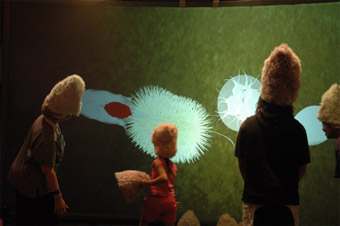
Metazoa, 2008, Angela Main, Super Human Exhibition
courtesy the artist
Metazoa, 2008, Angela Main, Super Human Exhibition
FOR THOSE FEELING THE URGE TO EVOLVE, MELBOURNE IS THE PLACE TO BE IN LATE NOVEMBER AS LEADING MEDIA ARTS MAKERS, COMMENTATORS AND HISTORIANS CONVERGE FOR THE ANAT’S SUPER HUMAN: REVOLUTION OF THE SPECIES. CELEBRATING THE 150TH ANNIVERSARY OF THE PUBLICATION OF DARWIN’S ORIGIN OF SPECIES, THE EVENT INVOLVES A SYMPOSIUM, MASTER CLASS AND MONTH-LONG EXHIBITION EXPLORING COLLABORATIONS BETWEEN THE SCIENCES AND THE ARTS AND THE IMPACT THESE HAVE ON BEING HUMAN.
Keynote speakers for the event include Ju Gosling (UK), working with digital lens-based media exploring ideas of the able and disabled body; Tami Spektor (US) an organic chemist with an interest in nanotechnology; Barbara Maria Stanford (US) who explores the intersection of visual arts and neuroscience to shape our senses; Paul Brown (UK) media artist exploring robotics and neuroscience; and Junichi Ushiba (Japan) who has developed the Brain-Machine Interface (BMI), offering the potential for people to operate avatars in SecondLife just by thinking about it.
There will also be two days of masterclasses with a wide range of international and Australian artists, curators and thinkers with practical advice on resource networks, marketing and audience development, as well as theoretical discussion, from the likes of Amanda Macdonald Crowley, George Poonkin Khut, Lizzie Muller, Kim Machan, Jens Hauser and Sarah Cook.
Wedged between the Symposium and Masterclasses is Re:live 09, an International Conference on the Histories of Media Art, Science and Technology, which will dig through the vault for alternative histories of the media arts, with presentations by three keynote speakers. Zhang Ga is a media artist and director of the Netart Initiative, responsible for the large scale public artwork, People’s Portrait, part of MAAP04 which utilised big screens in New York, Singapore, Brisbane, Linz and Rotterdam to display photos of a participating general public. Lisa Gitelman is co-author with Geoffrey B Pingree of New Media, 1740-1915 (2004) which extends the idea of new media as a phenomenon of the 20th and 21st centuries exploring what new technologies meant culturally in the 18th and 19th centuries. Making a welcome return (he was a lecturer at UTS in the 90s) Doug Kahn is best known for excavations into the history of sound in the arts in his books Noise, Water, Meat (1999) and Wireless Imagination: Sound Radio and the Avant-Garde (1992). Kahn will also be one of the Superhuman Masterclass presenters as well as delivering a series of lectures around the country courtesy of ANAT’s Embracing Sound Program and their partnership with Art Monthly. Nested within Re:live will be the Leonardo Education Forum.
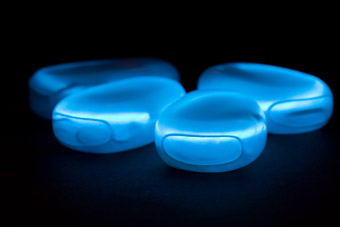
Drift, 2009, Leah Heiss, Super Human Exhibition
courtesy the artist
Drift, 2009, Leah Heiss, Super Human Exhibition
The Super Human Exhibition will run for the entire month at RMIT Gallery with works by Justine Cooper, Jonathan Duckworth, Donna Franklin, Tina Gonsalves, Leah Heiss, George Poonkhin Khut, Angela Main, Brad Nunn, Jill Scott, Paul Thomas, Tissue Culture & Art Project and Mari Velonaki. Other aligned activities include a SymbioticA workshop just prior to the conference and ABC’s Pool presenting a new thematic space called Gene Pool. By December, the human race may well have advanced a step or two along the evolutionary pathway or, at the very least, the well-being of new media art ecology will have been given a boost. RT
ANAT, Super Human, Symposium Nov 23-24, BMW Edge, Federation Square; Masterclasses Nov 25-26; Exhibition, Nov 5 – Dec 5, RMIT Gallery, http://www.superhuman.org.au/; Re:live – The International Conference on the Histories of Media Art, Science and Technology Nov 26-29, http://www.mediaarthistory.org/relive/; Melbourne
RealTime issue #93 Oct-Nov 2009 pg. 34
© RealTime ; for permission to reproduce apply to realtime@realtimearts.net
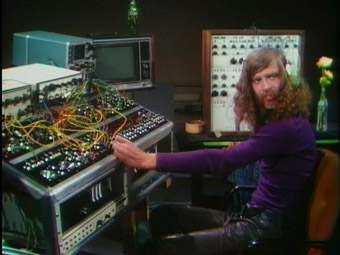
Stephen Beck
image courtesy the artist
Stephen Beck
A REVIEW OF THE ORIGINS OF VIDEO ART UNCOVERS A SIGNIFICANT, MULTIFACETED FIGURE, THE NORTH AMERICAN VIDEO ARTIST STEPHEN BECK, WHO DESERVES ACKNOWLEDGMENT FOR HIS CONTRIBUTION TO REAL-TIME AUDIOVISUAL PRODUCTION. THE CREATIVE PERSONALITY OF BECK’S WORK HAS TAKEN SHAPE IN VARIOUS FIELDS OF ARTISTIC EXPRESSION: VIDEO-SCULPTURE, INSTALLATION, MUSIC, PERFORMANCE, MUSIC VIDEO, VIDEOGAME DESIGN AND RESEARCH. THERE ARE NO DEFINITIVE BORDERLINES IN BECK’S WORK; HE EMPLOYS VIDEO AND OTHER TECHNOLOGIES TO TRANSLATE AND REPRESENT HIS SINGULAR EXPERIENCE.
Between 1969 and 1970, as an electronic artist in residence at the National Center for Experiments in Television (NCET) at KQED-TV in San Francisco, he developed the Beck Direct Video Synthesizer, an ingenious invention for the generation and manipulation of analogue images in real-time. With it he created a series of audiovisual performances, Illuminated Music, in 1972-73 before a live audience interpreting a musical piece previously recorded or conducted live, with the images displayed on television screens or by projectors. Performativity, spontaneity, ubiquity, the non-objective nature of the art work, its ephemeral quality and the immediacy of its representation highlighted the uniqueness of the work, translating the experience of the artist’s interiority into a non-verbal language with symbology and Eastern imagery. In Beck’s own words:
“I had the image come to me from listening to the music, and as I often do, much of my work in visual art and video is based on what I see with my mind’s eye, my eyes closed—inner imagery. I’ve seen inner imagery for as long as I can remember, even since I was a young boy—phosphenes, hypnogothic [sic], hypnopompic, eidetic, hallucination, meditation. So, as I would listen to the music and start to see certain visual elements I would notate them into the score for the visual composition.
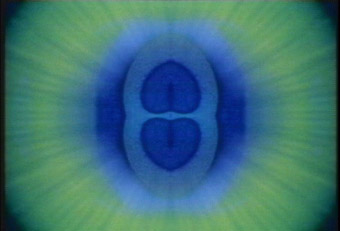
Yoni Glow, Stephen Beck
image courtesy the artist
Yoni Glow, Stephen Beck
“Now, in each performance of Illuminated Music that followed over the next two years, if you looked at all six of them, you would see there is a similar structure. It begins with these tiny rotating particles, suggesting perhaps, subatomic particles or some kind of magnetic, gravitational, orbital, based on sine waves, and then it kind of expands into these waves of lines and lace, becoming from one dimension of a point to two dimensions of lines and weavings. Eventually, solid smooth orbs and spheres appear along with a final spiral vortex, symbolising the great energy of the cosmos as [it] has been exhibited in many cultural icons throughout history.”
Beck reorients non-objective art in Illuminated Music I and II through an extraordinary communion with the soundtrack, a creative ‘synthony’ that demonstrates the multidisciplinary character of the artist’s background, with its roots in electronic music (Beck studied with John Cage at the University of Illinois). In his work we can perceive music as an inspirational source, both in the execution of the audiovisual work in real-time, and in the later addition of the sound as a component that determines the meaning of the audiovisual message. The structure of his message, as Beck himself describes it, presents certain analogies with jazz: the presentation and development of a theme with variations. Beck uses a grammatical syntaxis that gains strength with improvisation, the reading and in situ interpretation of a musical piece: “…that was kind of my concept, wanting to try to create a form of visual jazz, that would flow in time like music but be visual, and also have a compositional structure that was formal and intact, but still allowed for variations in the way that it was played and performed.”
Beck’s vision has technology and art flow together in a fertile encounter. At the end of the 1960s, Gene Youngblood, in his book Expanded Cinema (1970), a seminal work that embraced video and computers, demonstrated a collaboration between engineers and artists that was already happening in west coast America. In the vein of Harry Smith, Jordan Belson and the Whitney brothers, in the work of Beck we can appreciate the creative side of the man-machine symbiosis. Technology is a tool at the service of artistic expression.
With the works Colour Music and Lumia, Beck’s intention was to achieve a synaesthetic union of sight and sound—which could be expressed as “painting the music.” By creating and manipulating form, colour, texture and movement, Beck introduced the embryonic electronic image in constructing an audiovisual discourse in real-time. Beck’s 25 frames per second contributed to the acceleration of the processes of interaction and participation in new media. He says, “At this point, in terms of real-time video performance, that was pre-digital era. There was no programming, there was no pre-recording (of video), it was played live on the synthesizer.
“Well, I always like to say that my art spans from pre-digital to post-digital. Pre-digital meaning the era that I started, the late 1960s, when for all practical purposes, there was not much available to video artists in digital computing that could do a dot—draw one monochrome dot on a screen. It would take hours to draw some more, they had to be filmed with stop action, such as John Whitney’s work, Arabesque. Post-digital, meaning the current era, is all pervasive. I still describe myself as live and analog, meaning I prefer the analog texture, the analog approach, even though of course, I’m using digital tools, fully and completely now like everyone else because of the ease, convenience, quality control.”
Another of Beck’s most celebrated video pieces is Voodoo Chile (1982), a music video with recorded music from Jimi Hendrix, where we cannot separate music from image. In making Voodoo Chile Beck mixed real time with video editing: “All the varieties of scenes that you see in Voodoo Chile, optical seeding, video synthesis, a lot of use of video feedback, analog fractals, which I had learned to control with special circuitry in my Beck Direct Video Synthesizer to obtain video feedback-type effects and energies that were unique. And they also had the rights to an image of Jimi Hendrix playing the guitar, but my concept for Voodoo Chile was to not show Jimi Hendrix playing the guitar, but to show a light show-like visual interpretation of his music. Not, you know, a definitive visual interpretation, but my visual interpretation.”
Almost four decades have passed and Noor (2005-09) is Beck’s most recent project. Ambitious and in constant development, Noor is a live organism where imagery and motifs from Eastern cultures come to life through abstract form and patterns, models of representation and expression, showing the richness of Beck’s cinematic speech. Working in his laboratory, leading the Noor project and teaching at the University of California at Berkeley, Beck still chooses experimentation as a way to structure his vision of culture with video as a medium. Lately, he is exploring the creative possibilities of digital tools, searching in the language of programming for new forms of representation. Noor is a metaphor for Beck’s primary concern: trying to decipher and explain the complex consciousness of a human being, translating it with images in movement. “To me, the goal of my art is to inspire…to reveal the beauty of life in a world that is often filled with ugliness and tragedy and darkness. So working with light, working with video, working with Noor is the latest form, the latest path, the latest method by which I hope and intend to realize this vision.”
This article is based on an interview with Stephen Beck, January 12, 2009, Berkeley, California for Ustarroz’s forthcoming book, Vj-ing Theory—Audiovisual Production and Representation in Real-Time, A Link to the Cinematic Avant-Garde of 20th Century. For more on Stephen Beck: www.stevebeck.tv
RealTime issue #93 Oct-Nov 2009 pg. 35
© César Ustarroz; for permission to reproduce apply to realtime@realtimearts.net
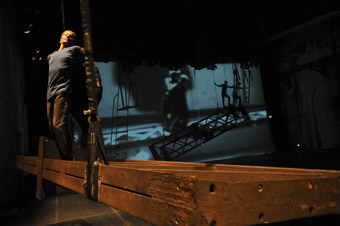
Peter Fraser, Linda Luke, Run: a
performance engine
DE QUINCEY COMPANY TRAINING IS SO CELLULAR, SO DEEPLY MUSCULAR, SO FULL OF BONE AND BLOOD, THAT THERE IS NO ESCAPE FROM FULL COMMITMENT TO TASK. BODY WEATHER PRACTICE MAKES ATMOSPHERIC PERFORMANCE: THICK WITH THE HEAT OF BODIES ENGAGED EVEN TO QUANTUM LEVELS.
Entering a DQC performance is to enter a world already ripe with the design and breath of what is to happen. Run did not feel like that. In a huge space, splintered, fractured and cold, dancers were initially held at a distance, making shape against lines of steel and pendulous sculpture. Surprisingly choreographic, Run did not immediately grab my guts. But amidst a harsh landscape a gentle build began to gather. Eventually, my stomach lurched with the drops and swings of heavy scaffold and vulnerable flesh, my cheeks pinked up with a familiar and sympathetic heat. No longer dancing from their skin and shape Tom Davies, Victoria Hunt, Linda Luke and Peter Fraser began to dance from their intestines and their sweat: ah, here it is.
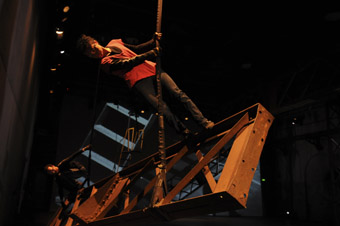
Tom Davies, Victoria Hunt, Run: a performance engine
Kudos to musician Dale Gorfinkel who came from Melbourne at a ‘moment’s notice’ to replace the ill Jim Denley. He sits on the floor with his back to the audience. Before him is strewn a miniature ‘orchestra’ of detritus: broken polystyrene, balls, tubes and all manner of unrecognisable gadgets. The sounds he creates from this barnyard of objects are often gentle, sitting below the surface of the action, only occasionally lashing out into rips and screeches. Sound itself is made apparent and performative by the various ways it enters flesh: ringing, vibrating, stinging, humming, droning. Sound hangs, lingers and shoots; sometimes funny or ominous, sometimes rhythmic and then almost invisible in its subtlety. Gorfinkel rattles, rings, dongs, chimes, bubbles, taps, vibrates, flicks and buzzes. When this music disappears it is only to reveal a distant but persistent hum coming from a somewhere, a bass line to his band and an archetypal comment on a world made of scaffolding.
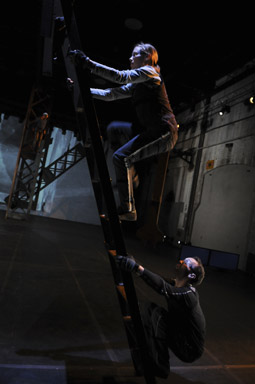
Linda Luke, Tom Davies, Run: a performance engine
photo Heidrun Löhr
Linda Luke, Tom Davies, Run: a performance engine
Linda Luke creates the opening image of a woman trapped in steel. She shifts her metal encased head in delicate axial glides that will break the fusion and start this hanging sculpture swinging. Throughout, this hunk of weight will turn, twist and sway, making visual the forgotten forces of gravity, weight, girth, solidity, steadiness, lift, fall, recovery, support, strength, thickness. The ebb and flow of energy meeting mass is made metallically graceful.
Sitting inside this beauty is the danger. These strong muscled dancers trust completely the ropes from which the mammoths hang. They ride, weave and duck in smooth timing, loving the steel that could smash and wither. Small gasps escape audience mouths as a scaffold flips and drops, taking bodies with it. Straight lined hunks of iron swing across my eyes, making arcs. Dancers jump over creaking metal carousels, which in their oncoming certainty crack, groan and grind out irresistible rhythms only to swing themselves into silence.
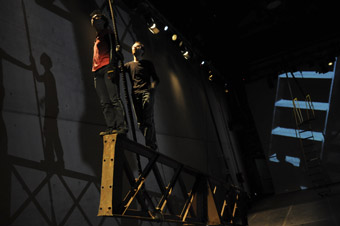
Victoria Hunt, Tom Davies, Run: a performance engine
photo Heidrun Löhr
Victoria Hunt, Tom Davies, Run: a performance engine
Feeling the mobile weightiness of such large sheets of metal was moving. And the ride the dancers took on them was titillating in its peril and satisfying in its accomplished ease. The program states that this “6 tonne dramaturgy” allowed the performers to “fly the space”. Hmmm, not so sure. ‘Flight’ is lift, take off and soar and Run was far more gravitational than this. Run was more earth than sky, more bowel than wing. Bounded groundedness was its thing.
In the mix with the dancers’ surfing on the laws of physics was the mediating technology. Live feed cameras created huge grey ghosts from coloured performers, making shadows dance on shadows of shadows, layering performing multiplicities in the same instance. Close-ups of steel revealed abstractions of monochromatic texture and pattern. Screens, hidden before, emerge, one after the other, revealing doorways of light. These are entrances to a moving stream of manipulated live images, smearing action across virtual depth as a beam of light is smashed into rays across the floor.
Production is performed as Travis Hodgson and Emmanuela Prigioni, sit on shinier, more modern scaffolds, creating worlds of light and video image. The roof and walls of CarriageWorks Bay 20 become sky in this “the scaffolding of the world”. So, so, so much to see, everything is interesting.
Do the dancers get lost in all of this density? Sometimes. But this is a sensible swamping to render them part-of; perhaps a gang of crazy bridge builders working in a landscape so much bigger than themselves. They dance in solos, duets, trios but rarely foursomes. They hug, fight, hang and laugh. They speak text that somehow seems like light relief. Walking on steely air, they slide down ladders, tangling with each other. Victoria Hunt is hurled and flipped by an invisible tormentor so violently I feel hurt. At denouement I am tired, over-stimulated, hot and twitching. It only ends when Gorfinkel stops and then there is that gap, where the audience is silent and slightly stunned: sitting inside that bassline hum that never went away.
–
De Quincey Company, Run: a performance engine, direction, choroegraphy Tess de Quincey, performers Tom Davies, Peter Fraser, Victoria Hunt, Linda Luke, sculptural installation and rigging Garnett Brownbill, Bernie Regan, lighting design Travis Hodgson, music Dale Gorfinkel, video artist Emmanuela Prigioni, media installation John Tonkin; Performance Space, CarriageWorks, Sydney, Aug 20-29
RealTime issue #93 Oct-Nov 2009 pg. 36
© Pauline Manley; for permission to reproduce apply to realtime@realtimearts.net
{$slideshow} PHILLIP ADAMS’ CHOREOGRAPHY SOMETIMES REPEATS A PHYSICAL ACTION UNTIL IT ACHIEVES THE TRANSCENDENT EXTREMITY OF RITUAL. BY TAKING ON THE SUBJECT MATTER OF MASS HYSTERIA AND APOCALYPTIC CULTS, WHERE THE HELD BREATH OF EXPECTATION IS CLOTHED IN MANTRAS AND CYCLICAL BEHAVIOURS, HE HAS FOUND A FITTING UNDERPINNING FOR HIS NEW WORK, MIRACLE.
Balletlab’s Brindabella (2007) was bisected by four dancers jogging in near-unison around the stage. This went on far longer than one expected and, in doing so, suspended the audience from any act of judgement or any desire to draw literal meaning. This was a relatively unadorned pause in between more elaborate worlds on either side. It acted as an enforced threshold, the thud of footfalls was mesmeric and the circling bodies hypnotic. We were being lulled into a different state.
In Miracle, it’s all about different states—the hallucinatory, the delusional, the ecstatic, the postmortem. We start in a state of quiet dislocation. The space is filled with brightly lit haze, creating an obscuring curtain of white. As the haze fades, four figures are revealed far back on the stage. They stand in a line, in loose-fitting robes: orange, yellow, blue, green. The costumes, by fashion designer Toni Maticevski, are a confectioner’s riff on tie-dye.
The dancers retain their stance and their silence for a long, enticing moment. After all, when you are waiting for the end of the world, anticipation is the key. Then, suddenly, and with great force, the sky opens up and peals of sound rush forward along with the dancers. Their bodies carve out a diagonal sweep and the speakers crush out an orchestrated wall of strings, voices and beats. Holding hands, the dancers retrace their steps, their mouths agape with cries, and they cross forward and back again and again until their efforts drive them into prostration. The effect of such intensity could be galling, eviscerating or transformative but the emptiness of the stage, marked simply by a square of grey, and the swathes of movement suggest an animated Franz Kline painting: urgent and physical, but safely contained on canvas.
In a question and answer session after the show, Adams felt that this particular run of Miracle had been “too cosy, too comfortable” for the performers. He stressed the importance of the hysteria being experienced, not merely represented. Yet he also spoke of his desire to achieve a “cinematic” effect. Perhaps he meant something else with this statement, but it seemed at times that the performers were fully enveloped by the experience, yet in the vast reaches of the Meat Market they were held at a projected distance from us that was neither threatening, nor fully engaging—we were invited to watch them but not to feel like one of them. We witnessed hysteria and ecstasy, but were never transported to that state ourselves.
Hysteria and performing arts are hardly strange bedfellows. The success of a theatrical experience usually demands a communal suspension of disbelief, arguably an act of mass hysteria. Thus, in making the experience of hysteria the sine qua non of Miracle, Adams binds the success of his concept and choreography to the success of its mass reception.
Nevertheless, even on a “cosy” night when the fever doesn’t quite set in, the extraordinariness of Miracle’s components is apparent. The stunning score is a joint creation by David Chisholm and Myles Mumford. They mix and process a range of diegetic and recorded sources, live for every performance, in what they describe as a “plunderphonic” composition. In the large, blank space, the multiple speakers cut through the air giving shape to the void.
The performances, despite Adams’ qualifications, display a rare mix of sensitivity and visceral dedication. BalletLab’s work has increasingly tilted towards the second part of its name and the exploratory nature of experimentation requires a very different specificity to that of ballet. Like Deborah Hay’s company of dancers in the recently toured If I Sing to You, the dancers in Miracle are constantly aware of the whole and not just themselves. The result is an apparent freedom of form, an organic flow of actions and reactions that feel autonomous rather than directed.
This performative freedom and the permutations that result suggest the centrifugal whirling of a dervish. From the original point of stillness and silence, Adams spins Miracle into sound and fury: we pass whirling rag balls and extension cables, we circle bullhorns and clogs until, in a final astonishing image, having exited Earth’s gravitational pull, Miracle hovers weightlessly in a moment of divine suspension.
Balletlab, Miracle, choreographer, director Phillip Adams, dancers Brooke Stamp, Clair Peters, Luke George, Kyle Kremerskothen, composers David Chisholm and Myles Mumford, lighting design Bluebottle, Jenny Hector, costume design, Toni Maticevski, Arts House, Meat Market, Melbourne, July 15-19
RealTime issue #93 Oct-Nov 2009 pg. 37
© Carl Nilsson-Polias; for permission to reproduce apply to realtime@realtimearts.net
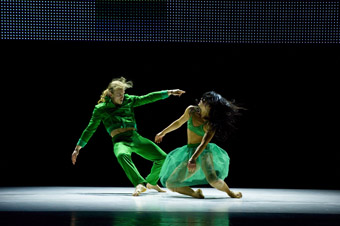
Troy Honeysett, Emee Dillon, G, Australian Dance Theatre
photo Chris Herzfeld
Troy Honeysett, Emee Dillon, G, Australian Dance Theatre
WHAT IS IT ABOUT A CLASSIC REVIVED THAT COMPELS OUR ATTENTION? IS IT THE SHEER MIRACLE OF RESUSCITATION? THE GHOULISH LURE OF A ZOMBIE, RAISED FROM THE DEAD? OR JUST SOMETHING COMFORTABLY FAMILIAR MADE NEW, LIKE AN OLD PAIR OF JEANS, CUT-OFF, PATCHED-UP, DYED GREEN PERHAPS?
We put an emphasis on experiment and innovation in valuing the creation of new work. But isn’t performance always offered in repertoire—a repetition of the past, a rehearsal, a re-presentation, served each time afresh? Australian Dance Theatre’s G is just such a work, the dancers like some ancient layered archive, accumulating and re-performing the choreography of our culture’s obsession with romance.
G is short for Giselle, the famous classical ballet, first performed in Paris by the Ballet du Theatre de l’Academie Royale de Musique in 1841. Its revival by Marius Petipa for the Imperial Russian Ballet in the 1880s and 1900s defined the choreography performed by ballet companies to this day. Since the 1940s, Australian audiences have seen Giselle in productions from the Australian, Royal, Bolshoi and Borovansky companies. The Australian Ballet last performed the work in 2006 and 2008.
G was seen as a work-in-progress at the company’s Adelaide studio in March 2008, and premiered in Utrecht later that year. From the Netherlands, it toured through Belgium, Luxembourg, Spain, France, Italy and England before returning recently to Adelaide in 2009 for a season at the Dunstan Playhouse as part of the Adelaide Festival Centre’s Pivot(al) dance program. As a classic case of postcolonial playback, the work has struck a chord with European audiences, and will return to France in November. It also has an affinity for Australian audiences: the Adelaide season was a sell-out and spectators were enthusiastic in applause. It deserves seasons elsewhere in Australia.
In its choreographic intent, G is akin to Birdbrain, the ‘deconstructed’ Swan Lake from 2000 which was Garry Stewart’s first full-length work for ADT. But the modus operandi of this work is not so much deconstruction as truncation and compression. The names of characters are reduced to letters: G, of course, who falls in love with L, who is really a prince named A betrothed to Princess B.
The narrative is similarly cut-up into isolated gestures and stilted fragments, which nevertheless flow past in a stream of body-images and image-objects. Arms crossed in love, hands clasping hearts, swords at hearts, heads thrust back, heads hung low, bodies thrown down and danced upon, a procession of pine trees—the whole story of Giselle, her lovers and their demise is danced in 60 minutes— from left to right.
That is, the dancers process continuously across the stage from left to right in various ways. They make the round trip backstage, of course, and thereby create the panoramic illusion of perpetual flow. There is a great deal of pleasure to be derived from this simple operating premise—from the changing rhythms, speeds, the body densities of the flow, and from entrances that follow exits almost impossibly too soon.
The meanings implied in this ruthless circularity accumulate throughout the work, resonating with that great romantic mystery at the centre of Giselle: the eerie possibility that one could dance oneself—or, more mysterious still, be danced against one’s will—to death. Along the way, the dancers’ moves lay down a lovesick palimpsest of sex, desire and death. This is the choreography of romance in mutation—dug from within and exposed to view like some kind of bio-archaeological excavation.
Colour is a key. The dancers are lit, in part, by Geoff Cobham with a massive electronic screen. Their dancing arcs from the classic choreography of ballets blancs to encompass the excess of gothic horror in black and red, and the surreal formalism of music video in green and blue. Captions are another key which flicker across the screen: narrative fragments with words cut out and streams of words beginning with the letter G—among them, ‘gothic’, ‘grief’ and ‘gonorrhoea.’ The music from Luke Smiles is orchestral and ethereal at times, but mostly it is slavishly metronomic in effect, securing the commitment of the dancers to delivering the work’s unrelenting flow.
Shudder, freeze and flicker are the strongest movement-images that I logged alongside the luminosity of the work’s signature colour, green. Green for jealousy, of course, and also green for feeling queasy. G is a classy diagnostic for assaying the lovesick among us.
–
Adelaide Festival Centre Pivot(al): Australian Dance Theatre, G, conception, direction, choreography and set design Garry Stewart, performers Chris Aubrey, Emee Dillon, Amber Haines, Troy Honeysett, Daniel Jaber, Lauren Langlois, Lina Limosani, Larissa McGowan, Kialea-Nadine Williams, Kimball Wong, lighting design Geoff Cobham, composer Luke Smiles/motion laboratories, costumes Daniel Jaber, Gaelle Mellis, Dunstan Playhouse, Adelaide Festival Centre, Aug 25-29
RealTime issue #93 Oct-Nov 2009 pg. 37
© Jonathan Bollen; for permission to reproduce apply to realtime@realtimearts.net
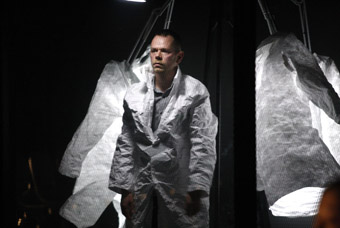
Anthony Hamilton in Corridor (2008), Lucy Guerin Inc
photo Jeff Busby
Anthony Hamilton in Corridor (2008), Lucy Guerin Inc
ANTONY HAMILTON IS A RELUCTANT MAN OF THE MOMENT. “A FEW THINGS HAVE HAPPENED AT ONCE”, HE ADMITS, “BUT NOTHING HAS CHANGED FOR ME PSYCHOLOGICALLY. THERE IS AN EBB AND FLOW, BUT I HAVE BEEN WORKING AS HARD AS EVER FOR 10 YEARS.” WE ARE TALKING ABOUT HAMILTON’S RECENT RUN OF ACHIEVEMENTS AS PERFORMER AND CHOREOGRAPHER ON THE EVE OF HIS DEPARTURE FOR BERLIN AS THE FIRST RECIPIENT OF THE TANJA LIEDTKE FOUNDATION FELLOWSHIP.
Hamilton is right to indicate that he is no blow-in. He has long been one of the most distinctive dancers in Australia, contributing to the work of Lucy Guerin Inc and Chunky Move in particular. He has also been quietly making work of his own for initiatives such as ADT’s Ignition program and Lucy Guerin’s Pieces for Small Spaces, as well as adding to the repertoire of Stompin’, Dance North and Rogue. Hamilton has also made work with students at the VCA and created choreography for bands such as The Presets.
In 2009 Hamilton’s profile as a choreographer has been enhanced through the two Greenroom Awards for his 2008 self-produced Blazeblue Oneline and the glowing audience and critical response to his Chunky Move commission, I Like This, co-directed with Byron Perry. His receipt of the inaugural Liedtke Fellowship follows his 2004 receipt of the inaugural Russell Page Fellowship, indicating that his is the work which prevails when new choreographic talent is the priority.
Hamilton is leaving for Berlin and concedes to feeling rather nervous about this solo expedition, after so many years of international touring in companies. “There is a lot of pressure. A lot of people will be watching.” He will work with members of Sasha Waltz’s company at Radialsystem V, bringing Australian expatriate dancer Melanie Lane into the collaboration. He is also hoping to work with Berlin-based British graffiti artist Mode2. “It is great to be allowed to experiment within a dance fellowship”, he says. “There are no parameters about the form.” Hamilton will spend seven weeks in the studio, presenting his research at the Asia Pacific festival curated by Radialsystem in October. He has no plans to create a production from this residency. His main aim is “to embed myself in Berlin and really live it.”
This collaboration with a street artist and a dancer is indicative of where Hamilton’s interests lie. “I am keen to bring fashion and visual arts to the table”, he says. “But I am passionate about dance in the traditional sense. I am not that into hybridising work. I’m quite a purist when it comes to choreography. If you just touch the edges and then add other things, you are only going to diminish all the forms.”
This might read as something of a surprise to fans of the searingly cool Blazeblue Oneline which won its awards for concept realisation, set and costume design. Yet Hamilton is clear that his time in the trenches as a performer is what has enabled him to articulate his vision so clearly and that his incorporation of other media is only possible because of his life-long commitment to choreography. “Choreography has always been my calling. In order to be a great dancer, you have to imbue everything you do with a sense of choreography.” He is particularly proud of his 2009 Helpmann Award for Best Male Dancer for Chunky Move’s Two Faced Bastard. “That meant a lot. Two Faced was a performer-driven show. I did a huge improvised solo at the end and was given space to deliver myself on stage.”
“I am deliberately taking a break from working with choreographers now”, Hamilton says. ”I haven’t made any new work with Lucy [Guerin] or Gideon [Obarzanek] all year. The last thing I did was [Guerin’s] Untrained. While I always welcome touring, I need to take this break as much for myself as for the choreographers. It is important to create space for other artists.”
Hamilton has a “strong desire to create opportunities for people who haven’t had many chances.” He has just made a piece with third year VCA students and encouraged them to create their own openings in the way that the Rogue collective has done. ”Young artists have to improvise and shape-shift to move within an increasingly fluid cultural and financial landscape”, he says, talking as much about the trajectory of his own choreographic career. Hamilton took four years to produce Blazeblue Oneline. “I think artists are hard-wired to think in the moment. It is hard to project forwards. I have just finished the development of a new piece but have no real sense of where that is going.”
Hamilton is fortunate enough to have a couple of producers on board to do some of that projection with him. He is part of the MAPS initiative, managed by Strut & Fret in Victoria. They are hoping to take Blazeblue Oneline to APAM (Australian Performing Arts Market) in 2010 and Chunky Move will continue to seek touring opportunities for I Like This. Hamilton will travel to France for three weeks in December to make a piece for the Lyon Opera Ballet. This opportunity arose, as seems to be the pattern for Hamilton, through the impact of the work alone. He was encouraged to apply to the Rolex Mentor and Protégé Arts Initiative in 2008. Whilst he was not a winner, Yorgos Loukos, Director of the Ballet, was on the Rolex panel and was impressed by the DVD of Blazeblue Oneline. He sought Hamilton out to contribute to a triple bill of new work which will be presented in France in June 2010.
Despite the opportunities offered by the European projects, Hamilton has no plans for global domination. He is reticent when it comes to networking and approaches his residencies with a calm focus upon the work in hand. “I try not to follow trends”, he says, “I almost prefer not to know what is going on. I am happy to be doing my thing. It’s about remaining inspired with what you do regardless of any accolades.”
Tanja Liedtke Foundation, www.tanja-liedtke-foundation.org
RealTime issue #93 Oct-Nov 2009 pg. 38
© Sophie Travers; for permission to reproduce apply to realtime@realtimearts.net
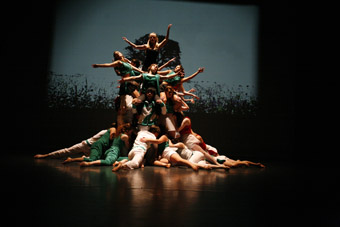
Quantum Leap
photo Lorna Sim
Quantum Leap
TELEVISION PROGRAMMING IS NOW REPLETE WITH COMPETITIONS FOR FATTIES, THINNNIES, WANNABIES, HAS-BEENS, FAMOUS AND INFAMOUS. MICHAEL’S GONE, BUT HIS VIDEOS AND HIS SHUFFLE WILL NEVER DISAPPEAR. BUT HOW DO BODIES DO THAT? AND WHOSE BODY IS DOING THAT? AND IS IT ALRIGHT FOR THAT BODY TO BE DOING THAT?
Dance and dance training brings along with it so many issues to do with ethics. For what are we responsible when we choreograph, or teach bodies to dance? Are we answerable to particular aesthetics or, ethically, to innate human potentials?
From the mid-20th century there have been many challenges to the primacy of ballet technique as the basis for training in Western dance. Especially since the advent of so-called postmodern dance (associated with the Judson Church in New York), processes derived from ordinary physiology, everyday movement (incorporating the notion of ‘least effort’) and sensory relationship have informed choreographic development. Along with the freedom that such new aesthetics have created, however, arises another problem. How do we know what we are looking at? What are its values, its strengths, its achievements? Is it any ‘good’ or not?
Such issues are heightened where dance is created with and for people with differently-abled bodies. London’s Candoco Dance [established in 1991], a company choreographing for mixed groups of professionals, with or without legs, produces stunning work. Similarly, Entelechy, a company based in south-east London, includes people of multiple and severe disabilities and also works with people with dementia or Alzheimer’s disease. Their process creates a nexus between movement, music, and sensory-based experience: “She likes soft cakes, not biscuits, rice on hands, African spices, the sound of water pouring.” Their outcomes make apparent the moving beauty of thoughts and ideas at work beneath the skin. It makes you think how often our ideas of ‘dance’ come pre-fixed, limiting what we see, how we see it, and what we choose to show.
The genre of youth dance, too, can be straitjacketed by the limited perceptions of its own audience, as evidenced in criticism of Quantum Leap ensemble’s recent Canberra Playhouse season. Select Option—a vibrant, inventive, often stunning show—was berated for failing to display any “real” choreographic pizzazz, collaboration or participant autonomy: “It was evident that the young performers did their very best to keep the grown-ups happy…doing what they were told to do and saying what is expected of them to say” (artsHub, July 31).
The criticism is curious, as all Quantum Leap projects—and especially this one—incorporate a considerable degree of technical training, as well as collaboration in terms of research, subject matter and choreography. Participants have extensive input with guest choreographers in devising structure and narrative both as text and via movement. The results, of necessity, transform subject materials into somewhat more abstract configurations. The achievements are thus sometimes difficult to quantify, but at the very least there is always evidence of a complex relationship between the kinds of freedom and looseness one would expect from ‘youth’, and the sharpness and exactitude which comes from applying technique and bringing ideas into form.
John Berger points out that this tension between structure/training and freedom/intuition is endemic to every form of art and making. Note that he makes a case that this kind of awareness is necessary for the audience:
“Capitalism has brought with it a higher and wider degree of self-consciousness than ever existed before. Self-consciousness [ie structure, training. Ed] is an advance beyond a life of intuition. But the final creative aim of self-consciousness must be to consciously lose itself, to return to a reliance upon
intuition within certain consciously created limits. To live as the athlete runs or jumps or swims. Art also needs the same kind of controlled liberation of intuition—in both artist and spectator…” John Berger, A Painter of Our Time, 1958
I sometimes wonder at the level of narcissism in an audience. Does the performer ‘move me’, or ‘move for me’? And is that all we’re there for?
Select Option was composed of a sequence of episodes brought together by two distinct musical compositions in each of its performance halves. There are deliberate variations in style, from break dance to street funk, classical to contemporary, linked with music, projected film and text.
Skill levels varied, across different areas. A young dancer, hardly moving in a pool of light, explored her sensual stage magnetism; a line of boys expelled their braggadocio drives in a thrilling street dance. The simple device of one dancer after another climbing up a pyramid of bodies was a good metaphor for the aspiring, searching, and mentoring of this age group—an abstract visual counterpoint to the video vérité interviews around a teenager’s ‘choices’ projected upstage later in the show. Each exploration seemed appropriate to the age and respective maturity of the participants, their life experiences, the strength of their bodies in friction with their emotional uncertainties. Clearly, these young dancers are being ‘extended’ in different dimensions.
In the first half, London-based choreographer Liz Lea explored meanings of the colour red, from its associations with sexual liberty (the ‘scarlet woman’ in an evening dress) and flamboyance (clown/cabaret/burlesque) and themes to do with individuation versus conformity in a very moving ensemble segment—12 women in 12 squares of red light, arching and backbending, in line but each lit by their own grace. Nicholas Ng’s gorgeous musical ‘take’ on ‘finding yourself’ as reflected in the Indian tonalities of his composition found nice parallel with Lea’s aesthetic, influenced by her extensive training in Asian martial arts.
In the second half, Marko Panzic and Reed Luplau combined high athleticism and street funk in their respective choreographies, exploring attractions and rejections and the sheer thrill of high kicks, backflips and group dynamics, especially strong in the sequences for the boys. Fourteen-year-old Jack almost outdid them all, but so clearly expressing—and allowed to express—the condition of his young body with such poignancy. His shoulder shimmy was inescapably that of a young boy. Allowing that simple, physical fact to stand told me a million stories about who he is, how time is still ahead of him. No cover-up here: this is a rare, humbling and quite exquisite viewing experience.
It probably takes a lifetime to understand our own sense of agency and relative freedoms. I think we can make a better attempt to appreciate what is there, not just what we expect to see, and try and examine more deeply the cultural imprimaturs we unconsciously bring with us every time we enter the theatre.
QL2 Centre for Youth Dance, Select Option, 44 dancers aged 14-23, choreographers Ruth Osborne, Brian Lucas, Liz Lea, Marko Panzic, Reed Luplau, composers Nick Ng, Adam Ventoura, video Bearcage Productions; Canberra Playhouse, July 29-Aug 1
RealTime issue #93 Oct-Nov 2009 pg. 38
© Zsuzsanna Soboslay; for permission to reproduce apply to realtime@realtimearts.net
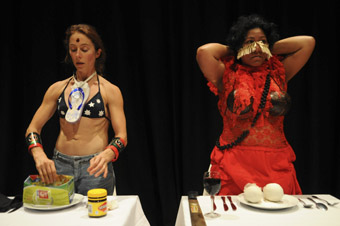
Kathy Cogill, Latai Taumopeau, Intercultural Project, March 2009
photo Heidrun Löhr
Kathy Cogill, Latai Taumopeau, Intercultural Project, March 2009
IN LATE 2008, THE FONDUE SET’S EMMA SAUNDERS WAS APPOINTED BY LISA HAVILAH, DIRECTOR OF CAMPBELLTOWN ARTS CENTRE (CAC), TO DEVELOP A THREE-YEAR CONTEMPORARY DANCE PROGRAM. THE COMPREHENSIVE AND AMBITIOUS PROGRAMMING THAT HAS RESULTED IS THRILLING IN THE CURRENT CLIMATE, PROVIDING AN ALTERNATIVE AVENUE FOR MANY SYDNEY-BASED CHOREOGRAPHERS SEEKING A PLACE TO WORK AND PRESENT. GENEROUS SUPPORT FROM CAMPBELLTOWN CITY COUNCIL, THE AUSTRALIA COUNCIL FOR THE ARTS AND ARTS NSW HAS BEEN WELL SPENT WITH STRANDS DEDICATED TO INTERDISCIPLINARY, INTERCULTURAL, STUDENT, ABORIGINAL AND COMMUNITY RELATED PROJECTS, PLUS RESIDENCIES, COMMISSIONS AND PRESENTATIONS.
The range of artists passing through the centre so far this year has included Brian Fuata, Kathy Cogill, Latai Taumopeau, Julie-Anne Long, Rosie Dennis, Kimberly McIntyre, Lizzie Thompson, Jane McKernan, Martin del Amo, Vicki Van Hout and Kay Armstrong’s youth dance company, youMove.
Havilah’s decision to resource producer positions and employ artists in such roles, has fuelled an expansion of the Centre’s offerings well beyond its established visual arts programming. Havilah believes that artists are best equipped to put in place long-term strategies for the support of other artists and development of new work, providing institutions with an understanding of the process from the inside out. The focus is on supporting new work and “multi-arts practice”, with a strong emphasis on artist-led engagement with communities in South-Western Sydney—specifically Pacific and Aboriginal communities. The richness of traditional art forms in these communities has been largely excluded from contemporary art practice in NSW and Havilah’s aim is to create a long-term strategy to support the process-driven, intensive commitment that cross-cultural initiatives demand.
Campbelltown Arts Centre’s facilities include studios, workshops, a 200-seat studio theatre and artist accommodation, along with placements in community venues. With the ability to take a work from development to small scale presentation, CAC differentiates itself from the Critical Path choreographic laboratory in Rushcutter’s Bay. CAC also offers a curated program (involving guest curators) built around artists who “fit Campbelltown’s broader programming requirements,” as well as the various strands of the dance program. The aim is to fill the gaps in the sector which Emma Saunders has identified as being in the second and third stages of the development of new work.
Surprisingly, finding established artists with community engagement as part of their practice has not been difficult, and Saunders believes that the Centre’s curatorial agenda could influence patterns in creative practice in NSW dance. Various experiences, including remounting The Fondue Set’s Hoofer performance with 90 high school students, have made Saunders an enthusiastic supporter of community-engaged practice. “Artists respond to what’s funded so, if artists begin to think about their work in relation to communities, there could be a lot of new work in that area…It’s very exciting and at the moment it’s not something that has been highly respected, it’s not a thread in everyone’s practice.” Saunders compares the possibilities to a recent durational performance work in which artists Tony Schwensen and Andre Stitt (UK), commissioned by CAC, painted a house in Minto pink. “It blew my mind and when I think about how that can relate to dance, it’s very open-ended.”
There is a perception that inner-city audiences are trooping out to Campbelltown en masse to see artists who are Sydney-based, begging a question regarding the local response to the productions that will result from the initiative. However, Havilah says that the lack of established dance artists in the local area is being addressed by “developing pathways for young local dancers to move into professional dance studies…A lot of young people are going to commercial dance schools and leaving at the end of high school, so we are introducing workshops and public programs to expose young people to different ways of thinking about dance.” Together with a new dance scholarship, youMove, designed to help young dancers make the transition into contemporary dance practice, and a strategic partnership with NAISDA who run an annual workshop where young Aboriginal students can connect with a potential tertiary dance option, the Centre is working to develop a new generation of dance artists and audience members in Sydney’s South-West.
Emma Saunders is very positive about providing local audiences with accessible work: “For example, Martin del Amo’s universal themes engage with an audience…and I don’t rule out that things can be a bit humorous.” It’s estimated that del Amo’s audience for It’s a Jungle Out There (RT92, p36) in August was about half Sydney-based, half local across the three-night season, and while attendances have been very good, Saunders and Havilah point out that, thanks to the Centre’s happy position as a government-subsidised institution, theirs is primarily a developmental program.
Saunders’ last project in this role before going on leave (Julie-Anne Long will be acting curator), is a program co-curated with Havilah exploring where “visual arts and dance intersect.” What I Think About When I Think About Dancing involves residencies, performances, commissioned installations and forums around the notion that visual artists are increasingly becoming performers in their own works, and dancers doing more work in gallery contexts. An interest in untrained bodies, ‘non-skills’ and slippery performance modes has fuelled Emma Saunders’ practice for many years. Perhaps celebrating an aspect of the NSW scene, she brings this preoccupation to an ambitious program.
What I Think About When I Think About Dancing, artists Brown Council, Rosemary Butcher (UK), Mitch Cairns, Rosie Dennis, Brian Fuata , Shaun Gladwell, Agatha Gothe-Snape, Shigeyuki Kihara (NZ), Laresa Kosloff, Cathy Lane (UK), Gabriella & Silvana Mangano, Kate Murphy, David Noonan, Christian Thompson; Campbelltown Arts Centre, Nov 16-Jan 17; performances Nov 27, 5pm; forum Nov 28, 2pm
RealTime issue #93 Oct-Nov 2009 pg. 39
© Erin Brannigan; for permission to reproduce apply to realtime@realtimearts.net
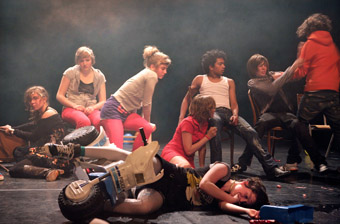
Once and for all we’re gonna tell you who we are so shut up and listen
photo Phile Deprez
Once and for all we’re gonna tell you who we are so shut up and listen
A SIGNATURE’S A FUNNY THING: A SIGN THAT CREATES ITS OWN CREATOR. A UNIQUE MARK THAT PRODUCES THE UNIQUE IDENTITY OF ITS MAKER. I HAVE AN AWFUL SIGNATURE WHICH HAS OCCASIONED LAUGHTER OR SUSPICION FROM COUNTLESS SHOP ASSISTANTS AND OFFICIALS. IT’S AS IF MY OWN SELFHOOD IS DESTABILISED BY THE ERRATIC NATURE OF MY JOHN HANCOCK. BUT WHAT ABOUT THE SIGNATURES OF ARTISTS OVER TIME? A DISTINCTIVE STYLE IS A SALEABLE COMMODITY IN THE VISUAL ARTS, ITS COUNTERFEITING SOMETIMES AMOUNTING TO A CRIMINAL ACT. IN THE PERFORMING ARTS IT’S EVEN MORE COMPLEX.
These thoughts were buzzing around my mind while watching Strangeland, the recent collaboration between Melbourne’s Not Yet It’s Difficult and Korea’s Wuturi. It began as murky light began to filter through the thickest haze effect I’ve ever seen on a stage. Indistinct figures seemed to coalesce and disperse somewhere in the autumnally tinted fog. Their skin was dirty, dusty, perhaps ash-covered. The apparitions seemed revenants haunting us from some unimaginable other-space.
Then I saw the walls. Padded panels a little larger than a door. And I thought, “I wonder when the performers will begin throwing themselves against ‘em?” See, these same panels featured in at least two previous NYID works, and the act of slamming into them has become a kind of signature move for the company. But what does that mean?
On one hand, it could be read as an impoverished recycling of earlier ideas. On the other, it could be a gesture of continuity, tracing a thread that acknowledges the genealogy of artistic production. If you’ve a third hand free, you could also see it as a specifically visceral act of communication, whose violence is more immediate than any of these more linguistic notions can encapsulate.
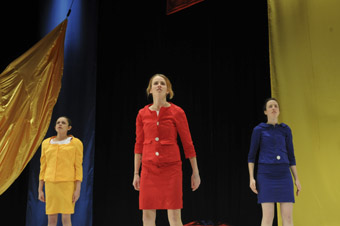
Post, Shamelessly Glitzy Work
photo Heidrun Löhr
Post, Shamelessly Glitzy Work
A contrasting example. The much lauded trio Post’s Shamelessly Glitzy Work bears distinct connections to their previous body of work. An ironic spectacular featuring ditzy dialogue, alcopop-guzzling, bad dancing, bold colours and an existential emptiness, it’s live art that doesn’t specifically quote but certainly echoes the company’s existing oeuvre. Moreover, these signatures don’t just produce the creative identity that is “Post” but also align the company with others working in a similar vein, such as The Fondue Set and My Darling Patricia. These repetitions create that larger identity often called, for want of a better term, a scene.
Forced Entertainment’s Spectacular played in the same space as Shamelessly Glitzy Work, and its empty hour of anti-theatre, in which a performer apologises at length for the lack of a show, was certainly reminiscent of the company’s extensive body of work. Marie-Anne Mancio, in RealTime 89 [page 34] wrote that “the absent show in Spectacular is also the ghost of shows past…Despite the humour, it’s relentless. Not even painful. Just boring.”
It was pretty boring. The ideas Spectacular raises have been explored to more thought-provoking effect by this same company before. It’s not just the repetition that’s the problem, though. Forced Entertainment have their signature, and it’s one that has deservedly influenced many who have come afterwards. It’s that, in this case, the signature is all that there is. It’s like an autograph on a blank page, whose only value is in the confirmation of an identity, not its creation.
Another perspective. Umberto Eco has written of the process of ostention, of communication in which a mimed action takes the place of words—placing a finger to your lips (shhh), waving a packet of cigarettes (want one?). Ostention isn’t just a fancy form of theatre’s ‘show, don’t tell’ dictum (itself rather dodgy). In ostentive gestures, an action becomes a sign of a sign. Post dramatic theatre often requires an implicit recognition of this slippery form of signification—Spectacular, for instance, is at a surface level all tell and no show, but this itself is what constitutes the work’s expressed meaning.
But as I’ve said, I found it pretty boring. The absent show has itself become a presence in contemporary theatre, and has been invoked to greater effect by others (and by Forced Entertainment, for that matter). Shamelessly Glitzy Work, meanwhile, pokes at the dead remains of dramatic performance with a very big stick that is itself hugely entertaining. Spectacular features interminable death scenes and drawn-out monologues on nothingness; Post play with similar durational concepts through a long, numbing techno dance sequence, and toy with the vacuity of theatre by producing hilarious magic or special effects that express, well, nothing much.
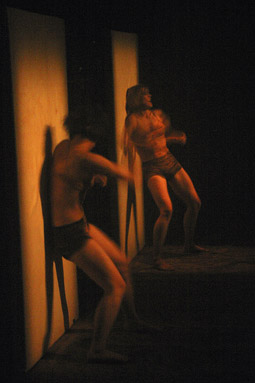
Strangeland, NYID
photo Guiman Shin
Strangeland, NYID
Back to Strangeland. All show and no tell. Movements as signs which seem only to refer to other movements as signs, an infinite regress. Its roots are in dance, yes, and so elements of that vocabulary can be expected to feature, just as Spectacular’s mostly verbal nature appeals to a shared oral vocabulary. But Strangeland, sadly, replaces ‘heard it all before’ with ‘seen it all before.’ Beyond the familiar wall impacts, the choreography of the piece often focused on the kind of shuffling, jerky, unconscious motion that has featured prominently in Melbourne dance for more than a decade, and which has taken on a certain historic air. The interaction between dancers appeared to be based on tiny, improvised movements which occurred whenever another performer was heard to move somewhere nearby. This conjured an interesting sensation of watching the impenetrable communication between ants or other complex social organisms, but is again overly familiar in an age where Merce Cunningham or Deborah Hay have made such processes a common mode of practice.
Post take the familiar and invest it with a surprising currency. In common with Forced Entertainment and NYID, the company holds up to scrutiny the things in which we can no longer place a naïve faith, the world and its forms of representation which have failed us. But rather than the post-apocalyptic void of Strangeland or the ‘sorry about that’ shrug of Spectacular, Shamelessly Glitzy Work makes the shared experience of art a thing of joy in itself. It recovers dead or discredited modes of entertainment with a kind of winking knowingness that is terribly generous to its audience. It knows that we know it all, so it doesn’t need to tell us anything. We get the signs and we get their eternally self-referential status and by gosh, let’s blow up a massive patchwork balloon while we’re thinking about that.
All three works were presented by Arts House over several weeks in a program with new work by locals Panther and The Suitcase Royale. The sixth in the series deserves special mention: Belgian company Ontroerend Goed’s quite incredible Once and for all we’re gonna tell you who we are so shut up and listen. Thirteen teens played out a short chaotic scene structured around simultaneous activities of teendom—teasing scuffles, moody exchanges, boredom, solitude, experimentation. This scene was then repeated with fascinating variations: in an affectionate, euphoric manner; drugged up and stumbling; even, at one point, entirely absent from the stage as their props continue to repeat the scene despite their disappearance.
This work could easily have been a condescending glance backward, either treating teenagers as exotic specimens from another world or using them to remind us of a nostalgic youth we all apparently shared. Instead, it allows its performers to exist on their own terms, as individuals, as a group, as able performers and as fallible humans. They do not become signs of a generation, nor of an abstract principle. The work is carefully constructed, allowing for gloriously open play within its confines, and the energy transfer between audience and stage is of an infectious vivacity that few productions even think to aspire to, let alone achieve.
Not Yet It’s Difficult/Wuturi, Strangeland, director David Pledger, performers Todd MacDonald, Ingrid Weisfelt, Vincent Crowley, Sara Black, Seo Sang Won, Song In Sung, Sang-A Kong, lighting Paul Jackson, Niklas Panjanti, Arts House, Meat Market. Aug 5-8; Post, Shamelessly Glitzy Work, created and performed by Mish Grigor, Natalie Rose, Zoe Coombs Marr, North Melbourne Town Hall, Aug 13-15; Forced Entertainment, Spectacular, director Tim Etchells, performers Claire Marshall, Robin Arthur, North Melbourne Town Hall Aug 6-8; Ontroerend Goed, Once and for all we’re gonna tell you who we are so shut up and listen, writers Joeri Smet, Alexander Devriendt, director Alexander Devriendt, Meat Market, Melbourne, Aug 6 – 11
RealTime issue #93 Oct-Nov 2009 pg. 40
© John Bailey; for permission to reproduce apply to realtime@realtimearts.net
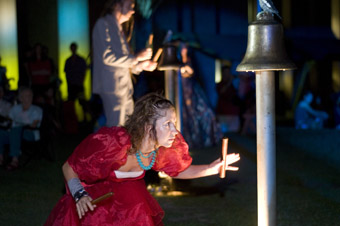
Lulu Madill, Origins
photo Kara Burns
Lulu Madill, Origins
IT IS PERHAPS FITTING THAT DARWIN, THE CAPITAL OF THE NORTHERN TERRITORY IS NAMED AFTER THE SCIENTIST WHO DEVELOPED THE THEORY OF HUMAN EVOLUTION. THE NOTION OF ‘SURVIVAL OF THE FITTEST’ AND THE RUGGED OUTBACK ‘TERRITORY TOUGH’ MYTHOLOGY SIT TOGETHER AS NEATLY AS A GALAPAGOS SEABIRD AND A CRAGGY ROCK.
But what Charles Darwin, naturalist, explorer and author of On the Origin of Species would make of two ‘tween’ boys dressed as spermatozoa whizzing through a park on unicycles to mark his 200th birthday remains as much a matter for conjecture as the thoughts of early Top End settlers whose distinctive elevated houses have been flattened to make way for multi-storey apartment blocks in a building boom that has done more to shape Darwin’s urban environment than any event since Cyclone Tracey.
But let’s set “industrial melanism” (Darwin’s concept relating to phenomena arising from man-made environmental change) aside for now. Despite the encroaching high rise and cranking air-con units, Darwin City’s Civic Park on a balmy Dry Season night remains an ideal location for an event like Origins, a cross-disciplinary collaboration to mark the 200th birthday of Darwin and the publication of his revolutionary thesis. He never visited the Northern Territory. Darwin city was named after him by friends on HMAS Beagle which visited Darwin Harbour in 1839.
Origins was a one-off event that brought together some of Darwin’s key creative organisations: Corrugated Iron Youth Arts, Darwin Symphony Orchestra, Darwin Chorale, Darwin Theatre Company, 24HR Art and Charles Darwin University. It embraced multimedia, symphonic music, performance and installation art, involved myriad young performers, artists and seasoned orchestral musicians and was woven around some of Darwin’s most revolutionary theories. Allopatric speciation anyone? How about adaptive radiation or biogenesis?
So that explains the cycling sperm…and those uplit dresses hanging in the trees. Beguiling monuments to progression or regression, civilisation or barbarity? Beauty is in the eye of the beholder.
Origins also marked two firsts: the premiere of a new orchestral work, Transmutations, by English composer Michael Stimpson, and the unveiling of a public sculpture, Ships Bells, by Victorian artist Anton Hasell. Transmutations was commissioned by the Darwin Symphony Orchestra (DSO) as the fourth part of The Age of Wonders, a series inspired by the life of Charles Darwin. It is a sublime work, imbued with a sense of restless movement and desire for knowledge and adventure. There are clopping horses and bird calls, billowed sails and ships at sea, and the DSO’s interpretation was balanced and polished. For an officially ‘pro-am’ orchestra, the DSO punches well above its weight. Outgoing artistic director Martin Jarvis—who has steered the orchestra for over 20 years— leaves an extraordinary legacy and big shoes to fill.
The rest of the evening was a hotchpotch and, running concurrently with the orchestral performance, proved somewhat of a distraction. There were youth performers and acrobats, multimedia projections, magicians, actors reading from Darwin’s diaries and parading as human species, in all their suburban slobbery, locked up in zoo-like cages.
Each element of Origins, in its own right, was good enough, but overall, the event didn’t really hang together. There was no sense of cohesion, nor of carnival. The feel was more of a community fete than interactive performance event, and it wasn’t helped by huge ‘holes’ in the sound and lighting design. Origins was a great concept, but the execution did not do it justice.
This was Darwin city’s offering to its namesake, a man who was revolutionary, brilliant and brave. As much as Origins showcased all that is good about Darwin and its arts community it also highlighted all that is lacking, in particular the dearth of professional performers and directors in what was once a vibrant theatrical scene. Perhaps the reinvention of Brown’s Mart, under the auspices of Performing Lines, as Darwin’s central theatrical ‘hub’, and the increasingly pro-active role of Darwin Festival’s producers in nurturing local work will redress this situation. Let’s hope so—those Dry Season evenings are too good to waste.
Origins, creative director Alex Ben Mayor, new media artist Tim Parish, visual art facilitator Tim Newth; Civic Park, Darwin, July 1
RealTime issue #93 Oct-Nov 2009 pg. 41
© Jane Hampson; for permission to reproduce apply to realtime@realtimearts.net
{$slideshow} AFTER SUCCESFUL PERFORMANCES OF FOOD COURT FOR THE SYDNEY OPERA HOUSE LUMINOUS SEASON AND RECEIVING A KIT DENTON FELLOWSHIP—FOR COURAGEOUS WRITING—FOR A WORK IN DEVELOPMENT, GANESH VS THE THIRD REICH, GEELONG-BASED BACK TO BACK THEATRE HAVE FURTHERED THEIR VENTURES IN INNOVATIVE PERFORMANCE WITH TOUR GUIDE. THE NEW OUTDOOR WORK HAS BEEN CREATED IN COLLABORATION WITH AUSTRIAN GROUPS MALARIA, SOUNDSO THEATER AND SCHRÄGE VÄGEL AND PERFORMED AS PART OF LINZ’S THEATERLUST.
The performance took place in a public park, with neither sets, nor lighting nor costumes. Tour Guide explores body language as much as the content of its German and English scripts. The audience was reminded that in such public places, while unable to hear the words of others, we may be able to observe the emotions in private conversations, sense the aggression of one person standing over another, decipher the pursed lips of disappointment, or empathise with the embarrassed fidgeting of rejection.
The audience here was wired more deeply into such intense personal drama via headphones, a technique used by Back to Back in their internationally popular Small Metal Objects. The audio guide took us on a voyeuristic journey into a series of intimate moments, many of which were painfully or comically awkward. The script is based on four short stories, expanding in scope from the personal to the societal; firstly an intimate dialogue about sex, then friends giving advice on infidelity in marriage, next a community intervention into a drug deal, and finally a layered narrative on representations of disability in the media.
A little girl searching the park for her lost guinea pig interweaves the four stories. Her role is also to usher the audience to the action as the direction from which the dialogues come is not always obvious. Used more explicitly, this technique would be sufficient but, for many of us, it takes a little while to sink in, by which time, some of the performance has already passed. But by the second act, we are in the swing of it. From inside a car, a man explains to his friend that his wife wants a divorce. His friend advises that, like a plant, a marriage has to be tended. He takes this to his wife, but in his nervousness, misquotes, “I want to love you, like a plant.”
The next scene introduces a more criminal scandal. The little girl approaches a man in a wheelchair and asks, “Have you seen my guinea pig?” The man turns out to be dealing drugs and tricks the little girl into becoming his mule. Discovering the incident, the girl’s sister rallies the park community to set things straight. This is a magical scene. As we see them unite to gang up on the bully, we realise that we have mistaken most of the actors, scattered on park benches for bystanders. Whether we have seen them as people with disabilities or simply as separate individuals going about their daily lives, they now demand to be recognised as performers. Even a dog, also part of the large cast, joins in barking excitedly, and the drug dealer wheels off.
In the last act, we watch several takes of filming a scene in a movie in which a young man with Down’s syndrome has arranged a blind date with a woman by sending a photo of someone else: “a 35 year old man with blond wavy hair who likes going to the theatre, fine dining and walking in the Alps.” When she becomes angry, he then claims to be Michael Jackson. “Michael Jackson is dead”, she cries. He is persistent. “Okay, yes, I’ll be honest. I am James Bond. You have beautiful hands and a beautiful body. You are my Bond girl. Please be my girlfriend.” And somehow, we have been guided back to the beginning of the tour, a desperate man pleading to be loved.
Like Back to Back’s home town of Geelong, the city of Linz is no stranger to the challenge of generating significant work outside the usual cultural epicentres—neither city has more than 200,000 inhabitants. Tour Guide has moments of awkward intercultural collaboration; the Australian and Austrian performers don’t always seem to be on the same page and some English dialogue is simultaneously translated as it is performed. But it shows that local stories can resonate on an international level.
The lost guinea pig is never found, but in meeting so many people, I have almost forgotten that anyway. I am just happy to be part of the guinea pig audience for this project, which will be continued in 2010 and undoubtedly join the list of Back to Back’s success stories.
Back to Back Theatre with Malaria, SOundSO Theater & Schräge Vägel, Tour Guide, Theatrelust, Linz, Austria, Aug 10-11
RealTime issue #93 Oct-Nov 2009 pg. 42
© Alexandra Crosby; for permission to reproduce apply to realtime@realtimearts.net
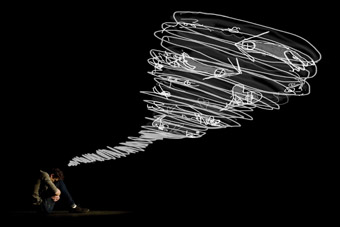
Matthew Whitty in The Fire and Hurricane Survival Guide
image by Thomas Breakwell and Robert Jordan
Matthew Whitty in The Fire and Hurricane Survival Guide
IN MELBOURNE SOME THEATREMAKERS ARE ENAMOURED WITH THE GENERIC RESIDUE OF SURREALISM. RECENT PRODUCTIONS OF WORKS BY ARTAUD (A SURREALIST OUTCAST) AND ARRABAL (A 1970’S ABSURDIST), ALONG WITH JENNY KEMP’S INFLUENCE AT THE VCA AND WRITER LALLY KATZ’S UNCANNY ABILITY TO BE EVERYWHERE SIMULTANEOUSLY, HAVE ENCOURAGED A DESIRE TO EXPRESS THE INDESCRIBABLE LONGINGS OF THE UNCONSCIOUS MIND.
However, this apparent Surrealist impulse is less a desire to reveal interior worlds than a symptom of a contemporary conundrum that confronts artists and audiences alike—a postmodern inability to remember and therefore to concentrate upon immediate problems such as economic crisis and climate change. What we are actually seeing in Melbourne is not Surrealism, but an evasive hyperrealism.
Dream Creatures and The Fire and Hurricane Survival Guide are two performances from Bird on Fence at St Martins Youth Arts Centre that provide contrasting examples of the surrealist impulse. Dream Creatures opens with its central character in bed wearing pyjamas. The creatures that surround the perplexed Ashley—a magician, a bird-man, an elf, an ‘Alice’ impersonator and a feline troll confined to a cage—are all characters that visit him during his nightly REM sleep. Ashley himself is an androgynous mix of ambiguous sexual inclination, completing the overarching impression that any sense of an actual world has been excluded.
In effect, we are watching Ashley’s dream; which could also be a dream within a dream belonging to another character, or even another member of the audience. Noteworthy here is the fact that Dream Creatures relies upon conventional theatrical dialogue and character delineation to express the unconventional world of the lower cerebral cortex, while the second play, The Fire and Hurricane Survival Guide, utilises the power of non-verbal communication.
Two young men stand opposite each other at either end of the stage. Each immerses his head in a bucket of water, but at different times. When a city skyline appears on a rear wall it becomes clear that these two guys, desperate to emotionally connect, are instead overwhelmed by the pressures of urban life. Unlike the previous play, never a word is spoken between the two men; but, of course, much is said about social isolation, teenage gender bending and simple expressions of love lost to prejudice and feelings of acute helplessness.
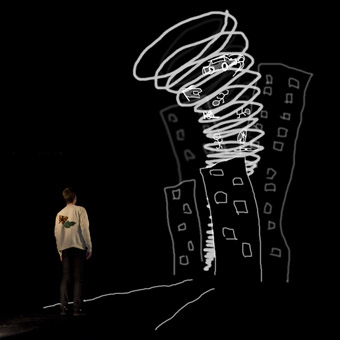
Luke Fraser in The Fire and Hurricane Survival Guide
image by Thomas Breakwell and Robert Jordan
Luke Fraser in The Fire and Hurricane Survival Guide
That Surrealist grand master Marcel Duchamp, an artist notorious for turning his nose up at the urinal of genre classification, also emphasised the communicative power of inanimate objects. In this sense, The Fire and Hurricane Survival Guide comes closest to transposing a precise surrealist impulse into the morass of postmodern life. Watching this impulse attempt to find traction in the year 2009 is one of the strangest experiences a reviewer can have in his theatre reviewing life. Perhaps though, this same sense of temporal-spatial displacement is once again, a necessary condition of the hyperreal.
Bird on Fence: Dream Creatures, and The Fire and Hurricane Survival Guide, Writer-Directors: Alisa Tanaka-King & Brienna Macnish, Performers: Ally Bruce, Amy Jones, Emma Lyhne, Brenna Macnish, Michael Timothy Mission, David Peake, Joana Pires, Stephanie Sabatino, Mattie Young, Luke Fraser & Mathew Whitty, Light: Katherine Hall & Maddy Seach, Sound: Daniel O’ Shea & Danielle Anderson, Music: Glenn Luck & Caterina Pacitti, Sand Art: Amy Jones, Animation: Robert Jordan, August 5 – 8, St Martins Youth Arts Centre, Melb
RealTime issue #93 Oct-Nov 2009 pg. 42
© Tony Reck; for permission to reproduce apply to realtime@realtimearts.net





































































































 New Weird Australia is a series of free downloadable albums compiled by Stuart Buchanan and Danny Jumpertz, the team who also present the show of the same name on Sydney’s FBi radio. The naming draws inspiration from the New Weird America moniker (in turn influenced by Old Weird America), which loosely categorises a range of alternative musics such as the neo-folk stylings of Joanna Newsom and Devendra Banhart; the psychedelic jams of the No Neck Blues Band and The Sunburned Hand of Man; and the laptop-folk fusions of CocoRosie and the Animal Collective plus more. Boldly borrowed by Buchanan and Jumpertz, the Australian usage is a little more expansive incorporating electronica, contemporary classical, lo-fi electronics and laptop experimentations that dwell on the outer edges of the ‘alternative mainstream’. Two compilations have been released so far, with the third due in November and already they are exposing listeners to some great hidden treasures—from artists well known in experimental circles, and from fresh discoveries—with an impressive Australia-wide representation.
New Weird Australia is a series of free downloadable albums compiled by Stuart Buchanan and Danny Jumpertz, the team who also present the show of the same name on Sydney’s FBi radio. The naming draws inspiration from the New Weird America moniker (in turn influenced by Old Weird America), which loosely categorises a range of alternative musics such as the neo-folk stylings of Joanna Newsom and Devendra Banhart; the psychedelic jams of the No Neck Blues Band and The Sunburned Hand of Man; and the laptop-folk fusions of CocoRosie and the Animal Collective plus more. Boldly borrowed by Buchanan and Jumpertz, the Australian usage is a little more expansive incorporating electronica, contemporary classical, lo-fi electronics and laptop experimentations that dwell on the outer edges of the ‘alternative mainstream’. Two compilations have been released so far, with the third due in November and already they are exposing listeners to some great hidden treasures—from artists well known in experimental circles, and from fresh discoveries—with an impressive Australia-wide representation.  Volume Two is co-selected by Buchanan and Danny Jumpertz and steers away from the Freak Folk that is influencing Volume One, into the territory of exploratory electronica and ambient. Some of this is pretty much what we expect from electronica—which is not bad, just perhaps more neatly classifiable. Broken Chip’s “Summer Stars” offers pleasing glassy ripples and Björky-clockwork multi-rhythms. There is a similar machinic style, overlayed with a more militaristic drum exploration in Sam Price’s compelling “Auto Hackney”. Kharkov’s “Crustacean” keeps edgy by drifting swathes of sharpish tones over a subtle propulsion while Mieli’s fat beats of “Hometime”, though finely produced, offered me no weirdness at all.
Volume Two is co-selected by Buchanan and Danny Jumpertz and steers away from the Freak Folk that is influencing Volume One, into the territory of exploratory electronica and ambient. Some of this is pretty much what we expect from electronica—which is not bad, just perhaps more neatly classifiable. Broken Chip’s “Summer Stars” offers pleasing glassy ripples and Björky-clockwork multi-rhythms. There is a similar machinic style, overlayed with a more militaristic drum exploration in Sam Price’s compelling “Auto Hackney”. Kharkov’s “Crustacean” keeps edgy by drifting swathes of sharpish tones over a subtle propulsion while Mieli’s fat beats of “Hometime”, though finely produced, offered me no weirdness at all. 







 Germ Studies is a double CD produced by the duo of Clare Cooper of NOWnow Festival fame and Chris Abrahams of The Necks, and the two have been collaborating on it since 2003. Each CD comprises no less than 99 tracks, 198 in all. That is a lot of material and it represents an extensive investigation into the endless range of sounds that can be created by combining the venerable DX7 synthesiser and the even more venerable Chinese zither, the guzheng. It is also a deep exploration of musical language. Rather than producing longer, more self-contained compositions, Cooper (guzheng) and Abrahams (DX7) have created a series of sonic moments that flit through conscious awareness, sharply distinguished from each other by the nature of the sound, the sum of which creates a substantial and engrossing oeuvre. Many of these exquisite tracks are less than a minute in length, some just a few seconds. A few are longer, at 2 or 3 minutes, and, perhaps ironically, the track entitled Neutrino (referring to the almost weightless sub-atomic particle) is an epic at 8 minutes.
Germ Studies is a double CD produced by the duo of Clare Cooper of NOWnow Festival fame and Chris Abrahams of The Necks, and the two have been collaborating on it since 2003. Each CD comprises no less than 99 tracks, 198 in all. That is a lot of material and it represents an extensive investigation into the endless range of sounds that can be created by combining the venerable DX7 synthesiser and the even more venerable Chinese zither, the guzheng. It is also a deep exploration of musical language. Rather than producing longer, more self-contained compositions, Cooper (guzheng) and Abrahams (DX7) have created a series of sonic moments that flit through conscious awareness, sharply distinguished from each other by the nature of the sound, the sum of which creates a substantial and engrossing oeuvre. Many of these exquisite tracks are less than a minute in length, some just a few seconds. A few are longer, at 2 or 3 minutes, and, perhaps ironically, the track entitled Neutrino (referring to the almost weightless sub-atomic particle) is an epic at 8 minutes. 
































![Bios [Bible], robotlab](https://www.realtime.org.au/wp-content/uploads/art/29/2960_crosby_ars_bible.jpg)


























